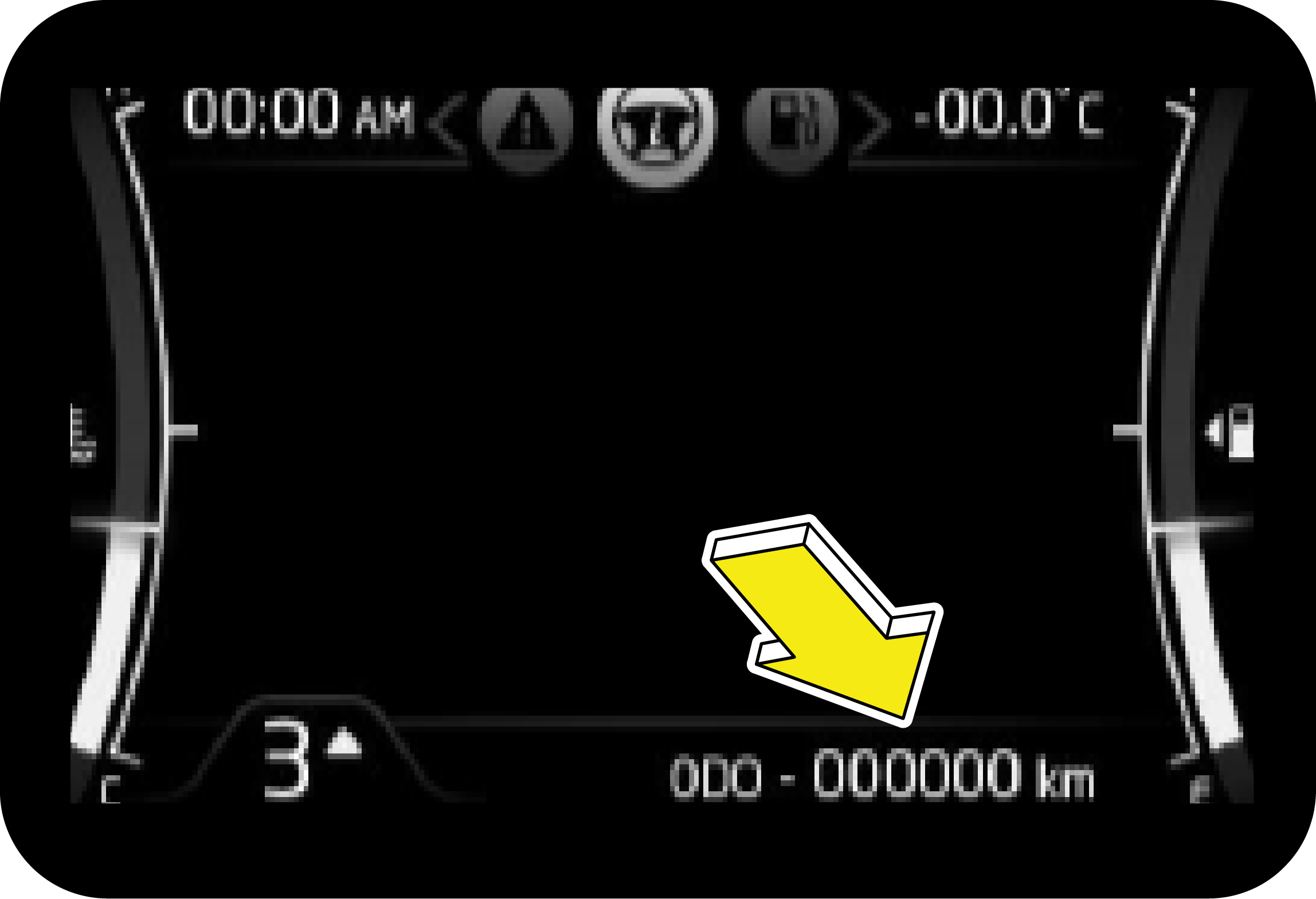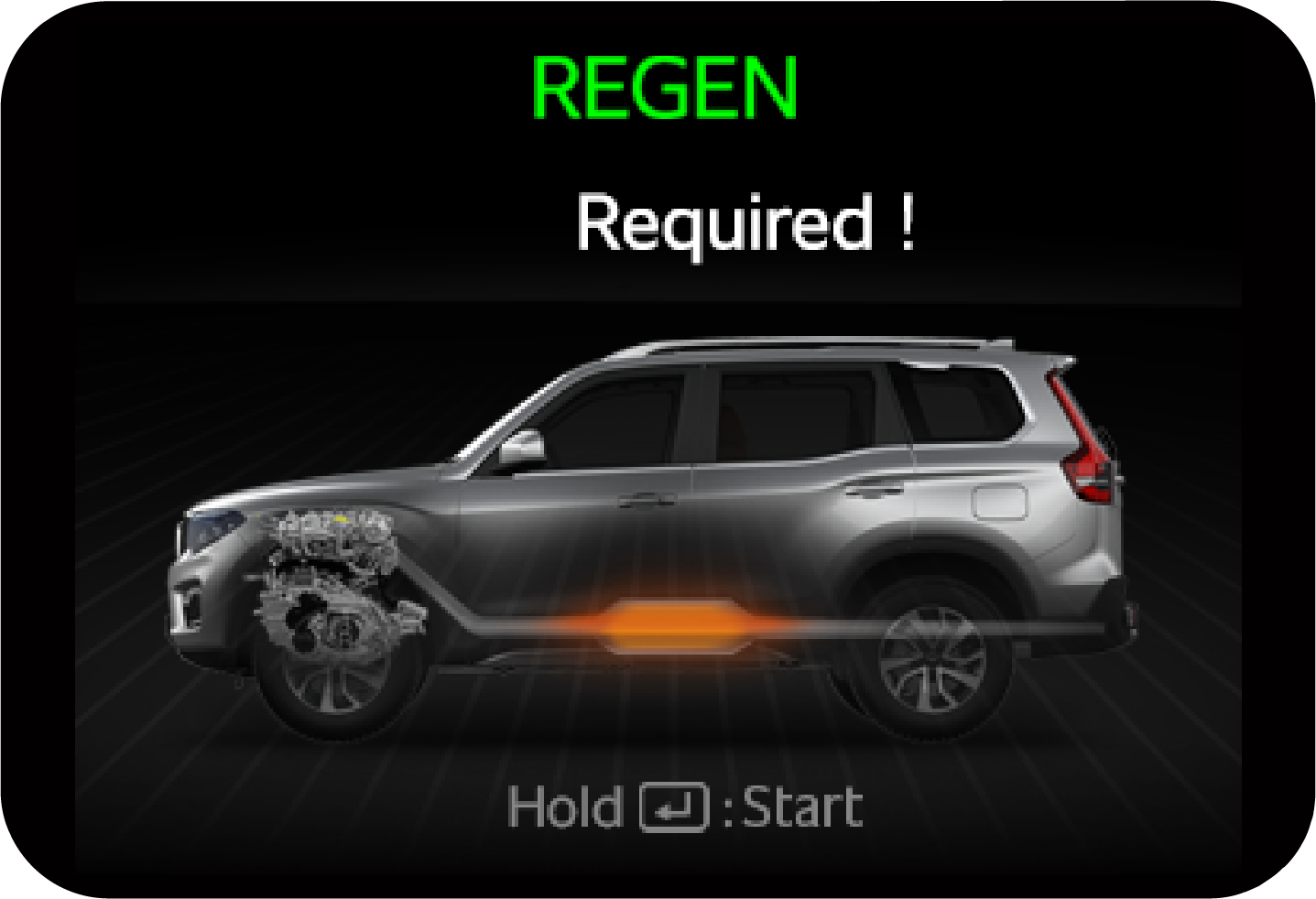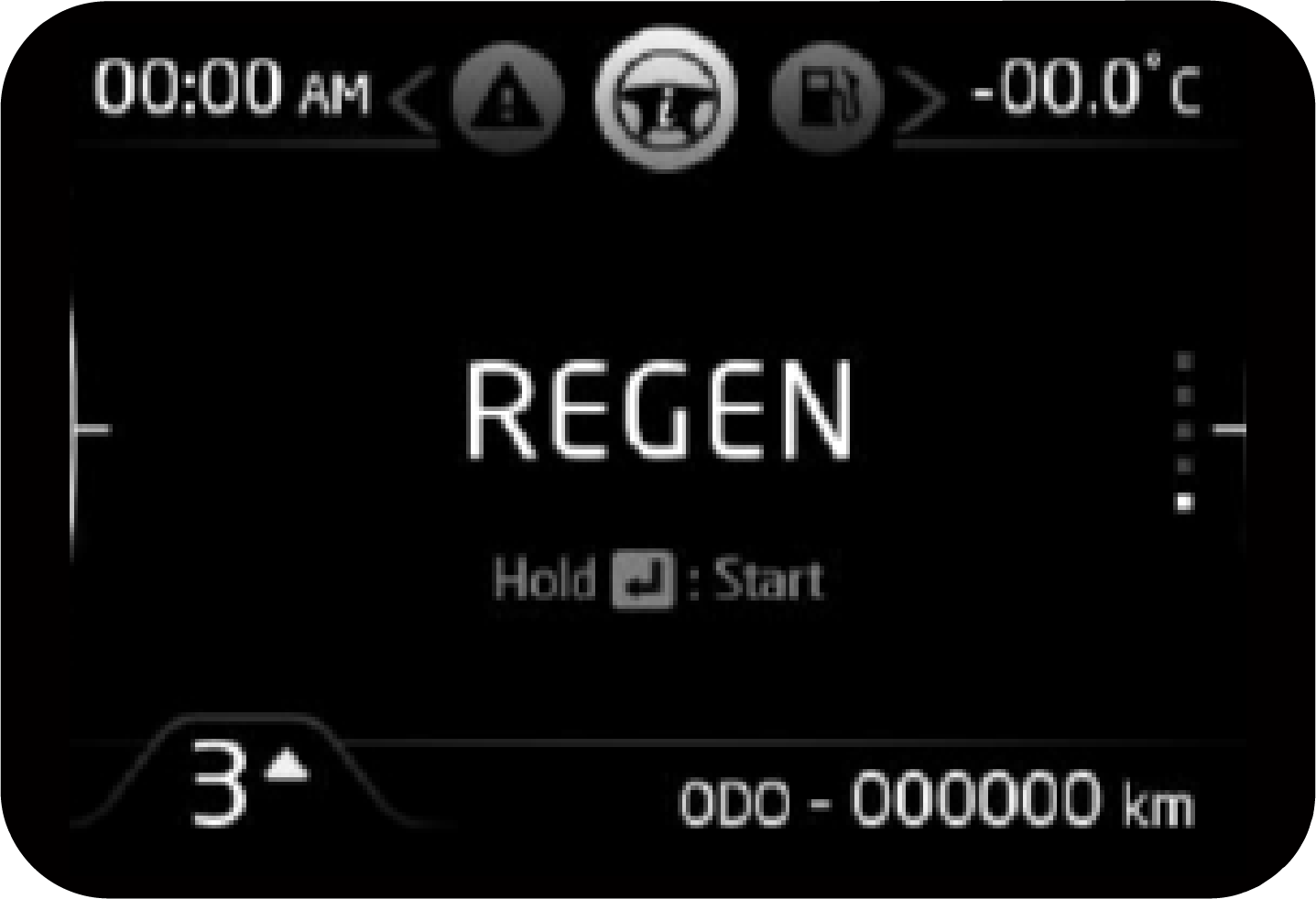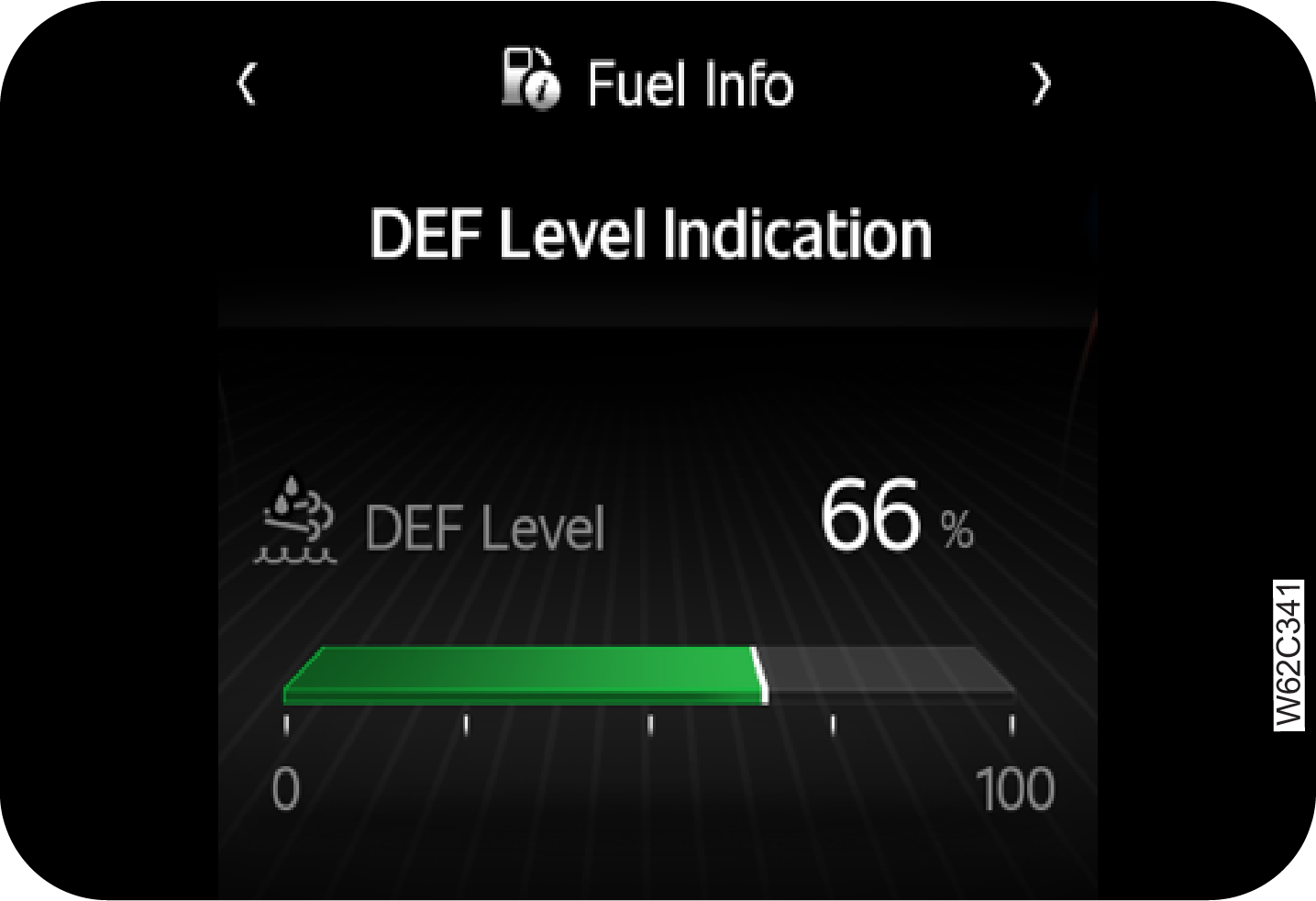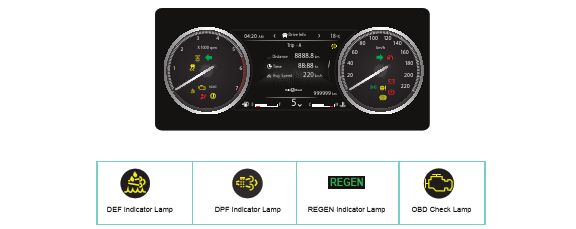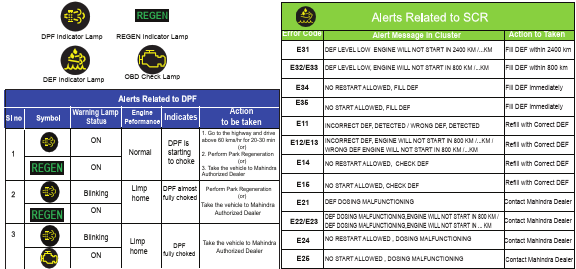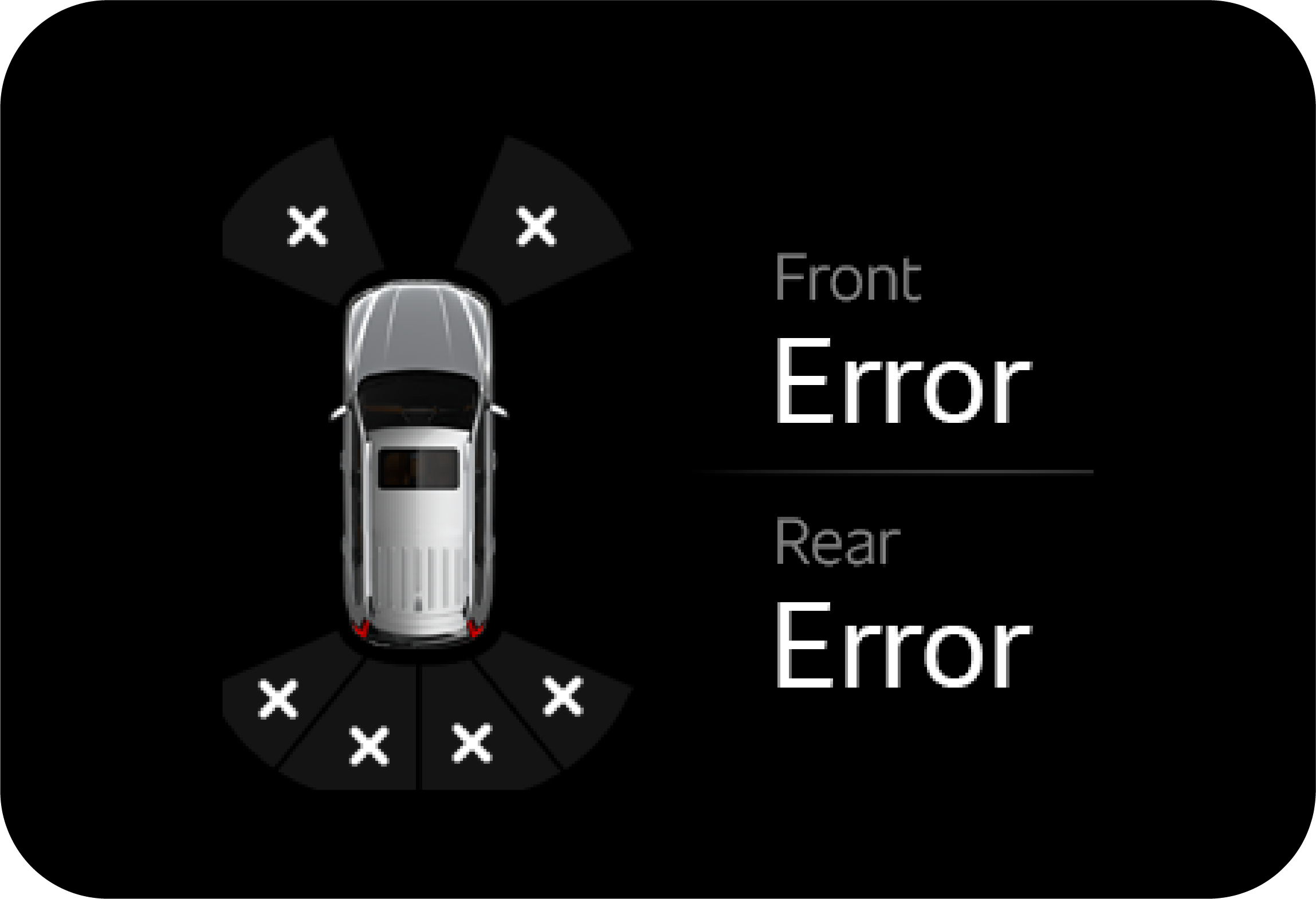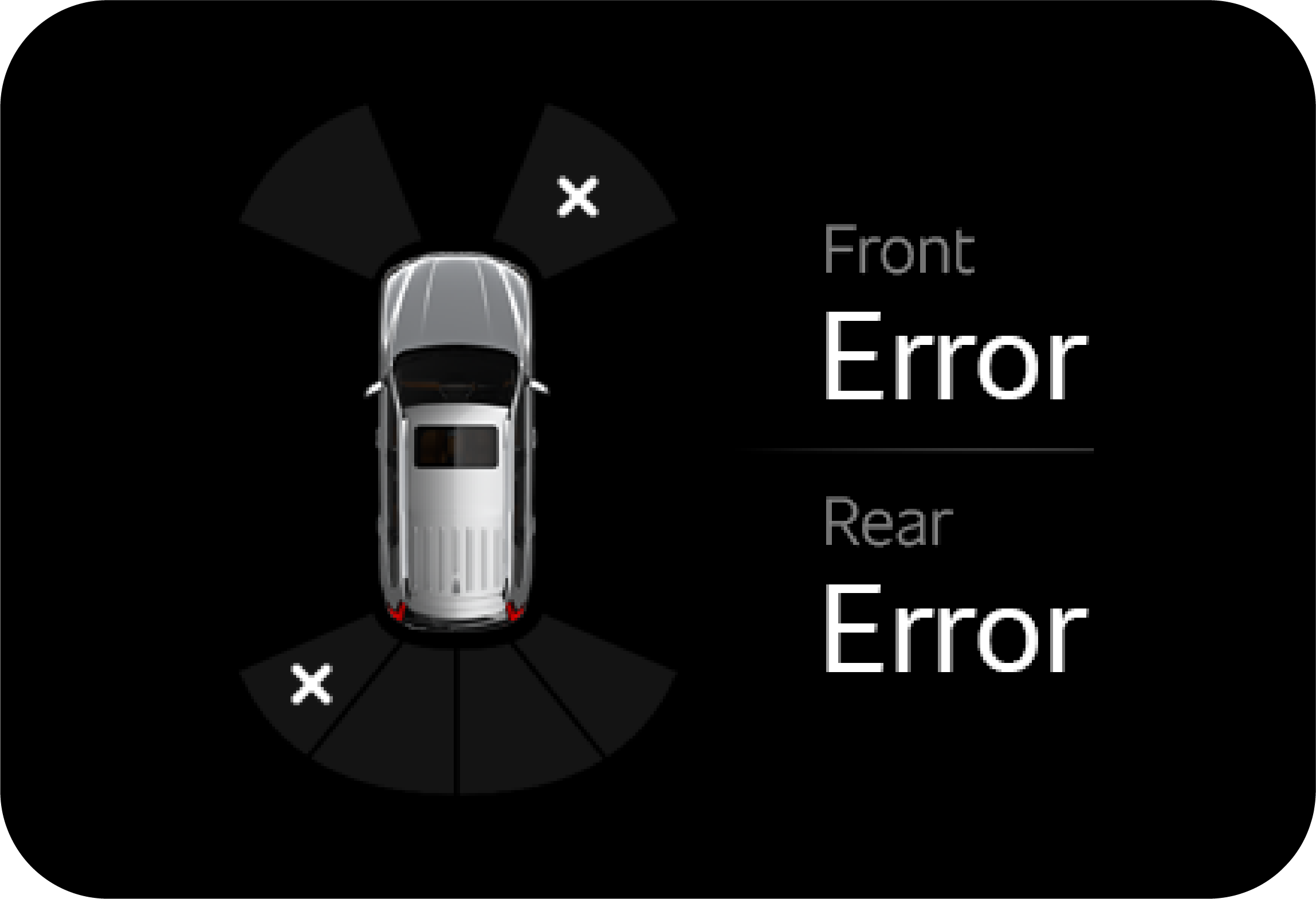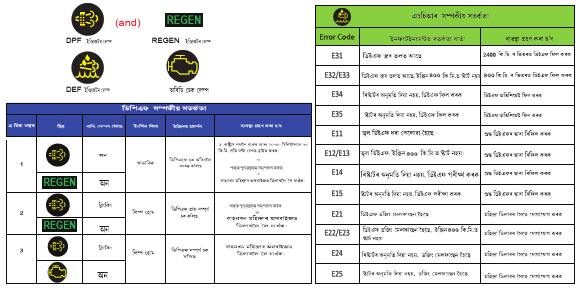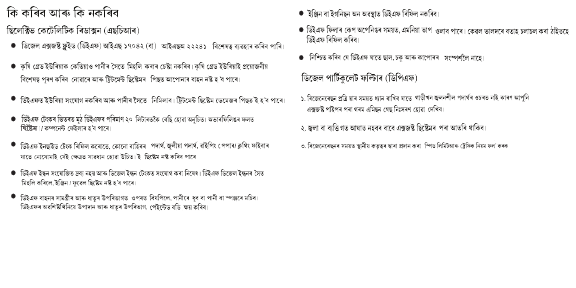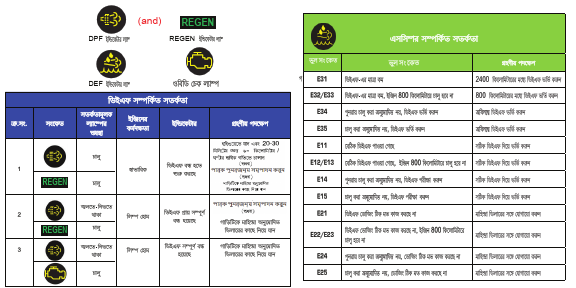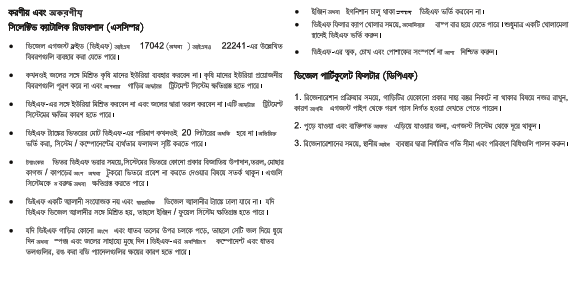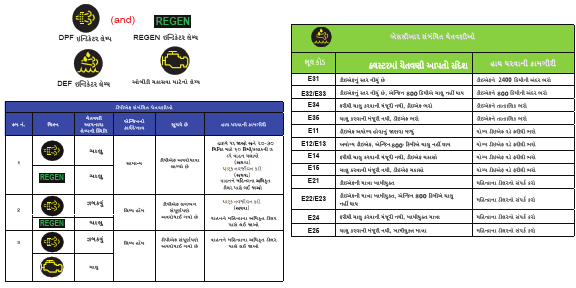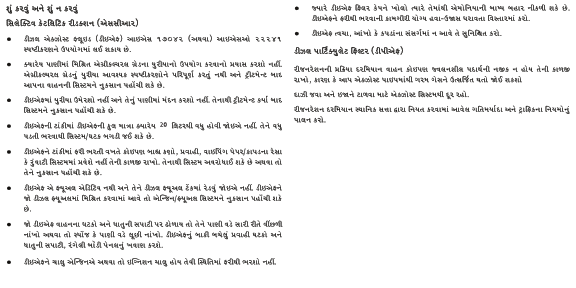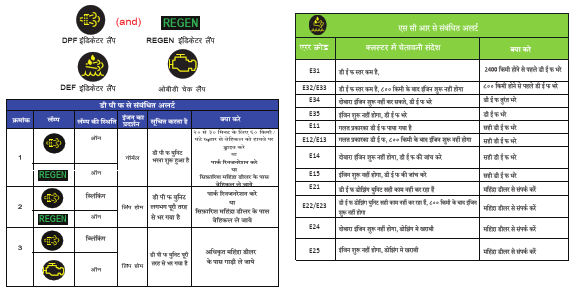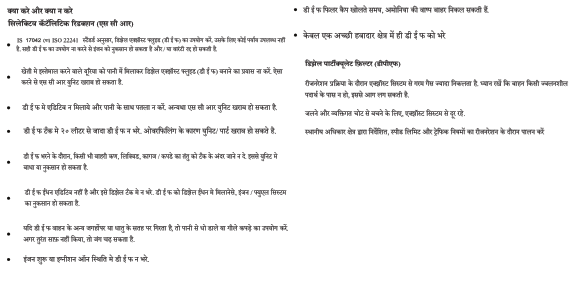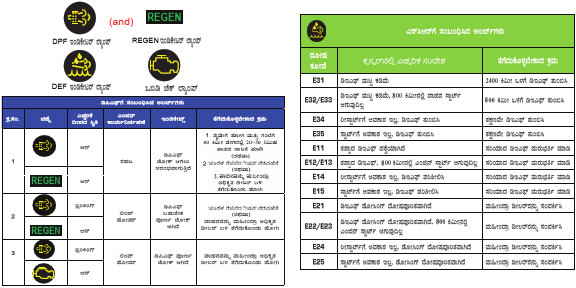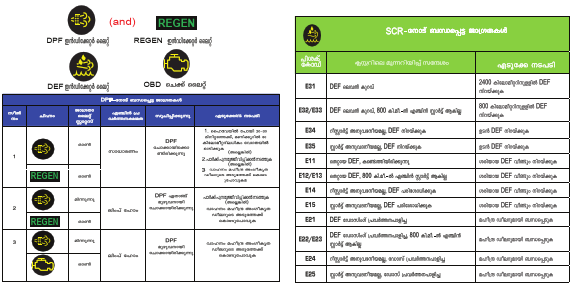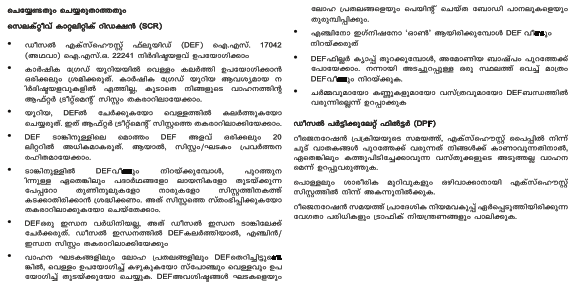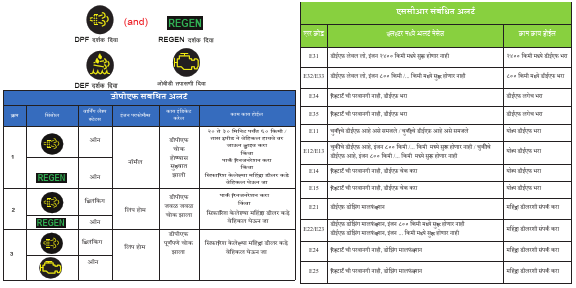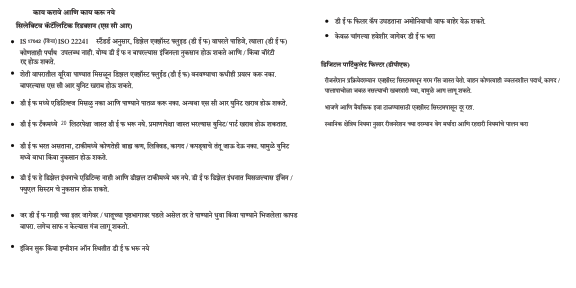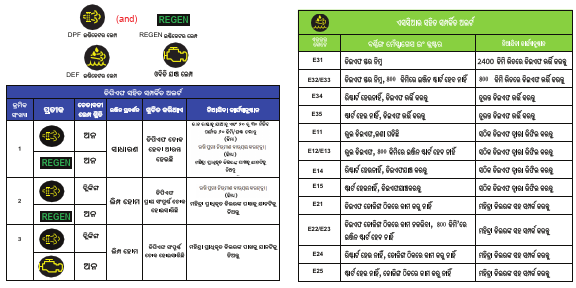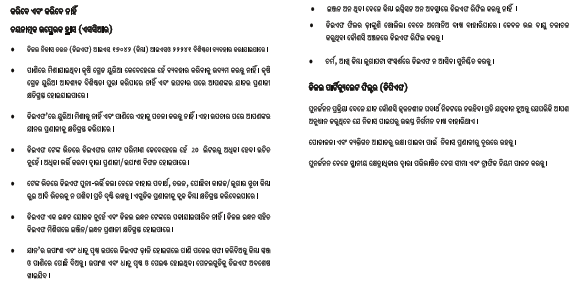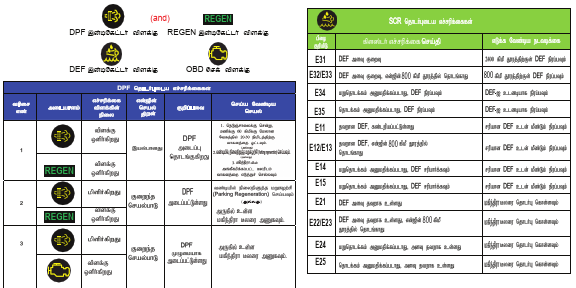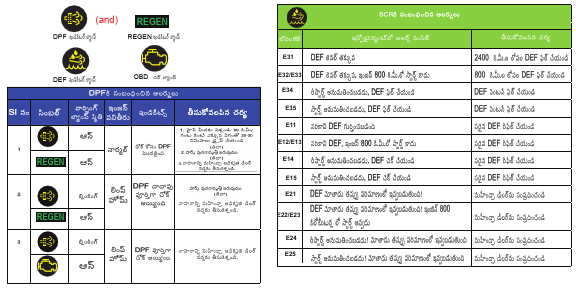Thank you for choosing Mahindra vehicle.
We are privileged to welcome you to the Mahindra family.
Your vehicle represents Robust Quality, Ruggedness, Safety, Precision
Workmanship and Distinctive Styling , which are our
traditional values.
This documents contains important information on vehicle operation,
that will help you make full use of the technical features
available. To exercise better control on road, we suggest you to please take time to read, understand
and familiarise with
vehicle and its features. Following the instructions and recommendations in this manual will help
assure safe and enjoyable
operation of your vehicle.
When it comes to service, note that your Mahindra Authorised Dealer
knows your vehicle best, has company trained Technical
Experts, Mahindra Genuine Parts and very much cares about your satisfaction.
We extend our best wishes for safe and pleasurable motoring
MAHINDRA & MAHINDRA LTD.
| Important Information – Quick Reference | |
|
We
strongly urge that you read the information provided in pages referred
hereunder which will help in road safety and prevent
inconvenience
|
|
1
|
Warranty
Coverage.............................................................................................
|
Refer WSIG* (P.g. 15)
|
|
2
|
Roadside Assistance
....................................................................................
|
Refer WSIG* (P.g. 11)
|
|
3
|
Schedule Service
(Free/Paid).................................................................
|
Refer WSIG* (P.g. 24)
|
|
4
|
Maintenance Schedule
Chart.................................................................................
|
Refer WSIG* (P.g. 26)
|
|
5
|
Lubricants And
Capacities.............................................................................
|
Refer WSIG* (P.g. 30)
|
|
6
|
Location Of Vehicle Identification Number
(VIN).................................................
|
Refer (P.g. 1-7)
|
|
7
|
Location Of Fuse Box And Fuse
Details............................................................
|
Refer (P.g. 10-10)
|
|
8
|
Changing A Flat
Tyre................................................................
|
Refer (P.g. 10-21)
|
|
9
|
Understanding The Warning
Lamps..........................................................
|
Refer (P.g. 3-38)
|
|
10
|
Use Of Seat Belts And Child
Restraint......................................
|
Refer (P.g. 2-11)
|
|
11
|
Understanding The Airbag
Function.........................................................
|
Refer (P.g. 2-30)
|
|
12
|
If Your Vehicle Is
Submerged.....................................................
|
Refer (P.g. 8-8)
|
|
13
|
Driving Through
Water..................................................................................
|
Refer (P.g. 8-8)
|
|
14
|
Opening And Closing the
Bonnet.........................................
|
Refer (P.g. 5-22)
|
|
15
|
Location Of Battery And Its
Maintenance.....................................
|
Refer (P.g. 11-8, 11-9 & 11-16)
|
|
*Warranty and
Service Information Guide
|
1 GENERAL AND SAFETY PRECAUTION
1.1 Servicing and Summary
Data
We suggest that you record the vehicle servicing data in
the Warranty and Service Information Guide for future references
We recommend you always use Mahindra Genuine Parts when
performing repairs on the vehicle.
For all issues concerning the vehicle and for any need of
Genuine spare parts, contact the Mahindra Authorised Dealer
1.2 Safety Symbols
Carefully read, understand and follow the safety symbols/
instructions given in this manual.
Legend of the
Symbols
To emphasis the information and procedures regarding
safety, use, maintenance, etc., the following symbols are used throughout
the manual:

DANGER indicates an
imminently hazardous situation which, if not avoided, will result in death or serious injury.

WARNING indicates a
potentially hazardous situation which, if not avoided, could result in death or serious injury.

CAUTION indicates a
potentially hazardous situation which, if not avoided, may result in minor or moderate injury and/or property
damage.

NOTICE indicates
important information relevant to the vehicle, the vehicle's use or to sections of
this manual to which particular
attention must be paid for optimum use of the vehicle.
|
If you see this symbol, it indicates “no,”
“ do not,” “do not do this,” or “never”.
|
|
1.3 General Safety
Information and Instructions
| 1. | First-aid kit is placed in the glove box of the vehicle. Ensure it is not taken out of the vehicle at any point of time. |
| 2. | Please note that throughout this manual, reference is made that “an accident” could occur. An accident could cause you or a bystander to sustain personal injury, or result in property damage. |
| 3. | Inspect the seat belt system periodically, checking for cuts, frays or wear in the seat belt webbing, or loose buckles, retractors, anchors or other loose parts. Damaged parts must be replaced immediately. |
| 4. | The lifespan of Mahindra products depends on many factors. Improper use, abuse or harsh use in general may compromise the integrity of the vehicle and significantly reduce its lifespan. The vehicle is also subject to wear over a period of time. Please have your vehicle regularly inspected by a Mahindra Authorised Dealer or a qualified Technician . If the inspection reveals any damage or excessive wear, immediately replace, or have the component serviced. |
| 5. | The vehicle identification plates are the only legal identification reference; hence it is necessary to keep them in good condition. Never modify data on the plates or remove them. It is illegal to remove or alter the numbers in the VIN plate. |
| 6. | Do not attempt sharp turns, abrupt maneuvers, or other unsafe driving actions that can cause loss of vehicle control. When the vehicle is fully loaded, drive at a slow speed, especially when turning. Note that the center of gravity of the vehicle changes when the vehicle is fully loaded, and also if luggage is mounted on the roof carrier. |
1.4 To Users of a Mahindra
Vehicle
When first driving the vehicle after long periods of
non-usage, you may experience a temporary drive disturbance. This is
a characteristic of the tyres and should be no reason for concern. The condition should
correct itself within 5-15 kilometers.
of driving. If the disturbance persists, have the vehicle checked by an Mahindra
Authorised Dealer.
Driving and
Drugs/Medication
Your driving ability can be seriously impaired through the
use of prescription or non-prescription drugs or medication (even
cough syrup). If you are taking any sort of drug or medication, be sure that it will not
affect your driving ability.
Mobile Phones
Warning
Use of electronic devices such as mobile phones, handheld
devices, computers, portable radios or other by the driver while
driving is dangerous. In exceptional condition, if use of a mobile phone is necessary
despite this warning, use a handsfree
system to ensure that the hands are free to drive the vehicle. Even handsfree do not
ensure distraction free drive. Please
comply with the legal regulations in your country, concerning the use of communication
equipment in vehicles .
Driving Long
Distances
When driving long distances, follow these tips to have a
safe journey:
| • | Take breaks at regular intervals |
| • | Lack of sleep or fatigue will impact your ability to drive safely |
| • | Exercise your eyes by shifting the focus of your eyes to different parts of the road |
| • | Use stimulating beverages such as coffee or tea |
| • | Relax and stay calm |
Running-in
Driving smoothly during first 1,000 kilometers. will help
to prevent abnormal and premature system wear. Proper running-in
will improve the life of drivetrain and vehicle components.
A new engine may consume more oil during the first 1,000
kilometers. of running. This should be considered as a normal part
of break-in and not interpreted as any problem with the engine.
Mahindra Genuine
Parts
Mahindra uses high quality parts for building the
vehicles. In the event that any parts need replacement, we recommend that
you use only Mahindra genuine parts.
Non-Mahindra parts may harm vehicle performance and will
not be covered by your Mahindra warranty.

The warranty does not cover problems caused by using
non genuine parts
Mahindra Genuine
Accessories
A wide selection of quality accessories are available
through your Mahindra Authorised Dealer. These accessories have been
specifically engineered to allow you to personalize your vehicle to suit your requirements
and complement its style and aerodynamic
appearance.
Each accessory is made from high quality materials and
meets Mahindra's rigid engineering and safety specifications. Every
Mahindra accessory installed according to the Mahindra installation provisions comes with
the respective accessory warranty.
Consult your Mahindra Authorised Dealer for detailed
information about accessories available for your specific model variant.

For maximum vehicle
performance and safety considerations, always keep the following information in
mind:
| • | The company shall not be liable / responsible for any damages / injuries, including consequential damages / injuries, resulting due to fitment of unauthorised aftermarket accessories and / or tapping / cutting wires in the wiring harness When adding accessories, equipment, passengers and luggage to your vehicle, do not exceed the total weight capacity of the vehicle or of the front and rear axle. Consult Mahindra Authorised Dealer for specific weight information |
| • | Bull bars and nudge guards are not recommended |
| • | Accessories causing any change in vehicle specifications like wheel rims, bull bars, etc., may affect the performance of safety systems |
| • | Mobile communication systems such as two-way radios, telephones and theft alarms that are equipped with radio transmitters and installed in your vehicle should comply with the local regulations and should be installed only by your Mahindra Authorised Dealer and can potentially affect the vehicle performance. |
Vehicle Safety
When leaving your vehicle unoccupied:
| • | Always remove the ignition key when you park the vehicle |
| • | In case of PKE, please lock and take the key fob with you |
| • | Close all the windows completely and lock all the doors |
| • | Do not leave any valuables in your vehicle. If you must leave something in your vehicle, hide them and securely lock all the doors |
When Sleeping in Your
Vehicle
| 1. | Do not sleep in a parked car with closed windows. In particular, if you stay or sleep in the car with the engine running and the air conditioner or heater turned on, you can suffocate to death |
| 2. | Sleeping in a closed space with the engine running puts you at high risk of suffocation from the exhausts |
| 3. | While sleeping, you may accidentally touch the gear shift lever or accelerator and thereby cause an accident |
| 4. | While sleeping in the car with the engine running, you may accidentally step on the accelerator, thereby overheating the engine and exhaust pipe and causing a fire |
Hazardous
Materials: Do not store any flammable items or disposable lighters in the
console box or other spaces. In hot weather, they can explode
and cause a fire.
Fire Extinguisher:
For safety, we strongly recommend that you have fire extinguisher in your vehicle.
Keep it ready for use at any time. Be familiar
with how to use it
When Passing the
Intersection or Railway Crossing
When passing the intersection or railway crossing, stop
the vehicle to check the safety and drive through as fast as you can
while using low speed gear and without shifting the gear. If the engine is turned off in
the middle of the intersection or
railway crossing, get someone to help you and move the car to a safe place quickly.
Do not Switch off the
Engine While Driving
Do not switch off the engine while driving. Otherwise, it
makes the steering wheel heavier, influence the brake performance
and consequently dangerous
System Safety Mode :
The protective measures including illumination of engine warning lamp and reduced
engine power are taken (engine turned off
in extreme case) when there is a critical fault in the system or a malfunction in the
major electrical or fuel system. This
indicates the system entering the safety mode to protect the vehicle’s drive system.
| • | If the safety mode is activated, pull over and stop the vehicle to a safe location immediately and contact your Mahindra dealer. Then drive slowly or have the vehicle towed to a Mahindra Authorised Dealer according to the dealer’s instruction and have your vehicle checked by a Technician |
| • | If you continue to drive in this state, normal driving is not maintained due to the fixed engine rpm and engine can stop. But even more importantly, continued driving with this state may damage the drive system |
Do Not Modify This
Vehicle: If unauthorised modifications are made on the vehicle, the company is
not liable for repairing the modified parts even during
the term of warranty. Other part problems caused by modification are also not covered.
| • | The vehicle you bought is equipped with a large number of precision parts that have passed through countless experiments and tests. |
| • | These parts are deeply and systematically interwoven. Therefore, if any part is modified or altered without authorization, may under perform or cause critical damage to the vehicle and human life |
Protecting Our
Environment: As a responsible citizens, all of us have an important role to play
in protecting our environment. Judicious vehicle usage
and ensuring hazardous waste disposal (including cleaning and lubrication fluids) are
important steps towards this initiative.
Body Repairs:
If your vehicle is in a collision, contact Mahindra Authorised Dealer to ensure that it is
repaired with Mahindra Genuine
Parts. Mahindra has collision repair centers that meet strict requirements for training,
equipment, quality, and customer
satisfaction. Some repair shops and insurance companies might suggest using non-original
equipment to save money. However,
these parts do not meet Mahindra’s high standards for quality, fit and corrosion
resistance. In addition, non-genuine parts
or equipment might lead to damages or failures of the vehicle’s systems.
End of Line
Disposal
Composition: Vehicle is made from steel, Aluminum, Lead,
Copper, Wood, other plastics & miscellaneous parts. These materials are reusable
by recycling them through a proper procedure. Some are hazardous to environment and living
beings to be disposed as per local
pollution board regulations.
Disposal: As batteries are made of lead, lithium &
Iron phosphate with solvents as electrolyte which are harmful. They can impact on
environment and are to be disposed as per local pollution board regulations. Certain
components of this vehicle such as seat
belt pre-tensioner, airbag and battery may contain hazardous material. Special handling
may be required for service or vehicle
end-of-life disposal.
Similarly ABS & other plastic panels,
materials used are to be disposed to accredited agencies for recycling.
Most of other materials are reusable, hence components are
to be segregated as per their composition as hazardous and non-hazardous,
disposed to accredited recycling agencies. Hence it is advised to contact Mahindra
Authorised Dealer for further information
1.5 Vehicle Identification
Number (VIN)
Vehicle Identification Number (VIN) is the legal identity
of your vehicle. The vehicle identification number is stamped on
the VIN Table riveted on to the bottom of the B-Pillar on the driver side. It is illegal
to remove or alter the VIN

Never modify data
on the plates or remove them. It is illegal to remove or alter the numbers in the
VIN plate.
1.7 Chassis Number
|
|
The chassis number is punched on the right
side chassis side member below the front fender. It is also stamped on to
the bottom
of the B-Pillar on the driver side
|
1.12 AdrenoX Connect
The Adrenox
connect mobile app provides information in your mobile phone about location &
status of the vehicle and allows
to control certain vehicle features in a secured way for both Android and iOS
platform.
Kindly use the AdrenoX connect mobile app for connected car related
features.
1.12.1 KYC ( Know
Your Customer) Registration
To activate connected car features including access
to Adrenox mobile App, KYC process must be completed
successfully.
| • | Customer must produce valid mobile number, communication address & email ID for KYC registration. for registration purpose. |
| • | Preferred mobile number entered during the KYC process will be the login for Adrenox mobile app. |
| • | After successful KYC registration, customer must download the “AdrenoX Connect” mobile application from Google Play store or iOS app store. |
1.12.2 Login
& Registration
Follow the below steps for Login and Registration:
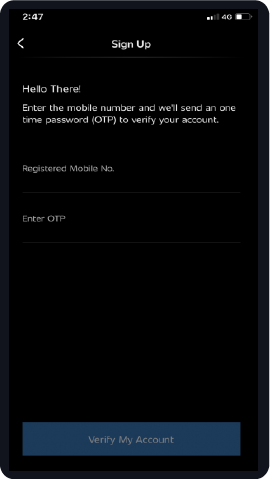
| 1. | You can select sign up option from login page which redirects to sign up page |
| 2. | Then enter registered Mobile number given in KYC form for connected services and click on Generate OTP |
| 3. | OTP with a validity will be sent to the same mobile number |
| 4. | If OTP is not received, you can request the OTP again by clicking on "Resend OTP" |
| 5. | After entering valid OTP, click on “Verify My account” |
| 6. | On successful verification you will be notified with a message " Account Verified" |
| 7. | You will be directed to "Terms and Condition" with "I Agree" option on successful authentication |
1.12.3 Forgot/Change
Password and Change Pin
This Feature allows the existing user to change
Password and change PIN.
In case user forgets the Password and PIN below flow helps to create PIN and
password.
Forgot your
password
In case you forget your
password:
| • | Tap on the Forgot Password? link from login page |
| • | In forgot password page, enter the registered mobile number for connected services and click on Generate OTP |
| • | Enter the OTP and click on Next button |
| • | Enter New Password and Confirm Password and tap on Save button |
Change your
password
To Change your password on app if you are already
logged in:
| • | Tap on the top Left corner from home screen |
| • | Click on My Account and select Change Password |
| • | Page will open with Old password, New password and Confirm password fields |
| • | Fill all the required field and tap on save button |
1.12.4 AdrenoX
Connect Features
|
FEATURE
|
DESCRIPTION
|
|---|---|
|
Alerts
|
|
|
Over Speed Alert
|
When your car exceeds the set
speed limit. This speed limit value can be set under alert
configuration in mobile application
|
|
High Engine Temperature Alert
|
Alerts when Engine temperature
beyond the predefined limit
|
|
Tyre Pressure Alert
|
Alerts on excessive/very low
and high tyre pressure and navigate to nearby petrol station
|
|
Lamp Status Alert
|
Alerts when vehicle park lamp
left in ON condition
while locking the vehicle
Notifies when the vehicle park
lamp is left in ON condition and helps to turn OFF remotely via
mobile application
|
|
Vehicle Start/Stop Alert
|
Notifies when normal vehicle
start /stop event is detected
|
|
Door Open Alert
|
Notifies when any of the doors
open while vehicle is moving and also when you trigger for door
lock and the door remains open
unintentionally
|
|
Geo-Fence Alert
|
Alerts when your vehicle moves
out of a set boundary area
Helps you to create virtual
boundary for any region and will be notified whenever your
vehicle moves in or out of that boundary
|
|
Unauthorised vehicle entry
Alert
|
Alerts the user when any
unauthorized entry in the vehicle is detected
|
|
Low Fuel Alert
|
Identifies low fuel level and
notifies in your mobile application. Helps in assisting you to
nearby fuel station
|
|
Route Deviation Alert
|
Alerts the user when the
vehicle deviates from the pre-defined path
|
|
Time Fencing Alert
|
Notifies you when any movement
of vehicle is detected during set time period
|
|
Seat Belt Alert
|
Notifies you whenever the
driver/ co-driver is not wearing the seat belt during vehicle
movement in mobile application
|
|
Driver Drowsiness Alert
|
Alerts the user when the driver
is detected to be drowsy while driving
|
|
Insurance expiry Alert
|
Suggests in advance to renew
the Insurance as expiry date of Insurance approaches
Notifies you in advance when
the insurance is about to expire
|
|
PUC expiry Alert
|
Notifies you in advance when
the PUC is about to expire
|
|
Engine Idle Alert
|
Alerts when engine idling is
detected for a set period of time. Time can be configured in
mobile application
|
|
Location Based Service
|
|
|
Live tracking
|
GPS based vehicle tracking
system for tracking vehicle’s location anywhere and at any
point of time
Helps to provide the real time
vehicle location when vehicle is in movement
Helps in sharing the vehicle
location for a set time to your family and friends
|
|
Save Route / Save Place
|
Provision to save a route
/place
|
|
Find my car
|
Helps to identify the vehicle’s
location and directs you to locate your vehicle
|
|
Share my car location
|
Share your car's location with
friends and family
|
|
Push to car
|
Allows the user to push
routes/location from the mobile app to the vehicle
|
|
Sync location on SUV
|
Provides updates of any
upcoming event by syncing with the calendar
|
|
Ecosense
|
Provides the details about the
driving behavior for each trip
|
|
Trip History
|
Provides detailed information
about the trips
|
|
Weekly Report
|
Provides details about various
vehicle parameters for a defined time period
|
|
Trip Replay
|
Provides glimpse of the trip in
a form of a short video
|
|
Pit Stops
|
Provides information and
navigational access to nearby restaurant, ATM, Mahindra
Dealership and so on
|
|
Read Vehicle Status
|
|
|
Check door status
|
Allows the user to view the
current status of the vehicle door
|
|
Check tyre pressure
|
Allows the user to view the
current status of tyre pressure
|
|
Check lamp status
|
Allows the user to view the
current status of the lamp
|
|
Check ODO
|
Allows the customer to check
the odometer of the vehicle
|
|
My SUV info
|
Essential information about the
vehicle like VIN, Variant and so on
|
|
Check AC Status
|
Allows the user to view the
current status of the AC
|
|
Check Distance to empty
|
Helps to check distance to
empty range i.e. the distance can be covered with the available
fuel
|
|
Seat Belt Status
|
Helps the user to check the
Driver/Co-Driver seat belt is buckled or not
|
|
Safety
|
|
|
E-Call
|
In case of accident, Emergency
call will be triggered from vehicle, SMS will be sent to With
You Hamesha & Emergency contacts
along with the current vehicle location.
|
|
SOS Button
|
In case of SOS is initiated,
SOS call will be triggered from vehicle, SMS will be sent to
With You Hamesha & Emergency contacts
along with the current vehicle location
|
|
Road Side Assistance
|
Allows the user to reach out
for help with Mahindra Roadside Assistance team in case of
vehicle breakdown
|
|
Remote Function
|
|
|
Remote Sunroof control
|
Allows the user to remotely
control Sunroof using mobile app
|
|
Remote Start/ Stop
|
Allows the user to remotely
start or stop the vehicle using mobile app
|
|
Remote Climate control
|
Allows the user to remotely
configure the in- vehicle temperature during remote start using
mobile app
|
|
Remote Window Up/Down
|
Allows the user to remotely
control the Driver window (with anti-pinch) using mobile app
|
|
Remote Door Lock/Unlock
|
Provide access to the vehicle
by remotely locking and unlocking the doors when vehicle is
stationary
|
|
Remote Lamp On/Off
|
Allows the user to remotely
turn on or off the lamps using mobile app
|
|
Locate my SUV
|
Allows the user to remotely
locate the vehicle by turning on the horn and lights
|
|
In-Car Applications
|
|
|
Horoscope
|
Allows the user to view daily
fortune as per his/her zodiac sign.
|
|
Just dial
|
Allows the user to search for
various services using the Just Dial app in the infotainment
screen
|
|
Zomato
|
Allows the user to search for
various restaurants and cuisines using Zomato app in the
infotainment screen
|
|
India Today
|
Allows the user to browse
through news using India Today app in the infotainment screen
|
|
Weather Update
|
Allows the user to view weather
information using the Accuweather app in the infotainment
screen
|
|
Travel Explorer
|
Allows the user to search for
amusement places and more using the Travel Advisor app in the
infotainment screen
|
|
What 3 Words
|
Allows the user to navigate to
any what 3 words address. (See what3words.com for more details)
|
|
Others
|
|
|
ETA
|
Allows the user to know the
Estimated Time of Arrival of your vehicle at your current
mobile location.
|
|
In-Home Alexa
|
Allows the user to check the
vehicle status and perform remote function using Alexa Home
devices (voice commands)
|
|
Valet Mode
|
Allows the user to set the
vehicle in a predefined state when giving the vehicle for valet
parking. The default PIN to access
the Valet mode will be 1234
1. Infotainment will be inaccessible, 2. Speed limit to 80 kmph & 3. Geofence alert for 5km |
|
Contact us
|
Any Query / Enquiry about the
product, Get info on Mahindra. Send an Inquiry on any car
model. Dealers will get back to the
customer on details
|
|
Smart Home Control
|
Allows the user to control the
smart appliances via Geofence of vehicle location
|
|
Log Book - Fuel(Fuel Diary)
|
Maintains a systematic log of
the all the fuel filling events and provides a clear
representation of the fuel filled and the amount spent
|
|
mGreetings
|
Greetings to the user on
special occasions
|
|
Do-Not Disturb
|
Avoids distraction while
driving by not pushing any AdrenoX Connect app notification
when mobile is detected in the vehicle
|
|
Journey Planner
|
Allows the user to plan a
journey by providing desired location on a specific Date & Time
|
|
Request app Access
|
Allows the user to share the
vehicle access to two more users
|
|
My Documents
|
Storage and retrieval of
documents such as Driving license, Insurance, PUC, RC
|
|
Profile Manager
|
Allows the user to configure
the vehicle settings to maximum of two profiles. Vehicle
settings such as climate settings, Audio settings, Audio
source, Key fob etc.,
|
|
To-do list
|
Allows the user to create time
based/location- based events that remind the user at the
specified time
|
|
Smart Wearables
|
Allows the user to perform all
the read and remote functions through the smart watch
(applicable for both Android and iOS)
|
|
Pick up Reminder
|
Allows the user to create an
event that reminds the user at the specified time
|
|
Service Booking
|
Allows the user to schedule a
service by directing to the With You Hamesha app
|
|
Personalised Safety Alert
|
Alerts the user via a
personalised beloved ones voice prompt when the vehicle crosses
the speed limit
|
|
what3words via Alexa Voice
|
Allows the user to
navigate/find current location of what3words address via voice.
Eg: "Alexa, Ask what3words to navigate to decking butter
sheets”
Note:
Use Alexa Companion mobile app to enable location service
permission if requested.
Routing via Native navigation
Only English inputs
|
1.12.5 Branded Audio
(If equipped)
We all love music which gives emotional experience. The
premium Immersive 3D Sound System, allows to feel like passengers
are right in the middle of favorite concert.
The ultimate audio listening experience
comes from core of the system with perfectly placed 12 speakers
1.12.6 Blue Sense
(If equipped)
The Blue
Sense mobile app provides information from mobile phone allows to control
certain vehicle features in a secured way for both Android & iOS platform
of non - Telematic variant models.
Kindly refer the BLUE SENSE mobile app for in car
features.
Bluesense app connects with vehicle
Infotainment System to experience in-car control features.
Connect Android / iOS Mobile device over
Bluetooth with Infotainment System.
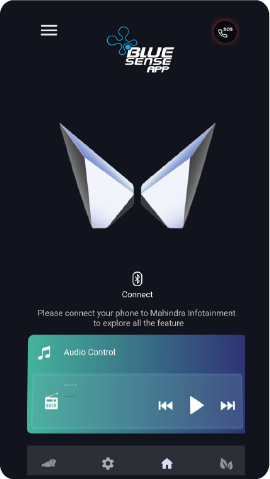 |
Procedure for Bluetooth Connection:
|
After successful
Bluetooth connection with Infotainment follow below steps to connect Bluesense App.
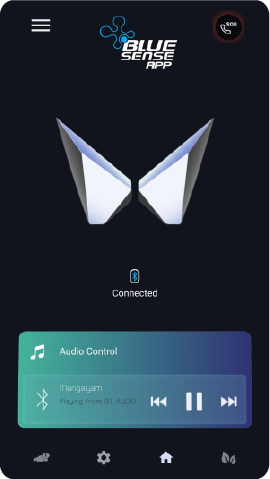 |
Procedure for Bluesense App Connection:
|
Select ”Audio
Control” from Bluesense App Home screen to experience Audio Controls (Source
Change, Volume Control, Next,
Prev, Fast Forward & Rewind).
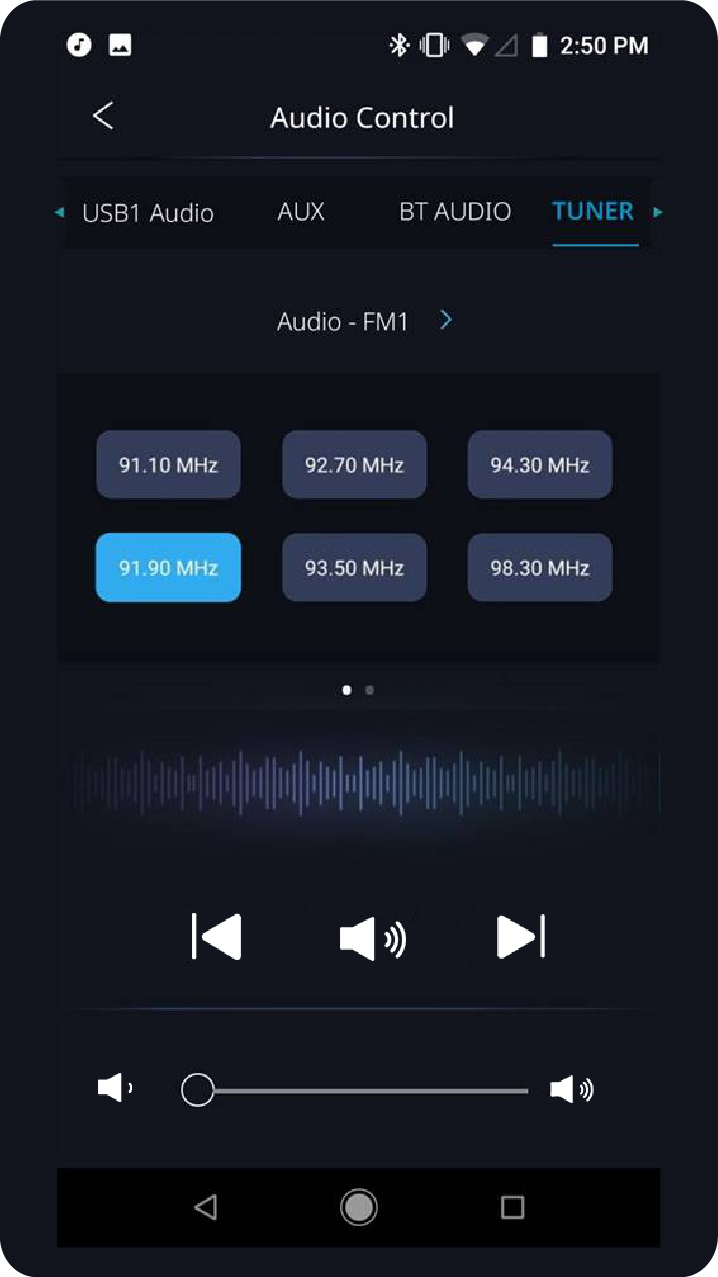 |
Below listed Audio Sources supported by
Bluesense App (Based on applicability)
|
1.13 Alexa Reference Guide
2 SEATS AND SAFETY
2.1 Seats
Sitting in Correct
Position
| Follow the tips below for a comfortable and safe journey: |
| • | Sit in an upright position with the base of your spine pressed against the seat back |
| • | The driver and front passenger seat head restraint has 5 positions. Adjust it as close as possible to the above specified position, with the top of the head restraint even with the top of your head |
| • | Maintain sufficient distance between yourself and the steering wheel. Maintain at least a Ten inch (10") distance from the centre of the steering wheel to your chest |
| • | Fasten your seat belt correctly and adjust both the shoulder and lap strap |
| • | The top curve of the steering wheel should align with your chin for ideal road visibility |
| • | Adjust your seat and seat back angle such that your wrists rest on the steering wheel |
| • | Ensure your legs are in bent position while fully depressing the clutch pedal |

The seat should be
adjusted while still maintaining control of the foot pedals (able to fully depress the
clutch pedal), steering
wheel (rest the wrists on the steering wheel) and your view of the instrument panel
controls.

Never adjust the
driver's seat while the vehicle is in motion. The seat movement may be more than
expectation and cause the
driver to unintentionally operate the accelerator or brake, or turn the steering wheel,
causing loss of control of the vehicle,
an accident or serious personal injury. Adjust the driver's seat only when the vehicle
is stationary.
Never put objects
under the seats. They may interfere with the seat-lock mechanism or unexpectedly
activate the seat position
adjusting lever, causing the seat to suddenly move, resulting in loss of control of the
vehicle, an accident or serious personal
injury.
While adjusting the
seat, do not put your hands under the seat or near the moving parts. This may lead to
injuries.
2.1.1 Front Seat
Front Seat Slide
|
|
Move the seat forward or backward by lifting the
adjustment lever located under the seat front and release once the desired
position is reached.
|

While adjusting the seat,
make sure the latch engages fully and the seat is locked firmly in the desired position.
An unlocked
seat may move in a sudden stop or collision, causing injury to the person in that seat.
Push and pull on the seat to be sure
it is locked.
Front Seat Recline
|
|
To adjust the seat back, lift the lever located
on the outboard side of the seat, lean back, and release the lever at the
desired position.
To return the seat back, lift the lever, lean
forward and release the lever.
|

The seat belts
provide maximum protection in a frontal or rear collision when the occupants are
sitting up straight and well
back in the seats.
If you are
reclined, the lap belt may slide past your hips and apply restraint forces directly
to the abdomen, or the shoulder
strap may contact your neck.
The more the seat
is reclined, the greater the risk of serious injury.

When returning the
rear-reclined seat back to its upright position, make sure you support the seat back
while operating the
lever.
Front Seat Height
Adjustment
|
|
The driver seat height can be raised or lowered
with the help of height adjust handle.
|
To RAISE the seat height, operate the seat height
adjust handle in the upward direction. Repeat this till the desired height
is achieved.
To LOWER the seat height, push down the seat height adjust
handle while seated in the driver seat. Repeat this operation until
the desired seat height is reached

Do not adjust the height
of seat while vehicle is in motion.
Driver Seat Lumbar
Adjustment (if equipped)
|
|
The driver seat back features lumbar adjustment.
The lumbar contour of the lumbar support can be adjusted by means of the
adjusting wheel on the outer side of the seat cushion.
|
Properly adjusted lumbar support provides adequate back support
essential during long journeys.

Do not use force, rotate
the lumbar adjustment knob beyond the extreme stop positions in either direction.
Power Seat (Driver Side
only) (if equipped)
|
|
The power seat switches are provided on the
driver door panel. The Power seat provides advanced 6-way electrical adjustments
for the driver seat.
|
It is equipped with electrically-operated power slider, power
recliner and power height adjustment mechanisms. The shape
of the switches guide you to the function it has been assigned.
During vehicle running, Seat movement is not allowed for short
duration considering user safety.

| • | Adjust the driver's seat only when the vehicle is stationary, otherwise there is a risk of accident. The seat should be adjusted so that the brake/ clutch pedal can be pressed fully. |
| • | Be cautious when adjusting the seat, you may suffer injuries without paying proper attention while adjusting seat. |
| • | Driver side electric seat can be adjusted in ignition off also, children should never be left unattended in the vehicle, as there is a risk of injury! |
| • | Power seats will be operated even when the ignition switch is turned to the “OFF” position. However, to prevent battery discharge, we suggest that you adjust your seats when the engine is running |
| • | Do not forcibly operate any power adjustment switch if the seat comes in contact with any other object and cannot be adjusted anymore. |
| • | If the power seats are not operational, the seats should be checked and fixed before driving |
| • | Do not put any luggage/water bottles below driver seat as they can obstruct power seat movement or damage seat mechanism/motor |
| • | Do not remove vehicle battery while seat is in motion |
2.1.2 Second Row Seats
|
|
Second row seat is of 60:40 split configuration
and also has a foldable armrest.
|

Loading luggage on the
seats is dangerous. The luggage can become a projectile that could hit and injure
passengers in a sudden
stop or collision. Luggage should always be kept on the floor.
To avoid serious injury, do
not sit on or place objects on a folded seat back while the vehicle is moving.
Second Row Seat Recline (if
equipped)
|
|
To change the second row seat back angle, lean forward
slightly while raising the recline lever on the side of the seat cushion,
lean back to the desired position and release the recline lever.
|
Make sure the recline lever returns to its original position and the
seat back is locked in place by rocking the seat back
forward/ backward.

When returning the
rear-reclined seat back to its upright position, make sure you support the seat back while
operating the
lever.
Second Row Seat Folding (Third Row
Seat Entry/Exit Access)
The second row 40P/Captain seat can be tumbled forward to provide
access to the Third Row Seat.
|
|
|

Captain seat armrest to be kept
in unfold condition before actuating the lever.
To fold the 2nd row seat,
Please move the Co-driver seat forward and ensure the seat back angle is in normal position and
proceed for seat fold and tumble operation as given below.
|
60/40 Seat
|
|
|
|
|
|
Captain Seat
|
|
|
|
|
| • | To tumble the Second Row 40P/Captain seat while sitting on the Third Row seat, pull the lever behind the 40P/Captain backrest. |
| • | In order to use the 2nd Row Seat to load cargo, first tumble the seat as explained above. Then, push the seat downward of the vehicle (>45 kg) until the two latches underneath the seat lock onto the floor. |
| • | To tumble the seat from the back folded (cargo) condition, first make the seat back upright. Then operate the one-touch fold and tumble lever. |
|
|
|

The seat tumble mechanism
cannot be operated when the seat is in the folded position.

Return the seat back to its
upright position in one continuous motion to securely lock the seat and in turn avoiding seat
flipping forward suddenly leading to injuries
If this happens, release the seat lock by pulling the lever and
repeat the procedure.
Be cautious when placing your
hands around the seat anchors. You could pinch your hands or fingers between the seat anchor
and the seat. Hold the edge of the seat when lowering it into place. Never place your
hands between the seat anchor and the seat
|
|

To avoid
Personal injury keep legs away from the seat anchor when relatching the seat back
to the fold position.
|
|
Second Row Seat
Folding (For Luggage)
|
|
|
|
|
|
The 2nd Row 60P and captain seat back can be folded to
load cargo on top of it. Operate the lever on the side of the seat.
This lever actuates the backrest fold mechanism. Release the lever once the backrest
has folded completely.
To bring the seat back to upright position and push the
seat back until it locks into the desired reclining position.
|
|
|
Second Row Armrest
(If equipped)
|
|
|
|
|
The Second Row 60P seat features armrest with cup holder.
| • | To open the armrest, simply pull on the tab given at the top of the armrest (as shown). |
| • | When armrest is not required, push back the armrest into the 60P backrest. |
Second Row Captain Seat arm rest
fold and unfold (If equipped)
|
|

While folding the seat back ensure arm rest is in
unfold condition.
|
2.1.3 Third Row Seats
|
|
The third row front facing seat can be fold and tumble
to accommodate extra luggage based on customer needs.
|
||||||
|
|
|
||||||
|
|
|
|
There is a strap on the right side seat cushion pocket
which need to be hooked on to the second row head rest rod to avoid
seat falling back from the tumble condition.
|
|
|
|
|
Remove the hook from 2nd row head rest rod and place it in
the pocket provided on the cushion.
To back fold the seat from the tumble position, Pull the
seat back holding by hand slowly untill it gets locks into the desired
position.
To pull the seat back into desired reclining position.
2.2 Head Restraint
The head restraint comprises
the padded portion which contacts your head and is inserted/locked in receptacles on the top of
the seat back. Vehicle seats are equipped with head restraints which are vertically adjustable.
The purpose of these head restraints is to help limit head motion in the event of rear
collision.
|
|
Always align top of the head restraint with the top of
your head or as close to it as possible. To raise the head restraint,
pull the restraint up.
|
To lower the head restraint,
press the lock knob and push the head restraint down. The head restraint can be pulled out
completely
by depressing the locking button while pulling the restraint out. Align the head restraint
shafts over the holes on the seat
top and push the restraint straight down till you hear the lock click. Keep the seat back as
upright as possible so the headrest
is behind, not beneath, and almost touching your head.

Never drive with the head
restraints not properly adjusted, head restraints removed or inserted in a flipped condition.
With
no support behind your head, your neck could be seriously injured in a
collision.

Head restraints are
provided for the front row and second row outboard & 3rd row occupants
only.
2.3 Seat Belt
2.3.1 General Warnings and
Instructions
At least once each
month, inspect the seat belt webbing for any cuts, tears, or other signs of wear (such as
fraying along
the edges). Also inspect the anchors, retractors, and buckles to be sure they are tight
and operational.
| • | All occupants, including the driver, should always wear their seat belt no matter how short the trip in order to minimize the risk of severe injury in the event of a crash. In an accident, an un-belted passenger becomes a projectile, and can cause serious injury to himself or another passenger. |
| • | In a rollover crash, an un-belted person is significantly more likely prone to Injury than a person wearing a seat belt |
| • | In order to be properly buckled, you must always sit up straight and keep your feet on the floor in front of you. The lap part must be worn low and tight across your hips, just touching the top of your thighs. While fastening the seat belt, the shoulder strap of the seat belt must pass over your chest and top of your shoulder. It must never touch your neck, face, the side of your shoulder, arm, or pass under your arm. The belt must always be flat against your body and not twisted in any way. Nothing, such as an arm rest, a pocketbook, or any external objects should be between you and the seat belt. Improperly worn of a seat belt will reduce the protection in an accident. |
| • | Seat
belts should be adjusted as tightly as possible, consistent with comfort to
properly secure the wearer in the seat.
|
| • | The seat belts provided for your vehicle are designed for adults must be properly used and maintained. |
| • | For usage of adult seat belt to secure children, refer to section of manual for child seat positions and use a child restraint systems |
| • | Passengers should not move out of or change seats while the vehicle is in motion. Passenger who does not wear the seat belts will be under a high risk of thrown against the vehicle inside hard parts, against other occupants or out of the vehicle during emergency stop or collision. |
| • | Do not use any accessories on seat belts or modify in any way the seat belt system. Devices claiming to improve occupant comfort or reposition the seat belt can reduce the protection provided by the seat belt and increase the chance of serious injury in a crash |
| • | An accident or emergency stop, can damage your seat belt system, even if the accident is “minor”. Please have your Mahindra Authorised Dealer inspect the seat belt system after an accident |
| • | Please be aware that any unsecured item in your vehicle, such as your pet, unsecured child restraint system, a laptop or mobile phones, can become a projectile in the event of an accident or sudden stop, causing injuries to occupants in the vehicle |

Never use a damaged
seat belt system. A damaged seat belt will not provide protection in an accident,
resulting in serious
injury.
| • | Seat belt systems are prone to abuse. They are not indestructible. They must be handled with care to avoid damage |
| • | Keep the belts clean and dry. Belt retraction may become difficult if the belts and webbings are soiled. If they need cleaning, use a mild soap solution or lukewarm water. Never use bleach, dye, or abrasive cleaners. These chemicals will severely weaken the belts |
| • | Retractors in 3-point type seat belts retract the seat belts when not in use. The inertia lock and coil spring allow the belts to remain comfortable on users during normal driving. During accidents or abrupt stops, inertia locks restrict the sudden forward movement of the wearer |
Prevention of seat
belt Slow retraction:
1. Check if there any twist on in-board or out-board
side of safety belt.
2. Check if dust accumulated on outer parts such as
Webbing , D-Loop, Tongue stopper and Tongue.
3. Remove the dust from D-Loop, Webbing, Tongue &
Tongue stopper by compressed air or air blower.
4. Use clean and lint free cloth and hand gloves for cleaning
safety belt parts D-Loop, Webbing, Tongue & Tongue stopper.
Do not use any chemicals and cleaning fluids could damage the seat belt assembly.
5. Inspect the Webbing for retraction performance. Safety belt
assembly cleaning required if seat belt retraction becomes
very slow due to dust and soil accumulation on safety belt assembly, then below cleaning procedure
to be followed:
1. Appropriate Procedure of disassembly of all pyrotechnic devices
to be followed for pretensioner seat belt. The Battery
terminal to be removed before disassembly of pretensioner, otherwise there will be error codes
registered in Airbag ECU and
Airbag ECU will show malfunction.
2. Open Pillar trims and take out Seat belt assembly on bench by
carefully disassembly of connector and Lap Pretensioner/
Anchor wire assembly (if equipped). Kindly follow correct safety belt pretensioner handling
procedure in case of pretensioner
safety belts. Use clean and lint free cloth and hand gloves for cleaning safety belt assembly. Do
not use any chemicals and
cleaning fluids could damage the Seat belt webbing and other parts.
3. If seat belt movement is sticky due to dust
accumulation. Then please contact the dealer for help in cleaning.
4. In case of soiling on the belt, use a mild soap
solution consisting of 2 tablespoons of natural soap to 1 liter of lukewarm
water.
5. Care to be taken to prevent contact of soap water
with Pretensioner .
6. Clean dust accumulated on D-Loop, Webbing and overall
assembly by close inspection of D-Loop and Webbing using lint free
cloth.
7. After cleaning safety belt they should be dried by
lint free dry cloth.
8. After cleaning kindly inspect Webbing movement
through D-Loop slot for any sticky movement of webbing .
9. Assemble the safety belt using correct torque.
Re-assemble all trim parts.
10. Inspect the Webbing for retraction performance.
Seat Belts -
Patients: Persons with serious medical
conditions should also wear a seat belt. Consult your doctor for specific recommendations
before
travel.
Seat Belts - Pregnant
Women: Pregnant women must also wear seat
belts. Consult your doctor for specific recommendations.
|
|
The lap
belt should be worn snugly and as low as possible over the hips. The
shoulder belt should be worn across your shoulder,
but never across the stomach area.
|
When worn properly, the seat belt will protect both the
mother and the foetus in an accident or emergency stop.

A pregnant woman
should never wear the seat belt across the stomach area. This could lead to serious
injuries to the foetus
and/or the pregnant mother.
Never wear twisted
seat belts. Excessive forces will be transferred from the belt to the wearer, in a
collision, resulting
in serious personal injury.
Each seat belt is
meant for use by one person only. Using one seat belt for more than one person at a
time is dangerous. The
seat belt will not be able to absorb the impact forces properly leading to serious
injuries.
Never wear a belt
around a child being carried on the occupant's lap. This could lead to serious
injuries.
Seat Belt Usage is
Necessary to:
| • | Reduce the possibility of being out from your vehicle during an accident. |
| • | Reduce the possibility of injuries to upper body, lower body and legs during an accident |
| • | Hold the driver in a position which allows better control of the vehicle |
Children who are too
large for child restraint systems should always occupy the rear seat and use the vehicle
seat belts.
The lap portion should be snug fastened on the hips and as low as possible and the
shoulder belt should be rout across the
child's shoulder, not across neck or face. If you are unable to position the belt across
the child's shoulder, the child should
be seated in a booster seat. Frequently check the seat belt to be sure it remains snug and
in position. A squirming child
could cause the seat belt to come out of position.
2.3.2 Seat Belt Configuration
|
|
To protect you and your passengers in the event of an
accident, it is highly recommended that the seat belts should be used
by all occupants inside of your vehicle.
|
Seat Belt Types with
respect to Location
|
Seat
Location
|
Seat Belt
Type
|
Description
|
|---|---|---|
|
Driver Seat
|
3-Point
|
Seat belt
with Emergency Locking Retractor Pretensioner & load limiter (RPLL),
& Anchor Pretensioner
|
|
Co-Driver Seat
|
3-Point
|
Seat belt
with Emergency Locking Retractor Pretensioner & load limiter (RPLL) &
Anchor Pretensioner
|
|
2nd Row LH (40P)
|
3-Point
|
Seat belt
with Emergency Locking Retractor (ELR)
|
|
2nd Row CTR
|
2-Point
|
Lapbelt
|
|
2nd Row RH (60P)
|
3-Point
|
Seat belt
with Emergency Locking Retractor (ELR)
|
|
3rd Row LH
|
3-Point
|
Seat belt
with Emergency Locking Retractor (ELR)
|
|
3rd Row RH
|
3-Point
|
Seat belt
with Emergency Locking Retractor (ELR)
|
Emergency Locking Retractor
(ELR): The Emergency Locking Retractor (ELR) allows the driver seat belt to freely extend
and retract with occupant movement, yet
locks the belt during a sudden stop or upon impact.
Retractor Pretensioner & load
limiter (RPLL): A pretensioner is designed to retract some of the webbing of a seat belt the
instant a collision occurs, tightening the seat
belt to restrain occupants quickly and reducing the amount they are thrown forward in a moderate or
severe frontal crash.
Load limiters help protect occupants from seat belt-inflicted injury.
In the event of a crash, the pretensioner restrains
the occupant until certain amount of force is applied. At this point the load limiter releases the
webbing gradually so as
not to exert too much force on the chest of the occupant.
2.3.3 Seat Belt Pretensioner
|
In the event of a crash being detected, the belt
pretensioner locks the seat belt by drawing back the seat belts on the driver’s
and passenger’s torso and pelvis to prevent the driver and passenger being thrown
forward. The seat belt pretensioner combined
with the seat belt and airbag further increases safety.
|
|
|
|
This vehicle is provided with a anchor pretensioner for
driver seat (in the sill board area) and is used to help to protect
occupant in the sever crash events .
|
|
Its activation through Airbag ECU is signalled by
pulling down of the metallic cable and removes slack in in seat belt.
|
|

To obtain the highest degree of
protection from the action of the pretensioning device, wear the seat belt on shoulder keeping
it firmly close to the chest and bottom part of the seat belt on pelvis.
In case of side impact collisions, front air bags are not inflated,
but seat belt pretensioners located in the same position
with impact direction will be deployed together with side air bag
Deployed seat belt pretensioners cannot be deployed again.
Have the deployed seat belt pretensioners replaced by an Authorised
dealer.
|
Operation of
pretensioner
|
|
|
|
When a severe frontal impact occurs, seat belt
pretensioners pull back the seat belts immediately to restrain the occupants
to their seats.
|
|
Operation of load
limiter
|
|
|
|
After frontal collision, the load limiter releases the
seat belt to prevent the occupant from being injured due to belt force.
|
Fastening the seat belt:
Even if seat belts are not worn, the air bag will deploy in case of impact, collision triggered. In
addition, airbags can
protect occupants when the occupants are wearing their seat belts. Airbags may cause injuries to
occupants if they do not
wear or inappropriately use their seat belts.

| • | Before driving, all occupants should fasten their seat belts. If not, the occupants can seriously be injured in a collision or sudden manoeuvring of the vehicle |
| • | Sometimes you may have to apply strong force to pull the webbing out of the retract |
| • | Each seat belt should be used by only one occupant at a time |
| • | Seat belts and airbag’s can significantly minimise possible injury to occupants. But they cannot perfectly protect occupants from fatal collisions or injury |
| • | Modifications and improper maintenance for the safety systems could cause serious injury. The safety systems including seat belts should be checked and repaired by only a Mahindra Dealer or Mahindra Authorised Service centre |
| • | An infant or small child should always be restrained in an infant or child restraint |
2.3.4 Fastening the Seat Belt
(3-Point type)
|
|
|
|
|
Adjust the
seat as needed, sit up straight and well back in the seat. To fasten your seat
belt, pull the webbing out of the
retractor and insert the metal tab into the buckle.
|
An audible “click” would be
heard when the tab locks into the buckle. Pull up on the shoulder strap to tighten the lap
belt
across your hips. The seat belt retractor will pull in any slack in the shoulder strap. A
slow and easy motion will allow
the belt to extend and let you move your body around freely.
Periodically check the seat belt as you ride to be sure it remains snug and in position. If there is a sudden stop or impact, the belt will lock into position. It will also lock (restrict) if you try to lean forward too quickly.
Periodically check the seat belt as you ride to be sure it remains snug and in position. If there is a sudden stop or impact, the belt will lock into position. It will also lock (restrict) if you try to lean forward too quickly.

If the driver or co-driver seat belt is not fastened when the
ignition is switched ON, the seat belt warning lamp illuminates
and chimes beat will turn till seat belt fastened. Refer “Warning Lamps” in the
“Instrument Cluster Features” chapter for
further details.
2.3.5 Fastening the Seat Belt
(2-Point Lap type)
|
|
|
This seat belt is applicable to the second row middle passenger seat.
Insert the tongue into the buckle until it snaps. Position
the lap belt on the hips as low as possible.

The lap belt and shoulder belt
are secured across the pelvis and rib cage, which are better able to withstand crash forces
than other parts of your body.
Place the shoulder belt across
the middle of your chest and away from your neck.
The lap belt rests across your
hips, not your stomach.
“NEVER” put the shoulder belt behind your back or under an arm.
2.3.6 Seat Belt Release (both
3-Point & 2 Point)
|
|
|
|
To release the belt, press the buckle release button
and allow the belt to retract. If the belt does not retract smoothly,
pull it out and check for kinks or twists. Then make sure it remains untwisted as it
retracts.
|
|

Never insert coins, clips, etc.
in the buckle as this may prevent from properly latching the tongue and may cause damage to
the buckle mechanism, thereby making the seat belt ineffective in an accident, resulting in
serious personal injury.
2.3.7 Unlatching of Second Row Seat
Belt
|
|
After unlatching the seatbelt, the occupant needs to
make sure the tongue is repositioned to it’s designed condition.
|
|
It must be ensured that the webbing doesn’t get
entrapped between the seat and the trim.
|
|
|
|
|
|
|
It must be ensured that the tongue is not diagonally
placed.
|
2.3.8 Driver Seat Belt Reminder
Indication
The driver seat belt reminder warning symbol lamp will blink in
instrument cluster if driver doesn’t wear the seat belt and
will be continuous until belt is buckled. Chime will be activated when vehicle travels more than 500
metres or attains 25
Kms/Hrs of speed while vehicle is in motion which will be ON for 95 seconds
2.3.9 Passenger Occupant Detection
System (PODS) & Seat Belt Reminder Indication
|
|
PODS detects
the presence of occupant in the passenger seat.
|
If Occupant is present on
passenger seat and not wearing the seat belt, Seat belt reminder warning symbol lamp will
glow on
the center fascia switch provided in vehicle instrument panel and will be continuous until
the seat belt is buckled. It should
be noted that the PODS require a minimum weight hence children may not be detected by PODS.
Along with this warning symbol,
a Chime in Cluster will be ON for 95 seconds. Do keep in mind that after market seat covers
also may deteriorate the detection
senor performance, don’t use the non recommended/non authorized seat
covers.

Seat belt reminder warning lamp for
passenger seat may glow in case of child is present in passenger
seat.
Strong advice not to carry children in
front seat without child restraint seat. Also do not use adult seat belt which is
designed
to harness person taller than 140cm Always ensure Passenger Airbag is turn OFF before
you carry child on passenger seat. We
strongly urge that children should be in middle row using the child seats with the ISO
FIX
2.4 Child Restraint System (CRS)
Anchorage Location
|
|
|
Child restraint
anchor fittings are installed at the points as shown in the figure on the rear seat
outer.
| • | This is a universal i-Size Child Restraint System. It is approved to regulation No. 129, series of amendments for general use in vehicle seat positions, marked with the i-Size logo. |
| • | The seat is also suitable for fixing into vehicle seat positions, approved as i–Size positions (as detailed in the vehicle handbook), listed in the separate list. 2nd row outboard Seating positions in the vehicle are suitable to accept this child restraint. |
| • | If in doubt, consult either the child restraint manufacturer or the retailer. |
Seat Belts For Older Children, over 1.50 m in height can wear seat belts instead of using child restraints
Use this simple 5-step test to decide whether the seat belt properly fits
the child or if they should still use a Group 2
or Group 3 child restraint to improve the fit of the seat belt:
| 1. | Can the child sit all the way back against the back of the vehicle seat? |
| 2. | Do the child’s knees bend comfortably over the front of the vehicle seat while the child is still sitting all the way back? |
| 3. | Does the shoulder belt cross the child’s shoulder between the neck and arm? |
| 4. | Is the lap part of the belt as low as possible, touching the child’s thighs and not the stomach? |
| 5. | Can the child stay seated like this for the whole trip? |
If the answer to any of these
questions was “no”, then the child still needs to use a Group 2 or 3 child restraint in this
vehicle. If the child is using the lap/ shoulder belt, check belt fit periodically and make sure
the seat belt buckle is latched.
A child’s squirming or slouching can move the belt out of position. If the shoulder belt
contacts the face or neck, move the
child closer to the center of the vehicle, or use a booster seat to position the seat belt on
the child correctly
Safety experts recommend that children ride rearward facing in the
vehicle as long as possible. Infants up to 13 kg must be
restrained in a rear-facing seat like the child seat shown in fig. A. This type of child restraint
supports the child’s head
and does not induce stress on the neck in the event of sudden decelerations or a crash. The rear-facing
child restraint is
restrained by the vehicle’s seat belts, as shown in fig. A. The child seat restrains the child with its
own harness.
Children who weigh between 9 kg and 18 kg may be carried in a Group 1,
forward facing seat like the one in fig. B. This type
of child restraint is for older children who are too big for a Group 0 or 0+ child restraint.
Children who weigh between 15 kg and 25 kg and who are too big for the
Group 1 child restraint may use a Group 2 child restraint
system. As shown in fig. C, the Group 2 child restraint system positions the child correctly with respect
to the seat belt
so that the shoulder belt crosses the child’s chest and not the neck, and the lap belt is snug on the
pelvis and not the abdomen.
Children who weigh between 22 kg and 36 kg and who are tall enough to use
the adult shoulder belt may use a Group 3 child
restraint. Group 3 child restraints position the lap belt on the child’s pelvis. The child must be tall
enough that the shoulder
belt crosses the child’s chest and not their neck. Fig. D shows an example of a Group 3 child restraint
system correctly positioning
the child on the rear seat.
Suitability of Passenger
Seats for i-Size Child Restraint System Use:
The second-row outboard seats of the vehicle are type-approved for i-Size
child restraint systems. These child restraint systems,
built and type-approved according to the i-Size (ECE R129 & ECE R145) standard, ensure better safety
conditions to carry children
on board a vehicle.
| • | The child must be transported rearward facing until 15 months. |
| • | Child restraint system protection is increased in the event of a side collision. |
| • | The use of the ISOFIX system is promoted to avoid faulty installation of the child restraint system. |
| • | Efficiency in the choice of the child restraint system, which isn't made according to weight anymore but according to the child's height, is increased: |
| • | Compatibility between the vehicle seats and the child restraint systems is better: |
| • | The i-Size child restraint systems can be considered as "Super ISOFIX"; this means that they can be perfectly fitted in type-approved i-Size seats but can also be fitted in ISOFIX (ECE R44) type-approved seats. |


Unrestrained infants and
small children could be injured
| • | Never transport them unless they are properly restrained |
| • | Use restrained system which meet safety standard |
| • | Follow directions provided by the manufacturer |
|
Type of child
seat
|
i-Size child seats
|
|
Front seat (with
deactivated airbag, only rear-facing child seats)
|
X
|
|
Front seat (with
activated airbag, only front-facing child seats)
|
X
|
|
2nd row outboard
seats
|
i - U
|
|
2nd row centre
seat
|
X
|
|
3rd row outboard
seats
|
X
|
|
i-U: Suitable
for i-Size "universal" child seat, front-facing, and
rear-facing.
X: Not suitable for universally approved
child seats.
|
|
| • | It is not allowed to mount the child seat in a front passenger seat with an activated airbag. |
| • | Kid i-Size can only be installed rear facing with the i–Size anchorage in a car equipped with i–Size anchorage points. |
| • | Kid i-Size is approved for children with a stature height from 61 to 105 cm, rear facing with a max. weight up to 18 kg. |
| • | The harness straps must always be locked when the child is in the seat. |
| • | The harness straps must be tightened without slack and not twisted. |
| • | The seat cover contains magnets in the areas with the orange indications. Magnets can influence electronic equipment such as pacemakers (If equipped) |
| • | The floor support must always be used. Make sure that the floor support is fully pushed down. |
| • | When installed with i–Size: Make sure the indicators are green before you drive. |
| • | We recommend that this seat is used only for children who can sit upright, so not younger than 6 months. |
| • | For children under 1 year and/or under 10 kg weight, we recommend that the most reclined sitting position and the body hugger and baby cushion (extra available accessory) are used. |
| • | Remove the baby cushion (extra available accessory) when the child is older than 1 year. |
| • | Remove the body hugger when the child is older than 2 years. |
| • | When the child weighs over 18 kg or the shoulder height grows above the highest position of the shoulder straps, the child restraints shall be changed to which is suitable for children with a weight above 18 kg. |
| • | After an accident, the seat must be replaced. Although it may look undamaged, if you were to have another accident, the seat may not be able to protect your child as well as it should. |
| • | Prevent the seat from becoming trapped or weighed down by luggage, seats and/or slamming doors. |
| • | Before every use, make sure the harness is not damaged or twisted. |
| • | Make sure you can fit no more than one finger between the harness and your baby (1 cm). |
How to use the i–Size
Lower Latch Anchor/ i–Size Rods
1. i–Size Marking gjkkllool 2. Latch anchor/ i–Size rod
|
|
|
| • | Insert the child restraint attachments into the i–Size lower latch anchors (rods) until it clicks. Refer Child seat installation manual. |
| • | Do not use the seat belt for installing the i–Size child restraint |
i–Sizesystem is a standardized method of fitting child seats that
eliminates the need to use the standard adult Seat belt
to secure the seat in the vehicle. This enables a much more secure and positive location with the added
benefit of easier
and quicker installation.

| • | When using the “ i–Size” lower latch system (rod), all unused vehicle rear seat belt metal latch plates or tabs must be latched securely in their seat belt buckles and the seat belt webbing must be retracted behind the child restraint to prevent the child from reaching and taking hold of un-retracted seat belts. Unlatched metal latch plates or tabs may allow the child to reach the un-retracted seat belts which may result in strangulation and a serious injury or death to the child in the child restraint. |
| • | Child restraint anchorages are designed to withstand only those loads imposed by correctly-fitted child restraints. Under no circumstances are they to be used for adult seat belts, harnesses or for attaching other items or equipment to the vehicle |
|
How to use the Top
Tether/Rear Anchor
|
|
|
60/40 Seat
|
Captain Seat
|
|
|
|
There are two top tether rods/rear anchors on the seat base
back side of the rear row front facing seats.
| 1. | Remove the headrest from the rear row seat |
| 2. | Place the child restraint on the rear row seat |
| 3. | Connect the tether connector in child restraint to the top tether rod/ rear anchor. Securely tighten the child restraint by adjusting the webbing of the child restraint system (CRS) tether connector. Follow the clear instructions provide in the CRS manual |

| • | The top-tether/ rear anchor is the supplemental device to secure the child restraint system after engaging it by the i–Size rod/lower latches. Therefore, do not secure the child restraint system only with the seat back anchors. The increased load may cause the hooks or anchors to break, causing serious injury or death. |
| • | If a child restraint is not properly secured to the vehicle and a child is not properly restrained in the child restraint, the child could be seriously injured or killed in a collision. Always follow the instructions provided by the manufacturer for installation |
| • | Make sure the latches of the child restraint system are Firmly latched to the i–Size rod/lower latches. In this case, you can hear the “click” sound/ latch indications provided on seat. |
| • | Incorrectly installed child restraint system may cause an unexpected personal injury. |
| • | Child restraint anchorages are designed to withstand only those loads imposed by correctly fitted child restraints |
| • | The tether strap may not work properly if attached somewhere other than the correct top tether rod/rear anchor provided on seat back. |
| • | Don’t put the top tether strap over the head restraint of rear row seat which is not the correct methods and may cause risk. |
| • | Rock the child restraint to check if it is securely installed. Refer to instructions provided by the manufacturer of the child restraint. |
| • | Do not install the child restraint of such size if it hinders the operations of front seat which may cause problem to front occupants. |
|
Table of Information
on Child Restraint Systems Installation Suitability for Various Seating
Positions
|
|||
|
|
|
|
|
|
Mass
group
|
Restraint
Device Figure
|
Seating
position
|
||||
|---|---|---|---|---|---|---|
|
Front
Passenger
|
Rear Outboard
(LH/RH)
|
Rear
Centre
|
Intermediate Outboard Second row
LH/RH
|
Intermediate
Centre
|
||
|
Group 0
Up to 10 kg |
Rear Facing Child Seat
|
X
|
X
|
X
|
U
|
X
|
|
Group 0+
Up to 13 kg |
Rear Facing Child Seat
|
X
|
X
|
X
|
U
|
X
|
|
Group I
9 to 18 kg |
Forward Facing Child Seat
|
X
|
X
|
X
|
U
|
X
|
|
Group II
15 to 25 kg |
Booster Seat
|
X
|
X
|
X
|
U
|
X
|
|
Group III
22 to 36 kg |
Booster Seat
|
X
|
X
|
X
|
U
|
X
|
|
Table of Information
on i-Size Child Restraint Systems Installation Suitability for Various i-Size
Positions
|
|||
|
|
|
|
|
|
Table of Vehicle
Handbook Information on i-Size Child Restraint Systems Installation Suitability for
Various i-Size Positions
|
|||
|
Mass
group
|
Size
Class
|
Fixture
|
Vehicle
i-Size Positions
|
|---|---|---|---|
|
Rear out
board
|
|||
|
Carry cot (Newborn Baby)
|
F
|
ISO/L1
|
X
|
|
G
|
ISO/L2
|
X
|
|
|
Group 0: up to 10 kg (~9 months)
|
E
|
ISO/R1
|
IL/IU
|
|
Group 0+: up to 13 kg (~0 – 2 years)
|
E
|
ISO/R1
|
IL/IU
|
|
D
|
ISO/R2
|
IL
|
|
|
C
|
ISO/R3
|
X
|
|
|
Group I 09 to 18 kg (~9 months – 4 years)
|
D
|
ISO/R2
|
IL
|
|
C
|
ISO/R3
|
X
|
|
|
B
|
ISO/F2
|
IUF
|
|
|
B1
|
ISO/F2X
|
IUF
|
|
|
A
|
ISO/F3
|
IUF
|

Key of letters be inserted
in the above table
IUF: Suitable for i–Size
forward child restraint systems of universal category approved for use in this mass
group.
IL: Suitable for particular
i–Size child restraint systems (CRS). These CRS may be are those of the ‘specific vehicle’,
‘restricted’
or ‘semi-universal’ categories.
IU: Suitable for using
rearward facing child restraint system with i–Size & Top-tether (or) i–Size Base with
Support leg.
X: Seat position not
suitable i–Size child restraint systems in this mass group and/or this size
class.
A - ISO/F3: Full-Height
Forward-Facing toddler Child Restraint System (height 720mm)
B - ISO/F2: Reduced-Height
Forward-Facing toddler Child Restraint System (height 650mm)
B1 - ISO/F2X:
Reduced-Height Second Version Back Surface Shape Forward-Facing toddler Child Restraint
System (height 650mm)
C - ISO/R3: Full-Size
Rearward-Facing toddler Child Restraint System
D - ISO/R2: Reduced-Size
Rearward-Facing toddler Child Restraint System
E - ISO/R1: Infant-Size
Rearward-Facing Child Restraint System
F -ISO/L1: Left Lateral
Facing position Child Restraint System (carry-cot)
G - ISO/L2: Right Lateral
Facing position Child Restraint System (carry-cot)

Use the manufacturer
recommended Child Restraint System (CRS) and locations to fit in vehicle. Please read the
installation
instructions provided in manual carefully before use.
Warning for Child Restraint
| • | Use only the approved Child Restraint System (CRS) for better safety of your child. |
| • | Mahindra is not responsible for the personal injury and property damage due to the defect of child restraint system. |
| • | Use the proper type of child restraint system suitable for the weight and size for your baby. |
| • | Use the child restraint system at recommended seating location only and follow the instructions. |
| • | Child restraint has 5 categories based on the weight as below: |
|
1
|
GROUP 0 : 0 ~ 10 KG
|
4
|
GROUP II : 15 ~ 25 KG
|
|
2
|
GROUP 0+ : 0 ~ 13 KG
|
5
|
GROUP III : 22 ~ 36 KG
|
|
3
|
GROUP I : 9 ~ 18 KG
|
| • | Group 0 & 0+ : Rear-facing child restraint fitted on the rear seat (use of i–Size with Base & Support Leg is recommended). |
| • | Group I: Forward-facing child restraint fitted on the rear seat (use of i–Size & Top Tether is recommended). |
| • | Group II & III: Booster seat fitted on the rear seat with seat belt fastened. Always follow the installation procedure and use instructions provided by the manufacturer of the booster seat. |
Cautions for i–Size Seat
usage
| • | The anchor provided on rear seat base back is the supplemental device to secure the child restraint system after engaging it by the lower latches. Therefore, do not secure the child restraint system only with the seat back anchors. The increased load may cause the hooks or anchors to break, causing serious injury or death. |
| • | If a child restraint is not properly secured to the vehicle and a child is not properly restrained in the child restraint, the child could be seriously injured or killed in a collision. Always follow the instructions provided by the manufacturer for installation. |
| • | Make sure the latches of the child restraint system are latched to the lower latches. In this case, you can hear the “click” sound and color indications. |
| • | The child restraint seat strap may not work properly if attached somewhere other than the correct seat back anchor provided on the rear seat base back side behind the seat carpet. Follow the instructions provided on the seat back for the details of anchor location. |
| • | Make sure that the child restraint system is firmly secured by rocking it in different directions. |
| • | Incorrectly installed child restraint system may cause an unexpected personal injury. |
2.5 Supplemental Restraint System (SRS)
The Supplemental Restraint System (SRS) includes airbags, pre-tensioners
and ECU. The airbags are designed to provide further
protection to the vehicle occupants in addition to the primary protection provided by the seat belts and
seat belt pre-tensioners.
The primary components of the system are the sensors which measure the
crash severity. In the event of a significant frontal
impact, the SRS airbags inflate to work in conjunction with the seat belts and help reduce injuries
mainly to the driver's
or front passenger's head/chest.

Seat belts are the primary
restraint system in the vehicle. An airbag provides supplemental protection in addition to the
seat belts.
All occupants, including the
driver, should always wear their seat belts irrespective of presence of airbag to minimise the
risk of severe injury in the event of a crash.
Airbags are more effective in
reducing injuries when the seat belts are worn.
Airbags
Your vehicle has the following airbags:
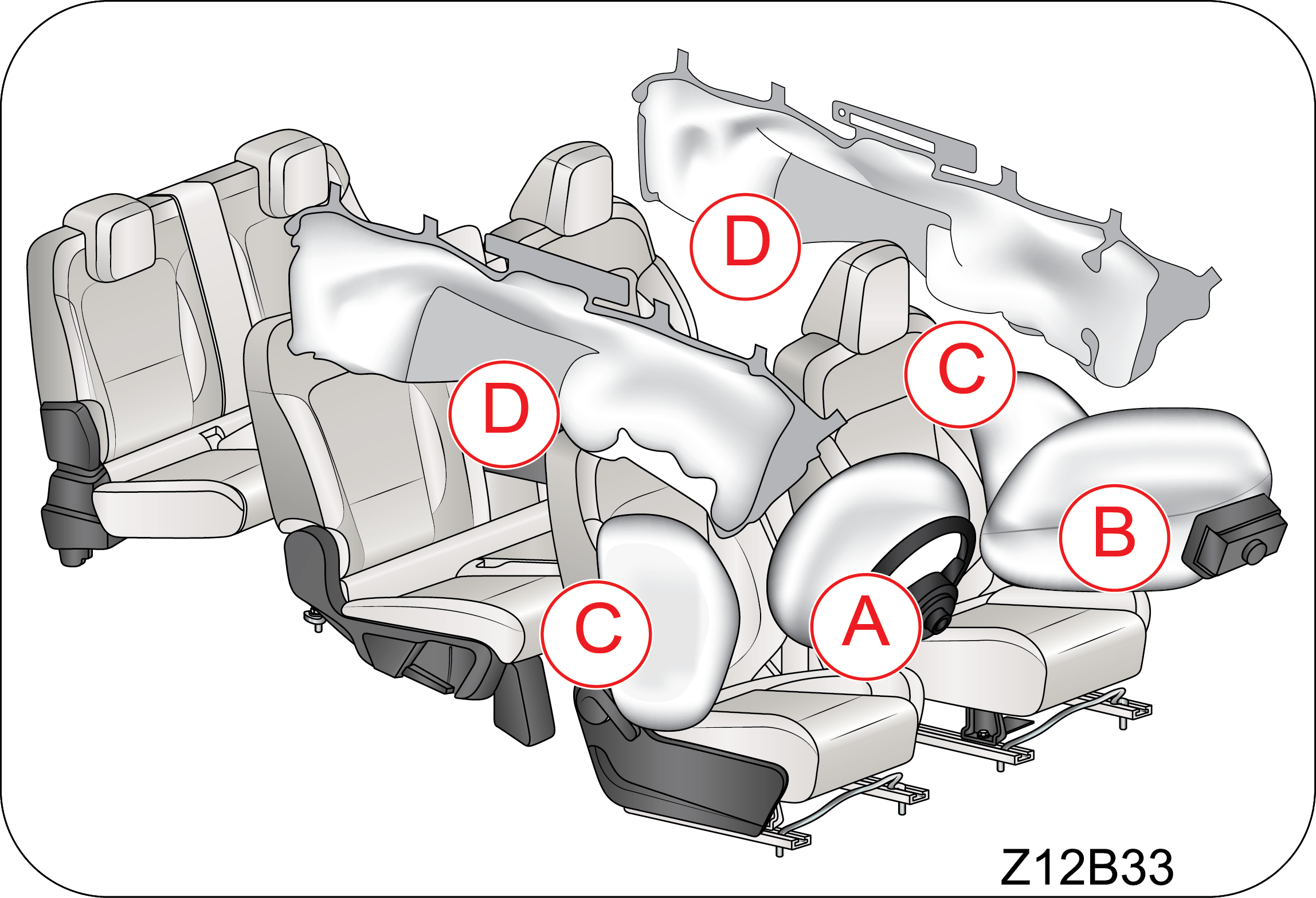
|
A:Driver Airbag
B: Front
Passenger Airbag
C:Two side
(seat) impact airbags (if equipped)
D: Two curtain
airbags (if equipped)
|
2.5.1 Driver and Front Passenger
Airbag
Your vehicle is equipped with a Supplemental Restraint System (Airbag)
and lap/shoulder belts at both the driver and front
passenger seating positions. The indications of the system's presence are the letters “SRS AIRBAG”
embossed on the airbag
pad cover in the steering wheel and the passenger's side front panel pad above the glove box.
The SRS is designed to deploy the front airbag only when an impact is
sufficiently severe and when the impact angle is less
than ± 30° from the forward longitudinal axis of the vehicle.
Driver Airbag
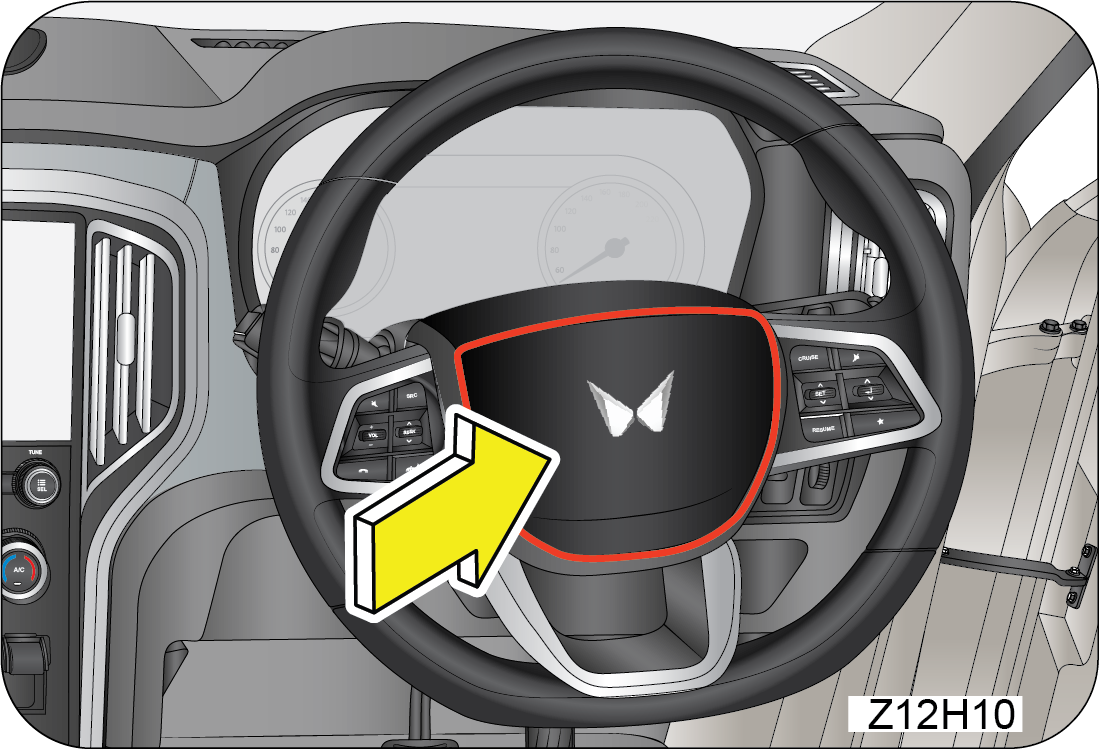
|
|
Front Passenger
Airbag
|
|
|
Front airbag are not
intended to deploy in side-impact, rear impact or rollover crashes. In addition, front airbag
will not
deploy in frontal crashes which are below the prescribed deployment threshold where risk of
serious injuries is low.

Do not place any objects
over the airbag or between the airbag and yourself. It cause
injuries.
2.5.2 Side Impact Airbag (If
equipped)
|
|
Your vehicle is equipped with side impact airbag in
both the front seats. The purpose of the airbag is to provide the vehicle's
driver and/or the front passenger with additional protection during side impacts or
collisions.
|
|
|
|
The side impact airbags are
designed to deploy only during certain side-impact collisions, depending on the crash
severity,
angle, speed and point of impact. To minimise the risk of severe injury in the event of a
crash, every passenger must always
wear their seat belt (see the chapter on Seat Belts in this manual). The airbags inflate very
quickly with great force. Do
not position any part of your body too close to airbag, you or especially children could be
seriously injured/killed by a
deploying airbag.

| • | In the case of a side collision, the curtain airbag may be deployed together with the relevant side airbag on the side the collision occurs |
| • | The side impact airbag is supplementary to the seat belt systems and is not a substitute for them. Therefore, your seat belts must be worn at all times while the vehicle is in motion. The airbags deploy only in certain side impact conditions severe enough to cause significant injury to the vehicle occupants |
| • | For best protection from the side impact airbag system and to avoid being injured by the deploying side impact airbag, all seat occupants should sit in an upright position with the seat belt properly fastened. The driver's hands should be placed on the steering wheel at the 9:00 and 3:00 positions. The passengers arms and hands should be placed on their laps |
| • | Do not use any accessory seat covers. Use of seat covers could reduce or prevent the effectiveness of the system |
| • | Do not install any accessories on the side or near the side impact airbag |
| • | Do not place any objects over the airbag or between the air bag and yourself |
| • | Do not place any objects (an umbrella, bag, etc.) between the door and the seat. Such objects may become dangerous projectiles and cause injury if the supplementary side impact airbag inflates |

Do not cover the front
seats with anything. It hinders the air bag inflation

An airbag is not
designed to deploy in every type of crash. Depending on the type of accident or impact,
the front airbags
independently deploy thereby protecting the occupants. It is not necessary that ALL the
airbags deploy during an accident.
2.5.3 Side Curtain Airbag (If
equipped)
The side
curtain air bags are contained between right above the front and rear doors and the end of
the vehicle roof.
The Side Curtain air bags
are located along sides of the roof rails on the A & B pillars. They are designed to help
protect
the heads of the front seat occupants and the rear outboard seat occupants in certain side
impact collisions. The curtain
airbag are designed to deploy depending on the crash severity, angle, speed and impact. The
curtain airbag are not designed
to deploy in all side impact situations, collisions from the front or rear of the vehicle or
in rollover situations.
|
|
|

| • | In the case of a side collision, the side airbag may be deployed together with the relevant curtain airbag on the side the collision occurs |
| • | In order for side and curtain airbag to provide the best protection, both front seat occupants and outboard rear occupants should sit in an upright position with the seat belts properly fastened. Importantly, children should sit in a proper child restraint system in the rear seat |
| • | When children are seated in the rear outboard seats, they must be seated in the proper child restraint system. Make sure to position the child restraint system as far away from the door side as possible, and secure the child restraint system in a locked position |
| • | Do not allow the passengers to lean their heads or bodies onto doors or place objects between the doors and passengers when they are seated on seats equipped with side and/or curtain airbag |
2.5.4 Passenger Airbag
Activation/Deactivation
The passenger air bag activation/deactivation option is available in
Instrument cluster menu.
Select Passenger Airbag Activation/Deactivation option in center
fascia switch to activate/deactivate (not inflatable) the
front passenger airbag as per below reference images
|
|
A: MENU
button
B: UP
C: OK
D: Down
|
|
|
|
|
Passenger Airbag OFF
Indicator
This Warning indicator glows on center fascia switch on IP when
passenger airbag “OFF” position.
Passenger Airbag ON
Indicator
This Warning indicator symbol glows on center fascia switch on IP when
selecting the passenger airbag “ON” option to enable
the passenger airbag.
2.5.5 Airbag System Malfunction Lamp
Airbags do not require any regular maintenance or service. The airbag
system malfunction lamp illuminates when the ignition
is ON, and it turns OFF after about two seconds as self check confirming normal operations of airbag
system and malfunction
lamp.
This lamp monitors airbag sensor assembly, airbag sensors, indicator
lamp, seat belt pre-tensioner assemblies, inflators,
interconnecting wiring and power sources.
If either of the following conditions occur, there is a
malfunction of the airbags or seat belt pre-tensioner. Immediately
contact your Mahindra Authorised Dealer.
| • | The lamp does not glow when the ignition is switched ON or glows beyond six (6) seconds after switching the ignition ON |
| • | The lamp comes ON at any other time, even briefly |
| • | The lamp comes ON intermittently |

Never make any modifications to
your vehicle which could affect the performance of airbag system. In particular, changes to
the vehicle frame, bumpers, bull bar, front fenders, ride height, suspension, seat belts,
interior trim, seats or steering
wheel (especially covers, pads or other trim), could prevent proper deployment of the airbag. If
you need to make any modifications
to accommodate any disability you may have, please contact your Mahindra Authorised
Dealer.
Never try to open or strike the
airbag cover. If the airbag cover is cracked or damaged in any way, the airbag may not function
as intended. Take the vehicle to an Mahindra Authorised Dealer.
Even if the airbags do not deploy during an accident, take your
vehicle to an Mahindra Authorised Dealer for a thorough inspection
of the airbag and seat belt systems, no matter how minor the accident. The airbag system could have
been damaged, and may
not work as intended in the future, resulting in serious injury.
2.5.6 Airbag Inflation/Deployment
The airbag sensors constantly monitor the forward deceleration of the
vehicle. If an impact results in a forward deceleration
beyond the designed threshold level, the system triggers the airbag inflators. This initiates a
chemical reaction which quickly
fills the airbags with non-toxic gas.
Upon deployment, tear seams moulded directly into the pad covers
separate under pressure from the expansion of the airbags.
Further opening of the covers allows full inflation of the airbags. A fully inflated airbag, in
combination with a properly
worn seat belt, slows the driver's or the passenger's forward motion, reducing the risk of head and
chest injury.
After complete inflation, the airbag immediately starts deflating,
enabling the driver to maintain forward visibility and
the ability to manoeuvre or operate other controls.
Deployment of the airbags happen in a milliseconds, producing a loud
noise releasing a ‘white smoke’ and residue along with
a non-toxic gas. This does not indicate a fire. This smoke may remain inside the vehicle for some
time, and may cause some
minor irritation to the eyes, skin or breathing. Be sure to wash off any residue with soap and water
as soon as possible to
prevent any potential skin irritation. Exit the vehicle as soon as possible after the accident.

Airbag deployment may cause windshield to break.

| • | Do not modify, remove, strike or open the seat belt pre-tensioner assemblies, airbag sensor or surrounding area or wiring. Failure to follow these instructions may prevent them from activating correctly, cause sudden operation of the system or disable the system, which could result in serious injury |
| • | Parts of the airbag module (steering wheel hub, airbag cover and inflator) may be hot for several minutes after deployment. The airbags inflate only once |
| • | Do not cover the steering wheel, instrument panel, seats with any object (e.g. dash panel covers, seat covers) which may prevent the airbags from inflating properly |
| • | The airbags inflate with considerable force. While the system is designed to reduce serious injuries, primarily to the head and chest, it may also cause other, less severe injuries to the face, chest, arms and hands. These are usually in the nature of minor burns or abrasions and swelling, but the force of a deploying airbag can also cause more serious injuries, especially if an occupant's hands, arms, chest or head is in close proximity to the airbag module at the time of deployment. Sit straight and well back into the seat. Move your seat as far back as practical to allow room for airbag inflation, while still allowing you to properly operate/drive the vehicle |
The front passenger should never sit on the edge of the seat, stand
near the glove compartment, rest feet or other parts of
the body on the dashboard when the vehicle is moving.
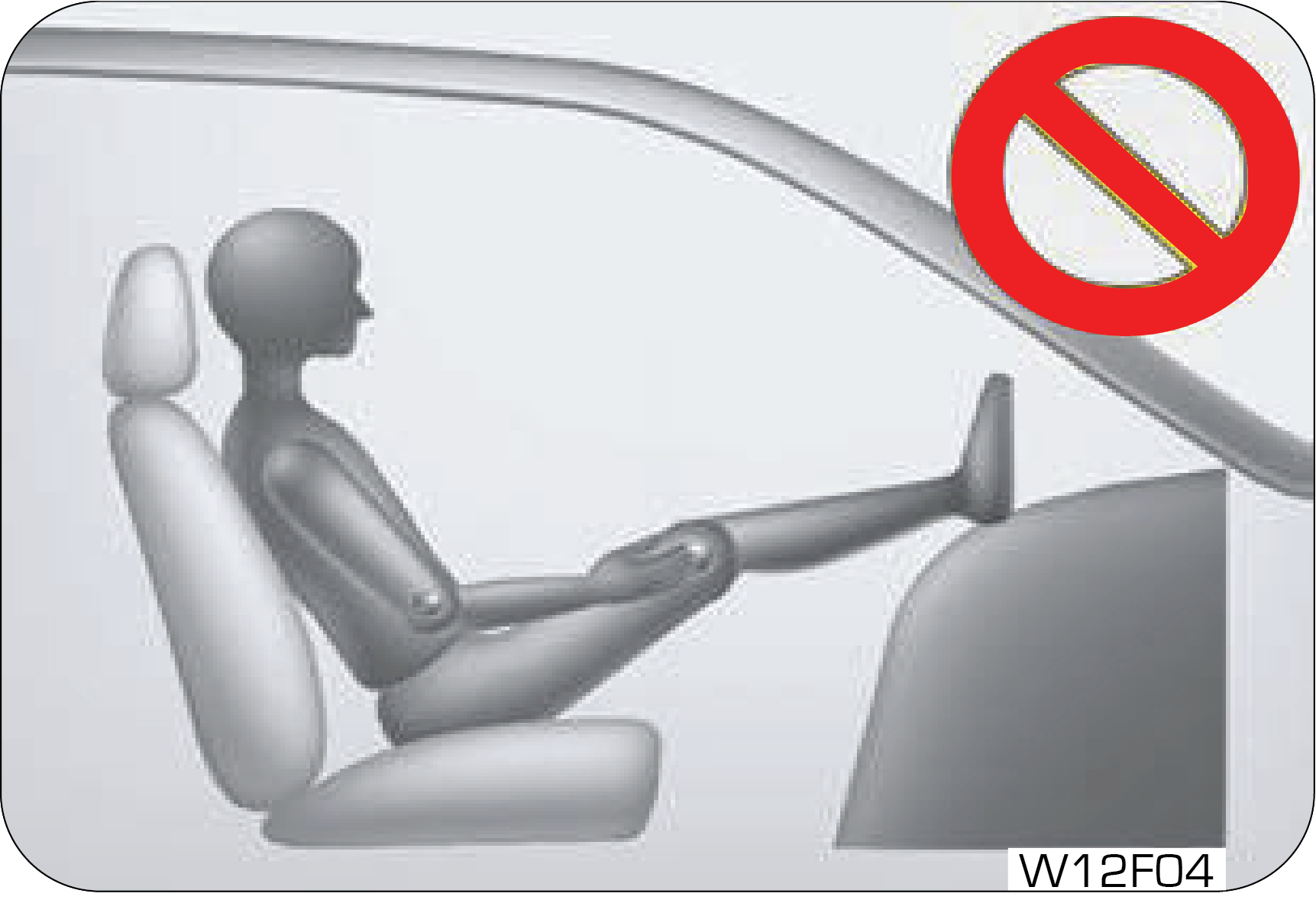
|
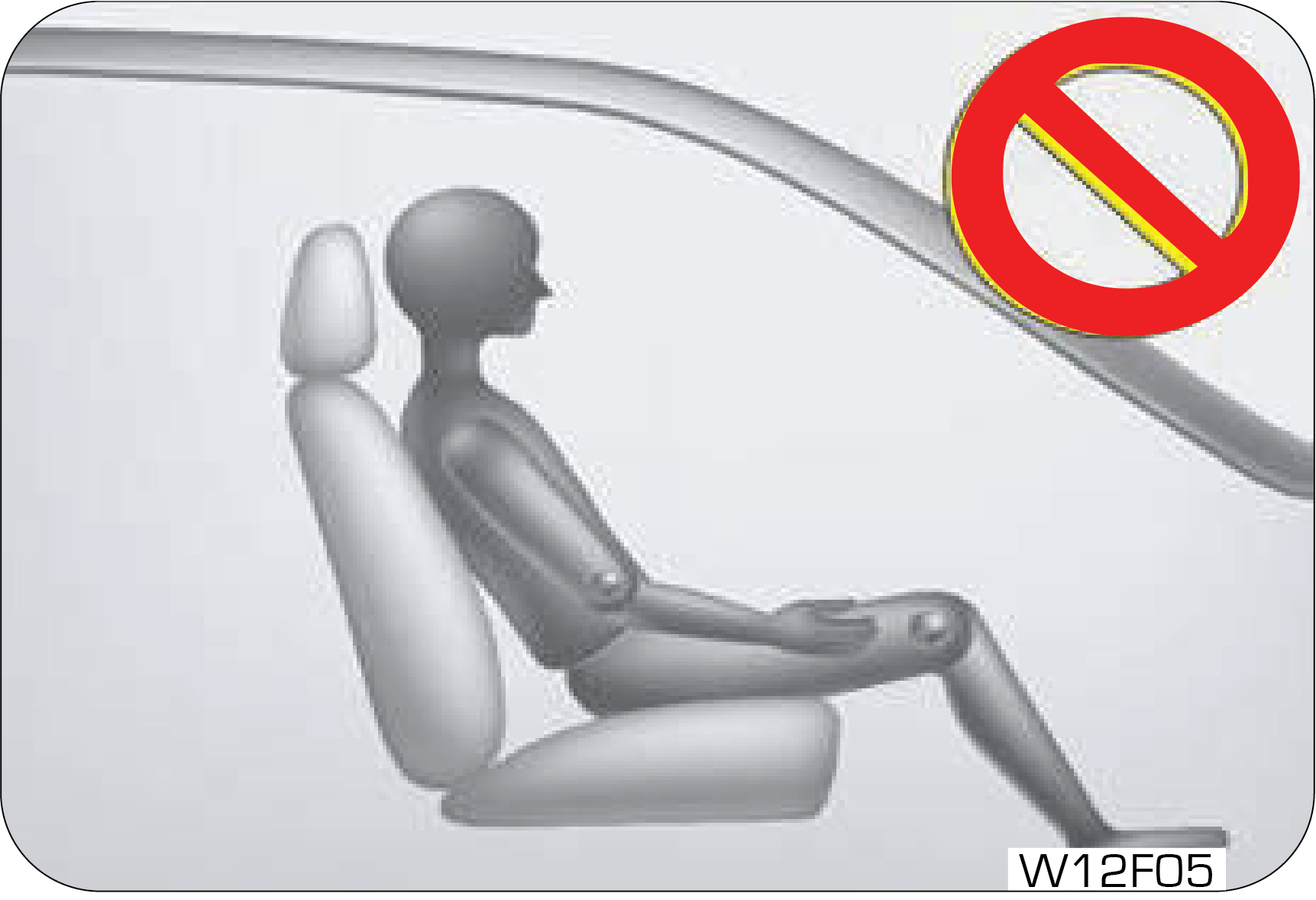
|
The driver or front passenger who is too close to the
steering wheel or dashboard can be seriously injured during airbag deployment.
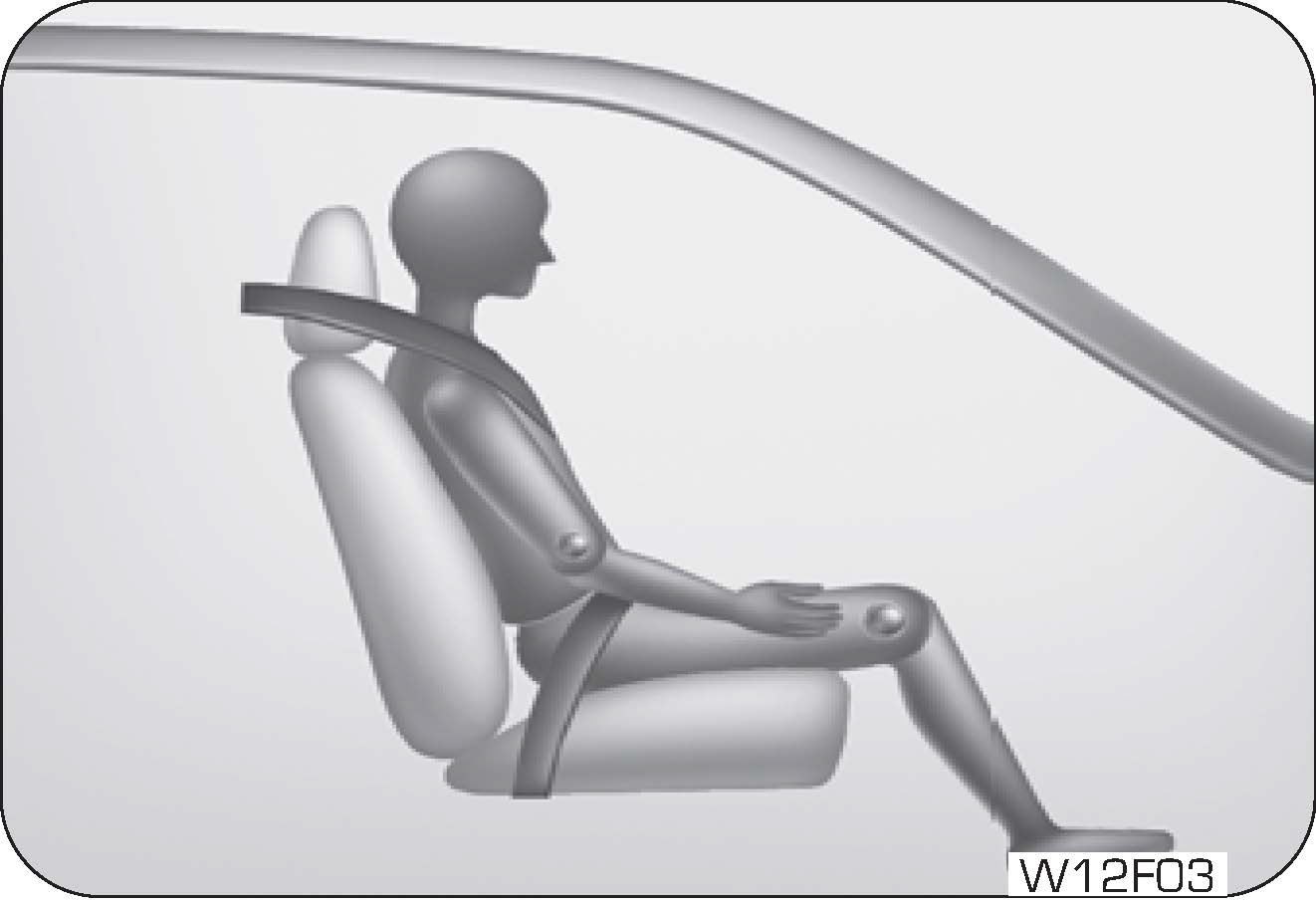
|
|
| • | The front passenger must sit as far back as possible from the dashboard |
| • | Sitting improperly or out of position can cause occupants to be shifted too close to a deploying airbag, strike the interior structure or be thrown from the vehicle resulting in serious injury |
| • | Always sit upright with the seat back in an upright position, on the seat cushion centre with your seat belt on, legs comfortably extended and your feet on the floor |
| • | All vehicle occupants must be properly restrained using the seat belts |
| • | All infants and children must be placed in the rear seat of the vehicle in a child restraint seat and be properly restrained by seat belts |
| • | Front airbags can injure occupants who are improperly positioned in the front seats |
| • | Even with airbags, improperly belted and un-belted occupants can be severely injured when the airbag inflates. Always follow the precautions about seat belts, airbags and occupant safety contained in this manual |
| • | Do not modify the front seats. Modification of the front seats could interfere with the operation of the supplemental restraint system or side impact airbags |
| • | Do not place items under the front seats. Placing items under the front seats could interfere with the operation of the supplemental restraint system sensing components and wiring harnesses |
2.5.7 Child Restraint and Airbag
Do not use a rearward facing child restraint on a seat
protected by an airbag in front of it
In addition, do not place front-facing child restraints in the front
passenger’s seat either. If the front passenger airbag
inflates, it could cause serious or fatal injuries to the child.
This is indicated also on stickers that are located at the following
position. On the front passenger’s sun visor
|
|
|
|

Extreme Hazard! Do not use a rear-facing child restraint on a seat
protected by an airbag in front of it!
Never put a child restraint in the front passenger’s seat. If the
front passenger airbag inflates, it can cause serious or
fatal injuries.
Never hold an infant or child on your lap. The infant or child
could be seriously injured in the event of a crash. All infants
and children should be properly restrained in appropriate child safety seats or seat belts in the
rear seat.
Instal the child restraint system on the rear outboard seats, and
securely lock the child restraint system in position with
the help of i–Size.
Always Buckle Children (ABC) in the back seat. It is the safest
place for children of any age to ride.
2.5.8 Airbag Deployment

The images shown in this section are for illustrative purpose only.
They may not look like your model/variant or vehicle.
Front Airbag
|
|
Front airbag are designed to inflate in a frontal
collision depending on the intensity, speed or angles of impact of the front
collision.
|
2.5.9 Airbag Non-deployment
Impacts below a pre-determined threshold level may not
cause the airbag to deploy in the following cases:
| Collision with Utility Poles or Trees : | |
|
|
Airbags may not inflate if the vehicle collides with
objects such as utility poles or trees, where the point of impact is
concentrated to one area and the full force of the impact is not delivered to the
sensors.
|
|
Frontal Impact :
|
|
|
|
Frontal impact beyond 30º range from head-on to the vehicle.
|
Frontal Side Swipe
Impact:
Frontal offset impact to the vehicle may not provide the
deceleration force necessary for airbag deployment.
|
|
In an angled collision, the force of impact may direct
the occupants in a direction where the airbags would not be able to
provide any additional benefit, and thus the sensors may not deploy any airbags.
|
Under-ride Situations :
Running under a truck's tailgate may not provide the
decelerations necessary for airbag deployment.
|
|
Airbags will not inflate in this “under-ride” situation
where deceleration forces that are detected by sensors are significantly
low.
|
Rear-end Collisions :
|
|
Frontal airbags are not designed to inflate in rear
collisions, where occupants are moved backward away from the airbags by
the force of the impact. In this case, inflated airbags would not be able to provide
any additional benefit.
|
Potholes or Stepped
Surfaces :
|
|
Driving into a big pothole, stepped surface or hitting
the far side of a hole/incline will not inflate the airbag.
|
Rollover:
|
|
Airbags will not inflate in rollover accidents where
airbag deployment would not provide protection to the occupants. However,
side impact and curtain airbags may inflate only when severe side impact causes
rollover.
|
2.5.10 Airbag Service
Airbag Replacement:
Self-servicing or tampering with the airbag system is dangerous. An airbag could accidentally deploy
causing serious injuries,
or will not deploy when there is a need. Always take your vehicle to an Mahindra Authorised Dealer for
inspection and repairs.
Removing SRS Related Parts:
We do not recommend removing the instrument panel, steering wheel, seats or airbag related
parts or sensors by any individual
or garages which are not recommended. Airbags could accidentally activate and cause serious injuries,
or they may not deploy
when there is a need. Visit an Mahindra Authorised Dealer if these parts must be removed.
Airbag Disposal:
Improper disposal of an airbag or a vehicle with live airbags can be extremely dangerous.
Approach an Mahindra Authorised
Dealer to do these jobs.
Airbag Repair: If the front
airbag cover or instrument panel airbag cover shows signs of damage or having been removed, the
vehicle should
be towed to the nearest Mahindra Authorised Dealer for repair. Do not attempt to self repair or
reinstall the cover.
Airbag Maintenance: For
cleaning the airbag covers/areas, use only a soft dry cloth or one which has been moistened with plain
water. Solvents
or cleaners could adversely affect the airbag covers and proper deployment of the system.
3 INSTRUMENT CLUSTER FEATURES
3.1 Instrument Cluster Overview
|
High
|
|
Low
|
3.1.1 Speedometer
| High | Low |
|
|
|
The speedometer indicates actual vehicle speed in kilometers per hour.

The vehicle speedometer is affected
by size of the tyres used. If the size of the tyres are changed from those fitted at the
factory, the speedometer might not display the correct road surface speed and distance
travelled.
Over Speed Alert Buzzer
Primary level: Buzzer will trigger single chime in every 2 minutes when the
vehicle speed reaches 80 kmph. once primary level chime is triggered,
it will continue playing until speed is reduced to 76 kmph or goes beyond 120
kmph.
Secondary level: Buzzer will trigger periodic chime when the vehicle speed reaches
120 kmph and chime will continue playing until vehicle speed
is reduced to 114 kmph. Below this speed primary level chime will be triggered and will
continue till 76 kmph.
3.1.2 Tachometer
| High | Low |
|
|
|
The tachometer indicates engine speed in thousands of RPM (revolutions per minute).
Each division is 1000 RPM. Operating the
engine at very high RPM may lead to excessive engine wear and low fuel economy. Maintain steady engine
speed below 2500 RPM
and do not accelerate or decelerate abruptly.

Do not over-accelerate the engine
during idling, this can cause severe engine damage and would be treated as abuse of the
engine which is not covered by warranty.

Tacho red band range:
Gasoline 5500 - 7000 rpm
Diesel 5000 - 7000 rpm
Diesel (High Variant): Tacho red band shall change based on engine parameters
3.1.3 Fuel Level Gauge
| High | Low |
|
|
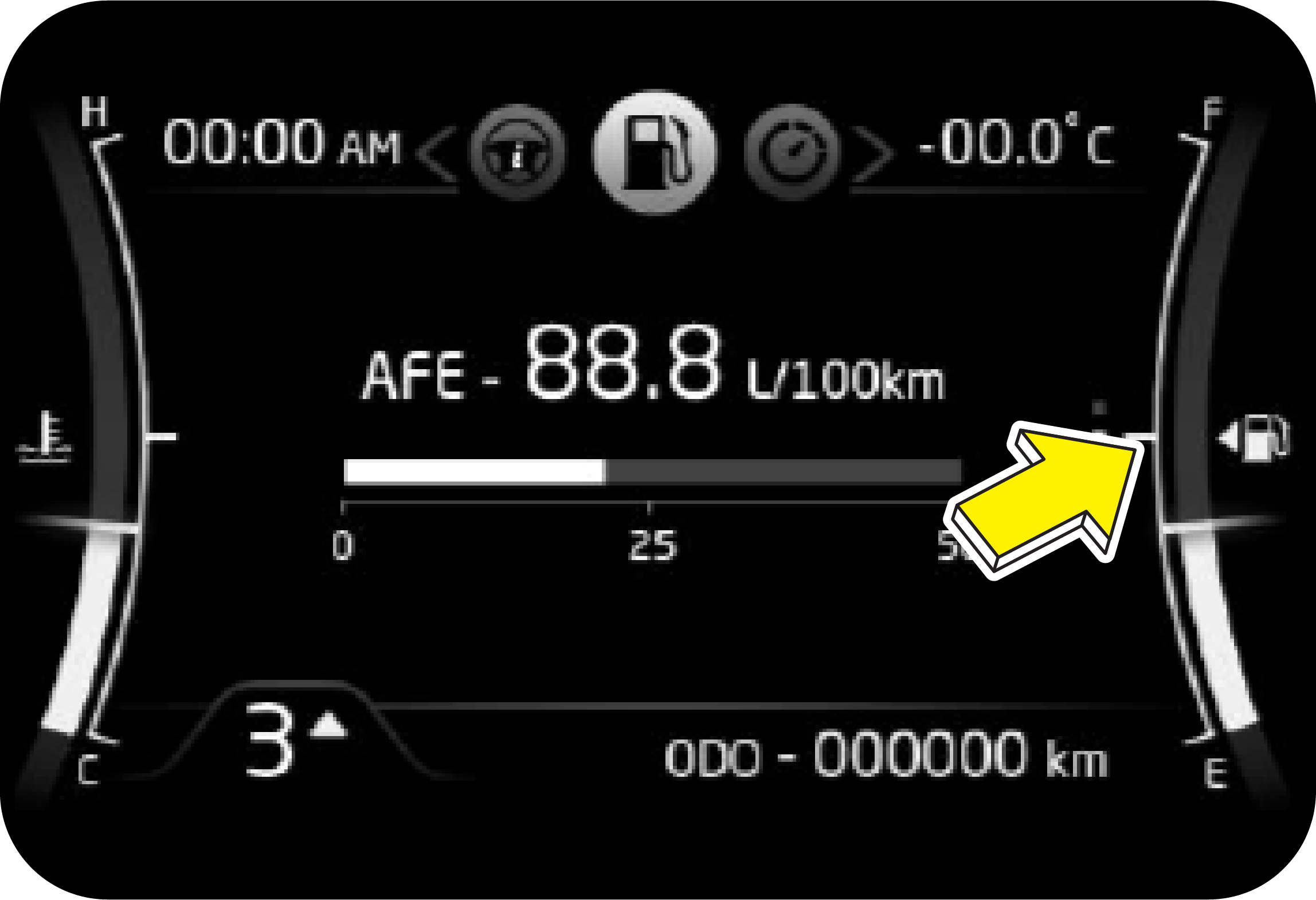
|
The fuel level gauge functions only when
the ignition is switched ON. It gives the status of the fuel level in the fuel tank.
F indicates the tank is full (57 +/- 2 liters), E indicates the tank is
empty.
When the fuel level reaches the reserve,
the last bar will be displayed and low fuel telltale will be ON (approx 12 liters).
when the fuel tank is completely empty, last bar goes off from display and low fuel telltale
will be blinking . The amount
of fuel required to fill the tank up may be less than the specified tank capacity, as a small
amount of reserve fuel always
remains in the tank.
On inclines or curves, due to the
movement of fuel in the tank, the fuel level may fluctuate or the last bar may flash earlier
than usual. Always check the fuel level when the vehicle is on level road. If the last bar is
still off and telltale is blinking
even after filling sufficient fuel, contact your Mahindra Authorised Dealer as soon as
possible.

When all the bars in the display starts
blinking/flashing, contact the nearest Mahindra Authorised Dealer at the earliest.
It is highly recommended to start the fueling at ignition
OFF condition and turn on the ignition only when fueling is finished
to get correct fuel level.
IGN ON fuel filling may lead to inconsistency and can
cause for DTE fluctuation.
3.1.4 Temperature Gauge
The engine coolant temperature gauge functions only when the ignition is switched
ON. It indicates the instantaneous engine
coolant temperature. The coolant temperature varies with changes in weather, load on engine and
driving pattern.
If the gauge moves beyond the normal operating range toward “H” mark. it indicates
the engine overheating that may damage
the engine. Allow engine to cool. In such situations switch OFF the AC and observe any improvements in
the temperature gauge.
If not, stop the vehicle and allow the engine to cool down. Check the coolant level in the coolant
reservoir and top-up if
required. If the engine is still overheating, contact your nearest Mahindra Authorised Dealer.
| High | Low |
|
|
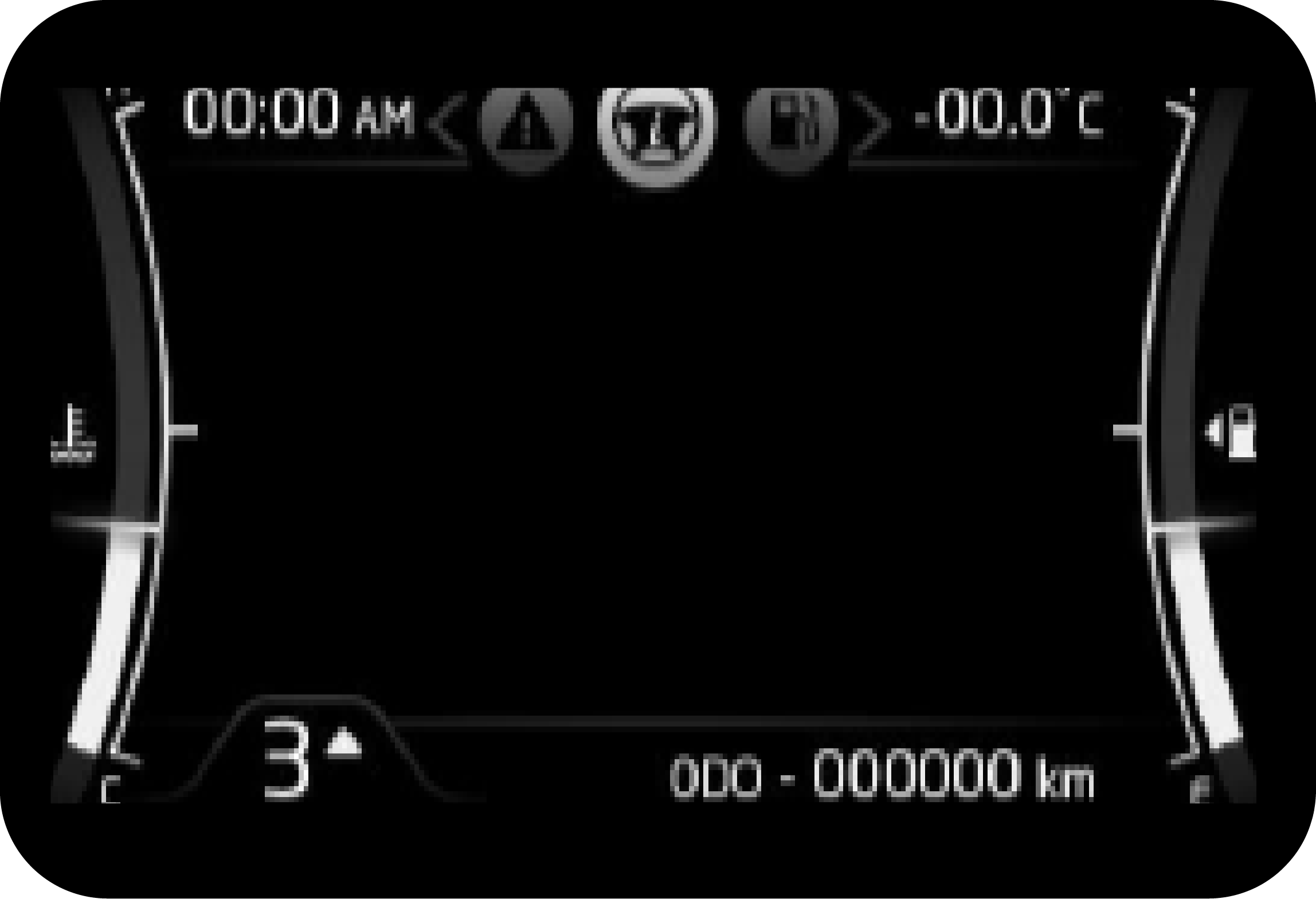
|

Never remove the Degassing tank cap when the engine is hot. The engine coolant
is under pressure and could splash on to skin/eyes
causing severe burns. Wait for the engine to cool down before adding coolant to the reservoir.
Do not continue driving the vehicle with an overheated engine. This will lead to
damage of engine components and engine seizure.
3.1.5 Outside Ambient Temperature (if equipped)
| High | Low |
|
|

|
This Screen shows the outside ambient temperature and we can change
units based on infotainment setting.
3.1.6 Gear Information
Gear information shows the actual gear the vehicle is currently in.
Based on the various parameters, it will also provide an up shift / down shift
recommendation for better fuel economy.
| High | Low |
|---|---|
|
|
|
Operating Conditions
UP/DOWN arrows recommend to up shift / down shift the drive gear.
3.2 Drive Mode (If equipped)
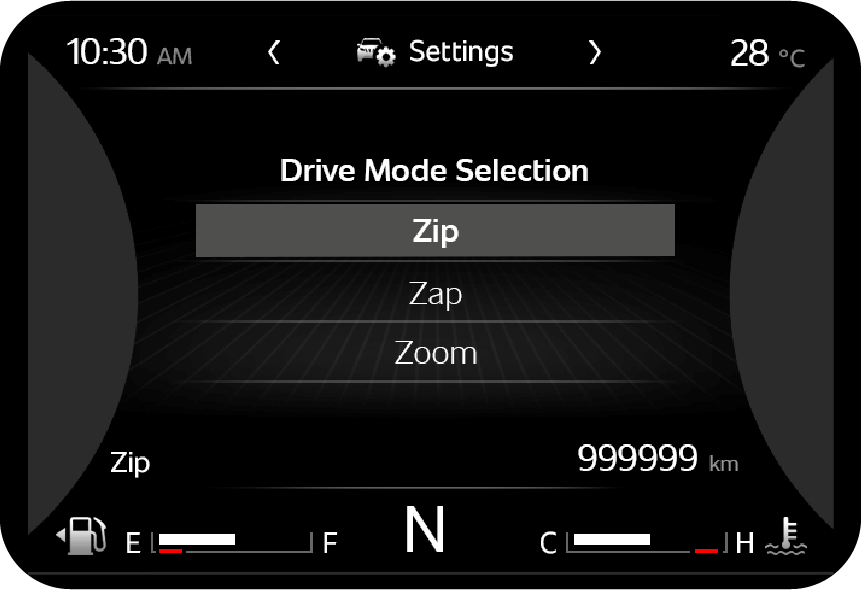
|
Drive modes shall change driving characteristics by changing elements
such as Engine power, Traction control, Climate control
and Steering weight settings.
|
The vehicle has selectable drive modes like Zip, Zap and Zoom. The
selection of drive mode is made via dedicated button or
switches.
Drive selection menu part of cluster and cluster will display the current
drive mode.

Refer Drive modes in the “Starting and Driving chapter” for further details
3.3 4XPLOR Mode (If equipped)
4XPLOR Drive Mode System is designed to adjust the vehicle’s driving dynamics for the
type of terrain you’re driving on. It
uses throttle position, vehicle speed, and steering angle to determine how your vehicle is responding
compared to your commands.
Torque is then adjusted front to rear and side to side in a split second to enhance traction

Refer 4XPLOR mode in the “Starting and Driving chapter 1” for further details
3.4 Instrument Cluster Control Switches
The instrument cluster menus can be changed using the cluster control
switches on the Steering wheel or the Driver side switch
bank.
Driver side switch bank is located on the right hand side of the Instrument
Panel.
A: UP button: Used to scroll vertically up
direction
B: Down button: Used to scroll vertically
down direction
C: Menu button: Horizontal scrolling i.e.,
change in menu
D: OK button: Select a option
The right most steering wheel switches are used to control the instrument
cluster menus.
A: Menu button: Horizontal scrolling i.e.,
change in menu
B: UP button: Used to scroll vertically up
direction
C: OK button: Select a option
D: Down button: Used to scroll vertically
down direction
E: Favorite button: Select a Favorite option
3.6 Drive Info
| High | Low |
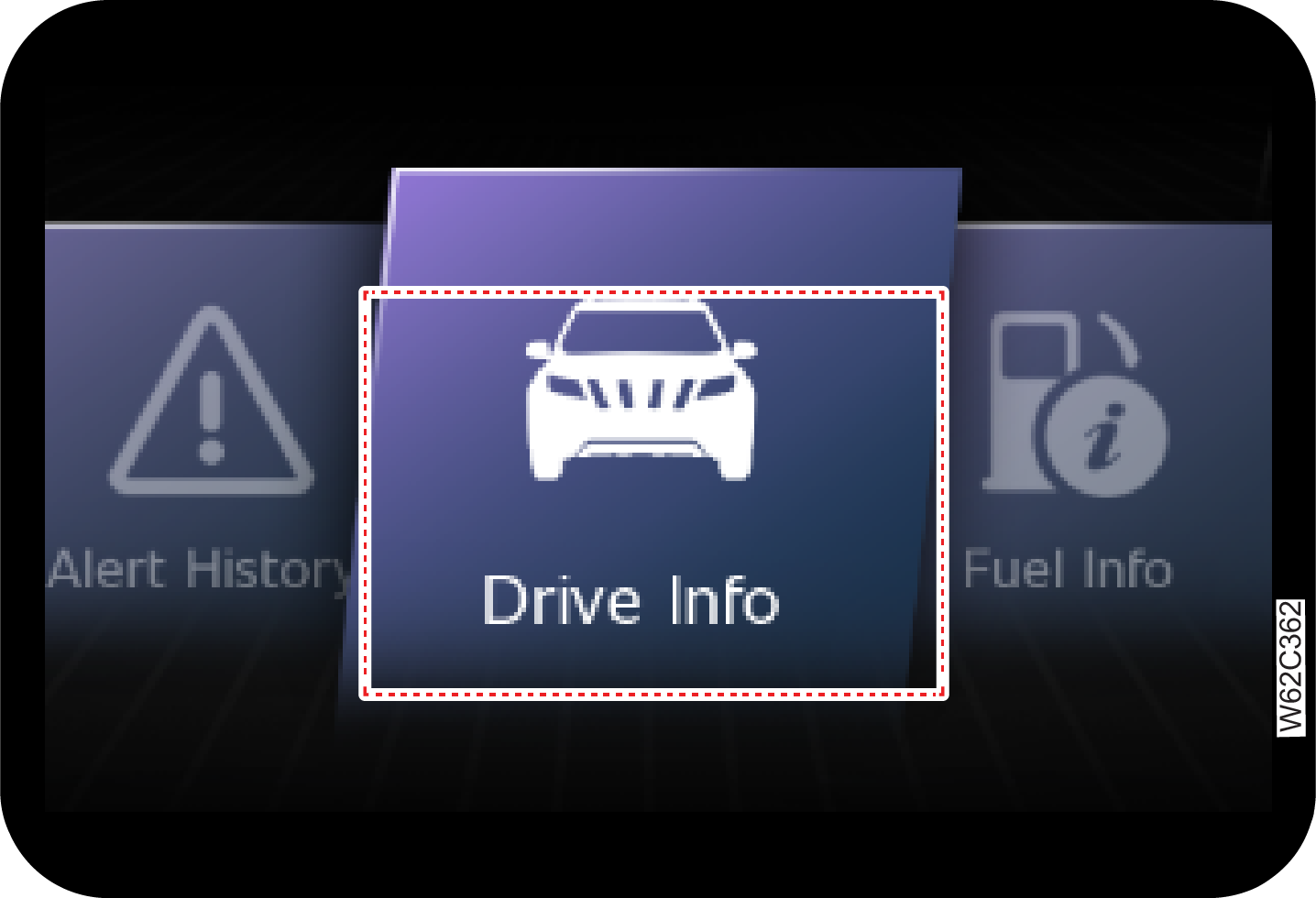
|
|
Drive info can be accessed by pressing MENU
button in Steering Wheel/Driver side switch bank.
Use OK button to enter Drive info page.(High)
3.6.1 Trip Meter
| High | Low |
|
|
|
Two trip meters are available with max range of 9999.9 km. These are
available in drive info menu and can be accessed using
UP/DOWN switch.
Trip meter can be reset by long press of OK. Resetting trip will reset
average speed and drive time associated with the particular
trip.

It is recommended to reset the trip meters when battery is disconnected and
reconnected
3.6.2 Drive Time
| High | Low |
|
|
|
Drive Duration is the elapsed time from the start of this trip cycle.
Drive time is part of trip page. Drive time will reset along with trip
reset.
3.6.3 Average Speed
| High | Low |
|
|
|
Average Speed is calculated based on the total distance covered and time taken from
the start of this trip cycle. Average
speed info is part of trip page. Average speed will reset along with trip reset.
3.6.4 Clock & Date
| High | Low |
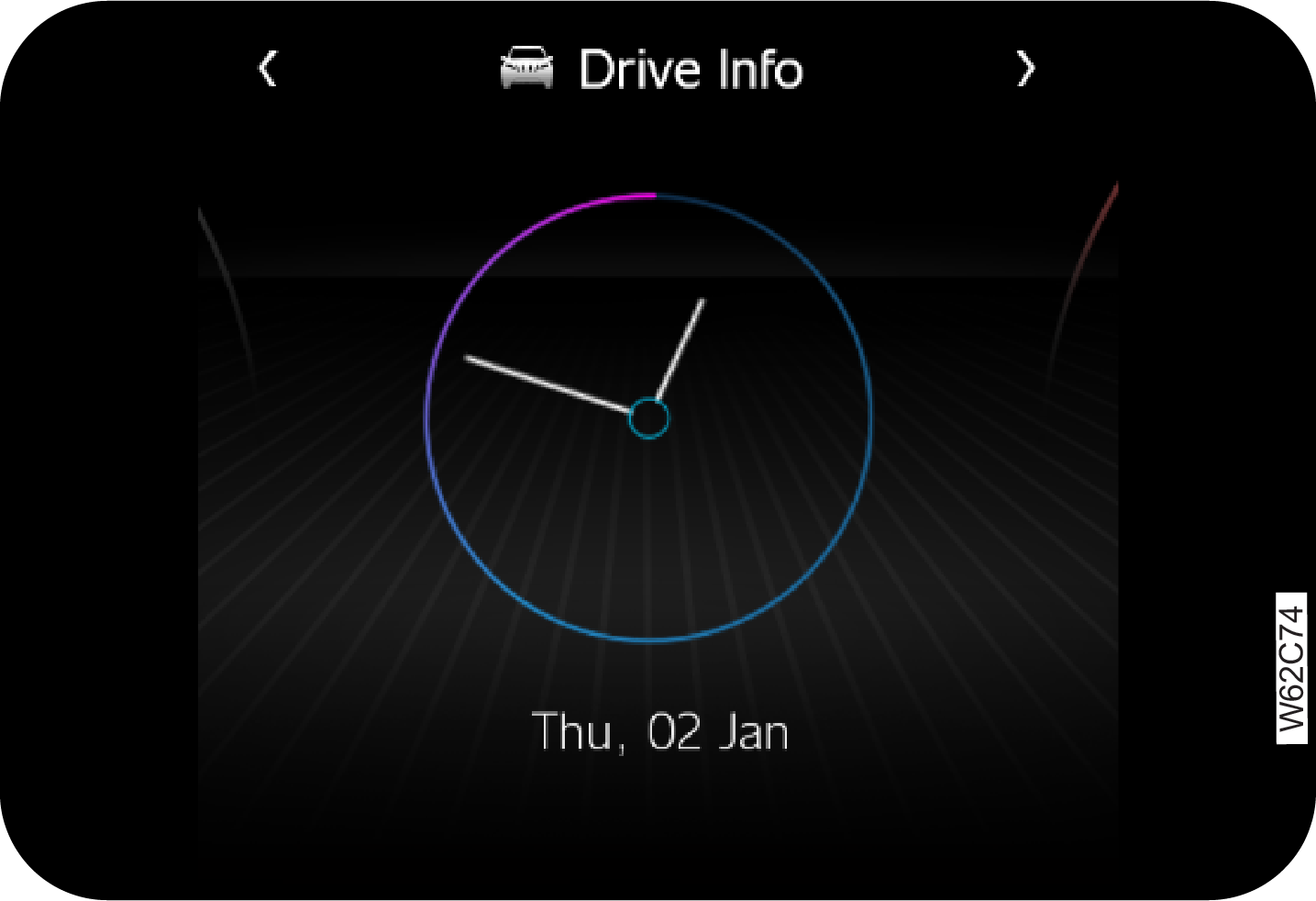
|
|
The time on the clock & date is in sync with the infotainment. Any
change in infotainment will reflect on the cluster. Refer settings for changing
clock type.
3.6.5 Driver Drowsiness Index (If equipped)
Drowsiness detection is a safety technology that can prevent accidents
that are caused by drivers who fell asleep while driving.
|
|
Cluster will display the 5 level of driver attention level based on
drive Pattern
5 Attention Bars - Indicates that the driver is Completely Awake.
|
|
|
4 Attention Bars - Indicates that the driver is Quite Awake.
|
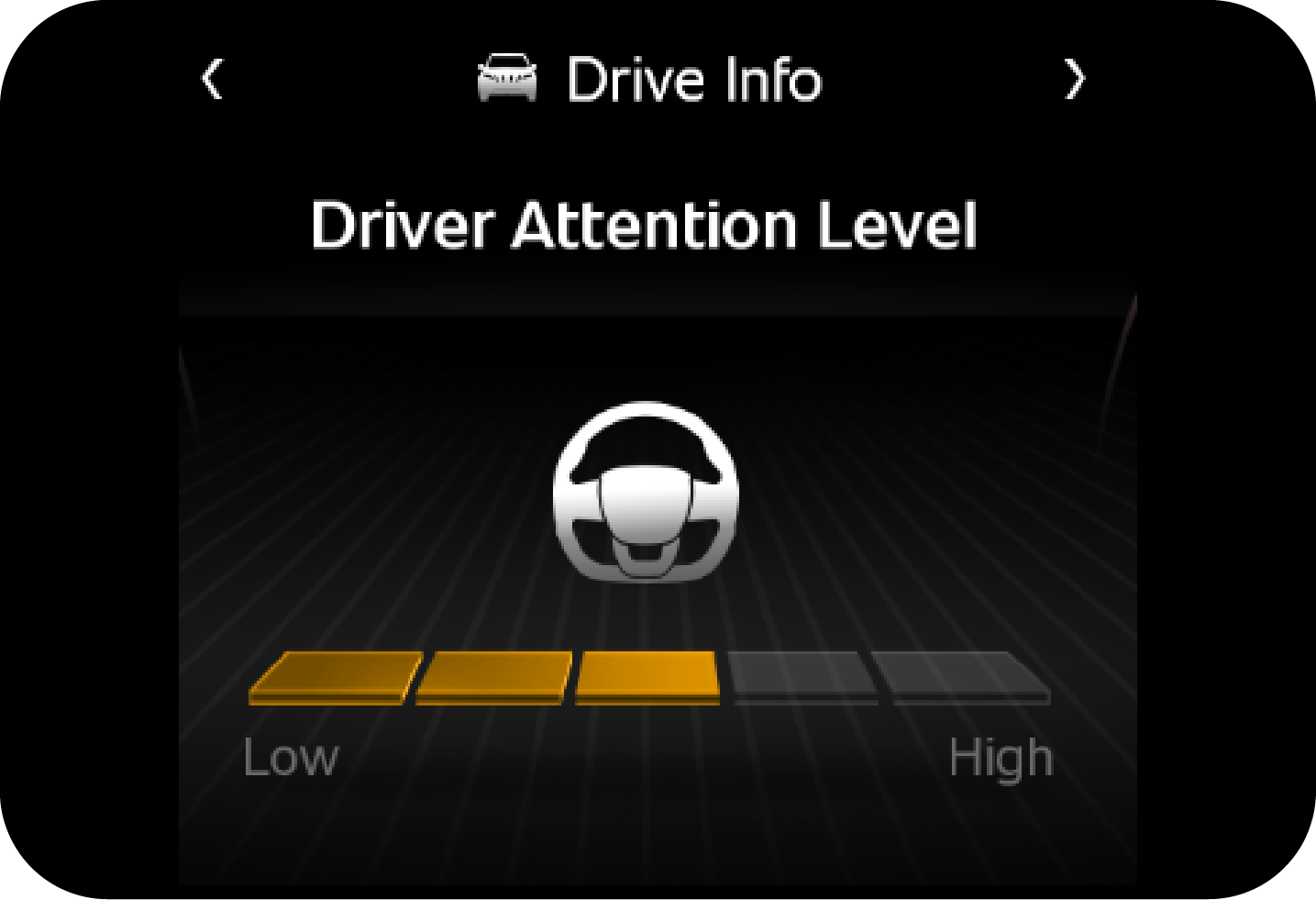
|
3 Attention Bars - Indicates that the driver is Neither Awake nor
Sleepy.
|
|
|
2 Attention Bars - Indicates that the driver is slightly sleepy and
can stay awake with effort.
|
|
|
1 Attention Bars - Indicates that the driver is extremely Sleepy and
can’t stay awake
|

Refer DDD section in “Starting and Driving the vehicle” chapter for more details
3.7 Fuel Info
|
Fuel info can be accessed by pressing MENU button in Steering
wheel/driver side switch bank.
|
|
|
High
|
Low
|
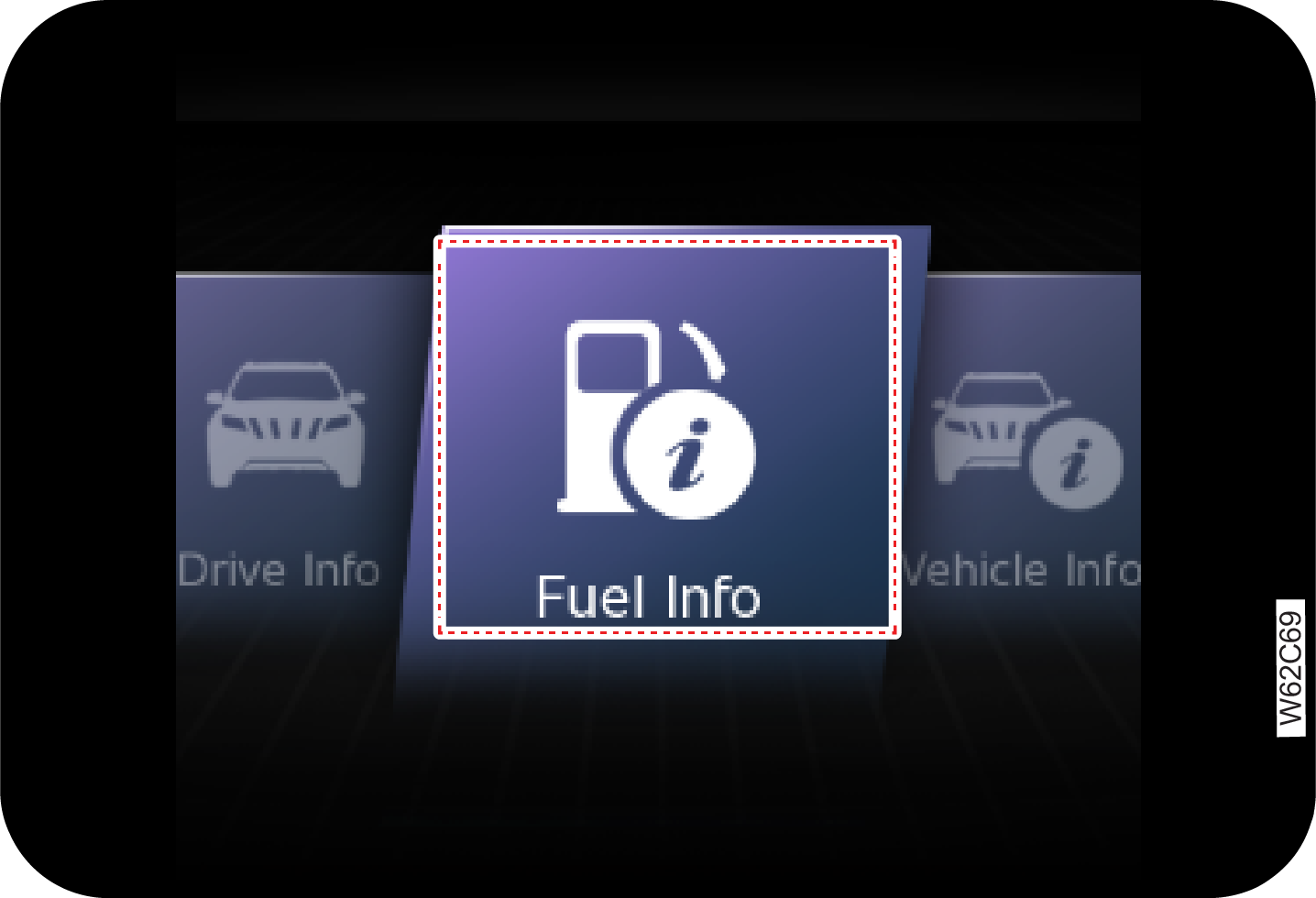
|
|
It displays data related to fuel consumption pattern of vehicle. Use OK
button to enter Fuel info page (High)
3.7.1 Distance to Empty (DTE)
|
High
|
Low
|
|
|
|
Distance to Empty is the approximate distance that can be covered with
the available fuel.
3.7.2 Average Fuel Efficiency (AFE)
AFE is calculated based on the last AFE reset cycle.
|
High
|
Low
|
|
|
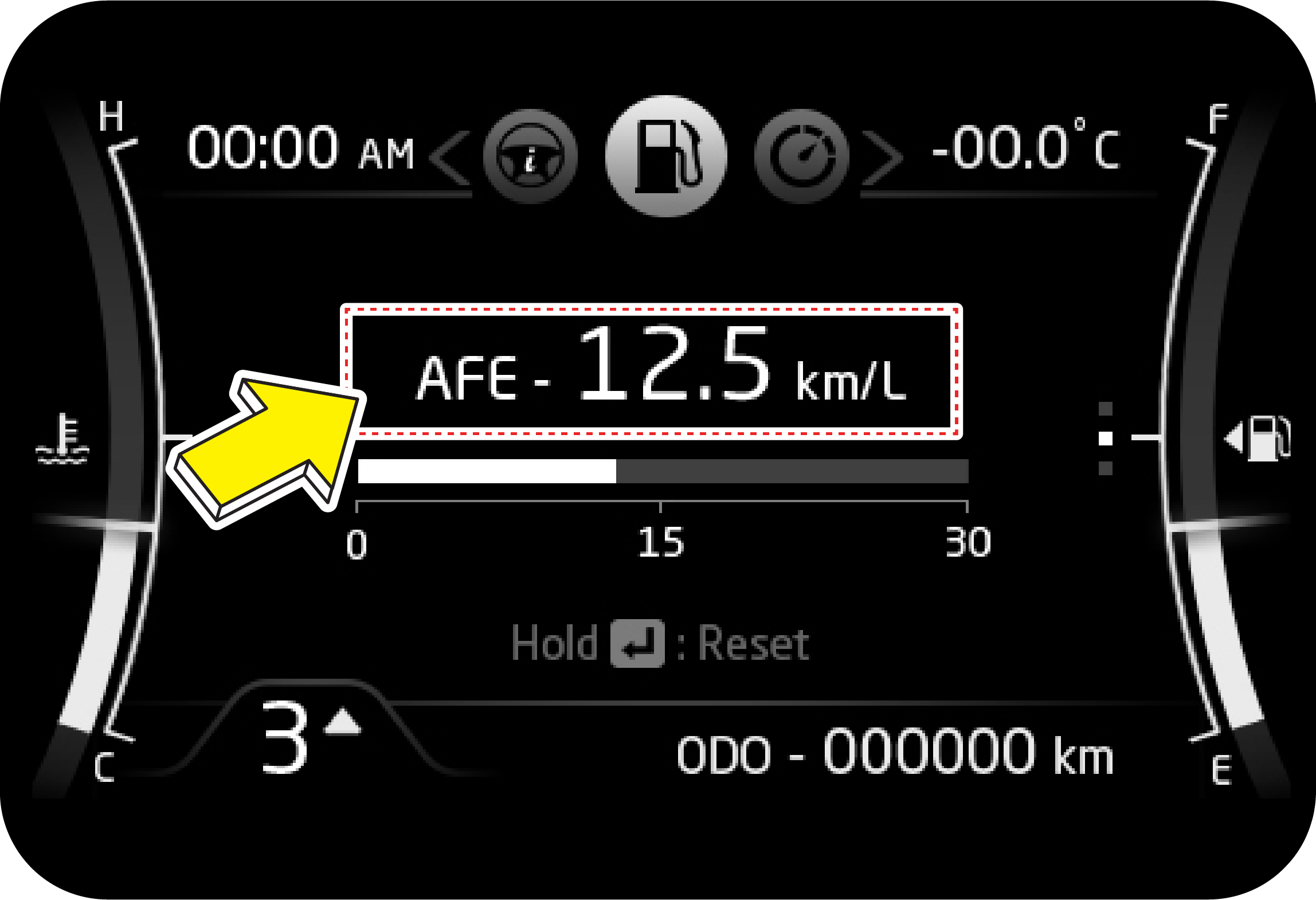
|
AFE can be reset by long press of OK button in Steering wheel/driver
side switch bank.
Additional options to change AFE reset to every ignition ON or after
every fuel refill are present in the settings menu.
3.7.3 Instantaneous Fuel Economy (IFE)
|
High
|
Low
|
|
|
|
Instantaneous Fuel Economy is calculated based on your current driving pattern.
Higher value on display means vehicle is consuming
less fuel, lower value on display implies it is consuming more fuel.
3.8 Digital Speed
Digital speedometer displays the speed of the vehicle numerically. It provides an
immersive experience by having option to
switch off the lights of Speedometer and Tachometer.
|
High
|
Low
|
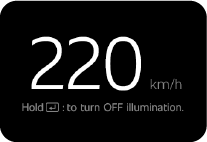
|
|
Digital speedometer can be accessed by pressing MENU button in Steering
wheel/driver
side switch bank.
Use OK button to enter Digital Speed page.
3.9 Vehicle Info
Vehicle info can be accessed by pressing MENU button in Steering wheel/driver side
switch bank.
|
High
|
Low
|
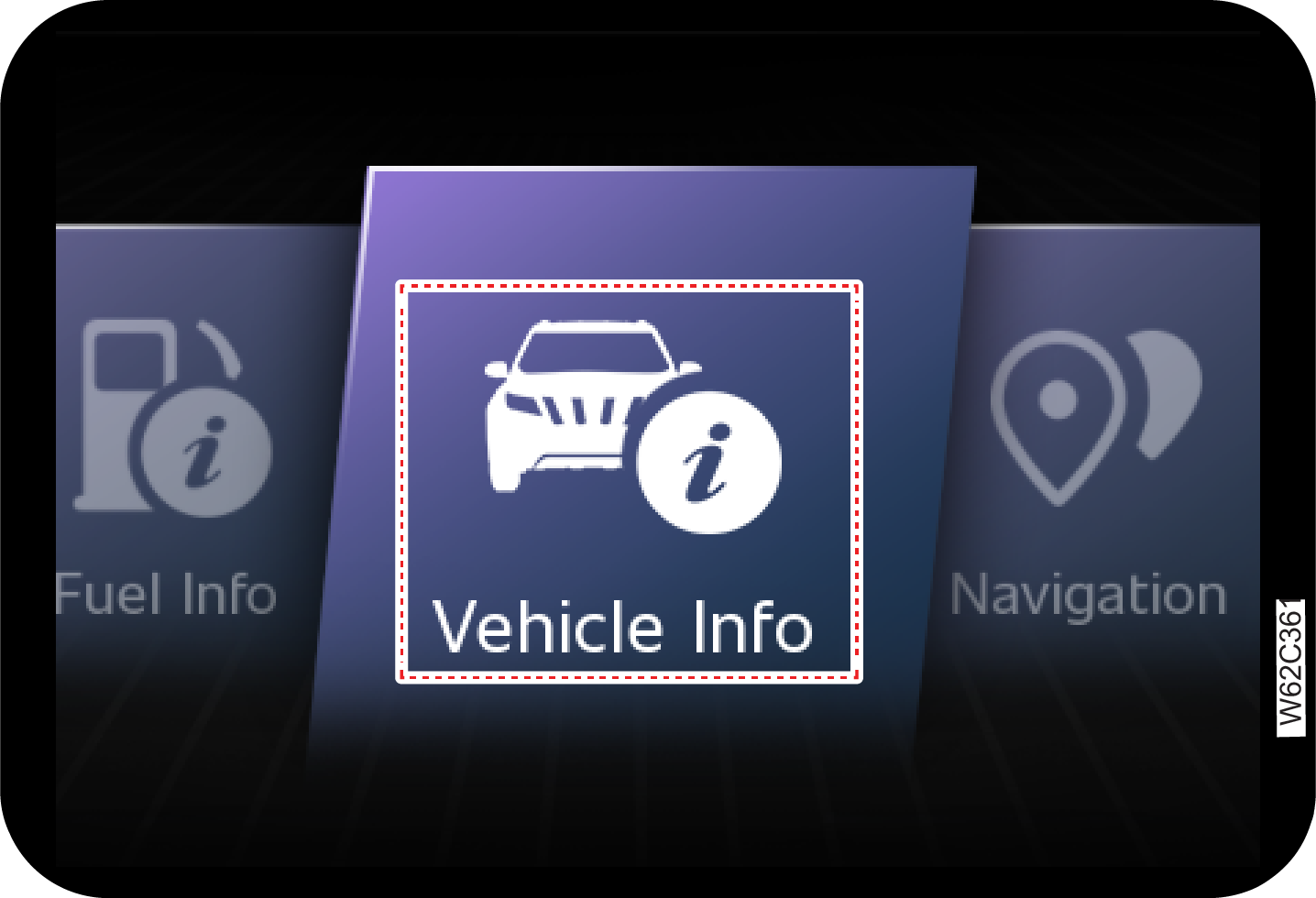
|
|
It displays data related to
vehicle
information like TPMS , Roll & Pitch and 4WD Torque distribution.
Use OK button to enter Vehicle
info
page.
3.9.1 Tyre Pressure (if equipped)
Tyre Pressure is an electronic system designed to monitor the air
pressure inside
pneumatic tyres.
This system will alert the driver if the tyre pressure falls below the low pressure
or raises above high pressure warning
limit for any reason. Including low temperature effects and natural pressure loss through the tyre.
The Tiretronics will continue
to alert the driver and will not turn off untill the tyre pressure is inflated to the recommended
pressure.
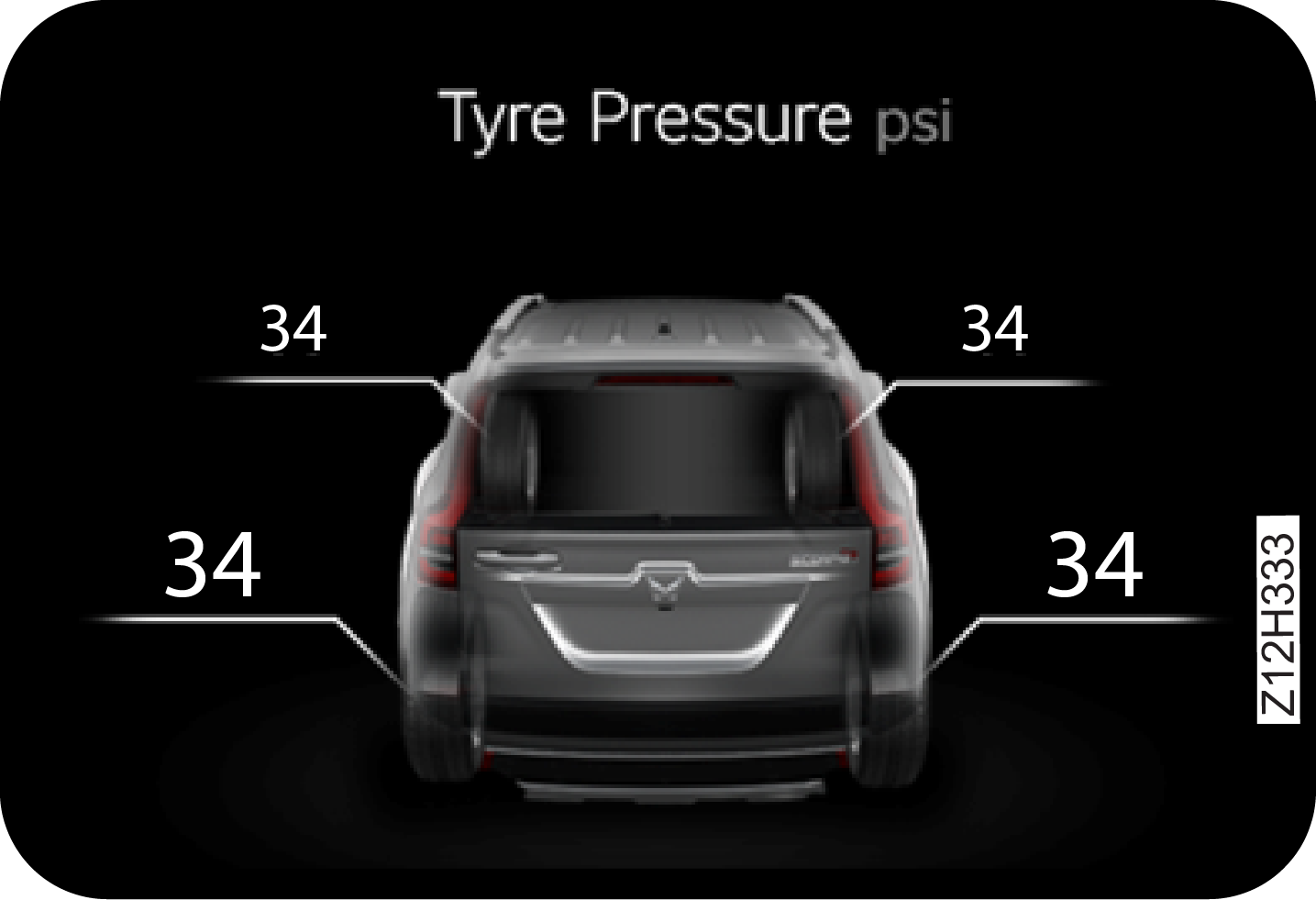
|
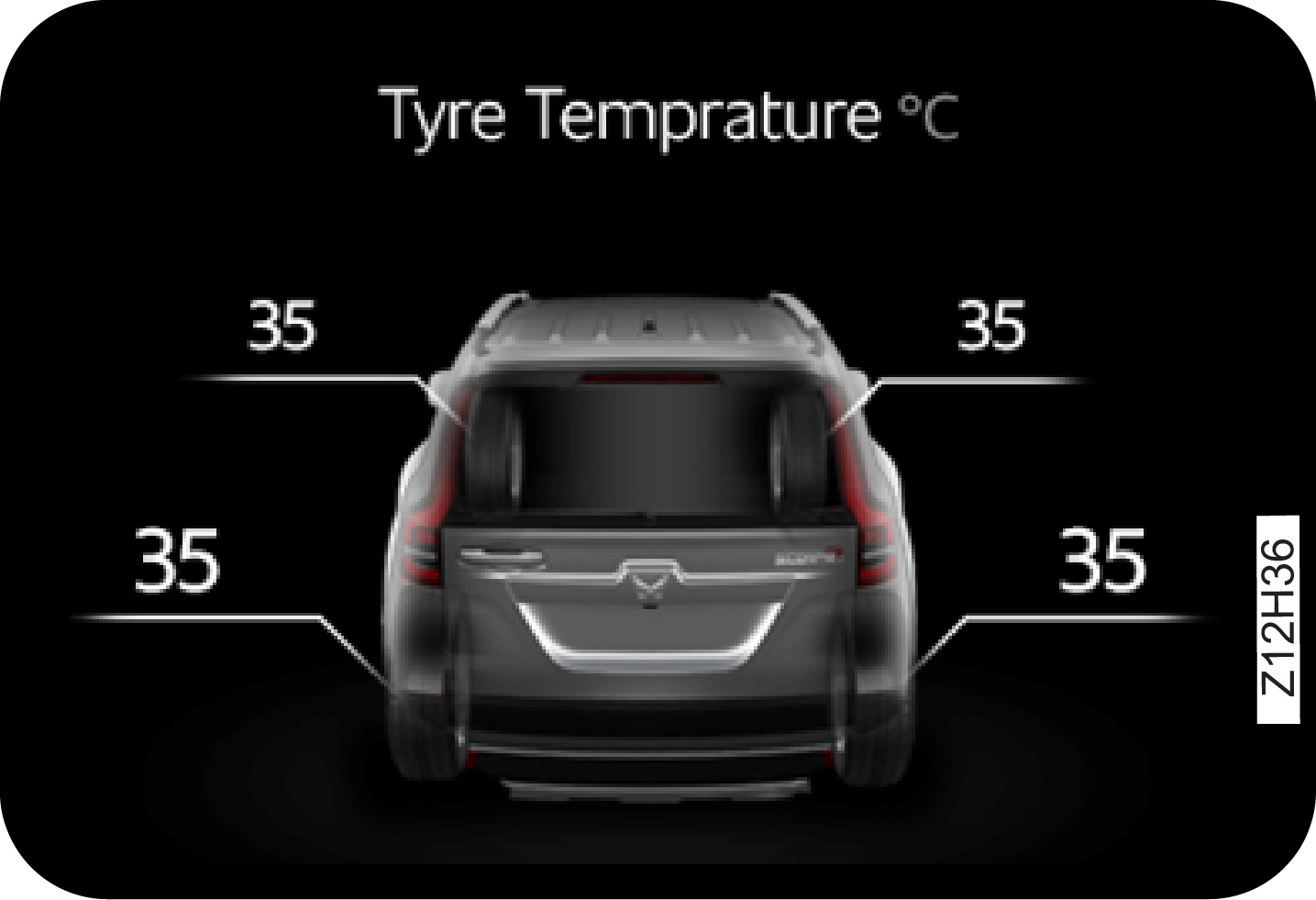
|

Refer Tiretronics chapter for more details.
3.10 Navigation (If equipped)
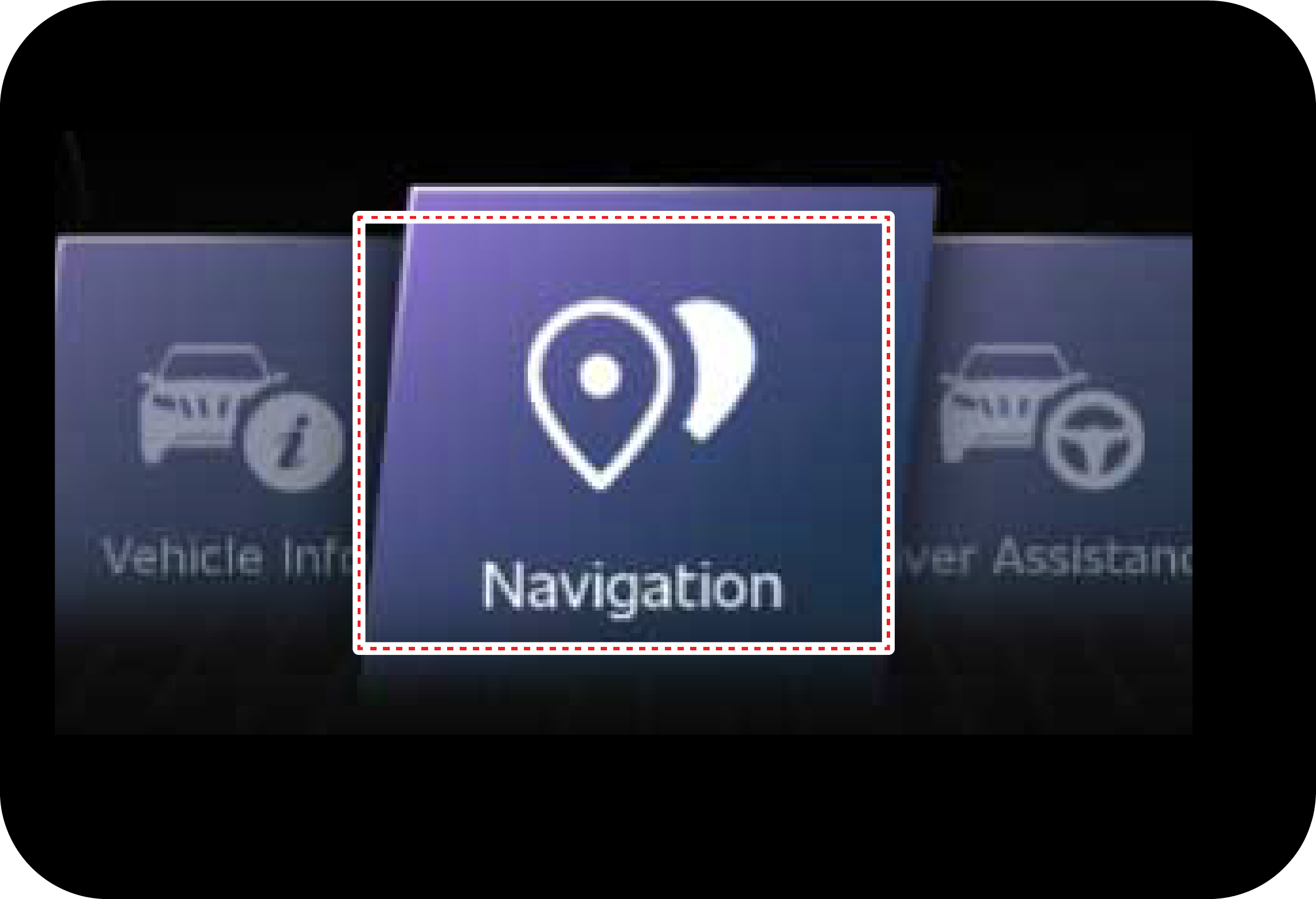
|
Navigation can be accessed by pressing MENU button in Steering
wheel/driver side switch bank.
|
It displays data related to map view which is displayed in infotainment.
Use OK button to enter Navigation page.
Cluster will display the Navigation information.
Like Turn By Turn Navigation and Full / Partial Map view from Android auto
(If
available) or native navigation.
|
Partial Screen Navigation
|
Turn by Turn Navigation
|
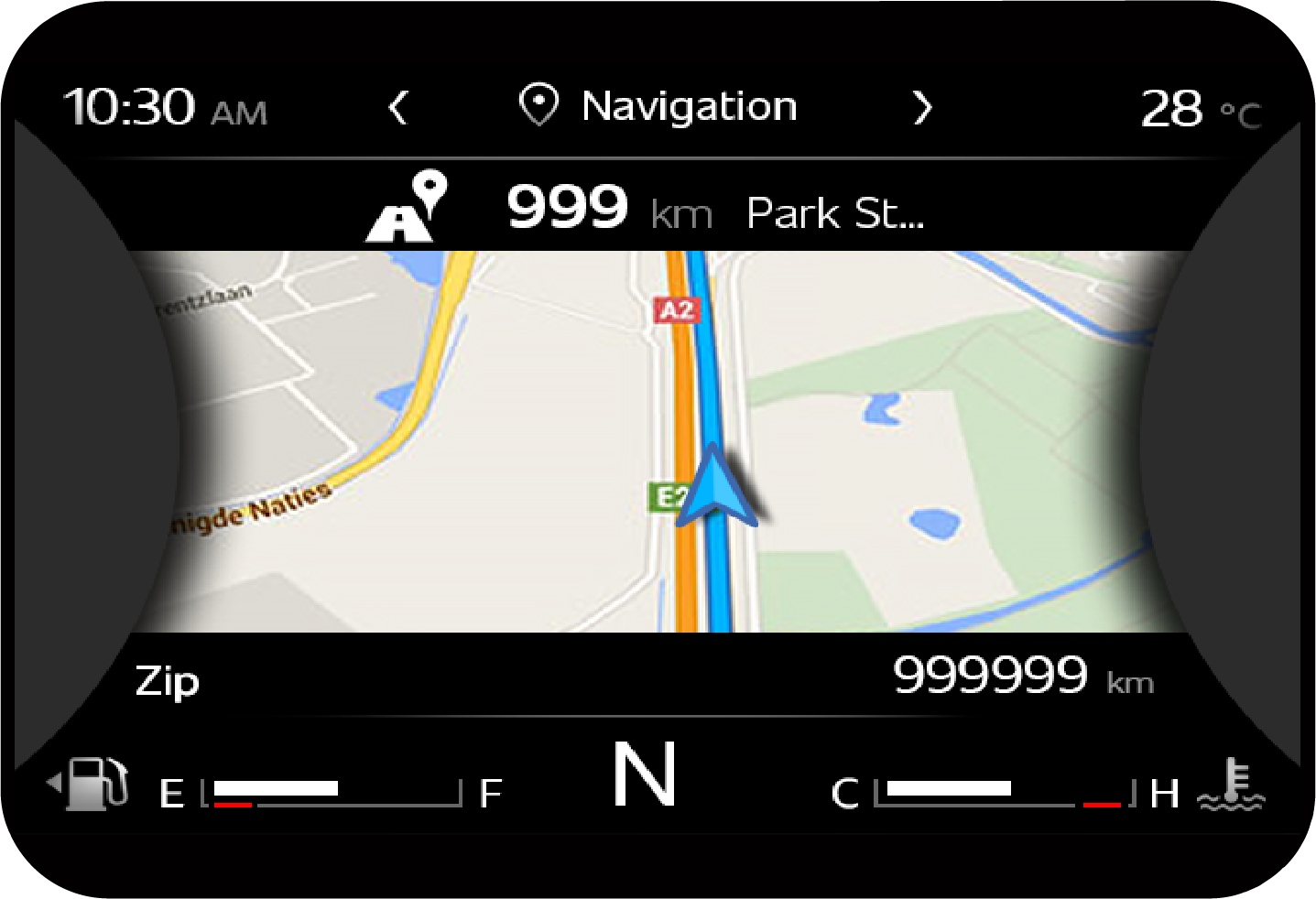
|
|
To enter Full navigation if you are at partial Navigation screen, Long
Press the OK
switch to view full map.
3.11 Cluster Setting (if equipped)
|
High
|
Low
|
|
|
|
Settings can be accessed by pressing MENU switch. To enter inside settings,
press ok.
Use UP / DOWN button to navigate setting features
|
Following settings are available:
|
|
|
1. AFE Auto Reset
2. Passenger Airbag
3. Drowsiness Detection*
4. TPMS – Auto Learn *
5. Tyre Fill Assist *
|
6. Sound*
7. Clock Type
8. Date *
9. Time *
10. Factory Reset
*- if equipped
|
3.11.1 AFE Auto Reset
|
High
|
Low
|
|
|
|
1. Navigate to Setting menu using MENU button.
|
High
|
Low
|
|
|
|
2. Press OK to enter setting. Press Up/Down button to navigate to AFE Auto Reset
option
|
High
|
Low
|
|
|
|
3. Press OK to enter AFE Auto Reset option. Use Up/Down button to navigate to the
option. Press OK to select.

After Ignition : After a predetermined time where the vehicle’s ignition is OFF
the AFE will reset.
After Refuelling : Refuelling at ignition OFF and then driving will reset the
AFE.
3.11.2 Passenger Airbag
|
High
|
Low
|
|
|
|
1. Navigate to Setting menu using MENU button.
|
High
|
Low
|
|
|
|
2. Press OK to enter setting. Press Up/Down button to navigate to Passenger Airbag
option
|
High
|
Low
|
|
|
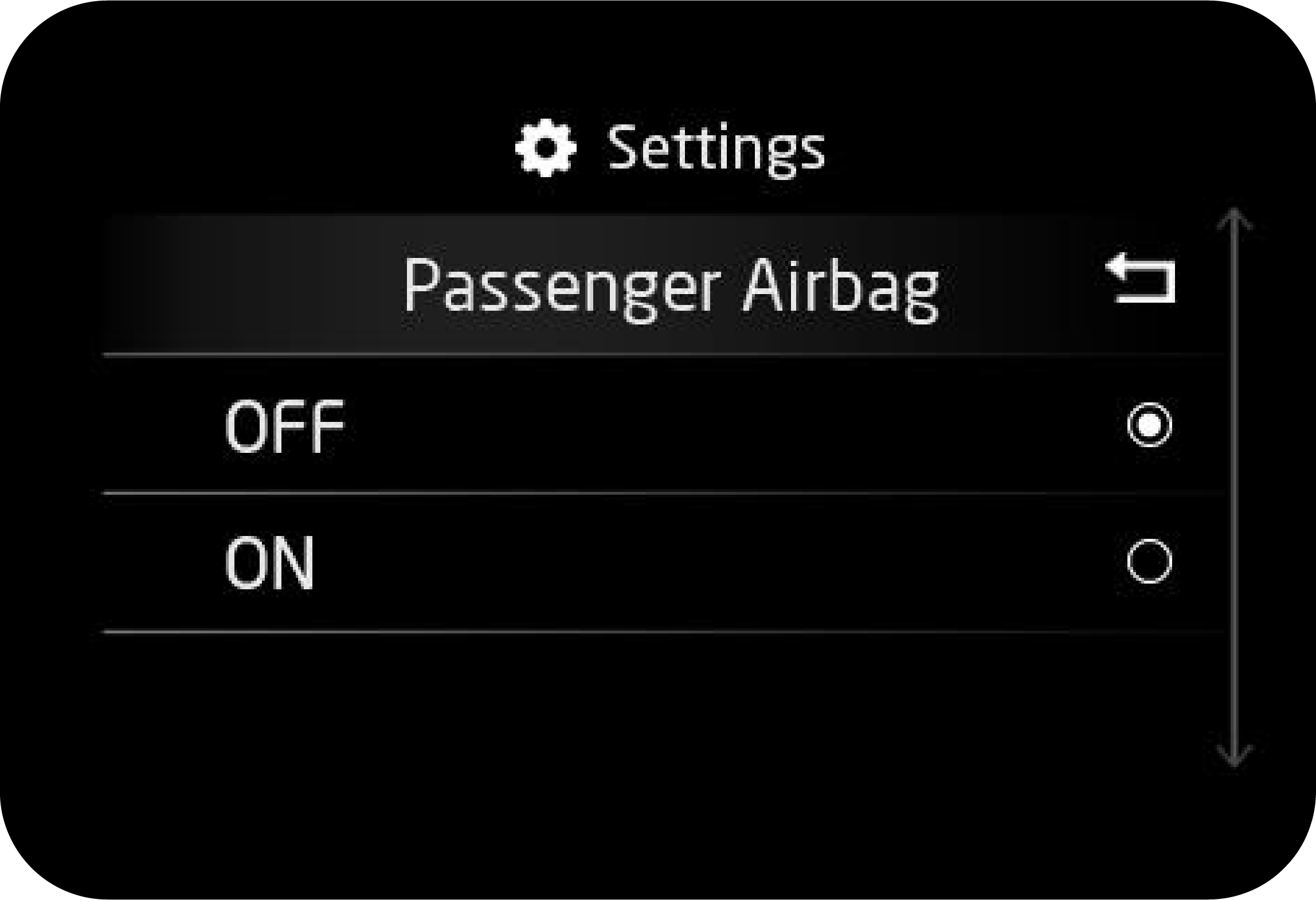
|
3. Press OK to Select following screen will appear. Use Up/Down button to navigate
to the option. Press OK to select, a pop-up
will appear to confirm the selection
|
High
|
Low
|
|
|
|
4. Press OK to select a option. Confirm your selection by selecting Ok or Cancel.
3.11.3 Drowsiness Detection(if equipped)
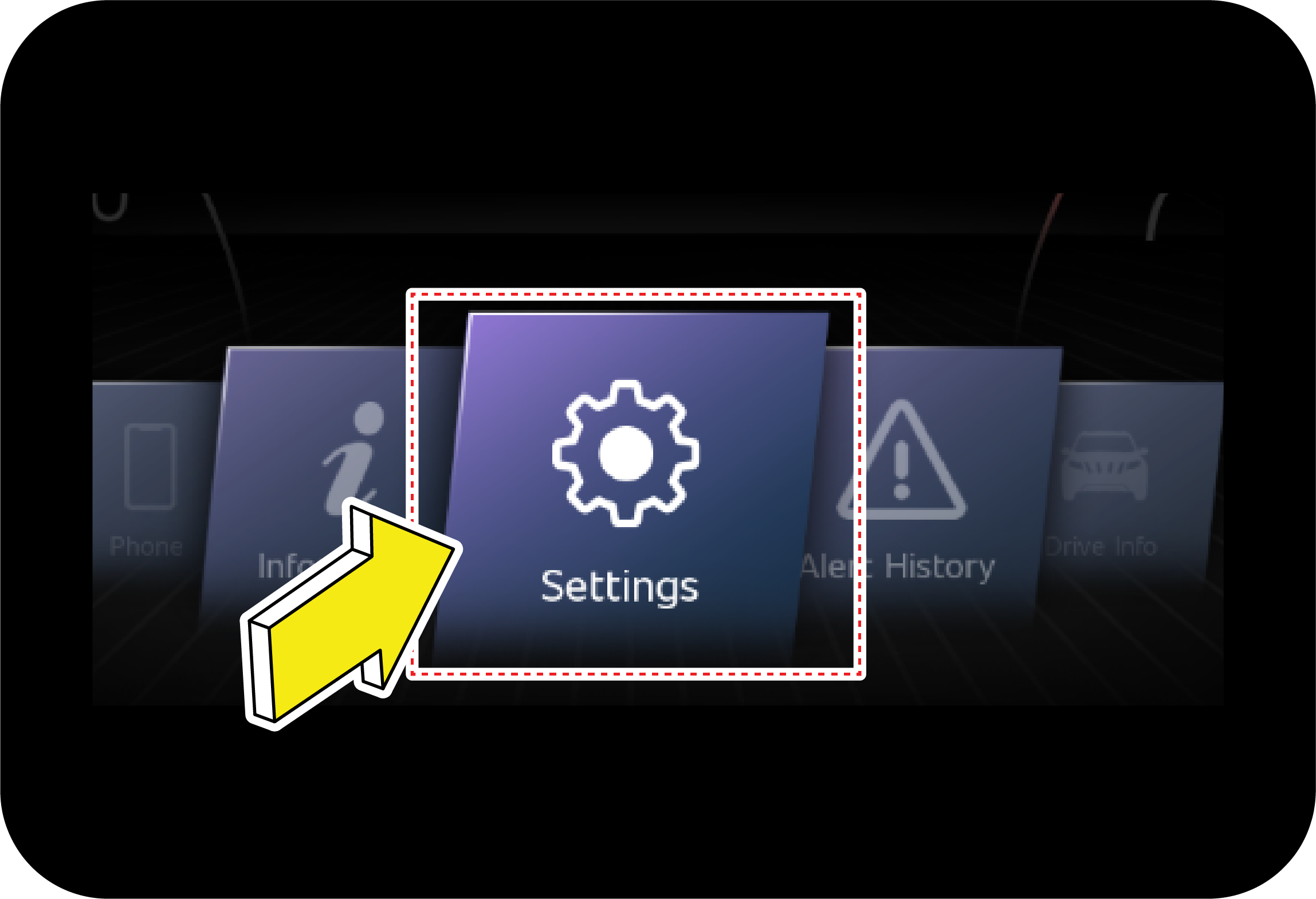
|
1. Navigate to Setting menu using MENU button.
|
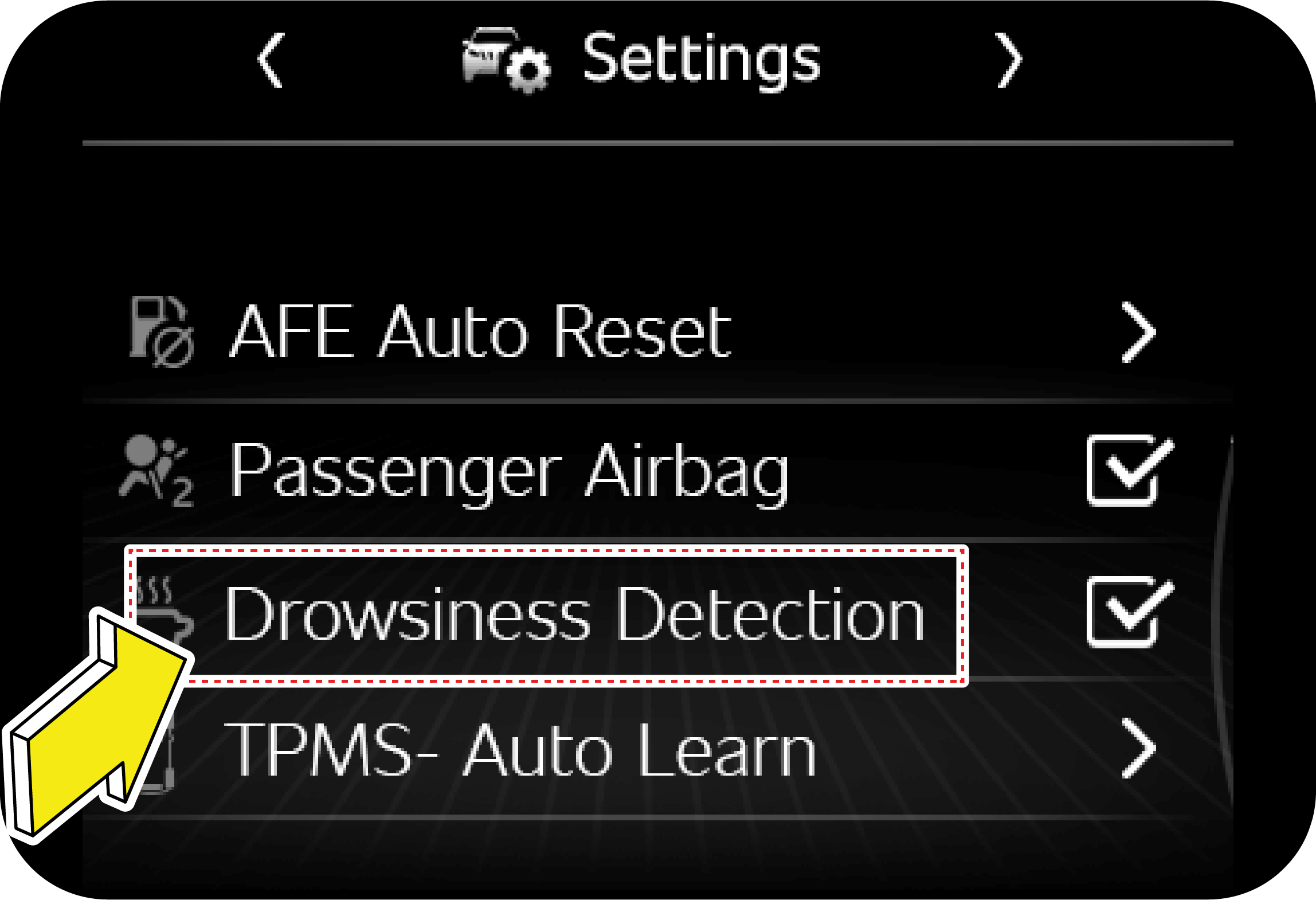
|
2. Press OK to enter setting. Press Up/Down button to navigate to
Drowsiness Detection Option
|

|
3. Press OK to Enable / Disable the Drowsiness Detection Option.
|
3.11.4 TPMS-Auto Learn (if equipped)
|
|
1. Navigate to Setting menu using MENU button.
|
|
|
2. Press OK to enter setting. Press Up/Down button to navigate to
TPMS-Auto Learn Option
|
|
|
3. Press OK to Enable / Disable the TPMS-Auto Learn Option.
|
3.11.5 Tyre Fill Assist (if equipped)
|
|
1. Navigate to Setting menu using MENU button.
|
|
|
2. Press OK to enter setting. Press Up/Down button to navigate to
Tyre Fill Assist Option
|
|
|
3. Press OK to Enable / Disable the Tyre Fill Assist Option.
|
3.11.6 Sound (if equipped)
Turn Indicators, Notifications Sound are having options to select
different sounds and Volume level adjustment.
|
|
1. Navigate to Setting menu using MENU button.
|
|
|
2. Press OK to enter setting. Press Up/Down button to
navigate to Sound Option.
|
|
|
3. Press ok to enter Sound Option. Use Up/Down button
to navigate to the option. Press OK to enter Sound Options
|
|
|
4. Use Up/Down button to navigate to the option. Press
OK to select.
|
|
|
5. Use Up/Down button to Select the volume Level. Press
OK to enter Volume Option.
|
|
|
6. Up/Down button to select the volume levels. Press OK
to select. Once selected it will return to previous page.
|
3.11.7 Clock Type
|
|
|
1. Navigate to Setting menu using MENU button.
|
|
|
2. Press OK to enter setting. Press Up/Down button to navigate to Clock Type
Option.
|
|
|
3. Press ok to enter Clock Type option. Use Up/Down button to navigate to the
option. Press OK to select.
3.11.8 Date (if equipped)
|
|
|
|
1. Navigate to Setting menu using MENU button.
|
2. Press OK to enter setting. Press Up/Down button to navigate to
date Option.
|
|
|
|
|
3. Press ok to enter date option. Use Up/Down button to navigate to
the option. Press OK to select.
|
4. Use Up/Down button to select date format and set date. Press OK
to set.
|
3.11.9 Time (If equipped)
|
|
|
|
1. Navigate to Setting menu using MENU button.
|
2. Press OK to enter setting. Press Up/Down button to navigate to
time option.
|
|
|
|
|
3. Press ok to enter time option. Use Up/Down button to navigate to
the option. Press OK to select.
|
4. Use Up/Down button to select time format and set time. Press OK
to set.
|
3.11.10 Factory Reset
|
|
|
1. Navigate to Setting menu using MENU button.
|
|
|
2. Press OK to enter setting. Press Up/Down button to navigate to Factory Reset
Option.
|
|
|
3. Press OK to Select following screen will appear. Use Down button to select
Confirm. Press OK to start factory reset process.

| 1. | To go to the main settings screen from any settings menu, use Up/Down buttons to go to the top of the menu screen and press the OK button. |
| 2. | In the settings screen, if no option is selected for a long time. The screen will go to the previous displayed screen. |
3.12 Alert History
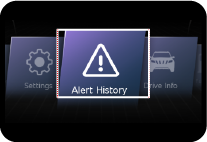
|
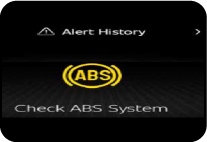
|
Alert History can be accessed by pressing MENU button in Steering
wheel/driver side
switch bank.
Use OK button to enter Alert History page
|
|
|
Alert history allows to check any active applicable vehicle warnings in the
instrument
cluster display.
Live warnings shall displayed in the cluster center display area and
warning count
will decrease if viewed in the warning
history page.
3.13 General Alerts
| Display | Operating Conditions |
|---|---|
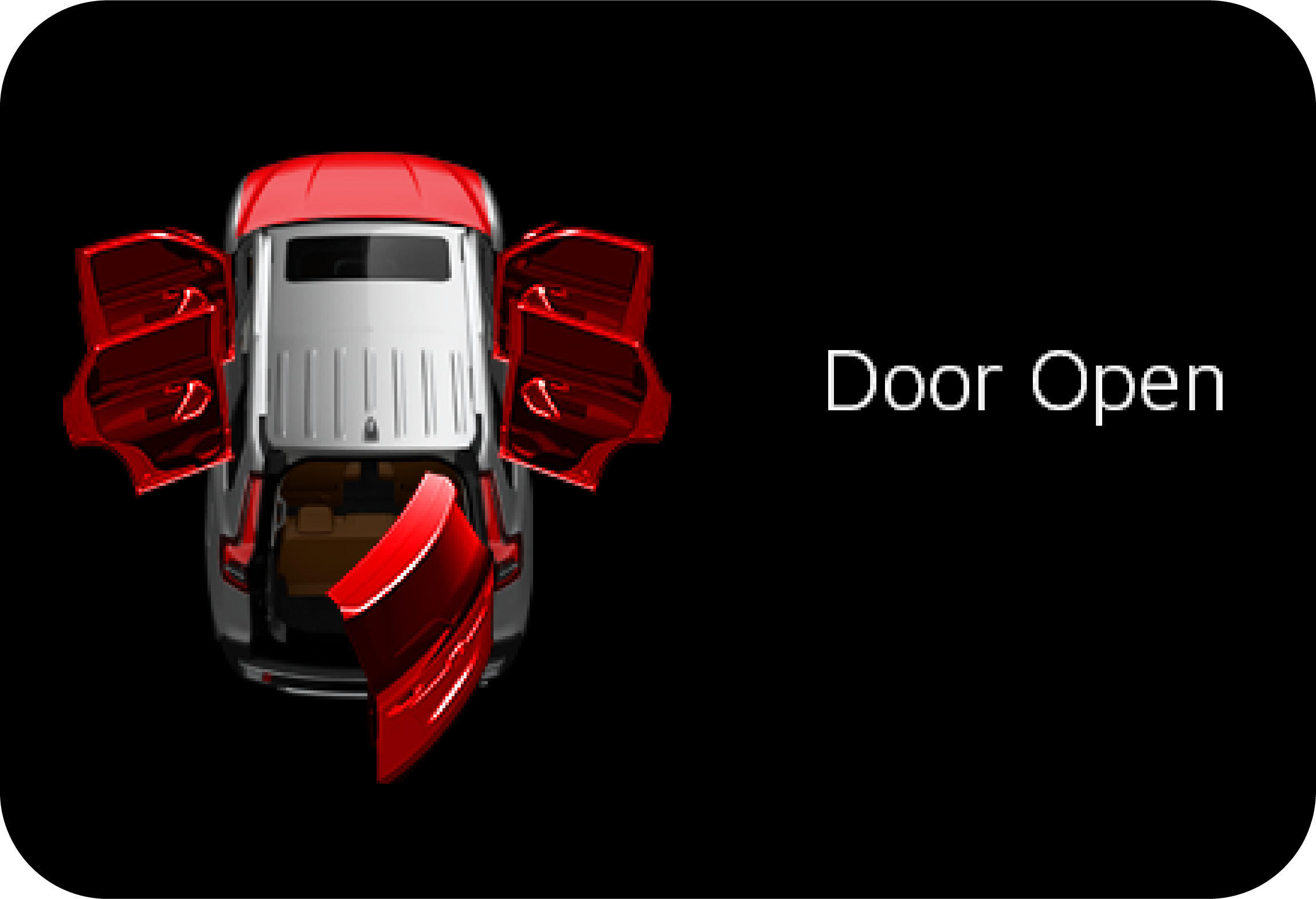 |
This alert is displayed when any doors are open and show the
door identified as open.
|
|
|
This alert is displayed when the check engine warning telltale
is ON and engine is running.
|
| Display | Operating Conditions |
|---|---|
|
|
This alert is displayed when engine temperature high telltale
is ON and engine is running.
|
|
|
This alert is displayed when an ABS related malfunction is
detected.
|
|
|
This alert is displayed when low brake fluid is detected and
engine is running.
|
|
|
This alert is displayed when the park lamp is ON and the
ignition is turned OFF.
|
|
|
This alert is displayed when low fuel warning telltale is ON
or blinking and engine is running.
|
|
|
This alert is displayed when the engine oil pressure warning
telltale is ON and engine is running.
|
|
|
This alert is displayed when either of driver or passenger (if
occupied) seatbelt is unbuckled.
|
|
|
This alert is displayed when water is detected in fuel filter
and engine is running. It is applicable for the diesel variant
only.
|
|
|
This alert is displayed when passenger airbag is turned OFF.
|
|
|
This alert is displayed when brake EBD related malfunction is
detected.
|
|
|
This alert is displayed when the ESP malfunction is detected
and engine is running.
|
|
|
This alert is displayed when EPS related malfunction is
detected
|
|
|
This alert is displayed when Sunroof is left open at ignition
off.
|
|
|
The alert is displayed when ignition is off, driver door is
open and the driver has forgotten their phone in the wireless
charging tray.
|
|
|
The alert is displayed when 4WD system related malfunctions is
detected.
|
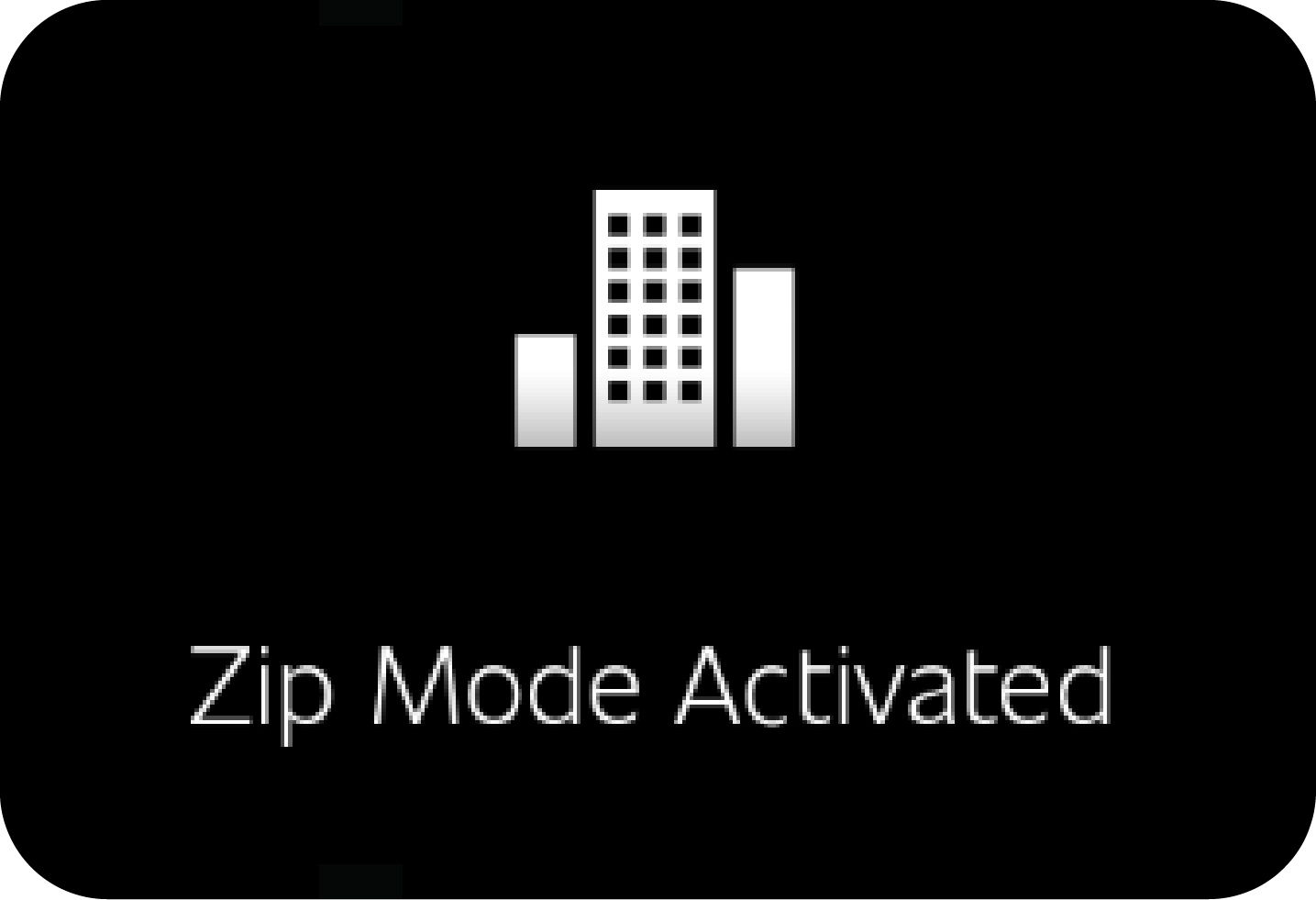 |
This alert is displayed when Zip drive mode is activated.
|
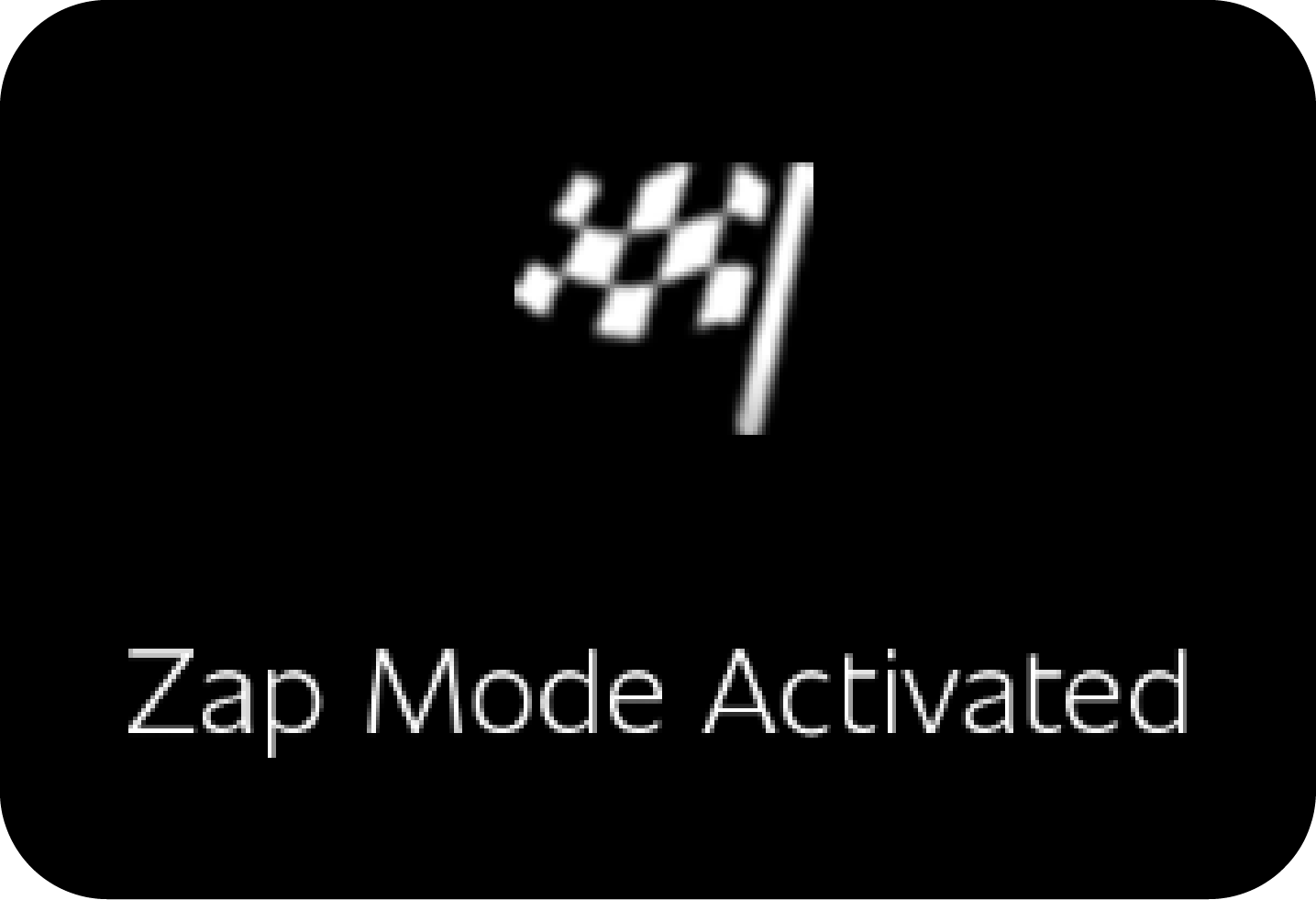 |
This alert is displayed when Zap drive mode is activated.
|
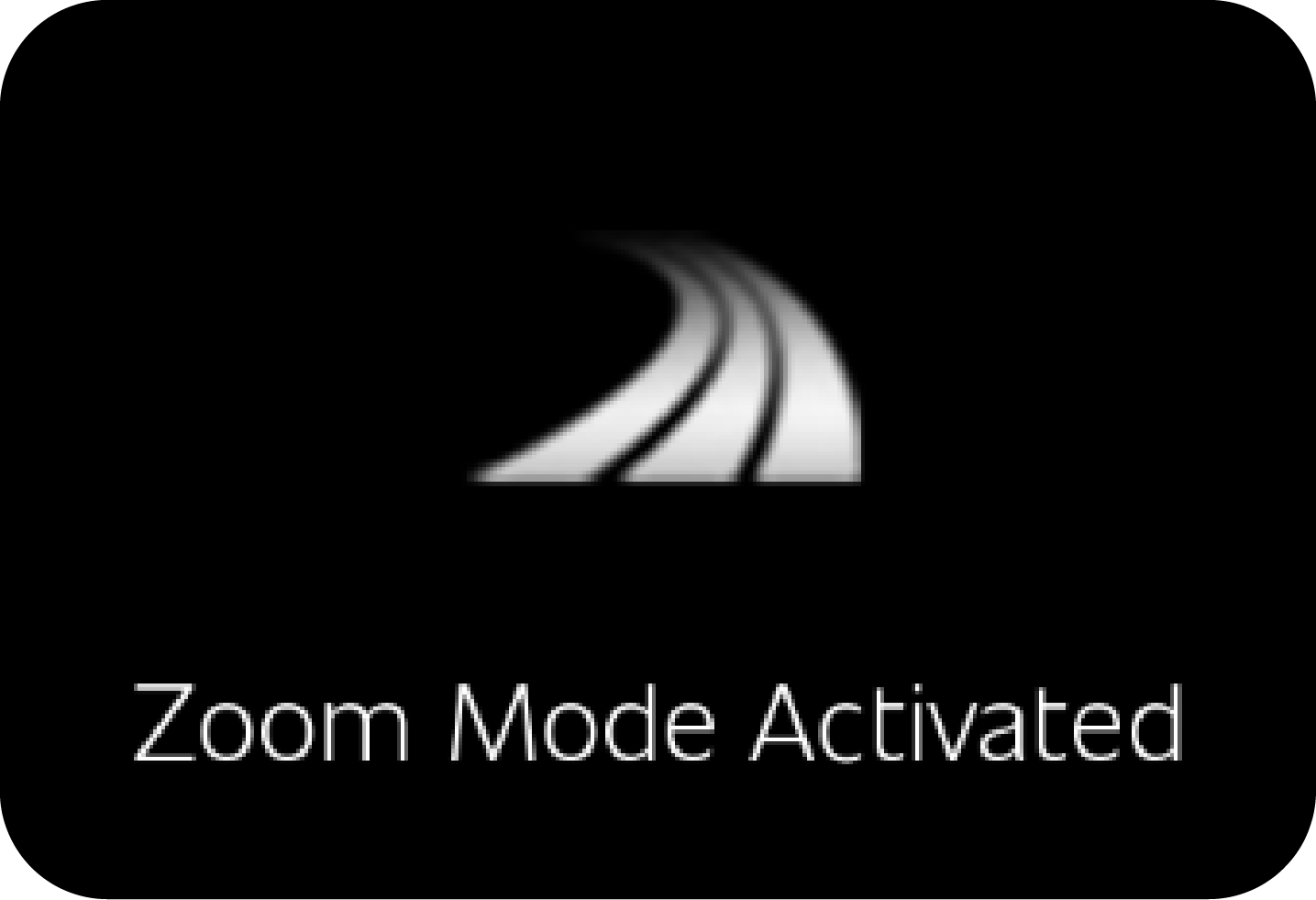 |
This alert is displayed when Zoom drive mode is activated.
|
|
|
Instrument cluster shall monitor some of the internal
parameters and if any malfunction is detected it will display the “Contact
Dealer” alert.
Contact a Mahindra Authorised Dealer immediately when “Contact
Dealer” alert is displayed in cluster.
|
|
|
The alert is displayed when the driver becomes very drowsy and
is not able to stay awake. The alert indicates the driver to
take an immediate break.
|
|
|
This alert is displayed when malfunction in Attention Assist
system is detected.
|
|
|
This alert is displayed when the Hill Descent Control function
is not available because of a malfunction in the system.
|
|
|
This alert is displayed when the Hill Hold Control function is
not available because of a malfunction in the system.
|
|
|
This alert is displayed when the vehicle is driven above 120
kmph.
|
|
|
This alert is displayed when you try to move the vehicle and
the park brake is still engaged.
|
|
|
This alert is displayed 200 Kms before the scheduled service
limit.
|
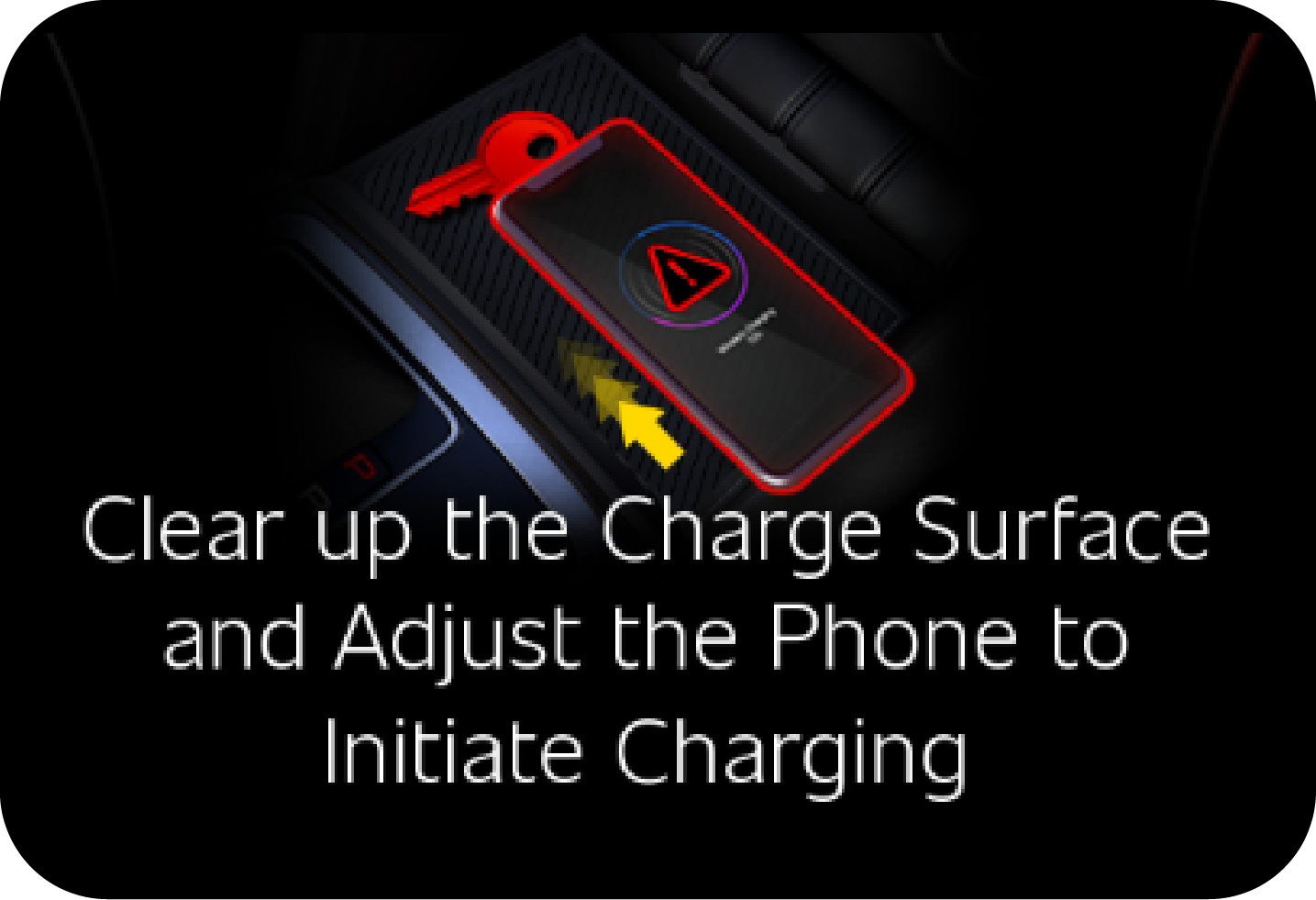 |
This alert is displayed when a coin or metallic object is
placed on the wireless charging tray & the phone is kept on the
object leading to poor charging of phone. This will also be displayed if the
phone is detected in a incorrect position on
the charging tray. Adjust the phone to allow it to charge optimally.
|
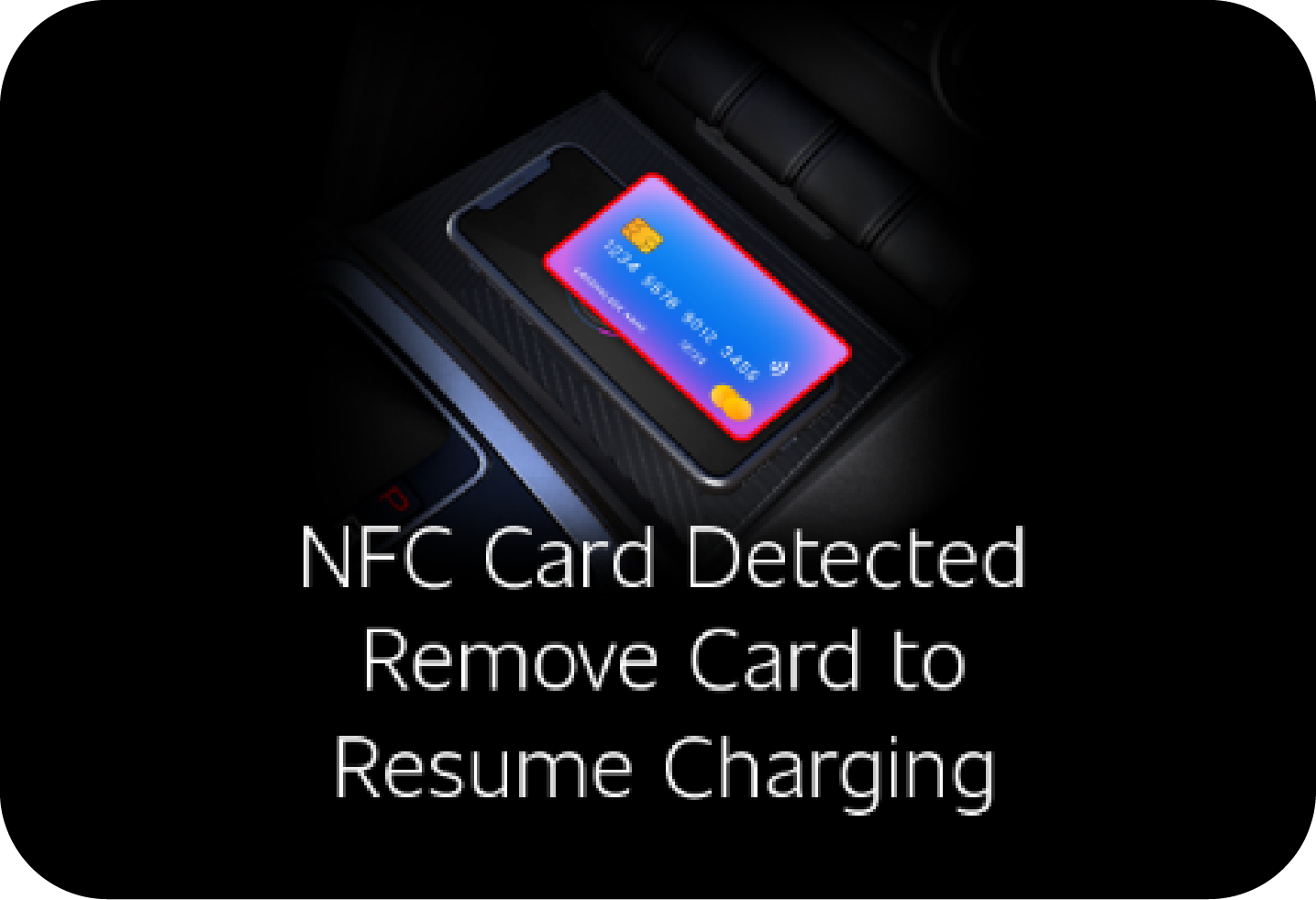 |
This alert is displayed when a NFC enabled card is placed on
the wireless charging tray & a phone is placed on top of. Kindly
remove the card to protect the card.
|
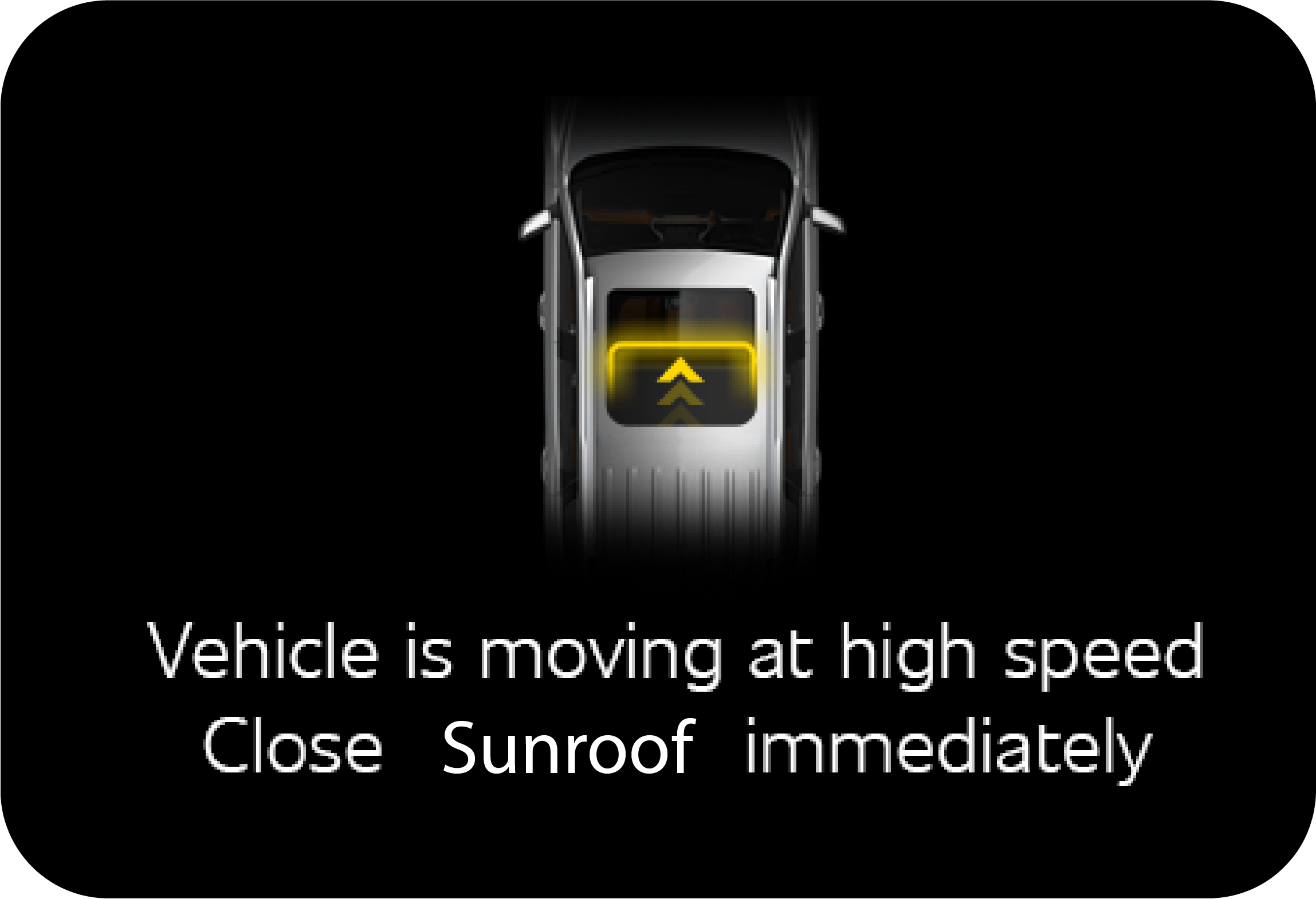 |
This alert is displayed when the Skyroof is open and vehicle
speed in high.
|
|
|
This alert is displayed when the Sunroof is not learnt.
|
 |
Rain Sensor/Non Rain Sensor
Variant: This alert will displayed when low wipe is ON for more than 10
seconds or high wipe is ON for more than 5 seconds in both
RLS & Non RLS variants.
|
3.14 Partial Alerts
|
Display
|
Operating Conditions
|
|---|---|
|
|
This message comes when auto light is turned OFF.
|
|
|
This message comes when auto light is turned ON.
|
|
|
This message comes when auto wiper is turned OFF.
|
|
|
This message comes when auto wiper is turned ON.
|
|
|
This message comes when cruise mode is turned ON.
|
|
|
This message comes when cruise mode is turned OFF.
|
|
|
This message comes when brake pedal is pressed when in cruise
mode or if trying to activate cruise control when vehicle speed
is below the cruise threshold.
|
|
|
This message comes on when HDC function is enabled by pressing
the HDC switch and the conditions for HDC are met . The brakes
will then maintain the vehicle speed while descending the Hill
|
|
|
This message comes on when the Hill Descent Control is
disabled manually by pressing the HDC Switch.
|
|
|
This message comes on when the Hill Descent Control is enabled
manually by pressing the HDC Switch and is ready to control,
but the conditions for HDC are not met yet.
|
3.15 Tyre Direction Monitoring System (TDMS) (if
equipped)
Tyre direction monitoring system or TDMS assists you when vehicle has just started and
you are about to move the vehicle.
It tells you about the current direction in which tyres are aligned at very beginning of manoeuvring the
vehicle. TDMS works
only when vehicle speed is zero and parking brake engaged or when vehicle speed is zero and vehicle is in
neutral and clutch
is not engaged
|
<Level 5>
|
|
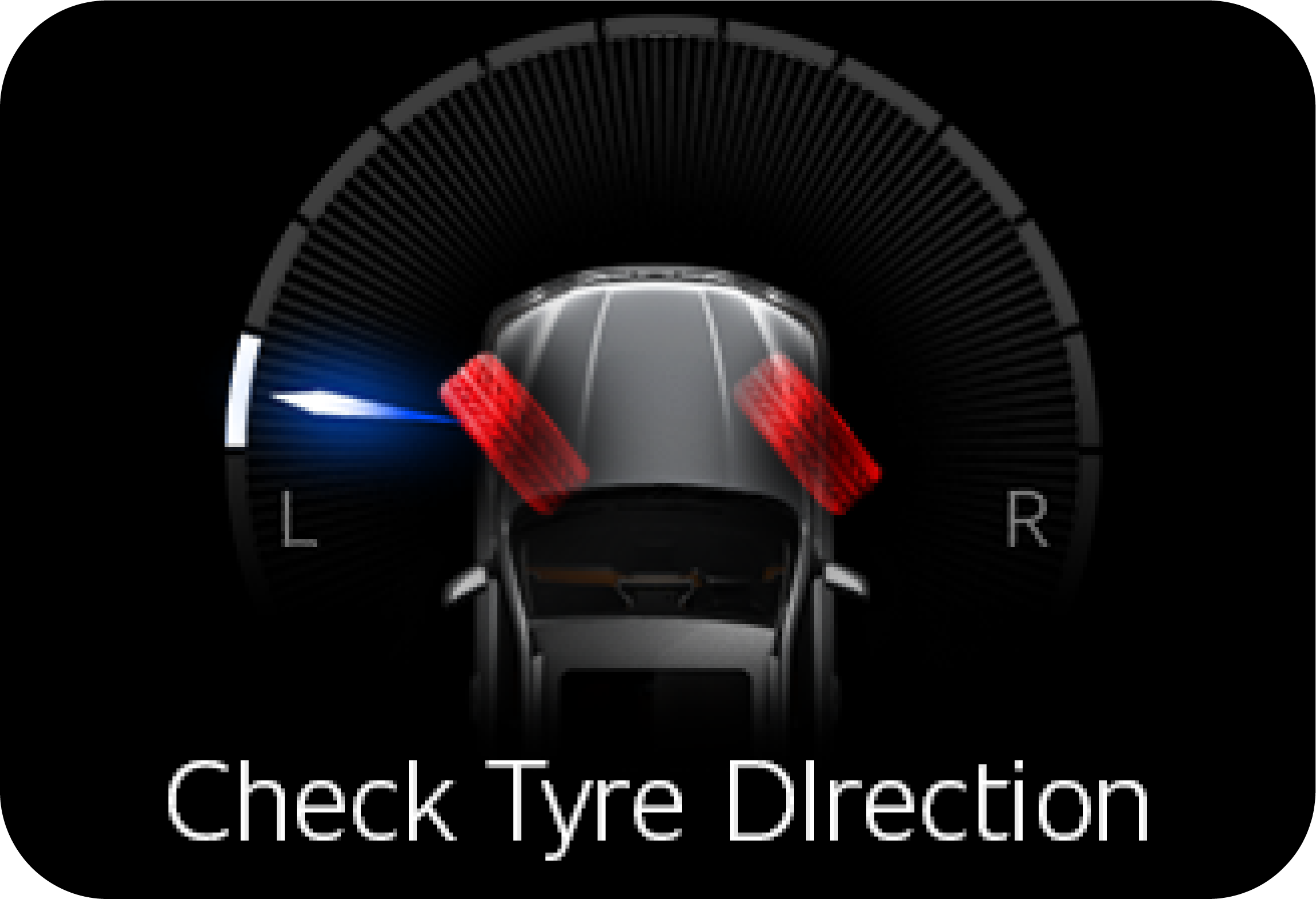
|
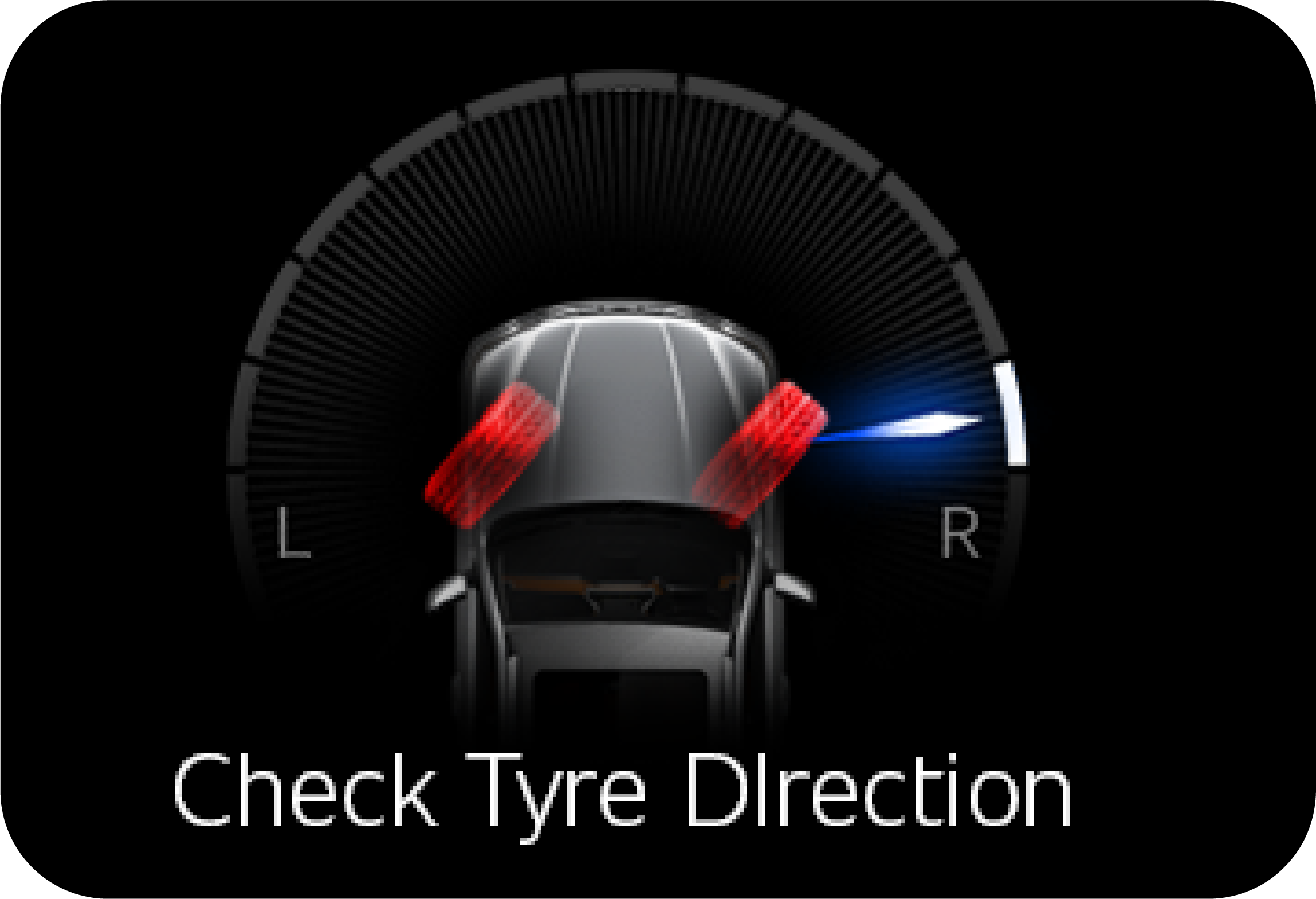
|
|
<Level 3>
|
|
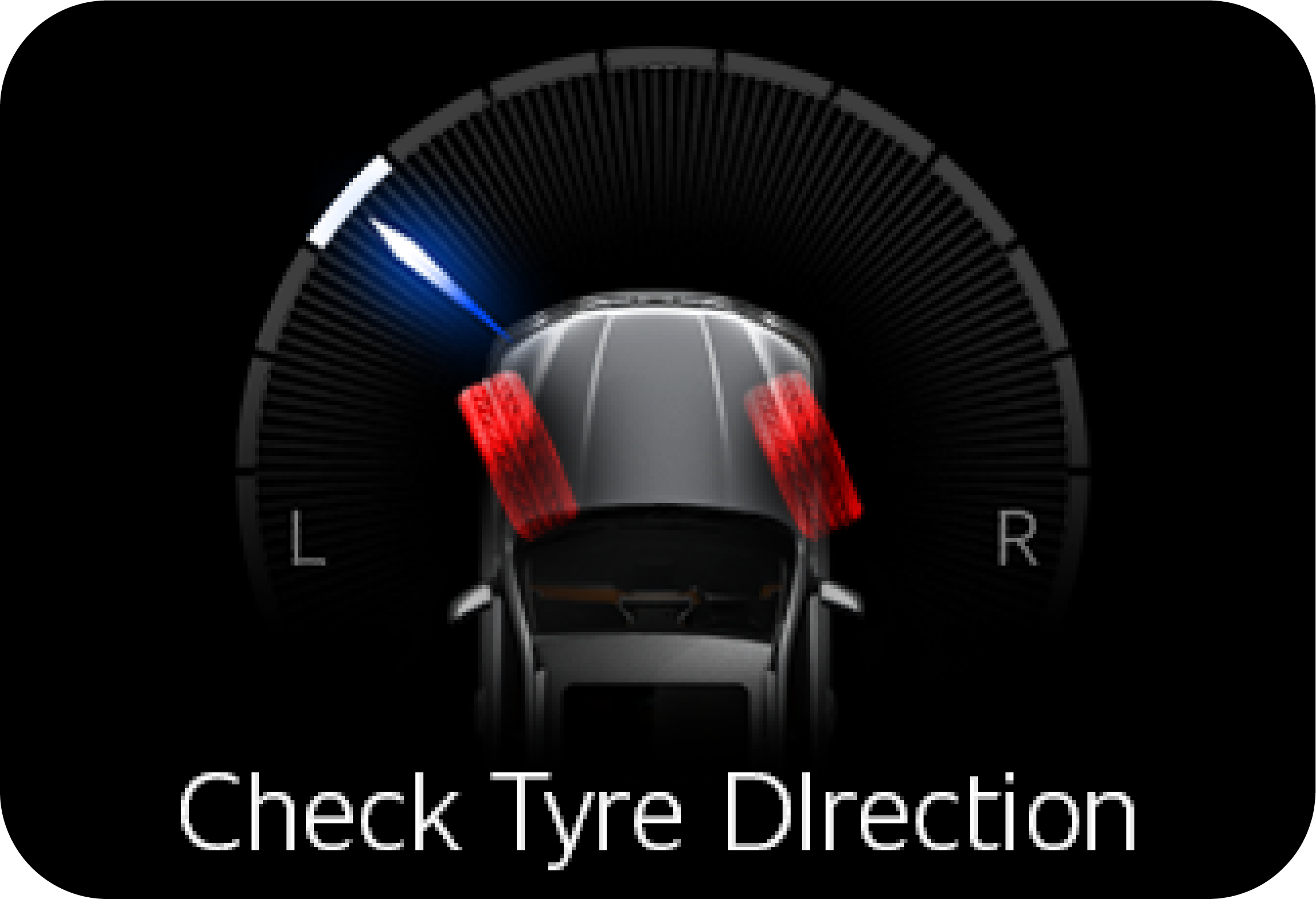
|
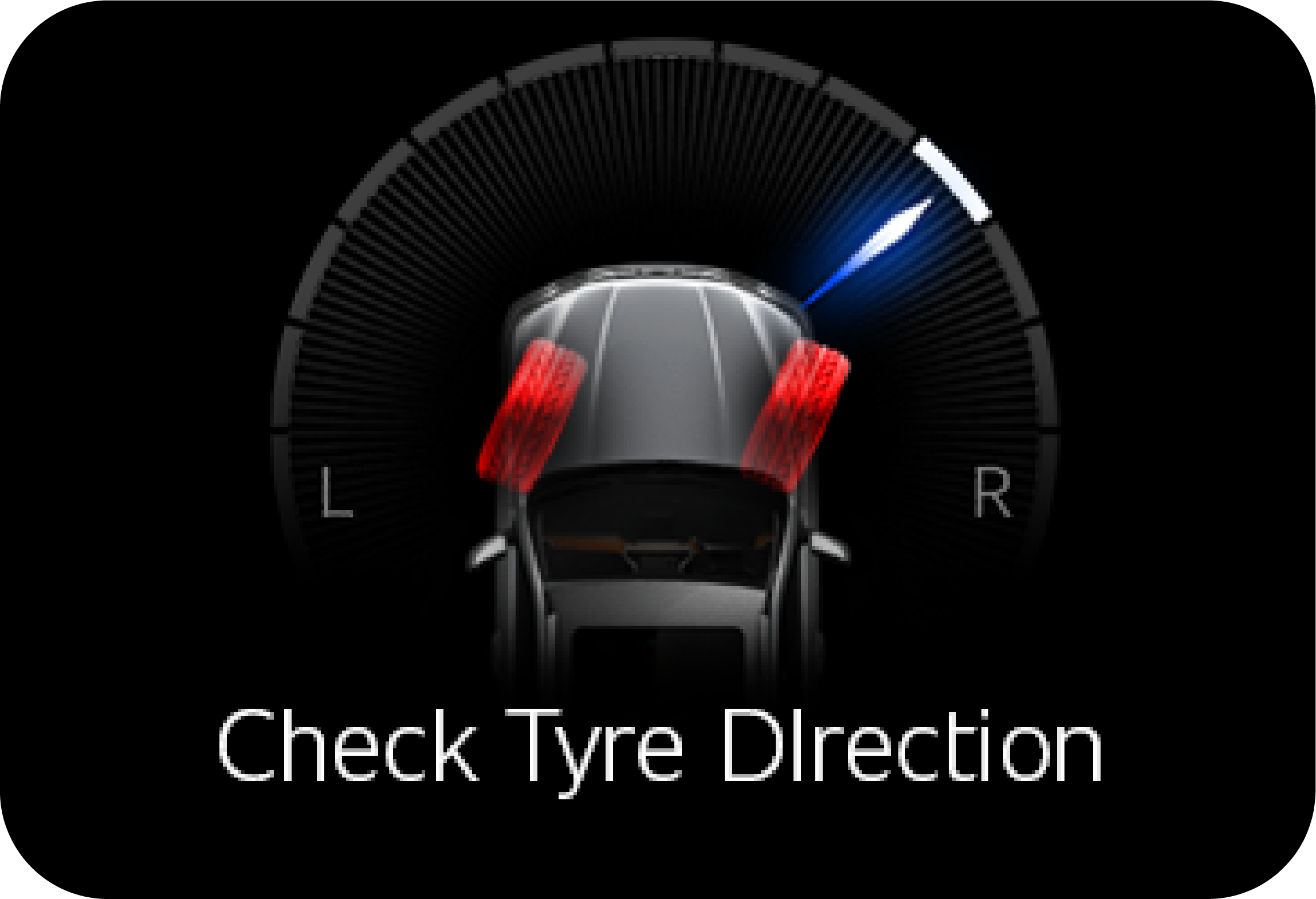
|
|
<Level 0>
|
|
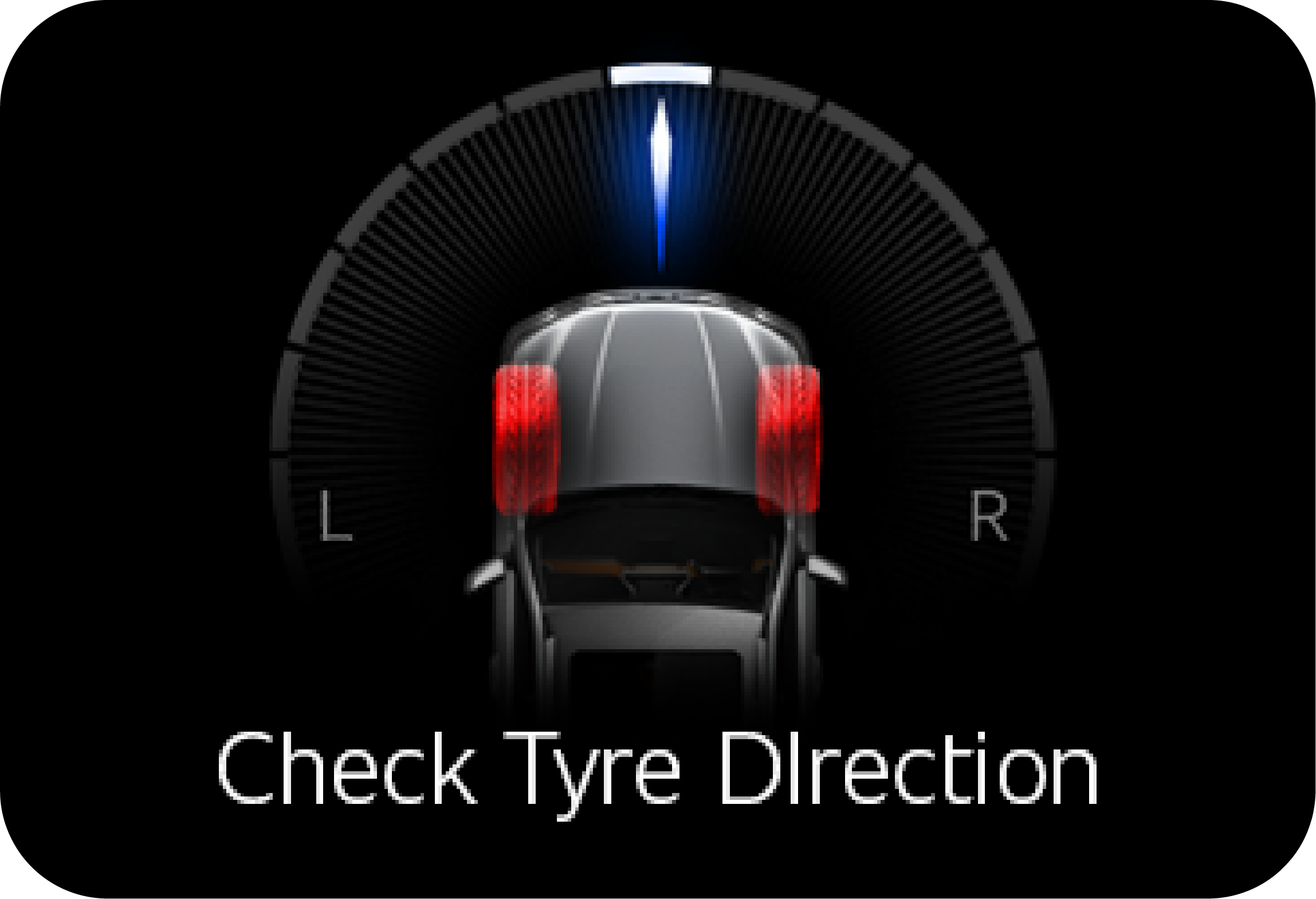
|
|
Operating Conditions
Tyre alignment is displayed in 6 levels (level 0 to level 5) depending on
the
alignment degree when the ignition switch is
turned to "ON" position from "OFF" position
Working conditions:
1. When vehicle speed is zero and parking brake engaged.
2. When vehicle speed is zero and vehicle is in neutral and clutch is not
engaged.
3.16 Favorite Function
Favorite button short press, Cluster will display the screen which was
already saved
as favorite.
User can set as favorite any one of the menu screen (Vehicle info, Fuel info, Digital
speed, Drive info, Navigation, Driver
Assistance, Audio, Display Layout & Setting Level 1) except settings (Level 2,3,4) REGEN function
& Warning history.
|
Favorite Feature
|
|
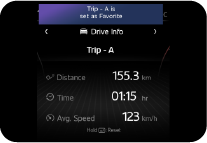
|
|
|
Non–Favorite Feature
|
|
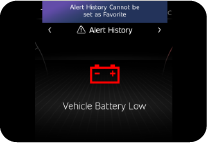
|
|
Each time user make a screen as favorite by pressing Favorite button long press during
the previously added favorite screen
will be replaced by the current screen.
3.17 Warning / Tell-tale Lamps in the Instrument
Cluster
|
High
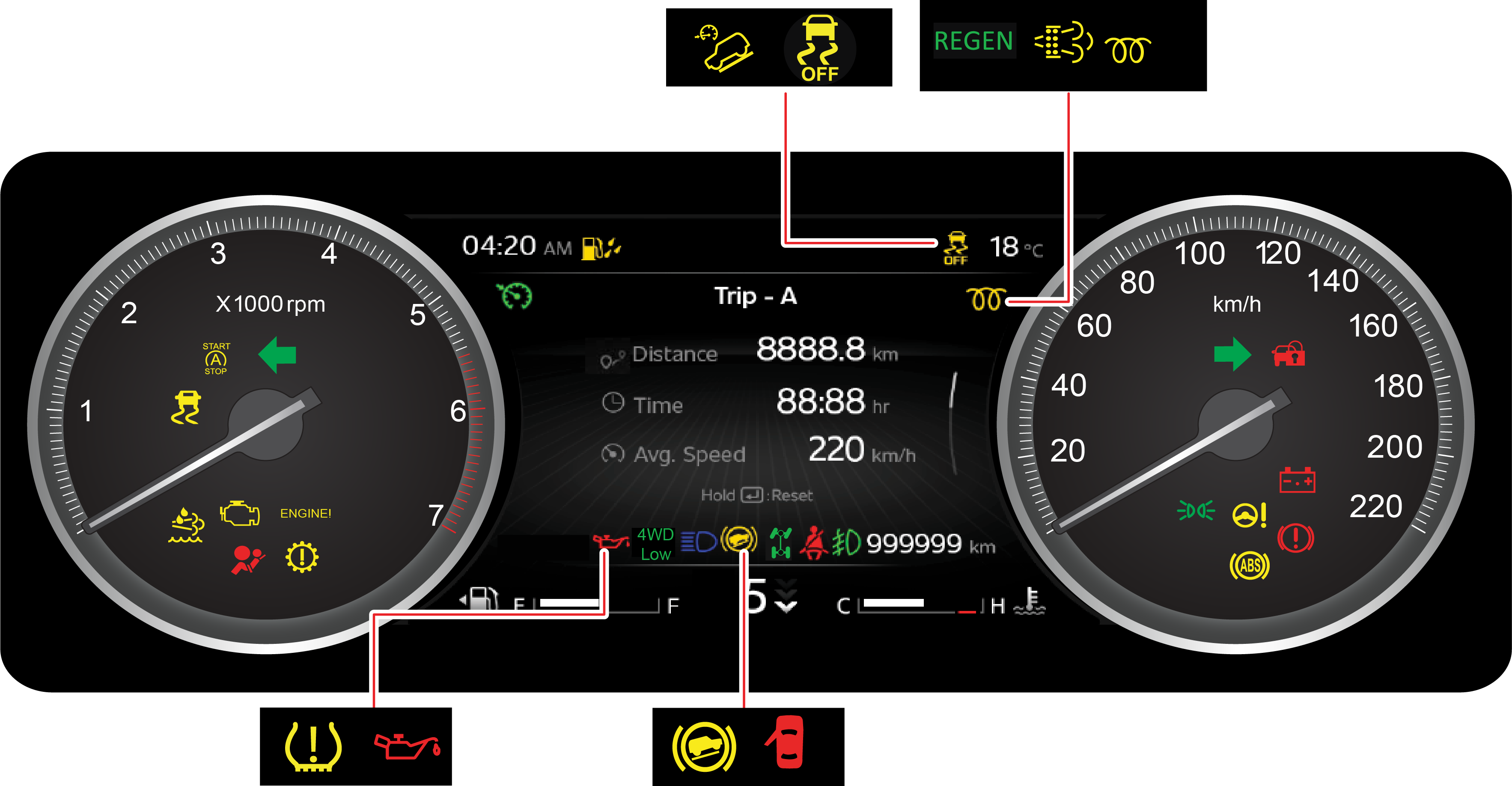
|

Few Tell Tales grouped in to same slot and this will be cyclic based on tell tale
status.
|
Low
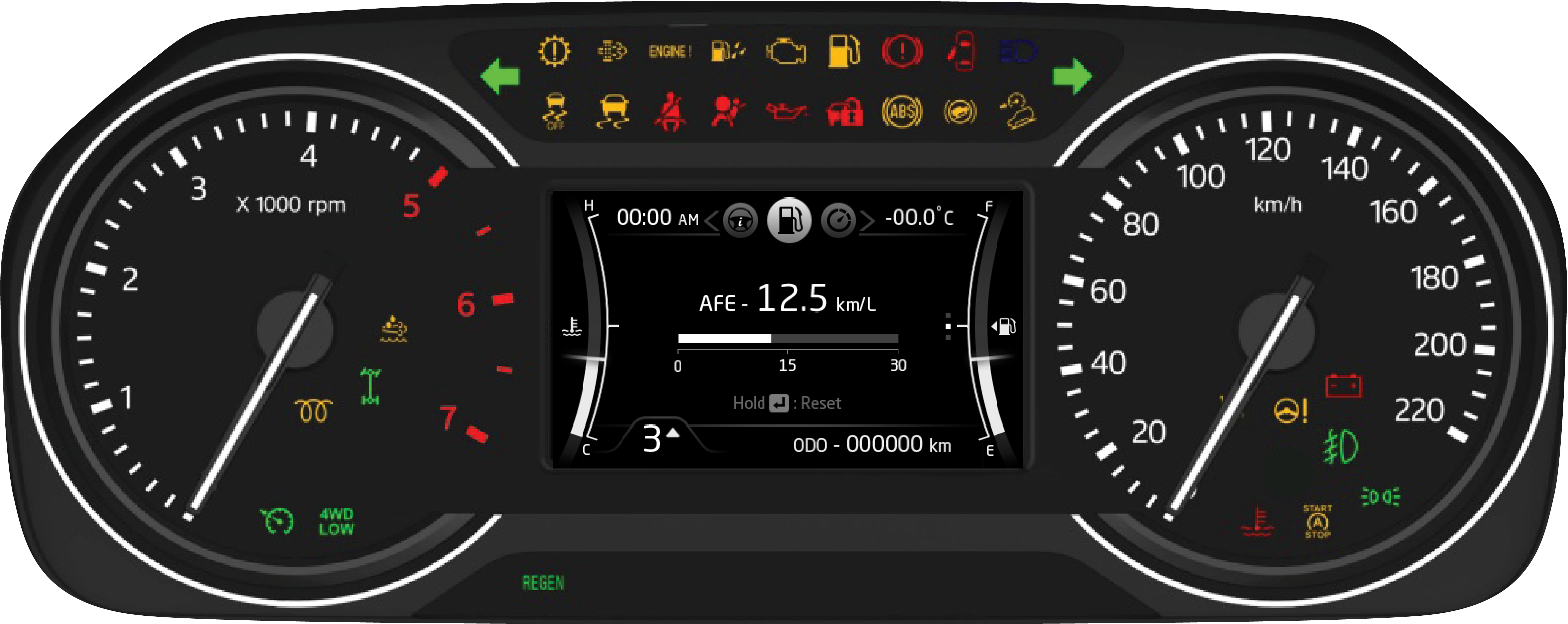 |
|
Sr. No.
|
Symbol
|
Warning Lamp/Telltale
|
Lamp Pre-check
|
Lamp Status while Engine running
|
Action/Remarks
|
|---|---|---|---|---|---|
|
1
|
|
Left Turn Indicator
|
No
|
Slow or Fast Blinking
|
Indicates left turn
lamp is blinking
Slow Blinking: Normal operation Fast Blinking: One / more left turn lamp bulb has fused. Have the bulb replaced |
|
2
|
|
Right Turn Indicator
|
No
|
Slow or Fast Blinking
|
Indicates right
turn lamp is blinking
Slow Blinking: Normal operation Fast Blinking: One /more right turn lamp bulb has fused. Have the bulb replaced |
|
3
|
|
Cruise Control telltale*
|
No
|
Continuously ON
|
Indicates vehicle
is in Cruise mode
|
|
4
|
|
Water-in-Fuel Warning telltale*
|
No
|
Continuously ON
|
Indicates
water-in-fuel. Drain the water from filter or contact an Mahindra
Authorised Dealer for assistance
|
|
5
|
|
Immobiliser lamp
|
No
|
Continuously ON / Blinking
|
SLOW BLINKING:
Vehicle is armed with the remote
FAST BLINKING/CONTINUOUSLY ON: Indicates a system malfunction Contact an Mahindra Authorised Dealer immediately |
|
6
|
|
ABS Warning telltale
|
Yes
|
Continuously ON
|
Indicates
malfunction of the ABS system. Contact a Mahindra Authorised Dealer
immediately
|
|
7
|
|
Park Brake / EBD / Low Brake Fluid Telltale
|
Yes
|
Continuously ON
|
Either one of the
below conditions:
1. Park Brake might be engaged 2. Brake fluid level might be low 3. There is a malfunction in brake EBD. |
|
8
|
|
Parking Lamp telltale
|
No
|
Continuously ON
|
Indicates Park Lamp
is ON
|
|
9
|
|
Airbag Warning telltale
|
Yes
|
Continuously ON
|
Indicates
malfunction of the airbag system. Contact a Mahindra Authorised Dealer
immediately
|
|
10
|
|
HHC Malfunction*
|
No
|
Continuously ON
|
Indicates
malfunction of Hill Hold Control. Contact a Mahindra Authorised Dealer
immediately
|
|
11
|
|
Door Ajar Warning telltale
|
No
|
Continuously ON
|
Indicates any
doors, boot or hood are open
|
|
12
|
|
Low Fuel Warning telltale
|
No
|
Continuously ON/Blinking
|
Indicates fuel
level has reached the reserve level. Refuel
immediately
|
|
13
|
|
ESP OFF telltale*
|
No
|
Continuously ON
|
Indicates ESP has
been switched OFF
|
|
14
|
|
ESP Malfunction Warning telltale*
|
Yes
|
Continuously ON or Blinking
|
BLINKING: Indicates
ESP has taken control of the vehicle stability
CONTINUOUSLY ON: Indicates a malfunction in the ESP system. Contact a Mahindra Authorised Dealer immediately |
|
15
|
|
Front Fog Lamp telltale*
|
No
|
Continuously Lamp ON
|
Indicates front fog
lamp is ON
|
|
16
|
|
Tiretronics telltale*
|
No
|
Continuously ON or Blinking
|
Indicates low/high
tyre pressure or possible malfunction in Tiretronics. Refer to
Tiretronics section in INSTRUMENT CLUSTER
FEATURES/WHEELS AND TYRES chapter for further
details
|
|
17
|
|
Seat Belt Warning telltale
|
No
|
Continuously ON
|
If telltale is not
turning OFF even after fastening the seat belt, contact an Mahindra
Authorised Dealer for assistance
|
|
18
|
|
SCR/DEF malfunction telltale*
|
No
|
Continuously ON
|
It indicates that
either DEF Level is low or incorrect DEF has been filled or DEF Dosing
is malfunctioning. Follow the instructions
mentioned in the ‘EMISSION CONTROL SYSTEM”
|
|
19
|
|
DPF telltale*
|
No
|
ON/Blink
|
If the DPF
indicator is ON in the engine running condition then DPF regeneration
has not happened. Follow the instructions
mentioned in the “EMISSION CONTROL SYSTEM”
|
|
20
|
|
Glow Plug telltale*
|
No.
|
Continuously ON
|
Indicates glow
plugs are active.
|
|
21
|
|
Head Lamp High Beam
|
No
|
Continuously ON
|
Indicates Head lamp
high beam is ON
|
|
22
|
|
OBD telltale
|
Yes
|
Continuously ON or Blinking
|
Telltale will be ON
till engine starts. After engine starts, if is still ON there is a
potential malfunction related to emission
system, contact an Mahindra Authorised Dealer
immediately
|
|
23
|
|
EPS Warning telltale*
|
Yes
|
Continuously ON
|
Indicates
malfunction on Electronic Power steering system. Contact a Mahindra
Authorised Dealer immediately
|
|
24
|
|
Low Engine Oil Pressure Warning telltale
|
No
|
Continuously ON
|
Telltale will be ON
till engine starts. In engine ON condition, it indicates engine oil
pressure is low. Check oil level and
top-up or contact an Mahindra Authorised Dealer for
assistance
|
|
25
|
|
Check Engine telltale
|
Yes
|
Continuously ON or Blinking
|
Indicates a
potential malfunction in engine electronics, contact an Mahindra
Authorised Dealer immediately
|
|
26
|
|
Battery Charging System Warning telltale
|
No
|
Continuously ON
|
Indicates that the
alternator is not charging the battery. Contact
Normal Operation:
This lamp comes ON when the ignition is switched ON and goes OFF once
the engine starts. When continuously
ON lamp indicates that the battery is not charging. Contact Mahindra
Authorised Dealer for assistance
|
|
27
|
|
High Engine Coolant Temperature Warning telltale
|
No
|
Continuously ON or Blinking
|
Engine temperature
very high. Contact Mahindra Authorised Dealer
immediately
|
|
28
|
|
REGEN telltale*
|
NO
|
ON/Blink
|
ON: Regeneration is
required
Blink: Regeneration is in progress |
|
29
|
|
AT Warning telltale*
|
No
|
Continuously ON or Blink
|
Telltale is used to
indicate an AT fault. Telltale Continuous ON means AT Fault. Contact
Mahindra Authorised Dealer immediately
if the MIL Lamp doesn’t turn off after an ignition reset.
Blinking Telltale
implies overheating of clutch due to abuse conditions. This is only to
warn the customer and to prevent
clutch damage. Telltale will turn off once the clutch temperature has
becomes normal.
|
|
30
|
|
HDC Malfunction telltale*
|
No
|
Continuously ON
|
Indicates
malfunction of Hill Decent Control. Contact a Mahindra Authorised Dealer
immediately
|
|
31
|
|
Engine Start/Stop telltale*
|
No
|
Continuously ON or Blinking
|
CONTINUOUSLY ON:
Engine is in auto stop mode Blinking: Stop/Start is about to stop the
engine FAST BLINKING: Stop/Start is inhibited due to
conditions not met.
|
|
32
|
|
4WD High*
|
No
|
Continuously ON or Blinking
|
Blinking: indicates 4 wheel
drive high engagement is in progress.
ON: 4 wheel drive high is
engaged..
|
|
33
|
|
4WD Low*
|
No
|
Continuously ON or Blinking
|
Blinking: Indicates 4 wheel
drive low engagement is in progress.
ON: 4 Wheeldrive low is engaged.
|
|
* if equipped / select models or
variants only
|
|||||
3.18 Warning Lamps in the Instrument Cluster
3.18.1 Turn Lamps
The turn lamp arrows in the instrument cluster flash showing the direction
indicated by the turn signals. A sudden increase
in the rate of flashing indicates failure of one or more of the lamp bulbs. Have them replaced as soon
as possible.
3.18.2 Cruise Indicator (if equipped)
The lamp indicates the status of the cruise mode. Lamp ON indicates the vehicle is
in cruise mode by pressing the SET+ button
on the steering wheel switch bank.
Blinking indicates that the accelerator pedal is pressed when in cruise
mode
allowing for an overtake.
When CRUISE OFF button in the steering wheel switch bank is pressed, cruise mode is
deactivated and the lamp goes OFF indicating
that the vehicle is not in cruise mode.
If the lamp does not illuminate when the vehicle is in cruise mode or does not go
OFF when the vehicle is out of cruise mode,
there is a possible malfunction in the lamp or the cruise control system. Have the vehicle checked by
a Mahindra Authorised
Dealer.
3.18.3 Water-in-Fuel Warning Lamp (if equipped)
The water-in-fuel warning lamp illuminates when the accumulation of water in the
fuel filter reaches the maximum permissible
limit. The fuel filter needs to be drained. Contact a Mahindra Authorised Dealer.

Do not continue driving the vehicle with the
Water-in-Fuel Warning Lamp ON. This may result in fuel pump / other fuel system
component damage, which will not be covered by the warranty.
3.18.4 Immobiliser
Immobiliser Lamp flashes intermittently (few secs. frequency) once the ignition is
switched OFF and the vehicle security system
is armed (when locked using the RKE).
Fast blinking indicates a malfunction in the engine immobiliser system.
Contact a
Mahindra Authorised Dealer immediately.
3.18.5 Anti-Lock Brake System (ABS) Malfunction
Lamp
If the ABS malfunction lamp is ON when driving ABS will not operate. But the brake
system will still operate conventionally.
In this condition, the wheels can lock during severe braking. Have the vehicle checked by an Mahindra
Authorised Dealer as
soon as possible.
However, if ABS malfunction lamp and brake warning lamp are simultaneously glowing,
there is a severe malfunction in the ABS.
Operate the vehicle with extreme care and have the vehicle checked as soon as possible at an Mahindra
Authorised Dealer.

if ABS malfunction lamp and parking brake warning lamp
are simultaneously ON, there is a severe malfunction in the ABS. Contact
a Mahindra Authorised Dealer immediately
In this case, the ABS function is not available, but the
conventional brake system is properly working
3.18.6 Parking Brake Lamp
The lamp illuminates when Parking brake is engaged or when brake fluid level is low
or there is malfunction in EBD. If the
lamp illuminates while driving, do the following:
A fault with EBD is indicated by illumination of the brake as well as
ABS warning
lamps.
| • | Check if the parking brake/ Electric parking brake is engaged. If yes, disengage it |
| • | Check if brake fluid level is low. If yes, top-up brake fluid to the required level |

Clean the top of the brake fluid
reservoir before removing the cap. Make sure no dirt, impurities or other items fall into
the reservoir. Do not leave the cap off for more than a few minutes. Any contaminants,
impurities or moisture in the brake
fluid can affect brake operation, resulting in an accident.
If the brake warning lamp comes ON
while driving, the brake system might not be working properly. The pedal might be harder
to operate or might go closer to the floor and it can take longer to stop. Pull off the
road carefully and stop the vehicle.
Have the vehicle towed to the nearest Mahindra Authorised Dealer for checks or
repairs.
Driving the vehicle with the brake
warning lamp ON or when you suspect brake trouble is very dangerous and could result in
serious injuries. Have your vehicle towed to an Mahindra Authorised
Dealer.
When the EBD system is not
functioning the vehicle could be unstable during the hard braking. Therefore you must pay
attention
to the driving conditions while this warning light.
3.18.7 Park Lamp
The Park lamp indicator illuminates whenever park lamp is switched ON through
Combination switch. When ignition is switched
OFF and if park lamp is ON with driver door open, and alert will be audible.
3.18.8 Airbag Warning Lamp
If the lamp remains ON continuously or flash intermittently, contact an Mahindra
Authorised Dealer immediately.
Following conditions indicate airbag malfunction:
| • | Lamp fails to go OFF after engine is started |
| • | Lamp does not illuminate at all |
| • | Illuminates while driving |
Contact a Mahindra Authorised Dealer immediately when the airbag warning lamp
indicates a system malfunction. The airbag may
not deploy when needed, which could result in serious or fatal injury, or it might deploy unexpectedly
or unnecessarily, which
may result in personal injury.
3.18.9 HHC malfunction (if equipped)
HHC Malfunction Lamp comes on when the ignition switch is turned ON and then goes
off after about 4 seconds. if there is any
malfunction in hill hold control system of the vehicle.

There are chances of vehicle rolling
down when starting on a hill. No assistance will be available from ESP
system.
If the warning lamp is turned on,
have the vehicle checked and serviced at a Mahindra Dealer or Authorised Mahindra Service
Centre
3.18.10 Door Ajar Warning Lamp
The door ajar warning lamp illuminates when any of the doors including the hood and
back door are open during ignition ON.
The buzzer chimes when the vehicle speed more than 2 kmph. The lamp and chime goes OFF when all the
doors are closed properly.
3.18.11 Low Fuel Warning Lamp
When the fuel level in the fuel tank falls below the reserve limit, the low fuel
warning lamp is illuminated. Refuel sufficiently
and the lamp goes out. If the lamp continues to remain ON even after refuelling, contact an Mahindra
Authorised Dealer.
3.18.12 ESP OFF Lamp (if equipped)
The ESP OFF lamp illuminates when the ESP has been switched OFF manually.
This lamp comes on when the ignition switch is turned ON and then goes off after
about 4 seconds. Pressing and holding the
ESP OFF switch (for more than 3 seconds) turns on the indicator lamp indicating that the ESP function
is deactivated.
3.18.13 ESP System Warning Lamp (if equipped)
While driving, if the ESC system warning lamp blinks, it indicates that ESP has
taken control of the vehicle stability. If
the lamp remains ON, it indicates the malfunction in the ESP System. Contact the nearest Mahindra
Authorised Dealer.

If the warning lamp is turned on, have the vehicle
checked and serviced at a Mahindra Dealer or Authorised Mahindra Service
Centre
3.18.14 Front Fog Lamp (if equipped)
The front fog lamp telltale indicates the status of the front fog lamp. The front
fog lamp can be switched ON only when the
parking lamp is ON.

Fog lamp will turn ON, if fitted in the vehicle.
3.18.15 Engine Stop/Start Lamp (If equipped)
The Engine Stop/Start lamp flashes when the vehicle/engine is about to stop through
the Engine Stop/ Start System. The lamp
illuminates continuously when the vehicle/engine has been switched OFF by the Engine Stop/Start
System. On restarting the
vehicle / engine again by using the clutch/key, the lamp goes out.
3.18.16 Tiretronics (if equipped)
SYSTEM MALFUNCTION : Tiretronics lamp Blink for approx. 90 sec &
then Continuous ON.
SYSTEM WARNINGS: Tiretronics lamp Continuous ON.

SYSTEM MALFUNCTION: System fail to function normally due to system
failure/Sensor failure.
SYSTEM WARNING: indicated Low/High Tyre pressure, High Temperature, Air Leakage.
3.18.17 Seat Belt Warning Lamp
The seat belt warning lamp illuminates and the buzzer chimes reminding the driver
to fasten the seat belt when the ignition
is ON and vehicle running condition. The lamp will continue to illuminate till the driver fastens the
seat belt properly.
3.18.18 DPF Indicator Lamp (If equipped)
If the DPF indicator is ON in the engine running condition then DPF regeneration
has not happened. Follow the instructions
mentioned in the “EMISSION CONTROL SYSTEM”.
3.18.19 DEF Indicator Lamp (If equipped)
If the DEF indicator is ON in the engine running condition then DEF Level is low or
incorrect DEF has been filled or DEF Dosing
is malfunctioning. Follow the instructions mentioned in the ‘EMISSION CONTROL SYSTEM’.
3.18.20 Glow Plug Indicator (If equipped)
Glow plug indicator illuminates when the ignition is turned ON and Glow plug is
activated. It automatically goes OFF when
the glow plug reaches the required temperature. Contact a Mahindra Authorised Dealer, if it
illuminates while driving.
3.18.21 Head Lamp High Beam
The head lamp high beam telltale illuminates whenever the head lamps are switched
ON to high beam or when the head lamp flash
is used.
3.18.22 OBD Check Lamp
The OBD check lamp illuminates when the ignition is switched ON and
remains ON till
the engine is started indicating normal
status. If the lamp remains ON, it indicates a potential malfunction.
There may be a malfunction in:
| • | The fuel management system |
| • | The emission control system |
| • | Systems which affect emissions |
Such malfunctions may result in excessive emissions. Contact a Mahindra
Authorised
Dealer immediately.
3.18.23 EPS Warning Lamp (if equipped)
The lamp Indicates malfunction on Electric Power steering system. Contact a
Mahindra Authorised Dealer immediately.

When EPS is failed. vehicle can still be driven with
increase in steering effort.
3.18.24 Low Engine Oil Pressure Warning Lamp
The low engine oil pressure warning lamp illuminates when the ignition is switched
ON and goes OFF when the engine is started.
If the lamp remains ON even after starting the engine, or illuminates while driving, stop immediately,
check the oil level
after 2-3 minutes. If low, add engine oil to the “MAX” level and check status. If problem persists,
contact an Mahindra Authorised
Dealer immediately.

Operating the vehicle with the low oil pressure warning
lamp ON could cause sudden unexpected engine failure and loss of vehicle
control, resulting in an accident and/or serious personal injury.

Do not run the engine with low oil pressure warning
indicator ON. This may result in engine damage, which will not be covered
by the limited warranty.
3.18.25 Check Engine Lamp
Indicating normal status. The lamp blinks or illuminates continuously if there is a
fault in the engine management system.
Switch OFF the engine immediately. Contact the nearest Mahindra Authorised Dealer for necessary
repairs.
3.18.26 Battery Charging System Warning Lamp
The battery charging system warning lamp illuminates when the battery is not being
charged or when there is a malfunction
in the alternator.
This lamp illuminates when the ignition is switched ON and goes out as soon as the
engine is started. If the lamp continues
to remain ON even after starting the engine, it is an indication that the battery is not being charged
or there is a malfunction
in the alternator. Check the alternator drive belt for looseness/breakage. If the drive belt is okay,
switch OFF all unnecessary
electrical equipment and recheck. Contact a Mahindra Authorised Dealer for further assistance.
3.18.27 High Engine Coolant Temperature Warning
Lamp
The high engine coolant temperature warning lamp flashes when the coolant
temperature is above 113ºC . It starts to flash
when the temperature reaches 113ºC and will be continuously ON with buzzer alert when the temperature
reaches 115ºC.
The bars in the temperature gauge also flash in the same frequency as the high
temperature warning lamp when the above set
temperature thresholds are reached.

Do not continue driving the vehicle with an
overheated
engine. This may result in engine damage, which will not be covered
by the limited warranty.
3.18.28 Regen Indicator Lamp (If equipped)
if it is continuously ON, It indicates the DPF Manual Regeneration is required. It
will blink when Manual regeneration is
in progress. Follow the instructions mentioned in the ‘EMISSION CONTROL SYSTEM’.
3.18.29 AT Warning Lamp (If equipped)
| • | This warning lamp comes on when the ignition switch is turned on and it goes off when the engine is started. |
| • | If the lamp stays ON or comes ON while driving, some of the Transmission control components including sensors and devices may be malfunctioning. |
| • | If the Indicator lamp is blinking continuously, reduce the vehicle speed until the lamp stops blinking. Contact the Mahindra dealer as soon as possible. |
3.18.30 HDC Malfunction (if equipped)
The lamp comes on when the ignition switch is turned ON and goes off after about 4
seconds. Hill Descent Control or HDC malfunction
warning lamp indicates malfunction in HDC system. Contact nearest Mahindra Authorised Dealer.

If the warning lamp is turned on, have the vehicle
checked and serviced at a Mahindra Dealer or Authorised Mahindra Service
Centre
4 EMISSION CONTROL SYSTEM
Your Vehicle is equipped with an emission control system to
meet all
applicable emission regulations.
There are three emission control system which are as follows.
| 1. | Crankcase emission control system |
| 2. | Evaporative emission control system |
| 3. | Exhaust emission control system |
To ensure optimal functioning of the emission control systems, it is
recommended that you have your vehicle inspected and
maintained by an authorised Mahindra dealer.
Emission Control Systems
for Petrol
vehicles
It is a highly effective system that controls exhaust
emissions from an
engine. It is crucial for meeting emission standards
specified by law.
Your vehicle is equipped with a three-way catalytic converter
(TWC) for
meeting BS VI emission norms.
For optimal functioning of the emission control system, it is mandatory
to
get your vehicle inspected and maintained by a
Authorised Mahindra Dealer. The maintenance schedule in owner’s manual should be followed.
In addition, it is important to use the correct grade of fuel, confirming IS 2796:2017 BS VI specification.
In addition, it is important to use the correct grade of fuel, confirming IS 2796:2017 BS VI specification.
Three-Way Catalytic
Converter (TWC)
It is an exhaust after treatment component that is designed to convert
carbon monoxide (CO), hydrocarbons (HC), nitrogen oxides
(NOx) into carbon dioxide (CO2), nitrogen (N) and water (H2O).
Emission Control System
for Diesel
vehicles
The emission control system is a highly effective system which controls
exhaust emissions from the engine and crucial for
meeting emission norms specified by law.
Your vehicle is equipped with the following emission control systems for meeting BS VI emission norms.
Your vehicle is equipped with the following emission control systems for meeting BS VI emission norms.
| 1. | Diesel Oxidation Catalyst (DOC) |
| 2. | Selective Catalytic Reduction(SCR) |
| 3. | Diesel Particulate Filter (DPF) |
To ensure optimal functioning of the emission control systems, it is
mandatory to get your vehicle inspected and maintained
by a Authorised Mahindra Dealer. The maintenance schedule in the Warranty & Service Information Guide
need to be followed.
It is also extremely important to use correct grade of fuel,
Confirming to
IS 1460:2017 BS VI Specification.
4.1 Diesel Oxidation Catalyst (DOC)
A diesel oxidation catalyst (DOC) is an after-treatment component that
is
designed to convert carbon monoxide (CO) and hydrocarbons
(HC) into carbon dioxide (CO2) and water (H2O).
4.2 Selective Catalytic Reduction(SCR)
Selective Catalytic Reduction (SCR) is an advanced active emission
control technology system that injects a liquid-reducing
agent through a special catalyst into the exhaust stream of a diesel engine. The reductant is called
as
Diesel Exhaust Fluid
(DEF). The DEF sets off a chemical reaction that converts nitrogen oxides into nitrogen and water
which
is then expelled through
the vehicle tailpipe.
Diesel Exhaust Fluid
(DEF)
MaxiCLEAN
To enable the SCR system to work efficiently and to ensure emission
compliance, it is recommended to use MaxiCLEAN DEF meeting
IS 17042 (or) ISO 22241 specification.
Replenishing DEF is part of regular maintenance service. DEF
consumption
is highly dependent on driving conditions/pattern
and it may be necessary to refill the DEF reservoir in-between the scheduled service if need be, You
are
advised to monitor
DEF Indicator Tell Tale and symbols/text messages displayed on the Cluster.
MaxiCLEAN DEF is available at all the Authorised Mahindra Dealers in
packs of variable capacities. Individual DEF Packs may
have specific filler neck, for filling DEF in the vehicle. While refilling DEF, take care to avoid
spillage on your body or
outer panels of the vehicle to avoid any stains or inconvenience.

It is unlawful to tamper with
or
remove any component of the after-treatment system. It is strongly recommended not to use
DEF which does not meet the above specification. Further, this may lead to emission
non-compliance
and warranty getting void.

| • | Use Genuine DEF MaxiCLEAN always. |
| • | Incase of non-availability of the above mentioned MaxiCLEAN Diesel Exhaust Fluid (DEF) complying to IS 17042 (or) ISO 22241 specification can be used. |
| • | Never attempt to use agricultural grade urea mixed with water. Agricultural grade urea does not meet the necessary specifications and the after treatment system of your vehicle may be damaged. |
| • | Total DEF quantity inside the DEF Tank should never exceed 20 liters. Overfilling may result in system/component failure. |
| • | DEF quality and purity can be ensured only if it is stored as per recommendations. Hence ensure to store DEF in a cool, dry place. |
| • | Do not add urea to DEF and do not dilute with water. This may cause damage to the after treatment system. |
| • | While refilling DEF be careful not to allow any foreign particles, liquids, wiping paper/clothing fibers or lint to get inside the system. These may clog or damage the system. |
| • | While refilling DEF, use only the pipe supplied with the MaxiCLEAN. Do not use any funnel or container. Any contamination with Diesel or oils will cause malfunction of the after treatment system. |
| • | If DEF accidently spill over vehicle components or metal surfaces, rinse with water or wipe off with sponge and water. DEF residues will corrode the components, metal surfaces and painted body panels. |
| • | DEF is not a fuel additive and must not be added to the diesel fuel tank. If DEF is mixed with the diesel fuel, engine/fuel system could get damaged. |
| • | In such a case, do not start the engine and immediately contact nearest Mahindra Authorised Dealer for assistance. |
Contamination/ Incorrect DEF:
If incorrect or contaminated fluid is filled inside DEF Tank, contact an authorized M&M
dealer
to determine the appropriate
repair procedure.
Handling of DEF
| • | Ensure that DEF does not come into contact with skin, eyes, or clothing |
| • | Keep DEF out of the reach of children |
| • | In case if any part of the body comes in contact with DEF, clean affected area immediately with plenty of water |
| • | If DEF comes in contact with eyes, flush with plenty of water immediately and seek medical help. |
| • | If DEF is swallowed, rinse mouth immediately with plenty of water, drink plenty of water immediately and seek medical help. |
| • | Refrain from storing DEF refill containers inside the vehicle. Ammonia vapors may escape from the container which have a pungent odor and are particularly irritating to the skin, mucous membranes and eyes. Inhaling ammonia vapors may cause irritation to the eyes, nose and throat, as well as cough. |
| • | When opening the DEF filler cap, ammonia vapors may escape. Therefore ensure to refill DEF in a well- ventilated area only. |
| • | If Diesel Exhaust Fluid is spilled on metal surfaces rinse and clean immediately with water. Failure to do so may leave permanent corrosive stains on the metal surfaces which cannot be removed. |
DEF Operating Condition:
DEF
will freeze at -11°C (12.2°F). This is a natural phenomenon. The DEF system in the vehicle is designed
considering this
and does not require any external heating or additives to avoid freezing.

The Diesel Exhaust Fluid (DEF)
system purges to prevent damage from freezing. Do NOT disconnect battery power within 20 minutes
of switching the ignition key off. Failure to comply may result in vehicle or property
damage.
Refilling DEF:
Your Vehicle
DEF Filler Neck is located beside the Fuel filler Neck. The DEF storage tank is located under the
body.
Following below are the steps to refill the DEF:
1. Park the vehicle on level ground and switch OFF the
ignition.
|
|
2. Press the key fob unlock button and Press the fuel
lid
gently once to open.
|
3. Rotate the DEF filler cap in anti-clockwise direction
and remove.
4. Fill DEF from the Container Pack. Each container pack has a unique
mouth and filling provision. Ensure utilizing the same
to avoid spillage. Example. 10 Liter Pack provided with filler tube.
5. Fill DEF as required. Maximum Storage capacity is 20
liters. Minimum
quantity to be filled is 6.0 liters.
6. Rinse with water or use sponge wetted with water to
clean the
components/surfaces in case the DEF spills over.
7. Put the DEF filler cap back in its place and tighten in
the clock wise
direction, then close the fuel lid shut.
8. Switch the ignition ON
9. Verify that there is no warning regarding DEF low level. If the DEF
Level Low warning is still appearing, check if enough
quantity is filled, If still problem persist contact the nearest Authorised Mahindra Dealer
immediately.
10. DEF is being monitored through iSmart tool during
regular service at
dealership and the required quantity will be filled
accordingly.

It is highly recommended to DEF filling always at Ignition off
condition only
4.2.1 SCR Alerts
Introduction
DEF telltale will turn ON and an error message with code will be
displayed on the cluster screen due to any of the following
reasons:
| • | DEF level low |
| • | Incorrect DEF detected |
| • | DEF dosing malfunction |

It is unlawful to
tamper
with or remove any component of the after-treatment system. It is strongly recommended
not
to use
DEF which does not meet the specification. Further, this may lead to emission
non-compliance and warranty getting void.
4.2.2 DEF Level Indication
When DEF level in the tank falls below pre-defined
values, warnings
are flashed in stages as explained below:
Irrespective of the warning stages, once DEF level is low, a
minimum
of 6.0 liters of DEF needs to be filled. If the warnings
continue even after refill, contact the nearest Authorised Mahindra Dealer immediately.
|
E31
|
E31
|
E32
|
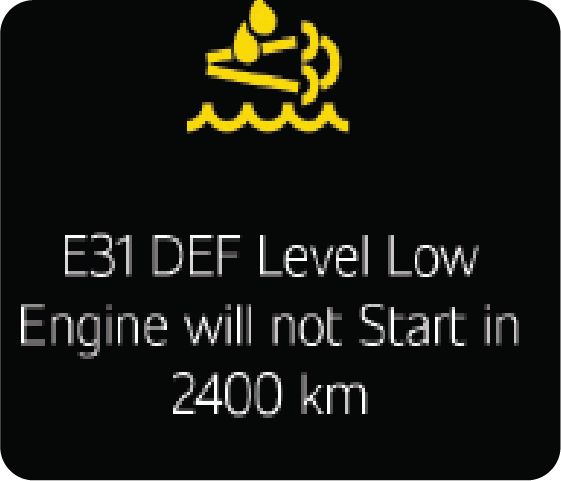
|
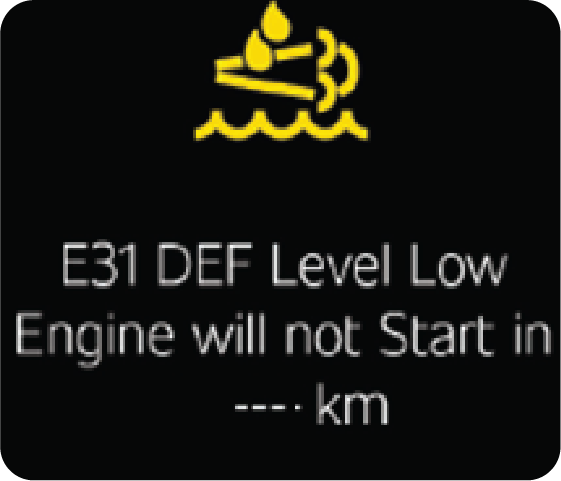
|
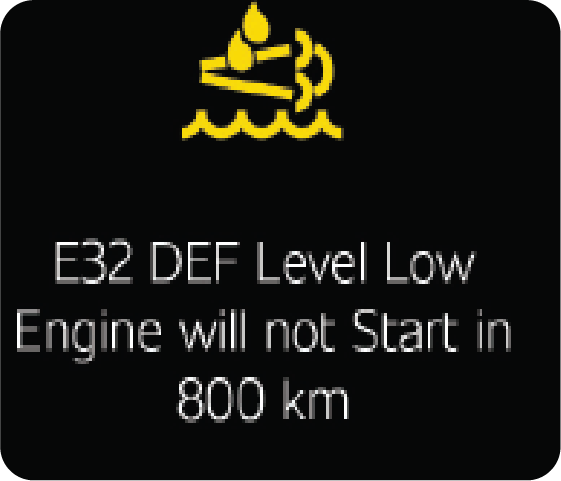
|
|
E33
|
E34
|
E35
|
|
|
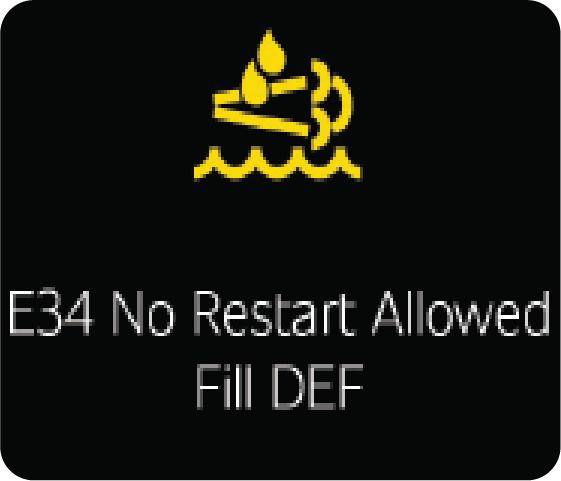
|
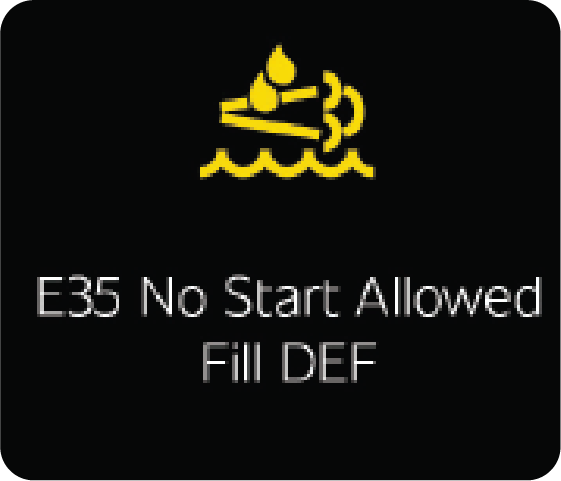
|
In absence of DEF level low warning, refilling is not
recommended.
Total DEF quantity inside the DEF Tank should never be more than 20
liters. Overfilling may result in system/component failure.
Only a Authorised Mahindra Dealer will be able to correctly determine the quantity of DEF present
inside the tank. Hence if
you are refilling the DEF yourself, fill only 6.0 liters in case the DEF Low level warning is
flashed.

If the DEF warning lamp
turns
on due to the DEF level, refill the DEF tank. Failure to refill may cause engine start
restriction.
4.2.3 DEF Quality
If SCR system detects the quality of DEF inside the tank
is not
meeting IS 17042 (or) ISO 22241 specification, warnings will
be flashed in stages as explained below:
|
E11
|
E12
|
E13
|
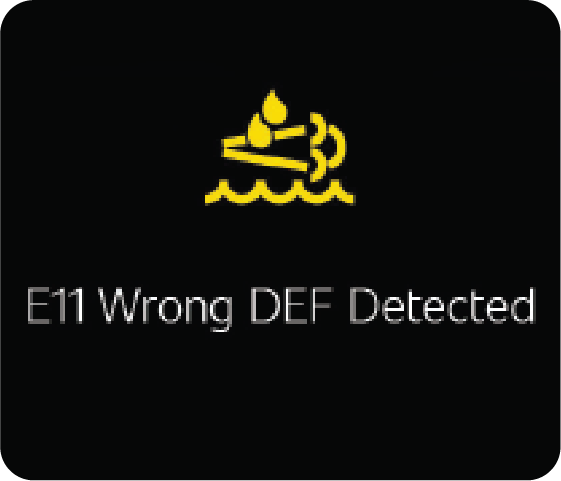
|
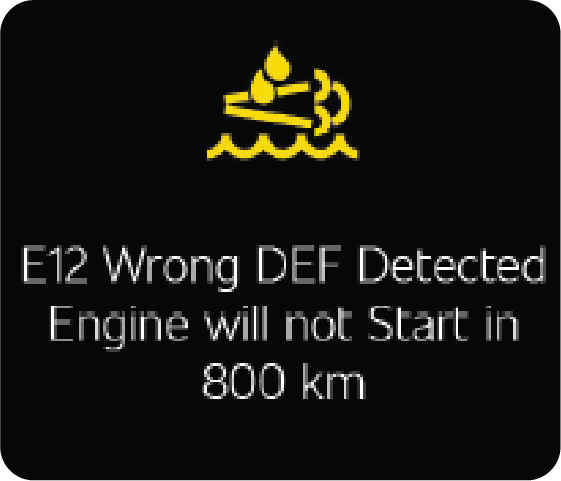
|
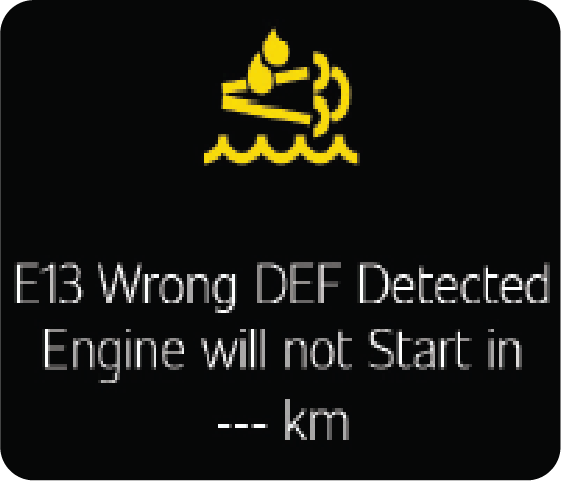
|
|
E14
|
E15
|
|
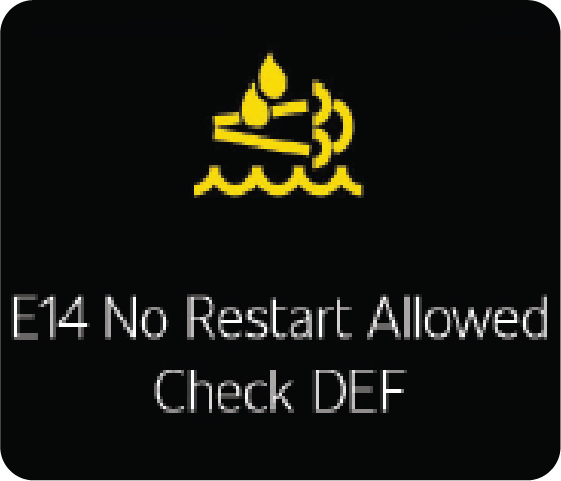
|
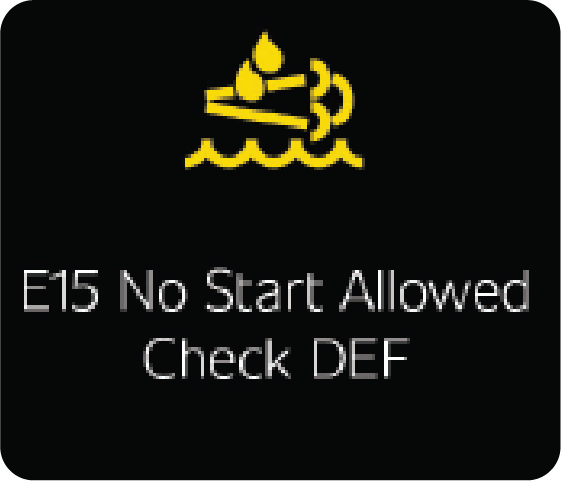
|

If the DEF warning lamp
turns
on due to the DEF quality, visit the nearest Authorised Mahindra dealer to have this
repaired.
Failure to repair the system may cause the engine start restriction.
4.2.4 DEF Dosing Malfunction
If SCR system detects any malfunction due to failures in components
or
tampering, warnings are flashed in stages as explained
below:
|
E21
|
E22
|
E23
|
|---|---|---|
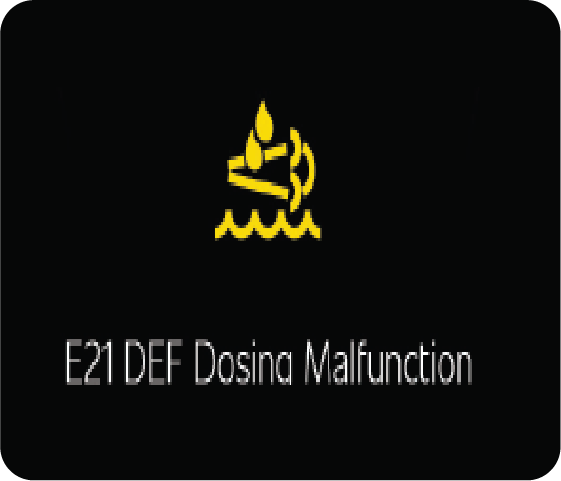
|
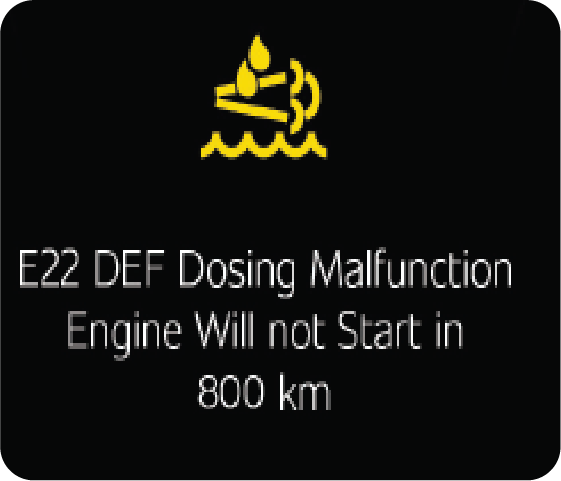
|
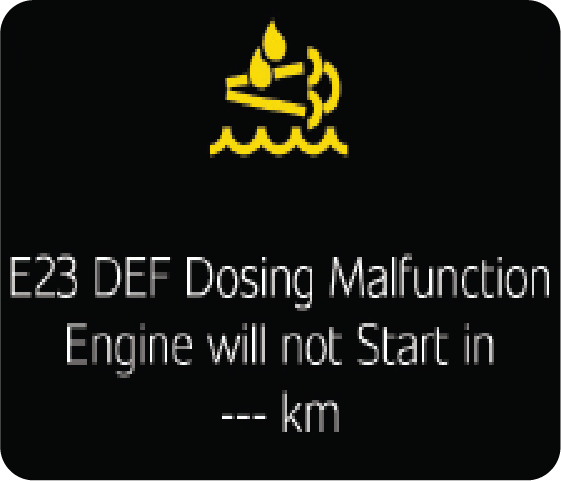
|
|
E24
|
E25
|
|
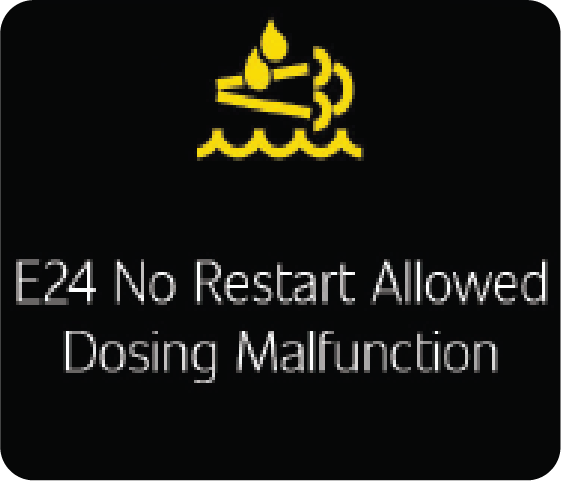
|
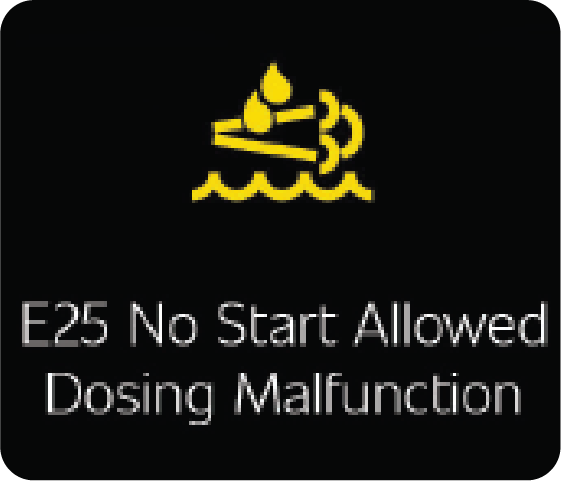
|

If the DEF telltale turns on
due to dosing malfunction, visit an Authorised Mahindra Dealer to have this repaired. Failure
to repair the system may cause engine start restriction.
4.3 Diesel Particulate Filter (DPF)
The Diesel particulate
filter
(DPF) is an integral part of the vehicle exhaust gas emission reduction systems and it
removes
the soot (Particulate matter) from the exhaust gas. Unlike a disposable air filter, the DPF
is a
regenerative filter. Regeneration
is triggered automatically according to vehicle driving conditions which burns the
accumulated
particles/soot from the DPF.
The process is called as DPF Active
Regeneration.
However, if the
vehicle
continues to be driven in the below conditions the accumulated soot may not be automatically
removed
because of low exhaust gas temperatures.
1. Heavy traffic driving conditions, especially in the city
2. Frequent short trips
3. Low speed for a long time
When more than a certain amount of soot gets deposited, the DPF
telltale turns ON along with the DPF clogged alert.
|
|
|
If the DPF telltale turns ON when driving the vehicle, it indicates
that
the DPF regeneration has not occurred successfully.
At this moment, we suggest DPF regeneration must be done as mentioned below:
Take the vehicle to an empty stretch of road/highway and
drive for 20 –
30 mins @ speeds above 60 km/hr until the telltale
turns off.

| • | Follow speed limits & traffic regulations as defined by local jurisdiction while driving. |
If the DPF telltale starts blinking, perform DPF park
regeneration
following the below procedure.
If the OBD telltale is ON & DPF telltale blinking. Stop
the vehicle
and contact the nearest Authorised Mahindra dealer for
assistance.

Continuous driving with DPF
telltale blinking may lead to failure of exhaust system components
DPF Park Regeneration
DPF park regeneration is the procedure to start a DPF regeneration
when
the vehicle is stationary from the instrument cluster.
Follow the below steps to perform Park Regeneration. The DPF park regeneration is only possible when
the
REGEN telltale is
ON in the instrument cluster.
| • | Park the vehicle safely in a well ventilated levelled open space and free of any flammable material. |
| • | Shift the gear lever to Neutral with the engine running and apply the parking brake. |
| • | Access the Drive info menu in the instrument cluster
and
press the down button to go to the REGEN screen, REGEN screen will
appear only when the REGEN telltale is ON.
|
| • | REGEN screen will go OFF if REGEN telltale turns OFF. |
| • | When in the REGEN screen of the drive info menu, long Press OK button on the steering wheel or the driver side switch bank to start park regeneration. |
| • | Once regeneration starts, “In Progress” text will
appear
below REGEN. The engine idle speed will increase indicating regeneration
has started.
|
| • | Park Regeneration can take up to 30 minutes to complete. Once completed the REGEN telltale in the instrument cluster will turn OFF. The engines idling speed also returns to normal. |
| • | To abort the Park regeneration in case of any emergency, turn OFF the ignition or press any of the Accelerator, Brake or Clutch Pedals. |
| • | If the Park Regeneration gets aborted by itself or does not start, contact an Authorised Mahindra Dealer for assistance. |

| • | During the regeneration process, ensure not to park the vehicle close to any flammable materials as you may observe hot emission gases from exhaust pipe. |
| • | To avoid burns & personal injury, keep yourself away from exhaust system. |

Park Regeneration process will
not
start if CHECK ENGINE LAMP or OBD are ON in the cluster. Take your vehicle to a Authorised
Mahindra dealer for assistance.
When Park regeneration is
happening do not press the Accelerator, Brake, Clutch pedals or change the gear from Neutral or
Park as this will abort the regeneration process.
Diesel Fuel
It is recommended to use the regulated automotive diesel
fuel confirming
to IS 1460: 2017 spec only.
If the diesel fuel with high sulfur content (more than 10 PPM) and
unspecified additives are used, it can cause damage to
the DPF system and will not be covered under warranty.
4.4 Instrument Cluster Telltales for
DPF
& SCR Systems

For other regional languages, Kindly refer the Annexure chapter at
the
end of this manual.
Do's &
Don’ts
Selective Catalytic
Reduction
(SCR)
| • | Diesel Exhaust Fluid (DEF) complying to IS 17042 (or) ISO 22241 specification can be used. |
| • | Never attempt to use agricultural grade urea mixed with water. Agricultural grade urea does not meet the necessary specifications and the after-treatment system of your vehicle may be damaged. |
| • | Do not add urea to DEF and do not dilute with water. This may cause damage to the treatment system. |
| • | Total DEF quantity inside the DEF tank should never exceed 20 liters. Overfilling may result in system/component failure. |
| • | While refilling DEF inside tank be careful not to allow any foreign particles, liquids, wiping paper/clothing fibers or lint to get inside the system. These may clog or damage the system. |
| • | DEF is not a fuel additive and must not be added to the diesel fuel tank. If DEF is mixed with the diesel fuel, engine/fuel system could get damaged |
| • | If DEF is spilled over vehicle components and metal surfaces, rinse with water or wipe off with sponge and water. DEF residues will corrode the components and metal surfaces, painted body panels |
| • | Do not refill the DEF with Engine ON or ignition ON state |
| • | When opening the DEF filler cap, ammonia vapors may escape. Refill DEF in a well - ventilated area only. |
| • | Ensure that DEF does not come into contact with skin, eyes, or clothing |
Diesel Particulate Filter (DPF):
During the regeneration process, ensure not to park the vehicle near any flammable materials as
you may observe hot emission
gases from exhaust pipe.
To avoid burns & personal injury, keep yourself away
from exhaust
system.
Follow speed limits & traffic regulations as defined by
local
jurisdiction while driving.
5 OPENING AND CLOSING THE VEHICLE
Your SCORPIO-N comes with
Remote
Keyless Entry (RKE) or Passive Keyless Entry (PKE) depending on the variant. The keys operate all locks
in your vehicle including those of the doors and ignition with steering lock.
|
|
Key Tag: Your key has a unique tag number
which will be used incase of key lost. It is given on the tag attached to the
key.
It is
recommended that you record the key tag number and store in a safe place.
|

Never leave the key in the
ignition switch with children in the vehicle. A child could switch on the ignition, start the
engine,
operate power windows and other controls, or move the vehicle, resulting in personal injuries
to
the by stander and/or children
seated inside.
5.1 Doors
5.1.1 To Open a Door from Outside
|
|
Pull the door handle firmly outwards to unlock and
swing the door to open.
|
5.1.2 To Open a Door from Inside
|
|
Pull the door lever away from the door and push the
door outward to open.
|
5.1.3 Locking / Unlocking
Individual
Doors from Inside
Individual doors can be locked/unlocked from inside by
the respective
door lock tabs.
Pull the lock tab outwards to unlock or push the tab
inwards to lock
that particular door.
|
|
A: Unlock
B: Lock
|

Locking the driver door from inside activates the central
locking
system, thereby locking/unlocking ALL the doors of the vehicle.
Refer to Central Locking section for further details.
5.1.4 Manual Locking/Unlocking
Doors
from Outside
The driver door can be manually locked/unlocked from
outside by using
conventional key.
|
|
The key is bidirectional. You can insert it into the
keyhole either way. Turn the key anti-clockwise to lock or clockwise
to unlock the door.
|

A keyhole is provided in the driver door, to lock/unlock the
doors
manually from outside. Locking the driver door from outside
activates the central locking system, thereby locking ALL the doors of the vehicle. Refer to
Central Locking section for further
details.
5.1.5 Locking / Unlocking the
Tailgate
|
|
Press the Tailgate release button for 2 seconds on
the
remote to unlock the tail door. The hazard lamp flash three times indicating
the same.
|
|
|
Then press the tail gate release switch on the
bottom
of the tailgate within 45 second as shown in the illustration and pull
tailgate to open.
|
To close the tailgate, Push the tailgate door will be
locked
automatically
5.2 Central Locking System
All doors of the vehicle can be simultaneously locked or
unlocked from
the driver door.
5.2.1 Central Locking/Unlocking
All
Doors from Outside
|
|
To manually lock/unlock driver door and Tail doors
from
outside using the conventional key, turn the key anti-clockwise /clockwise
respectively in the driver door keyhole.
|

If any door was unlocked or
not
closed completely when central locking activated. It will only get locked when the door is
completely closed..
Central locking ALL the
doors
in the vehicle can also be done using the key fob. Refer the relevant sections in this
chapter
for more details.
5.2.2 Central Locking/Unlocking
All
Doors from Inside
Pull the driver door lock tab outwards to unlock or push the tab
inwards to lock all doors simultaneously
|
|
A: Unlock
B: Lock
|
|
(or)
|
|
|
|
Driver can simultaneously lock/unlock all the doors
by
pressing this switch as shown in the image.
|
Anti-Lock Out
Master Actuator Lock
at Door open
(Except Driver Door) If any door is opened and driver door is in closed condition:
| • | Vehicle speed is below 7 kmph - On actuating master actuator lock manually, master actuator will get lock & unlock immediately for the first time. On actuating master actuator lock again, vehicle will get locked. |
| • | Vehicle speed above 7 kmph - On actuating master actuator lock manually, vehicle will get locked for the first time itself. |

If driver door is open and master actuator lock is performed,
vehicle will not get locked
5.2.3 Child Safety Rear Door lock
(If equipped)
Your vehicle is equipped with left and right-side child safety rear
door locks. When the lock mechanism is engaged, the rear
door(s) cannot be opened from the inside. The door(s) can only be opened from the outside.
To activate
the child
safety right rear door lock, push the lever down (A) till you hear a distinct click indicating the
activation of
the child lock.
To
de-activate the child
safety right rear door unlock, pull the lever up (B) till you hear a distinct click indicating the
deactivation
of the child lock.
|
|
A: Unlock
B: Lock
|

If the rear doors are not
operable from inside, ensure that the child safety locks have been disabled.
Mahindra strongly recommends
that the child safety rear door locks be used whenever there are children travelling in the
rear
seat.
5.3 Remote Keyless Entry (RKE) System
Remote Keyless Entry (RKE) System enables you to LOCK or
UNLOCK your
vehicle without manually lock/unlock the doors.
Precautions while
Handling Remote
Key:
| • | Do not cover the key grip with any material that cuts off RF signal |
| • | Do not leave the key exposed to high temperatures for a long period, such as on the dashboard or bonnet under direct sunlight |
| • | Do not put the key in any liquid or wash it in an ultrasonic washer |
|
|
A: LED
B: Lock
C: Tailgate Release / Search
D: Unlock
|
5.3.1 Remote Key Status LED
LED present on Remote would be indicating the user
about the Remote
lock/unlock/trunk button input.
5.3.2 To Lock and Arm the Vehicle
with RKE
|
|
Press the LOCK button on the RKE key fob for locking
and arming the vehicle.
|
Hazard lamps flash
once -
if all the doors in the vehicle are locked and armed successfully using RKE.
Hazard lamps flash
five times
along with an alarm - if any of the doors (including bonnet) in the vehicle are open.

If alarm is in mute
condition
only the Hazard lamps will flash. If alarm to be activated then Press Lock & Unlock
button
together
to unmute the alarm. Now both Hazard lamps flash and alarm will work.
5.3.3 Unlock and Disarm the
Vehicle
with RKE
|
|
Press the UNLOCK button on the RKE key fob to unlock
and disarm the vehicle.
|
Hazard lamps flash
twice -
if there was no theft attempt during the lock (armed) period.
Front DRL & Tail
lamps flash
twice (If equipped) - if there was no theft attempt during the lock (armed) period.
Hazard lamps flash
four times
along with an alarm - if there was a theft attempt during the lock (armed) period.
|
|
“Selective
Unlock”
Driver Door - “Selective
unlock”
should be enabled in Infotainment System for using this feature. Once
enabled, if RKE unlock button is
pressed, only Driver door will be unlocked. RKE unlock button has to be
pressed again to unlock other doors.
|

Upon the remote lock, if any of the doors are not closed
properly or left open, the hazard lamps will flash five times to
indicate the same.
5.3.4 Search Function
|
|
Press the Tailgate button on the key fob 2 times
within
2 seconds to locate the vehicle in a parking lot. Search alarm can
also bring attention to the vehicle and surrounding area, warning about an intruder
or
seek for help.
|
When the SEARCH function is ON, the hazard lamps flash
along with an
alarm for 30 sec. In this mode:
| • | Pressing any button on the key fob again switches OFF the alarm |
| • | Pressing the UNLOCK button switches OFF the alarm and disarms/unlocks all doors |

The search function works both during the Locked/Unlocked
conditions of the vehicle.
5.4 Passive Keyless Entry (PKE) System
(if equipped)
Passive Keyless Entry (PKE)
System enables you to enter or exit your vehicle without the need to manually lock/unlock the
doors. You can start/stop, lock or unlock the vehicle using PKE. To do this, you only need
carry
the PKE key fob with you.
|
|
A: LED
B: Lock
C: Tailgate Release / Search
D: Unlock
|
The front side of the PKE
key
fob has three control buttons: Unlock (D), Lock (B) and Tail gate release (C) buttons. There
is also a emergency key release button, which releases a mechanical key for emergency
purposes
(E.g. when PKE battery is low).
To remove the metal key, press and hold the release button and pull the mechanical key
out.

| • | While locking and unlocking the vehicle Passively, the distance between the Smart Key and the corresponding door handle must not be greater than 3ft (1m). |
| • | Do not cover the key grip with any material that cuts off RF waves |
| • | Do not leave the key exposed to high temperatures for a long period, such as on the dashboard or bonnet under direct sunlight |
| • | Do not put the key in any liquid or wash it in an ultrasonic washer |
| • | The PKE can malfunction if exposed to moisture or static electricity |
Carrying the PKE along with you, you can lock or unlock the doors and
tail door and even start and stop the engine without
inserting the key. Functions of the buttons on a PKE is similar to the remote keyless entry.
Locking the vehicle
|
|
1. Carry the Key fob
2. Close all the doors
3. Press the button in the door handle.
|
4. The hazard warning lights will blink once to indicate
the locking (5
blinks and 5 chirps will be provided if engine bonnet
is open while locking)
5. Make sure that the doors are locked by pulling at the
outside door
handles

| • | Key should be in the proximity of less than 0.7 m from the outside door handle |
| • | Vehicle can be locked centrally by pressing the button in the door handle with the PKE key fob in the proximity (PKE key fob should be nearer to the triggered side). For E.g., locking/unlocking of the driver door is possible only if PKE is around the driver area |
| • | Even after
pressing the outside door handle button, if the doors do not lock, a chime is
heard
along with the hazard blinking
for 5 times, then one of the following situations are possible
reason:
|
| • | On attempting to lock by pressing the button in door handle, an alert will displayed in cluster, if the steering is not locked |
| • | With the one PKE Key fob inside, on locking the vehicle using other key fob/2nd key fob, the key which is kept inside would get deactivated completely for the security of the vehicle. To make the key active again, the vehicle should be unlocked either using PKE or by pressing remote unlock using the other key fob with which previously the vehicle was locked. |
| • | On performing PKE passive lock with key fob in your possession in ignition ON state, "Key Not in Vehicle" alert will be triggered in cluster along with chirp & hazard lamps flash for 5 times and vehicle will remain in unlock state. |
| • | On performing key fob remote lock with all doors closed in ignition ON state, no alert will be triggered and vehicle will remain in unlock state. |
Unlocking the
vehicle:
| 1. | Carry the PKE Key fob |
| 2. | Press the button in the door handle |
| 3. | All doors would unlock and Front DRL & Tail lamps flash twice. |

| • | Key should be in the proximity of less than 0.7 m from the outside driver door handle |
| • | Vehicle can be unlocked centrally by pressing the door handle only when the key is in same side of the driver door handle is pressed |
Unlocking the Tail door
alone:
1. Carry the PKE Key Fob
|
|
2. Press the button in the tail door handle and pull
the
tail door.
|
3. Tail door would unlock and hazard warning lights will
blink 3 times
4. On closing the door, tail door would get locked
automatically

| • | Key should be in the proximity of less than 0.7 m from the outside door handle |
| • | Tail door can be unlocked by pressing the button in the tail door only when the key is in range from the tail door |
Mute/Unmute the
Alarm/Beeps
|
|
The chirps
can
be muted / unmute. Press the LOCK & UNLOCK buttons together for 3 sec. to
toggle between MUTE/UNMUTE mode.
Hazard lamps will flash once to indicate unmute to mute condition. Hazard lamp
& chirp will flash once to indicate Mute to
unmute.
|

Only the door open beeps
and alarm can be muted. The PKE alerts cannot be muted.
5.4.1 START/STOP Switch ( SSS)
(if
equipped)
|
|
The engine can be started or stopped by pressing the
Start Stop Switch (SSS), with the valid PKE Key Fob inside the vehicle.
|

Whenever the doors are
opened
or the door handle button is pressed, the engine start/stop switch will be illuminated and
will
go off after few seconds.
|
|
Upon any fault identification by the system in the
start/stop switch (SSS), an alert would be provided in the instrument cluster
for few seconds. Please visit the nearest Mahindra Authorised Dealer immediately to
rectify the problem.
|

Even with the failure in the
start/stop switch, vehicle's normal function may work which depends on the severity of the
failure.
Please visit the nearest Mahindra Authorised Dealer to rectify the problem immediately.
Engine start/stop
Switch
positions:
To operate the engine start /stop switch to its intended
function, PKE
Key Fob should be inside the vehicle.
OFF: To turn off the
engine, stop the vehicle and press the engine start/stop switch once. Status LED in the engine
start
/stop
switch goes OFF to indicate the OFF position.

If the Engine is not
switching
off after pressing the Engine Start Stop switch (One Press), then press and Hold start/stop
switch for more than 3 seconds ( Long press SSS) or rapidly press & release the engine
start/stop switch 3 times within 3
seconds. On doing so, the vehicle ignition(IGN) status is changed to ACC position. Vehicle
ACC mode will get off after 30
second OR user is opening Driver door. However, you can still lock the vehicle using
mechanical key. Contact the nearest
Mahindra Authorised Dealer at the earliest
Your vehicle is equipped with electronic anti-theft steering column
lock. The steering wheel locks when the engine start/stop
switch is in OFF position to protect against the theft. The steering wheel locks automatically when
the driver door is opened
or 30 seconds after engine start stop Switch changes to OFF position. If the steering wheel is not
locked properly when you
open the driver door and on attempting to lock the vehicle, a warning chirp along with the hazard
blinks thrice. Try locking
the steering wheel again (by toggling Engine Start/Stop switch). If the problem is not solved, we
recommend to take the vehicle
to nearest Mahindra Authorised Dealer immediately.
Ignition ON: To switch
ON
the ignition, press the engine start/stop switch when the switch position is in OFF/ACC without
depressing the
clutch pedal and with the PKE Key Fob inside the vehicle. Status LED in the engine start/stop
switch
will turn red to indicate
the IGN ON position and the vehicle is ready for starting.
|
OFF
|
ACC
|
ON
|
|
|
|
|

Keeping the system in the
ignition ON position for longer time (will be noticeable by the LED lamp of the SSS remaining
ON)
without engine running, can drain the battery. Switch OFF the system if engine is not to be
started for long duration.
Vehicle ignition would not turn to ON position on any of
the following
conditions:
| • | If the electronic steering lock is not getting unlocked |
| • | A warning would be displayed in the cluster screen
for few seconds.
Still if you are not able to turn ON the IGN, please
contact the nearest Authorised Mahindra Service Centre.
|
| • | When engine start/stop switch is ON or engine is
in
running condition with vehicle at standstill and if any door is opened
& closed, the system checks for the PKE Key fob.
|
Bring the PKE Key Fob inside the vehicle or keep the key
in the
detectable position whenever you are inside the vehicle.
Starting the
vehicle
Manual Transmission: To
start the engine, press the clutch and press the engine start/stop switch once with the key inside
the
vehicle. The engine
can be started from any position (OFF / ACC / ON) of the start/stop switch.
Automatic Transmission:
To
start the engine, Gear Lever shall be in Park Position, press the Brake pedal and press the engine
start/stop switch once
with the key inside the vehicle. The engine can be started from any position (OFF / ACC / ON) of
the
start/stop switch.

Ensure the gear lever is in
neutral/Park position before starting.

If engine start/stop
switch is pressed without pressing the clutch (MT) / Brake (AT) pedal, engine will not
start, and the
vehicle power modes will change as follows: OFF→ ON →OFF→ ON
If the engine
start/stop
switch is pressed from the OFF position directly, along with the clutch (MT) / Brake
(AT)
in depressed
position, there may be a small delay in the engine cranking. This is normal and is not
a
fault.
Never press the
engine
start/stop switch while the vehicle is in motion except in an emergency. This will
result
in the engine
turning off and loss of power assist for the steering and brake systems. This may lead
to
loss of direction control and braking
function, leading to an accident.
Even if the key fob
is
not there in the cabin. The engine will keep running, until it is switched off, after
that
it can not
be restarted in absence of the key Before leaving the driver seat, always make sure engine
start/stop switch is in OFF position and always take the PKE Key
Fob with you. If the Ignition remains ON and the doors are locked. The central locking
system will give 3 chirps and flashes
to indicate. This can cause battery to be drained off.
As a emergency
procedure
(if any failure of brake or clutch switch). If the SSS is pressed continuously for more
than 10 seconds
then the engine can be started.
Emergency stop: To turn
the
engine OFF in an emergency, press and hold the engine start/stop switch for more than 2 seconds or
rapidly press
and release the engine start/stop switch 3 times within 3 seconds. On doing so, the vehicle
ignition
is changed to ACC position.
BACK up
Start: If the key
fob battery is low, the key may not be detected on pressing SSS and SSS LED will be blinking in red
color. In
such a situation, press the start/stop switch once while the status LED in the button is blinking
Red
and the below error
message is displayed in the instrument cluster.
|
|
Now place the key fob in the key fob tray with the
Clutch(MT)/Brake(AT) pedal pressed and then push the Start-Stop switch
twice to Start the engine.
|

On pressing the Start/Stop switch 1st time with the key fob in
the
key fob tray below the armrest. The Start-stop switch LED
will blink in red color, with the above error message will be displayed again in the cluster. In
this case, if you press the
Start/Stop switch again vehicle will start in Back-Up mode, if the Clutch(MT)/Brake(AT) pedal is
pressed.
Back-up Mode
: When the key
fob battery is critically low to detect the key fob inside the vehicle or the battery is dead or
not
available.
This mode is triggered by the PKE to understand the condition to Switch ON ignition and to start
the
vehicle engine.
|
|
If key fob battery is detected low by the PKE
system,
an alert would be triggered. Change the battery by following the procedure
as mentioned in the section for battery replacement.
|

Key fob battery low can be
detected only if the key has been continuously used in the vehicle. Keeping the key outside
the
vehicle for longer duration and then using it with the drained battery cannot be detected.
5.4.2 Vehicle locking/Unlocking
in
an Emergency Situation
If the PKE Key Fob does not operate normally, you can
lock or unlock
the doors by using the mechanical key:

Refer to Manual Locking/Unlocking Doors from Outside
(Mechanical/Electrical Handle) section for more details.
It is strictly not advisable to leave the key fobs in the
vehicle.
Vehicle can be started by any unauthorised person.
A maximum of 2 Keys can be
registered to a vehicle. If you lose a key, we strictly recommend to contact Mahindra Authorised
Dealer immediately to block the lost key and to get a new key.
The PKE Key Fob may not work
if
any of the following occurs:
| • | If the vehicle is close to a radio station, airport, or an area where there is a possibility of large radio transmissions which can interfere with the normal operation of the PKE/RKE |
| • | The PKE Key Fob is near a mobile or a cellular phone or some electronic gadgets like Laptop/Tablets. The signal from the PKE/RKE could be blocked by normal operation of your cell phone or smartphone . Avoid placing the PKE/RKE and your electronic gadgets in the same trouser or jacket pocket or in the bag and maintain adequate distance between the two devices |
| • | Another vehicle PKE key fob is being operated close to your vehicle |
| • | PKE Key Fob kept inside the glove box or top bin in the instrument panel may not be detected sometimes. Keep the PKE Key Fob in the visible zone or in your pocket for getting it detected |
| • | Keep the PKE key fob away from the water or any liquid. If the keyless entry system is inoperative due to exposure to water or liquids, it will not be covered by your manufacturer’s vehicle warranty |

Make sure the vehicle ignition is in OFF state, whenever
leaving the vehicle even with the key. By keeping the vehicle ignition
in ON/ACC state will hamper the vehicle security.
Do not hand over the PKE Key Fob to any unauthorized person
or
service provider. Your vehicle security system may be compromised
in doing so.
5.4.3 PKE Alerts
| Display | Operating Conditions |
|---|---|
|
|
The
warning will be triggered when the vehicle Ignition is in ON
condition with the Brake pedal pressed & the user is pressing
SSS to start Vehicle & Gear position is not in park or
neutral.
(If equipped)
|
|
|
The warning will be triggered when vehicle
Ignition ON or Engine running condition, user is pressing SSS to turn OFF
Vehicle
& Gear position is not in park. (If equipped)
|
|
|
The warning will be triggered when Start
Stop
switch is Malfunction . Kindly contact the nearest Mahindra dealer
|
|
|
The warning will be triggered when Key fob
is
not getting detected by the system. Users need to keep the key in the
armrest
Key fob Tray and then press the start/stop switch to turn ON the vehicle.
|
|
|
The warning will be triggered when vehicle
ignition in OFF condition. When user tries to lock the vehicle using driver
door
& co-driver PKE trigger switch, but key is inside the vehicle.
|
|
|
The warning will be triggered when vehicle
is
in cranked or in ignition ON condition, but key is not inside the vehicle.
|
|
|
The warning will be triggered when Key Fob
battery is Low.
|
5.4.4 Steering Lock Alerts
|
Display
|
Operating Conditions
|
|---|---|
|
|
A warning will be displayed in the
Instrument
cluster. If the steering wheel doesn’t unlock properly, press the
start/stop
switch while turning the steering wheel right/left to release the tension
on
the lock.
|
|
|
If the electronics Steering Wheel not
getting
locked even though all locking conditions are satisfy then this warning is
displayed.
|
|
|
A warning will be displayed in the
Instrument
cluster. If the steering wheel lock unit has system failure. in this case
please
contact Mahindra dealership to check system failure.
|
|
|
A warning will be displayed in the
Instrument
cluster. If the steering wheel does not pair with PKE ECU. in this case
please
contact Mahindra dealership to check system.
|
5.5 Remote Battery
Battery
Specification
|
Battery Voltage
|
3 V
|
|
Battery Capacity
|
225 mAh
|
|
Battery Model No.
|
2032
|
Remote Battery
Replacement
|
If the
Remote
operation is inconsistent when any of the buttons are pressed, then it
indicates
that the Remote battery is
weak.
|
|
|
|
The rear side of the Remote is snap fitted. Flip open
the
key blade and use two fingers on the side of the fob and gently
pry open the battery cover.
|
Use a small flat head
screwdriver to gently pry out the battery to and discard the same. Insert new batteries of 3V
type (Battery
No. 2032). While fitting the new battery, ensure the positive side of the batteries face up.
Align both the halves of the
Remote casing and press to snap fit. Check operation of the Remote.

While prying the Remote case,
take
care not to damage the battery.
Do not touch the battery
terminals
that are on the back housing or the printed circuit board.
Pull out the battery and
discard
the same. Insert new battery of same type. While fitting the new battery, ensure the positive
side of the batteries face up. Align both the halves of the Remote casing and press to snap fit.
Check operation of the Remote.
The Batteries are Lithium Ion
batteries. They should be kept away from children.

This product contains a
lithium button cell. If the button cell is swallowed, severe internal burns can occur
within
a mere
two hours and lead to death.
Keep new or removed
batteries away from children. If the battery compartment does not close securely,
discontinue
use and
keep away from children. If you think that batteries have been swallowed or stuck in any
part
of the body, seek medical help
immediately.
5.6 Remote Functions
5.6.1 Auto Locking
All doors will get locked automatically when;
All doors are closed properly
Vehicle speed is greater than 7 kmph
All doors are closed properly
Vehicle speed is greater than 7 kmph
Auto Locking ON DOOR
OPEN:
Once the auto lock has been activated, if any door is opened, then the auto lock will reactivate
only
if all doors are closed,
the vehicle speed goes below 5 kmph and further crosses 20 kmph
Auto Locking ON
MASTER ACTUATOR
UNLOCK :Once the auto lock has been activated,
if
any door is opened, then the auto lock will reactivate only if all doors are closed,
the vehicle speed goes below 5 kmph and further crosses 20 kmph
5.6.2 Auto Unlocking
Auto Unlock of all doors will happen when Ignition is
switched from ON
to OFF, or In the event of a crash
5.6.3 Auto Re-locking
Auto Re-lock of all doors will happen when;
No door status change for 45 seconds after unlocking the vehicle using RKE/PKE
No door status change for 45 seconds after unlocking the vehicle using RKE/PKE
5.6.4 Mute/ Unmute Function
|
|
The chirps can be muted / unmute. Press the LOCK
&
UNLOCK buttons together for 3 sec. to toggle between MUTE / UNMUTE mode.
|
Hazard lamps will flash once to indicate unmute to mute
condition.
Hazard lamp & chirp will flash once to indicate Mute to
un-mute

In the unmuted
condition, alarm chirps can be heard during Auto Re-lock (1 Chirp), RKE Lock when door
open (5 Chirps) and
RKE Unlock if there was a theft attempt during the lock (armed) period (4 Chirps). In
the
mute condition, only hazard would
flash and alarm chirps would not be audible.
5.6.5 Theft Alarm
Vehicle enters alarm mode when there is a change in door
status/ignition status provided the vehicle was locked through RKE.
Hazard Lamp and Alarm will flash 27 seconds.
After the alarm period, there will not be any alarm
again till any
further change in the door/ignition status.

The security system
will
be activated when the vehicle is locked using the PKE/RKE key fob. Locking the doors
with
the manual
key will not activate the security system.
When the vehicle is
armed by RKE, opening the door from the inside by operating the door inner handle or
opening the door
from the outside using the key will be treated as unauthorised activating the vehicle
security alarm. If this occurs, the
alarm can be disarmed by either pressing the ‘UNLOCK’ button on the RKE or turning ON
the
ignition followed by a successful
authentication.
5.6.6 RKE Operating Range
|
|
Using RKE key fob , you can lock/arm or
unlock/disarm
the vehicle from distances approximately 9 m (30 ft) This is in open
area.
|

If there is reduction in RKE range, please follow the steps
below:
Check the distance: The RKE may be too far from the vehicle. Stand
closer
to the vehicle during rain or bad weather
Check the location: Other vehicles or objects may be blocking the signals. Take a few steps to the left or right, hold the RKE higher, and try again. Moreover, closeness to a radio transmitter such as radio station tower, airport transmitter, mobile or CB radios may lead to reduction in range of RKE
Check the RKE battery: See battery replacement procedure, given later in this section
If the RKE is still not working correctly, contact an Mahindra Authorised Dealer
Check the location: Other vehicles or objects may be blocking the signals. Take a few steps to the left or right, hold the RKE higher, and try again. Moreover, closeness to a radio transmitter such as radio station tower, airport transmitter, mobile or CB radios may lead to reduction in range of RKE
Check the RKE battery: See battery replacement procedure, given later in this section
If the RKE is still not working correctly, contact an Mahindra Authorised Dealer
5.7 Key Fob Tray
|
|
|
The Key fob is to be kept in the above shown key fob tray
when the system
requests, like in the case of the below error message
in the instrument cluster.
|
|
This message is displayed only when the PKE system
fails
to detect the key fob which is inside the vehicle when the user is
trying to Switch ON the ignition.
|

On pressing the Start/Stop switch 1st time with the key fob in the
key
fob tray below the armrest. The Start-stop switch LED
will blink in red color, with the above error message will be displayed again in the cluster.
In this case, if you press the Start/Stop switch again before the
above error message in the instrument cluster goes away
the 2nd time, the vehicle will start in Back-Up mode, if the Clutch(MT)/Brake(AT) pedal is pressed.
5.8 If PKE/RKE Key fob is Lost
If you have lost the programmed PKE/RKE Key fob , contact
Mahindra
Authorised Dealer for procuring a new Smart Key.
While programming a new key set, you will have to submit
all the keys
available with you, to an Mahindra Authorised Dealer.

Please note that there is a
limitation (max. 2 keys at a time) to the number of keys that can be ordered. The minimum
timeframe
required to supply the duplicate keys is 10 days after all the formalities are completed. Please
contact the Mahindra Authorised
Dealer to understand the formalities involved.
If you make your own duplicate
key, you will not be able to deactivate the anti-theft devices or start the engine.
If the key is stolen or lost,
communicate to an Mahindra Authorised Dealer for de-activating the function of the lost or
stolen
key. This is essential to avoid unauthorised access using the misplaced key.
Only PKE/RKE transmitters
programmed to your vehicle electronics can be used for remote locking and unlocking of your
vehicle.
5.9 Key Fob Limitations
When the vehicle key fob is not working properly, It may be due to
Radio
Frequency (RF) interference caused by an external
source like transformer, Amateur Radio, etc.. which emits power levels that is higher than the
vehicle Key Fob. This interference
may be resulting in RF signal not being received by RKE/PKE system controller.
Customer may not get Panic due to this non-function of key
fob. After
moving from the interference Zone, Key Fob may start
working properly.
If still key fob not working then contact Mahindra
Authorised service
center for assistance.
5.10 Engine Immobiliser System
An Engine Immobiliser System is a security system that prevents the
vehicle from being operated by an unauthorised person.
The Engine immobiliser prevents the engine from being started unless it recognizes signals from the
correct coded key. When
a wrong key is inserted or a theft attempt is detected, the alarm is set off, and the hazard lamps
flash
along with a siren.
The system is automatically activated when the key is
removed from the
ignition.
5.10.1 Features of the
Immobiliser
System:
| • | Prevents the vehicle being started by anyone not in possession of the correct vehicle key |
| • | The vehicle is automatically protected after the key is removed from the ignition/vehicle in PKE. At every ignition ON, if the vehicle does not recognize the correct key code, the engine check lamp will blink and security tell tale lamp will illuminate and the engine cannot be started. |
| • | The vehicle will not be protected until the key has been taken out of the ignition/vehicle in PKE. |

If the engine check lamp flashes or remains continuously
illuminated after the ignition being switched ON, there is a system
malfunction. Contact an Mahindra Authorised Dealer
immediately.
With the
correct coded key
in the vehicle and pressing the SSS ON, automatically recognizes and authenticates the
system.
It enables the engine to start.

In the event of the
vehicle not starting with the correct key, switch off the ignition for a minimum of 1
minute and attempt
to start the vehicle again.

Do not modify, remove
or
disassemble the engine immobiliser system. Any unauthorised changes or modifications
can
affect proper
operation of the system and will void your warranty.

The security system
will
be activated when the vehicle is locked using the PKE/RKE key fob. Locking the doors
with
the manual
key will also activate the security system.
Using the ignition key blade to open the diver door, when the vehicle was locked and armed with PKE/RKE key fob, in this condition if any of the door is opened which results in door switch status change will be treated as unauthorised by the system setting and this will trigger the alarm. Press the unlock button on the PKE/RKE key fob to off the alarm.
Using the ignition key blade to open the diver door, when the vehicle was locked and armed with PKE/RKE key fob, in this condition if any of the door is opened which results in door switch status change will be treated as unauthorised by the system setting and this will trigger the alarm. Press the unlock button on the PKE/RKE key fob to off the alarm.
5.11 Opening and Closing the Bonnet
The bonnet release lever is in the driver side foot well
area, below the instrument panel. To open bonnet follow the steps below:
|
|
1. Pull the lever below the driver side instrument
panel
to release the bonnet.
|
|
|
2. Lift the bonnet a little to access the safety latch
holding the bonnet striker. This safety latch is located below the
bonnet at the center.
|
|
|
3. Lift the safety latch and lift the bonnet.
4. bonnet is supported by a stay rod.
|

Be careful while opening the bonnet immediately after a drive; the
engine compartment will be very hot
Always double check to be sure that the bonnet is firmly latched
before driving away. If it is not latched properly, the bonnet
can open while the vehicle is being driven, causing a loss of visibility, resulting in an accident
Do not move the vehicle with the bonnet in the raised position, as
vision is obstructed
To close the bonnet, follow the below steps:
| 1. | Remove the stay rod supporting the bonnet by slightly lifting the bonnet |
| 2. | Bring the bonnet near to its self-opening/closing position |
| 3. | Now, push the bonnet to close and ensure the primary latch is engaged |
| 4. | Before driving off, check bonnet is locked properly with primary latch fully engaged |

Bonnet Open Hazard - When the bonnet is open and vehicle is in
unlock condition:
| • | Hazard lamps flash continuously to alert the user that the bonnet is open |
| • | Hazard cluster telltale also flashes |
To stop the warning, do any one of the following:
| • | Close the bonnet |
| • | Press the hazard button TWICE |
| • | Change the turn signal stalk position |
| • | Drive the vehicle > 10 km/hr. |
5.12 Fuel-Lid Opening and Closing
Follow the below steps to open the Fuel lid:
|
|
|
|
1. Press the UNLOCK button on RKE/PKE.
|
2. Then press the fuel lid gently once to open.
|
|
Diesel
|
Petrol
|
|
|
|

Diesel should be filled in diesel filler cap.
|

Petrol should be filled in petrol filler cap.
|

Diesel should not be filled in blue (DEF) filler
cap.
|
|
3. Turn the fuel cap counterclockwise to open. Refuel and put the cap
back in its place and tighten in the clockwise direction
till three distinct clicks are heard. Close the fuel lid shut and press the fuel lid once again to
make
it flush with body.

Ensure the fuel cap and lid are
securely closed before starting the vehicle.

Fuel filler lid cannot be
released
whenever the vehicle locked condition.
5.13 Manual Fuel Lid Override
Follow the below process to open the fuel lid manually in
case of any
issue in electrical circuits:
|
|
1. Press and Open the trim cover on Left side of
luggage
compartment.
|
|
|
2. Unhook and Pull the blue color knob as shown in the
illustration to unlock the fuel lid manually.
|
3. Then press the fuel lid gently once to open.
4. Turn the fuel cap counterclockwise to open. Refuel and put the cap
back in its place and tighten in the clockwise direction
till three distinct clicks are heard. Close the fuel lid shut and press the fuel lid once again to
make
it flush with body.

Ensure the fuel cap and lid are securely closed before starting the
vehicle.
Do not pull the cable with high force or pull excessively as
it
may damage the locking mechanism.
6 CONVENIENCE SYSTEMS 1
6.1 Control Switches
|
|
The driver door switch bank is located on the driver
door
armrest/handle and controls and the various functions:
|
|
A
|
ORVM Folding/Unfolding Switch
|
|
B
|
ORVM Adjustment Switch
|
|
C
|
Driver Door Window Switch
|
|
D
|
Rear RH Door Window Switch
|
|
E
|
Door Lock/Unlock Switch
|
|
F
|
Window Lock Switch
|
|
G
|
Rear LH Door Window Switch
|
|
H
|
Co–driver Door Window Switch
|
6.1.1 Driver Door Power Window
Switch
Power windows can be operated when the ignition is in
“ON” position.
The driver can operate all the power windows in the
vehicle through
the Driver door window switch on the driver door armrest/handle.
|
|
|
Other passengers in the vehicle can raise or lower their respective
window glasses individually by using the separate switches
provided on each of the door trim pads/armrests.
To lower/raise the window glass, press/lift the
respective power
window switch accordingly

Do not operate the power
windows frequently when the engine is OFF. This will drain the vehicle battery.
If you operate the switches
often during a short period of time, the system might become inoperable for a certain
duration
to prevent damage due to overheating. The system will return to normal functioning shortly.
In
such scenario, customer should
wait for 1-2 minutes & should not operate the switch during this period. After 2 minutes
operate the switch for Open/Close
the windows.
It is recommended to operate
one window switch at a time.

To avoid any personal
injuries
always check and ensure that there are no obstructions like head, hand, etc. while operating
the 'power windows'.
6.1.2 Power Window Lock Switch
The power window quadruple switch in the driver door
trim has a power
window lock switch to enable or disable operation of
rear passenger window switches.
|
|
To disable the rear passenger power windows, press
the
window lock switch down.
To revert to normal operation, press the window lock
switch again.
|
6.1.3 Door Lock/Unlock Switch
|
|
The Door lock/unlock switch is located on the driver
door trim. Driver can simultaneously lock/unlock all the doors by pressing
this switch as shown in the image.
|
6.1.4 Smart Power Window with
Anti-Pinch (If equipped)
Smart power window is one of the significant safety features with
the
anti-pinch function, which automatically reverses the
direction of glass if an obstruction is detected during the auto up mode.
This is applicable for driver and co-driver door.
|
|
This Smart power window has three functions:
|
Auto UP: Pull the power
window switch up for a moment and release. The glass moves all the way up automatically. You do not
need to
hold the switch till the glass closes.
Auto DOWN: Press the
power
window switch down for a moment and release. The glass moves all the way down automatically. You do
not need
to hold the switch till the glass comes down.
Anti-Pinch during Auto
UP
(If equipped): During auto UP if any obstacle is detected with the force value less than 100 N, The
controller senses the
load and reverses the direction of the glass by 180 mm from the point of pinch detection.
Anti-pinch
is available in 0-250
mm from the top.
Driver and co-driver door power window can be opened or closed
through
Remote also. Press PKE/RKE lock button more than 1
seconds to close the power window. Press RKE unlock button more than 1 sec to open the power
window.
(If equipped)

Thermal Protection is
active for all modes of operation, and once activated up movements are not allowed for
30s, and down
movements are allowed if the window is not stalled in either of the stall positions
(top
stall/bottom stall).
Thermal Protection is
tuned for 16 Cycles before 1st activation and inhibition duration is 30
Seconds.
After 30s thermal
protection is de-activated, and the number of cycles available after inhibition is
dependent on the idle
duration. Right after thermal protection inhibition duration of 30 seconds 2 cycles are
available.

Do not remove vehicle
battery while power window is in motion
Extended Operation :
All
doors power windows can be operated UP/DOWN within 3 minutes after ignition off.
6.2 Mirrors
6.2.1 Manual ORVM (if equipped)
Exterior Rear
view mirror
on both left and right sides provides the maximum side rear view information to the
driver.
|
Fold
|
Adjustment
|
|
|
|
|
Push the
mirror back in the direction of the vehicle's rear.
|
Adjust
the
mirror manually by pressing the mirror as required.
|
|
Both the
ORVMs are hinged and can be manually folded or unfolded. This avoids
hindrances in narrow areas and parking slots.
Make sure that you fully engage the mirror in its support, while folding or
unfolding.
|
|

Objects seen in
convex
mirrors are much closer than they appear. Do not overestimate the distance of the
objects
that you
see in the mirrors.
6.2.2 Electric ORVM (If equipped)
|
Electric
Adjustable ORVM
|
|
|
|
|
The electric exterior mirror adjustment switch is located on the
driver door trim/handle. The joystick on the switch can be
used to select the left/right mirror and also to adjust the respective mirror.
ORVM
Folding/Unfolding
Mirror Fold
Function: To
fold the ORVM assembly, press towards the right side of the switch with ignition ON condition.
ORVM folds automatically when:
| • | The doors locked with the remote from outside the vehicle |

For Auto fold function, the switch should be in neutral
position.
|
|
|
Mirror Unfold
Function: To
unfold the ORVM assembly, press towards the left side of the switch with ignition ON condition.
|
|
|
ORVM unfolds automatically when:
| • | Mirror is already in folded condition and ORVM switch is neutral condition and IGN is turned ON |
6.3 Interior Rear-view Mirror (IRVM)
|
|
The interior rear view mirror provides the rear view
information to the driver through the rear windshield. It also assists
during reversing.
|
You can manually adjust the rearview mirror by pushing or
pulling its
adjusting lever to avoid blindness at night due to other
vehicles behind you

When you are not able to see the back of your vehicle at night,
adjust
the rearview mirror by holding the mirror body and
pushing or pulling it to a desired angle so that you can secure a clear rear view.
6.4 Storage Compartments
6.4.1 Rear Luggage Compartment
Third row can be folded for keeping bigger/large objects.
|
|
Fold down the third-row seats. (refer to “Folding
the
third-row seat” section in Seat chapter)
Now the bigger object can be placed with seat folded
condition.
|

When you put the luggage on the folded seat, make sure that the
luggage is placed firmly enough to avoid being shaken while
driving. A shaky or improperly fixed luggage may injure the driver or passenger. Besides, ensure
that the luggage does not
obstruct the field of the rearview
Do not sit on the folded seat because the seat belt and other
safety devices would not be able to protect you. It may cause
serious injury in case of an accident
6.4.2 Sun Glass Holder
Roof mounted sunglass holder is an integral part of the front
interior
lamp.
|
|
|
Press the lid to release the latch and lower the holder.
It is
strategically positioned to be accessed easily by both the
driver and front passenger.

Do not access the sunglass holder while you are driving. It may
distract your concentration and could lead to an accident.
6.4.3 Glove Box
Glove Box : The glove
box
is located on the Left side of Instrument panel. To open the lid, gently press the unlock push
button.
To close
the glove box, raise the lid all the way up and gently press to lock the lid.
|
|
|
It is suggested to keep copies of all vehicle documents
along with the
Owner’s Manual Kit in the glove box for reference when
needed.

To avoid the
possibility of injury in case of an accident or a sudden stop, glove box Lid should be
kept closed when the vehicle
is in motion.
Glove Box Lamp (if
equipped):
|
|
This lamp is located inside the Glove box. It will
get
switched ON when Glove box is opened and switch OFF when it is closed.
|
Cooler (Air vents)
|
|
In select variants, a cooler (air vents) is provided
in
the glove box. You can cool cans, small bottles, etc. by opening the
air vents. Turn the cooler clockwise to open the air vents, or anti-clockwise to
close
the air vents.
|
6.4.4 Centre Console Storage
|
|
|
By pressing up the console knob, you can use the
compartment in the
console storage.
The console storage can also be used as an armrest for
both the driver
and the passenger.

To avoid possible theft, do not leave valuables in the storage
compartment.
Do not store items that are damageable or cause noises since
they
can move around in the compartment while driving.
Do not store any flammable materials such as cigarette lighter
in
the console box or other space. In hot weather, they may
explode and cause a fire.

Only sealed cans/bottles to be stored in the cooler. Any spilled
beverage can damage the interior trim and electrical components/cooler.
6.4.5 Cup Holder
Front Cup
Holder:
A cup holder is located in the floor console between the front
seats,
It can be used for small cups or cans that are closed
or have a lid.
|
Type
1
|
Type
2
|
|
|
|
|
Second row cup
holder and armrest (if equipped)
|
|
|
|
|
Two cup holders are available in the Second Row 60P
seat.
| • | To open the armrest, simply pull on the tab given at the top of the armrest (as shown) |
| • | When armrest is not required, push back the armrest into the 60P backrest |

Only sealed cups/cans with lid to be used in the cup
holders.

Use caution when using the cup holders. A spilled beverage
that is very hot can injure driver or passengers. Spilled liquids
can also damage interior trim and electrical components. Any spilled beverage can
also
startle the driver and cause a loss
of control of the vehicle resulting in an accident.
6.4.6 Bottle Holder
|
|
Bottle and Umbrella holders are located on both the
front door lower trims. You can use them to store umbrella, maps, papers,
small books, bottles, etc.
|

Only sealed/closed bottles are to be used in the bottle holders.
6.4.7 Seat Back-Magazine Pocket /
Mobile Pocket
|
|
The seat back pockets are located on the back of the
front seats for holding lightweight papers/books/magazines, etc.
|
|
|
The mobile pocket is available in the magazine
pocket.
|

To avoid injury, do not place large or hard objects in the seat
back pockets. Do not put more than 1 kg weight in seat back
pockets.
6.4.8 Grab Handle and Coat Hook
Grab Handle:
Foldable grab
handles are provided above the Co-driver, Second row and Third row outboard seats.
Coat Hook: It is
available
in the second-row outboard passenger seat Grab handles for hanging your coat, shirts, etc.
|
|

Hanging
excess/bulky weight/items may cause breakage of the hook and
inconvenience
to the passengers. Hang light weight articles
only.
|
6.5 Microphone(as applicable)
|
|
The microphone is located on the roof above driver side
as
shown in the image.
The microphone is used when talking on the phone. The
person you are speaking to can be heard from the front speakers.
|

To use the hands-free system, you must pair your Bluetooth® phone
to
the system.
6.6 Sun Visor
|
Use the sun
visor to shield the direct sunlight through the front or side windows. It is
available on both driver and co–
driver side
|
|
|
|
To shield the sunlight through the windshield, pull it
downward.
|
|
|
To shield the sunlight through the side window, pull it
downward, unsnap it from the bracket and swing it to the side.
|
Ticket Holder:
Ticket holder
is a part of
Sunvisor for keeping the Tickets, Bills, Cards, etc., for easy access.
|
|

|
| • | Adjusting the sun visor or using the mirror or ticket holder on the sun visor while driving may cause an accident by taking your attention away or blocking your view |
6.6.1 Vanity Mirror and Lamp (if
equipped)
|
Vanity mirror is in the Sun visor.
|
|||||||
|
|
|
||||||

Do not adjust the sun visor while the vehicle is in motion.
6.7 Center Fascia Switch
Center fascia switches are located at the center of the
Instrument Panel.
There are three types of center fascia switches available
based on the
variants.
|
Sl.
No.
|
Switches
|
Sl.
No.
|
Switches
|
|---|---|---|---|
|
A
|
SOS
|
E
|
ESP
|
|
B
|
Front Camera Toggle
|
F
|
HDC
|
|
C
|
ESS
|
G
|
Drive Mode
|
|
D
|
Hazard ON/OFF
|
* - if equipped
|
|
6.8 Driver Side Switch Bank
Driver side switch bank is located on the instrument panel
below the
right-side AC air vents.
|
Type
1
|
Type
2
|
|
|
|
The following switches are available in the driver door
switch bank:
|
A
|
UP Selection*
|
D
|
DOWN Selection*
|
|
B
|
Cluster Menu/Mode*
|
E
|
ESS *
|
|
C
|
SET*
|
F
|
FPAS Audible Warning ON/OFF*
|
|
*-if equipped
|
|||
6.9 Power Outlet
Front USB Outlet :
The USB
outlets are provided on the center switch bezel below the Center fascia switch.
|
|
A: LH - USB Port
B: RH - Charging USB Port (if equipped)
|
USB (A) as per the image provided can be used as an input to the music
system. You can connect iPods, USB memory sticks, etc.
as an input and listen to the music through the vehicle speakers.

Infotainment system supports maximum USB memory capacity up to
64/128
GB and format system must be FAT16/FAT32/NTFS based
on vehicle variant.
USB (B) can be used only for charging.

It is recommended to connect an
input device only when the vehicle is stationary. Trying to connect an input device while
driving may distract your attention and lead to an ACCIDENT.
Second Row “C” Type
Charger
Outlet
“C” type charger outlet is provided on the rear side of the
floor console
below the 2nd row AC vents.
It can be used only for charging and it is intended to be
used by second
row passengers.
Third Row 12V Power
Outlet (If
equipped)
|
|
The 12V Power outlet socket is provided on the LH side
quarter Panel Lower trim. Electrical equipment/appliances like mobile
charger, cigarette lighter etc., can be used in the outlet.
|

The power sockets function only
when the ignition is in ACC or ON positions. It is recommended to use the power sockets when
the engine is ON to avoid battery drain.

To avoid serious injury:
| • | Close the power outlet cap when not in use |
| • | Do not allow children to use or play with the power outlet |
| • | When using electrical appliances, strictly follow the manufacturer's instruction manual |
| • | Never use the power outlet for electric heaters while sleeping |
| • | Never insert foreign objects into the power outlet |
| • | Never use malfunctioning electrical appliances |
| • | Never insert inappropriate or badly fitting plugs into the power outlet |
Do not modify, disassemble or
repair the power outlet in any way. Doing so may result in unexpected malfunction or fire, which
could cause serious damage to equipment and/or personal injuries. Contact an Authorised Mahindra
Dealer for any necessary
repairs.

To prevent injuries and
accidents,
secure all electrical appliances before use. Do not use any appliance that may:
| • | Distract the driver while driving, or hamper safe driving |
| • | Result in a fire or burn injuries due to the appliance rolling, falling or overheating |
| • | Emit steam, while the windows of the passenger compartment are closed |

| • | Use the power outlets only when the engine is running. Remove the plug from the power outlet after using the electric device. Using the power outlets when the engine is OFF or leaving the electric device plugged in for many hours may cause the battery to drain |
| • | Do not use the power outlet to connect electric accessories or equipment that are not designed to operate on 12V |
| • | Some electronic devices can cause electronic interference when plugged into the power outlet. These devices may cause excessive audio noise and may interfere with other electronic systems or devices in your vehicle |
6.10 Wireless Mobile Charging (If
equipped)
|
|
A wireless mobile charging unit is located in front of
the
center console below the front USB ports.
|
The wireless charging will work in ignition ON, Cranking and Engine ON
conditions only. It will not work when the vehicle
is in accessory mode or in ignition OFF condition.
To start wireless charging, place the smartphone equipped
with wireless
charging function on the wireless charging pad and
turn the ignition ON
For best wireless charging results, place the smartphone in
the center of
the charging pad. Phone charging indication will
appear on the IVI screen.
The wireless charging system is designed for smart devices
confirming to
QI standard only.
Refer to your smartphone’s user manual or the website of
the
manufacturer to check whether your smartphone supports QI wireless
charging.

Recommended to place the phone on the center of the charger’s pad
to
start charging
Before charging remove the phone cover/case to improve charging
efficiency

If any metallic object
such
as coins is placed between the wireless charger and the smartphone, the charging will be
stopped
& a warning “Foreign object detected’ will be displayed on the cluster. Kindly remove
the
coin or the metallic object. This
is done to stop heating of the metallic object which might hurt the driver or the
passengers.
Do not misalign your
phone
from the charging pad. It may not charge or give a warning on the
cluster.
Do not place any smart
key
on the charging pad
Keep the charging pad
clean
and dry
Do not keep any
Debit/Credit card between the phone & the charger. It may damage the card. A warning
is
displayed on the cluster
for the same.
6.11 Lamps
6.11.1 Interior Lamps
Interior lamps comprises of front Spot Lamp/rear roof
lamps, ambience
lamps and ignition key ring illumination. These lamps
can be used for an illuminated entry.
Switches on Roof
Console (if
equipped)
The front spot lamps are located in the roof console
above the
interior rearview mirror.
|
|
A : Spot Lamp Switch (Passenger’s)
B : Auto Mode Switch
C : Spot Lamp Switch (Driver’s)
D: Spot Lamp(Driver’s)
E: Sunroof Switch
F: Spot Lamp (Passenger’s)
|
For Auto mode -
Auto Mode
switch (B) is in pressed condition the roof lamp will be ON when any of the doors are opened.
For Spot Lamp –Spot lamp
switches 'A' & 'C' can be independently pressed for LH and RH lamps. Press the switch again for
switching OFF.
Also the lamp goes off once the Lock button in RKE/PKE is pressed and the same will be ON again when it is un-lock button in RKE/PKE is pressed
Also the lamp goes off once the Lock button in RKE/PKE is pressed and the same will be ON again when it is un-lock button in RKE/PKE is pressed
|
Centre Roof Lamp
(if equipped)
|
|
|
|
The centre row roof lamp is located on the roof
above
the second row seats. The lamp can be switched ON/OFF by the switch
on the lamp.
|
The roof lamp
switch has
three operation modes to choose from:
A. The roof
lamp remains
permanently ON in this position irrespective of the door open status
B. The roof lamp remains
in
DOOR/AUTO mode in this position. The lamp remains ON as long as any one of the doors are open and
switches OFF when all doors are closed properly.
C. The roof
lamp remains
permanently OFF in this position
|
3rd Row Roof
Lamp
(if equipped)
|
|
|
|
The roof Lamps are located on the roof liner near
the 3
rd row grab handle.
|

Do not leave the spot lamps / Roof lamps in ON condition. This
will
drain your vehicle battery.
6.11.2 Exterior Lamps
Lighting Control
Stalk: The
lighting control stalk is located on the right-hand side of the steering wheel and is a part of the
combination switch.
It controls operations of parking lamps, head lamps, head lamp beam
selection, high beam flashing, front lamps and turn signals
when the ignition switch is ON.
Rotate the outer rotary switch on the lighting control stalk
clockwise
aligning the “arrow” on the stalk to Position “OFF”
to switch OFF all lamps.
i) Turn
Signals
A: Turn Signal - Left xxxxx B: Turn Signal - Right
Taking a Right
Turn:
| • | Push the lighting control stalk clockwise to indicate a right turn. The instrument cluster arrow lamp pointing towards the right flashes along with the right side turn signal lamps (front, rear & ORVM) with chime indicating your intention of turning towards right |
After you have completed your right turn, the stalk will
automatically
return to the neutral position switching OFF turn indicator
lamp.
Taking a Left Turn
:
| • | Push the lighting control stalk anti-clockwise to indicate a left turn. The instrument cluster arrow lamp pointing towards the left flashes along with the left side turn signal lamps (front, rear & ORVM) with chime indicating your intention of turning towards left |
| • | After you have completed your left turn, the stalk will automatically return to the neutral position switching OFF turn indicator lamp. |

If the turn signal lamps on
the
instrument panel flash faster than normal, there may be a possibility that one or more of
the turn signal lamp bulbs have blown. Replace the blown bulb immediately.
Changing
Lanes:
The system is equipped with One Touch Lane Indicator
function which
can be used to signal a lane change
To signal a lane change, move the light control stalk clockwise or
anti-clockwise to the limit point of free movement of the
lever and release. The turn signals will flash three times and stop.
The turn signals will continue flashing as long as the
lighting
control stalk is held in the limit point of free movement.
ii) Parking Lamp
ON
Rotate the outer rotary switch on the lighting control stalk
clockwise/downward aligning the “arrow” on the stalk 2nd position
from the top position to switch ON the parking lamps.

The tail lamp, license plate
lamp, instrument panel illumination lamps and all interior switches are also activated when
the
parking lamp is switched ON.
The Park lamps will be
switched
OFF automatically after opening the driver door. If a user still wants a park lamp they must
turn OFF & turn ON manually.
Park Lamp Warning
Buzzer
A warning buzzer sound will be provided if the park lamp
is left ON
with ignition OFF, as soon as driver door is opened.
iii) Head Lamp
“AUTO”
Function
Auto head lamp switches ON the head lamp based on the outside
ambient
light sensed by the RLS sensor. This is useful when
travelling through tunnels or low light areas.
Rotate the outer rotary switch on the lighting control stalk
clockwise/upward aligning the “arrow” on the stalk to the 3rd
position from top to switch ON Auto head lamp function

| • | Do not clean the sensor with detergent or wax |
| • | On a foggy, snowy, rainy, or cloudy day, be sure to use manual mode. The turning on or off time of the lamps varies depending on the weather, season, or circumstances |
| • | Any aftermarket sunfilm or spray may cause the lighting system to malfunction |
| • | When the switch is turned to the “AUTO” position, room, tail, and head lights might blink for a very short time. It is a normal phenomenon recognising the automatic setting |
| • | There may be a difference between ambient light intensity sensed by the RLS sensor and the human eye. Hence it is possible that during low light conditions, the head lamp is activated early as the RLS sensor senses it as low intensity. This is a normal behaviour. |
iv) Head Lamp
ON
Rotate the outer rotary switch on the lighting control stalk
clockwise
aligning the “arrow” on 1st position from the top to
switch ON the head lamps.
v) Head Lamp
Low/High Beam
Switch ON the head lamp, and push the lighting control stalk down
(away) from steering wheel to switch ON the head lamp high
beam & lift/pull the lighting control stalk up again towards the steering wheel to switch ON
the
head lamp low beam. In head
lamp high beam, the high beam tell-tale lamp in the instrument cluster illuminates indicating high
beam option selected.
|
A
|
Low Beam
|
B
|
High Beam
|

Your vehicle head lamps are vented and moisture may be collected
on
the inside of the head lamp lens under certain climatic
and geographical conditions. This moisture will evaporate once the head lamps have been switched
ON
for a few minutes.
vi) Head Lamp
Flash
Pull the lighting control stalk towards the steering wheel to
instantaneously flash the head lamp high beam and Low beam.
Head Lamp Levelling
System
When the vehicle is either fully or partially loaded, it may have
an
upward inclination disturbing the head lamp aiming. A
correct head lamp setting provides good visibility to the driver with minimum inconvenience to
other
road users.
|
To properly aim the head lamp beam, use the head
lamp
levelling switch.
|
|
|
|
This switch is located on the right side of the
steering column shroud in the instrument panel. This switch has four positions
marked as 0, 1, 2 & 3.
|
|
Switch
Position
|
Vehicle
Loading Condition
|
|---|---|
|
0
|
Driver/Driver with Front Passenger
|
|
1
|
Driver + Front passenger + Second row
occupied
|
|
2
|
All seats occupied
|
|
3
|
All seats occupied with luggage OR Driver
with
luggage at extreme rear side
|
Select the suitable switch position depending on the pay
loading
condition as advised in the table.

The headlights can only be
adjusted when the low beam is switched ON.
6.11.3 Daytime Running Lamp
(DRL) /
Rear Park Lamp (if equipped)
To enable DRL/Rear
Park
Lamp:
In daytime whenever the engine is in running condition
and park switch
is in OFF position, DRL / Rear Park Lamp is enabled.
To disable
DRL:
Whenever the engine is in running condition and park
lamp is ON, DRL
will get switch to park mode

If customer doesn’t want the DRL/Rear Park Lamp to be ON, he can
disable through infotainment settings.
6.11.4 Fog Lamps (If equipped)
Fog lamps (if equipped) are to be used along with head
lamp low beam,
to improve the vision during foggy and misty conditions.
Front Fog Lamps
ON
To switch ON the front fog lamps, first switch ON the parking
lamps,
rotate the inner rotary switch on the lighting control
stalk clockwise aligning the front fog lamp icon to the “arrow” on the inner fixed stalk as shown.
The front fog lamp indicator in the instrument cluster
indicates the
operation status.

Fog lamps will turn ON only
if
parking lamp is ON due to Park light input or Auto light input.
Fog Lamps OFF
Align the “marking” of inner rotary switch on the
lighting control
stalk to the “OFF” position on the inner fixed stalk as
shown to switch OFF the fog lamps.
6.11.5 Fog cum Cornering Lamp
(if
equipped)
Cornering Lamps are integrated in the Fog lamps and it
will activate
at >5 kmph and < 40 kmph speed.
|
|
Respective side cornering lamp turns ON when a sharp
turn is taken.
They help in illuminating the road in the direction
of
turn.
|
The following conditions are to be met for the lamps to
switch ON:
| • | Ignition ON |
| • | Head lamp is ON |
| • | Sharp turn taken |
| • | Fog Lamp input off |
When Fog lamp is ON cornering lamp will not work
6.12 Hazard Warning Lamp
The hazard warning lamp switch is in the center bezel
switch bank on the
instrument panel.
Press this switch to turn ON the Hazard Warning Lamp. All the Turn
Signal
Lamps will start flashing. The instrument cluster
turn indicator lamps also flash indicating the same. To turn OFF, push the switch again.
Use the hazard warning lamp when your vehicle is stationary
or to warn
other road users to be cautious while passing your
vehicle.

The turn lamps will work when
the
hazard warning lamps are operational.
6.12.1 Auto Hazard Warning Lamp
Hazard lamps are turned on automatically during bonnet
open in vehicle
stationary condition.
Hazard lamps are turned on automatically for 10 seconds
during panic
braking condition to indicate following traffic.
Hazard lamps are turned on automatically in case of an unfortunate
event of an accident where Airbags are deployed. In such
a scenario, the hazard lamps will be on for 30 minutes or it can be turned off by operating Hazard
switch (Off to On) or Ignition
reset (Ignition Off and On)
6.13 Follow-Me Home (FMH) with Rain
Light Sensor (RLS)
This feature helps the driver and passengers to easily get out of the
vehicle during poor light conditions. The head lamp
low beam is turned ON for about 20 seconds, assisting the passengers to find their way unless
cancelled
by the UNLOCK signal
from the RKE.
To enable FMH;
| • | Ignition transition from ON to OFF |
| • | Park lamp is OFF |
| • | Ignition key is out |
| • | Driver door open within 3 mins from KEY OUT |
| • | Head lamp would turn ON only if the ambience light is found dark by the light sensor |
To extend FMH;
| • | The first RKE/PKE LOCK command will be used for locking all doors |
| • | Successive RKE/PKE LOCK commands will be used for toggling the current status of the head lamp low beam |
| • | Each time FMH is extended the head lamp low beam will be kept/turned on for the next 20 seconds |
To disable FMH
| • | Park lamp transition from OFF to ON |
| • | Ignition off to any other state |
| • | FMH ON 20 seconds expires |
| • | FMH Max time is 3 minutes expires |
With FMH mode ON, if the UNLOCK signal is received twice from RKE; the
feature gets deactivated and cannot be extended further.
Also, the doors are unlocked and vehicle is disarmed.
6.14 Follow-Me Home Lamp (FMH) Non
RLS
(if equipped)
This feature helps the driver and passengers to easily get out of the
vehicle during poor light conditions. The head lamp
low beam is turned ON for about 20 seconds assisting the passengers to find their way. It will only
work
if prior to switching
off the engine, the head lamp were ON for a predefined time
To activate FMH:
| • | Switch OFF the parking lamps |
| • | Remove the ignition key |
| • | FMH can be activated by pressing lock button in key fob twice. First press locks the vehicle & second press enables head lamp low beam for 20 seconds. |
| • | Pressing unlock button in key fob disables FMH feature & unlocks the vehicle. |
To extend the FMH feature further for 20 secs., press RKE LOCK button
once. This FMH extension can be availed for maximum
3 minutes from the first activation.
With FMH mode ON; First LOCK signal received from RKE will lock the
doors
and subsequent LOCK signal is used to toggle the
head lamp ON and OFF.
To deactivate
FMH:
| • | Switch ON the parking lamps |
| • | Switch the ignition key to either ACC or ON in position |
| • | Press the RKE unlock/lock button once |
| • | Head lamp switches ON for 20 secs. and switched OFF automatically |
With FMH mode ON, if UNLOCK signal is received twice from RKE; the
feature gets deactivated and cannot be extended further.
Also, the doors are unlocked, and vehicle disarmed.
6.15 Lead Me to Vehicle Lamp(LMV) (if
equipped)
LMV is the feature that will switch ON the head lamp for 20
secs. helping
the passengers to reach the parked vehicle safely
and comfortably at night.
LMV is
activated:
| • | Pressing the unlock button on the RKE two times |
LMV is
de-activated:
| • | Switch ON the parking lamps |
| • | Switch the ignition key to either ACC or ON in position |
| • | Press the RKE lock button once |
| • | Head lamp switches ON for 20 secs. and switched OFF automatically |
To extend the LMV feature further for 20 secs., press RKE
UNLOCK button
once. This LMV extension can be availed for maximum
3 minutes from the first activation.
With LMV mode ON; First UNLOCK signal received from RKE
will unlock the
doors and subsequent UNLOCK signal is used to toggle
the head lamp ON and OFF.
6.16 Remote Engine Start (If
equipped)
This feature enables the customer can remotely Start/Stop
the vehicle
engine using mobile application.
This feature is mainly used to switch on the car air conditioner
remotely
via AdrenoX Connect app. When the engine starts,
the vehicle AC automatically turns ON (If DATC equipped). This feature is available in automatic
transmission.
The following conditions must be met for a vehicle to be
started
remotely:
| • | All doors including bonnet and tail door must be closed and locked. |
| • | Vehicle Automatic transmission should be in P (Park). |
| • | Ignition must be in OFF position. |
| • | Sufficient Fuel and battery charge for the car to start. |
6.17 Windshield Wipers
6.17.1 Wiper Control Stalk
|
|
A: Flick- Wipe (MIST)
B: Off
C: Intermittent (INT)/AUTO
D: Low Speed (LO)
E: High Speed (HI)
F: Rotary Switch
|
Wiper Off:
The wipe
function is OFF when the wiper control stalk is in neutral position (B).
Flick-Wipe (Mist): Push
the
wipe control stalk to position (A) for a flick-wipe, hold to operate the wipe continuously
(simultaneously lift the
wiper stalk towards the steering wheel to operate the wash). The stalk automatically comes back to
position (B) when released.
Intermittent (INT) (If
equipped):Intermittent (INT) mode wiping is selected when the wipe control stalk is
pushed
down to position (C). In the INT mode, the
wiper operates on preset intervals. The delay between each wipe can be varied by rotating the wiper
speed intensity rotary
switch (F).
Auto Mode (if equipped):
Auto mode wiping is selected when the wipe control stalk is pushed down to position C. In the AUTO
mode, the wiper operates
based on rain intensity.
The delay between each wipe can be varied by rotating
the wiper speed
intensity rotary switch (F).

When the ignition key is in the “ON” position, the wiper will
automatically operate once if the wiper switch is turned from
the “OFF” to the “AUTO” position.

Upon water splash (water pool on road side), auto wipe may not
work
It might be possible that even when there is no water on
windshield, the wipers are activated. This is because of the mist
which may be present on the windshield and is normal
The RLS sensor cannot detect difference between water, ice,
snow,
oil, etc. Under these conditions, the sensor may behave
improperly. If required, turn off the “AUTO WIPE” mode manually.
Low Speed
Wiping: Push the
wipe control stalk down to the position (D) to operate the wiper at a fixed low speed.
High Speed
Wiping: Push the
wiper control stalk down to position (E) to operate the wiper at a fixed high speed.
6.17.2 Wipe/Wash
Pull/Lift the wiper control stalk towards the steering wheel from
any
position to activate wipe/wash function. Washer fluid
from front washer reservoir is pumped and sprayed onto the windshield. The wipers wipe the
windshield
3 times after the washer
spray is stopped. Hold the stalk in position for continuous spray of washer fluid.

When wiper is in OFF or
Intermittent mode:
After completion of the
wipe/wash cycle, wipers return to their bottom position.
If the wipers are in
Intermittent mode and DWELL delay is less than or equal to 5 secs., then the wiper will
continue
in the
Intermittent mode.
If the wipers are in
Intermittent mode, and DWELL delay is more than 5 secs., then a further single wipe will be
performed
5 secs. after the wash/wipe cycle. After the drip wipe (last wipe), wiper returns to normal
Intermittent wipe.
The wipe/wash function can
be
activated only when the ignition is in “ON” position.
6.17.3 AUTO Wash (if equipped)
When Auto Washer switch
is
pressed once, Washer fluid from front washer reservoir is pumped and sprayed onto the
windshield
for 2 seconds. The wipers wipe the windshield 4 times.
After that, again Washer fluid from front washer motor will turn ON for 1.5 seconds and the wipers wipe the windshield 3 times
After that, again Washer fluid from front washer motor will turn ON for 1.5 seconds and the wipers wipe the windshield 3 times

AUTO wash function will work
only when the wiper switch is in OFF mode.
6.17.4 Rear Wiper-INT Mode
Rotate the outer rotary switch on the wiper control stalk to align
the
“arrow” on the stalk to the rear wipe “ON” position
to operate the rear wiper in INT mode. In this mode, the wiper operates on preset intervals of 4
seconds.
6.17.5 Rear Wiper-ON Mode
Rotate the outer rotary switch on the wiper control stalk to align
the
“arrow” on the stalk to the rear wipe “ON” position
to operate the rear wiper continuously .
6.17.6 Rear Wash
Push the wiper control stalk towards back side from any position to
activate wipe/wash function. The rear windshield wash
& wipe operates 3 to 4 times or as long as the stalk end is Push/Pull to the rear wash
position.
Wiping will continue for
3 times after releasing the stalk end switch.

If you switch OFF the
ignition
before switching OFF the wiper, the blades stop at random on the windshield. Switch ON the
ignition and move wiper stalk to 'MIST' position to return the wipers to the park position,
provided the wiper stalk is in
OFF position.

Using a windshield washer in
freezing temperatures could be dangerous. The washer fluid could freeze on the windshield,
and
block your vision resulting in an accident. If you operate your vehicle in temperatures below
40
deg C, use washer fluid with
anti-freeze protection.

| • | Do not operate the wipers when the windshield is dry. It may lead to scratches on the glass |
| • | It is recommended not to use the wiper when the windshield glass is covered with debris, snow or leaves. Clean the glass before using the wiper to avoid damage to the wiper blades and glass |
| • | Do not operate the windshield washer for more than 10 secs. or when the reservoir is empty |
6.17.7 Windshield Washer Jet -
Front & Rear
There are two nozzles with triple adjustable washer jets in the
front
(on the bonnet). In the rear, one nozzle with triple
adjustable washer jets are provided for the rear windshield wash.
|
|
|
Using a pin, the eyeball jets can be adjusted precisely for
direction. Always direct the washer jet to hit the middle of
the windshield. This will enable the wiper blade to wipe the complete width of the windshield.
Rear windshield washer fluid is supplied from front washer
reservoir
located in the Engine compartment.
7 CONVENIENCE SYSTEMS 2
7.1 Sunroof (if equipped)
A sunroof will make the driving experience more enjoyable
by bringing
light and sunshine into the vehicle.
It provides a real open air feeling along with pure driving
fun, with
fresh air, your driving experience automatically becomes
significantly more relaxed.
A sunroof allows air to flow evenly from above the driver,
which is much
quieter and less intrusive than wind blowing through
a side window
The sunroof cover opens and closes manually.

| • | Even though the sunroof can be operated when the ignition key is in the ON position (the engine is not running), operating the sunroof repeatedly with the engine turned off will run down the battery. Operate the sunroof while the engine is running |
| • | When a desired sunroof operation is completed, release the switch. If you keep pressing the switch, it could cause a malfunction. Especially in winter, never operate the sunroof if moving areas are iced. Wait until the areas are deiced |
| • | When leaving the vehicle unattended, be sure to completely close the sunroof. Otherwise, there is a great risk of vehicle theft. Or, the interior of the vehicle will be wet when it rains or snows |
| • | When operating the sunroof, be aware of safety conditions before operation. Parts of the body can be trapped |
| • | Clean up the circumference of sunroof regularly. Otherwise, operating the sunroof may cause a noise due to foreign material and dirt |
| • | Opening the sunroof or driving with the sunroof open after a car wash or rain may lead to water entering |
| • | Close the sunroof while driving in the dusty environment. The dusts or particles entered can cause operating problems |
| • | If a roof rack system is installed on the vehicle roof or any cargo is secured to the roof rack, do not operate the sunroof. If you are required to operate the sunroof, carefully check that the roof rack system does not interfere with the sunroof and it is safe to open the sunroof |

| • | Make sure that no passenger sticks out head, hand or any part of his/her body out of the sunroof opening while driving. There is a risk of personal injury when the vehicle is stopped suddenly |
| • | Before operating the sunroof, make sure that no head, hand, finger, or any object is capable of being trapped. There is a risk of personal injury or even death |
7.1.1 Sunroof Operations
Sunroof Open
Push up the switch briefly
When pushing up the sunroof switch briefly, the sunroof
is completely
opened.
Push up and hold the switch: manual sliding open
The sunroof is opened as long as pushing up the switch.
|
|
|
|
Sunroof Smart
Open
by Key Fob Unlock Button
|
|
|
|
|
| • | Sunroof can be opened by long press unlock button. |
| • | Sunroof movement can be stopped by pressing lock/unlock button during movement. |
|
Sunroof
Close
|
|
|
|
|
Pull down the switch briefly: auto sliding close
When pulling down the sunroof switch briefly, the sunroof is automatically closed completely. To stop the sunroof, pull or push the switch at desired position while moving.
Pull down and hold the switch: manual sliding close
The sunroof is closed as long as pulling down the switch.
When pulling down the sunroof switch briefly, the sunroof is automatically closed completely. To stop the sunroof, pull or push the switch at desired position while moving.
Pull down and hold the switch: manual sliding close
The sunroof is closed as long as pulling down the switch.
|
Sunroof Smart
Close
by Key fob Lock button
|
|
|
|
|
| • | Sunroof can be close by long press lock button. |
| • | Sunroof movement can be stop by pressing lock/unlock button during movement |

If anti-pinch is detected 3 times continuously within 10
seconds,
then smart close though Remote key will not work for next
30 sec. User can manually close sunroof through switch from console.
Sunroof Smart Close
while
Raining
|
|
If Rain sensor
is
equipped: In auto wipe mode or wiper LOW or HIGH mode, when wiper is ON
for
predefined time, cluster will request user feedback for
closing the sunroof. Using Steering “selection button/ center button” user can
choose
to close the Sunroof.
|
In RLS variant, Sunroof will close automatically while
rain is
detected or after the defined time(12 hours) during the vehicle
is in Ignition OFF and locked state.
|
|
|
Sunroof Smart
Control by Voice
Recognition
|
|
User can open and close sunroof via Voice command
through Alexa during Ignition ON
|
Sunroof Control by
Authorised Mobile Phone Application
|
|
User can open and close sunroof via mobile phone
with
authorized application in Ignition OFF
|
7.1.2 Sunroof Tilting Operation
Tilt UP : The
rear side of
the sunroof is tilted up when pulling down the sunroof switch with the sunroof closed.
Tilt DOWN :
The rear side
of the sunroof is tilted down when pushing up the sunroof switch with the sunroof tilted up.
|
|
|
Anti-Pinch Function
|
|
To prevent any body parts from being trapped by the
sliding sunroof, an Anti-Pinch Function automatically opens the sunroof
when an object is trapped.
|

| • | This safety function is available for the auto sliding sunroof close |
| • | Sunroof safety function is supplemental and not always operable depending on circumstances (e.g. any electrical device in the vehicle, etc.), therefore, the driver should check safety at all times before operating the sunroof |

When operating the sunroof, be aware of safety conditions before
operation. Parts of the body can be trapped.
Do not stick out any part of your body out of the sunroof even
in
stationary.
Improper use of the power
sunroof can result in serious personal injury.
| • | Never leave children or disabled persons in the vehicle – particularly if they have access to the vehicle key. Unsupervised use of the remote control vehicle key makes it possible to lock the vehicle, start the engine, turn on the ignition and operate the sunroof. |
| • | Never stand or sit on sunroof glasses or roof. This can cause severe damage and would be treated as abuse of the sunroof which not covered by warranty. |
| • | Never keep the Luggages / weights on top of the roof/sunroof. |
| • | Any wet area found on the headliner shall be reported an Authorised Mahindra Dealer Immediately. |
| • | Never close the sunshade during the sunroof glass is in open condition. This can cause the sunshade damage and would be treated as abuse of the sunroof which not covered by warranty. |
| • | Without pinch protection, the power Sunroof will close with enough force to cause serious personal injury. |
| • | Always be careful when closing the power Sunroof |
| • | Pinch protection cannot prevent fingers or other parts of the body from being pressed against the edge of the roof; may result in injuries |
| • | If the power Sunroof malfunctions, pinch protection may not function properly. Visit a Mahindra Authorized Dealer or an authorized Mahindra Service Facility for assistance. |
Sunroof Open Warning
Buzzer
:When opening the driver’s door after the ignition key is removed with the sunroof open,
the
buzzer will sound to alert you
that the sunroof is opened. The buzzer will automatically turn off when closing the door. After
this,
the buzzer will not
sound even though the door is opened again.
Wind Buffeting: When you
drive this vehicle with the window or sunroof open at a certain position, you may feel some
pressure
upon your ears
or hear some noises similar to those from a helicopter. This happens because of an influx in air
through the window or sunroof
and its resonance effect. If this happens, adjust by opening the window or sunroof.
Battery Discharge or Power
Failure while Operating Sunroof: If the sunroof is stopped midway due
to
a discharged battery or power failure, you need to do Initialization and Self Learning
of sunroof. In addition following cases need the Initialization and Self Learning of sunroof.
| • | The sunroof does not completely close or open by operating the switch once |
| • | The sunroof slides back to close. But the operation does not stop even after a complete close and tilts up the sunroof |
| • | The opening gap remarkably decreases for the sliding open or tilt up |
| • | The sunroof does not work |
| • | Operation of the sunroof switch does not do anything or work properly. |
| • | The operating process is not same as before due to discharged or disconnected battery. |
|
Initialization
and
Self Learning Procedure
|
||
|
|
|
|
Condition for Re-Initialization the sunroof:
After the fitment of Sunroof onto the vehicle body ,it
must be
Re-initialized.
In some cases, if the vehicle battery has been disconnected during
Sunroof movement and reconnected or is dead or replace
the fuse, the sunroof must be initialized. Otherwise Express (one touch) function (open/close/tilt)
and pinch protection function
will be deactivated.
Initializing
Procedure
To Re-initialize the sliding sunroof, use the following
procedure.
| 1. | Turn ON the ignition |
| 2. | Sunroof to be in TILT position. Press the ‘sunroof close switch’ and hold it for 9 to 10 seconds. During this process, Sunroof makes clicking sound at Tilt position. |
| 3. | Close Sunroof by again pressing Open switch. |
| 4. | The Re-Initializing command is complete, Check if the Express open/close features are working. |

If the initializing procedure is not completely performed, then
it
has to be run again from step 2.
Self Learning
Procedure:
| 1. | Sliding sunroof shall be in CLOSE position. |
| 2. | Press ‘sunroof close switch’ and keep the switch pressed continuously. Do not release the switch and wait for following actions to perform. |
| 3. | Once Sliding sunroof reaches to TILT position, will start its cycle after 5 sec, delay. |
| 4. | Sunroof start to self - learning, run from Tilt - Close - Partial Open – close. |
| 5. | Overall approx. 16 to 18 seconds @13.5V required to complete self-learning. |
| 6. | The Self learning command is complete. |

| • | To help prevent damage, remove ice and snow from the sunroof before opening or tilting it in winter season |
| • | Always close the Sunroof before leaving the vehicle or if it begins to rain. If the Sunroof is open or tilted, rain could enter the vehicle interior and cause extensive damage to the electrical system. This could result in further vehicle damage. |
| • | Remove leaves and other objects from the Sunroof guiderails regularly either by hand or using a vacuum cleaner. |
| • | If the power Sunroof malfunctions, pinch protection may not function properly. See a Mahindra Authorized Dealer or an authorized Mahindra Service Facility |
| • | During sliding sunroof (one touch/manual) open operation, the sunshade will also open in synchronization with sliding sunroof glass. |
| • | During sliding sunroof (one touch/manual) close operation, the sunshade will not close in synchronization with sliding sunroof glass. |
7.1.3 Sunroof Service Checking
Procedure
|
|
|
||||||
|
|
|
|
|

Do not blow air in drain hose channel before cleaning it
manually –
as the bigger leaves may go inside and block drain hose.
| • | After cleaning of all visible particles, blow air into drain hose channel area to clean hose for mud in this area |
| • | Now pour 1 litre of water in rain channel and check if water is draining or not |

If water is not draining kindly contact the Mahindra Authorised
Dealer or Mahindra Authorised Service Centre.

High Pressure washer nozzle jets should not be directed towards
Sunroof seals.
Do not use High pressure water on Sunroof area.
It is recommended to wipe the seals with damp micro-fiber cloth
during cleaning.
Sunroof rails and drain area should be cleaned using air blower.
7.2 Smart Operations – Power Window
and
Sunroof (if equipped)

This feature is applicable only for driver door power window (if
equipped with anti pinch operation)
7.2.1 Smart operations in
Ignition
OFF State
a). Using PKE/RKE
Key Fob
|
Sunroof &
Power
Window Smart Close
|
|
|
|
During ignition off with all doors closed, if the
key
fob lock button is pressed for more than 1 second, then doors will get
locked and Sunroof & power window will get closed automatically.
|
|
Sunroof &
Power
Window Smart Open
|
|
|
|
During ignition off, if the key fob unlock button is
pressed for more than 1 second, then doors will get unlocked and Sunroof
& Power window will be opened along with blower ON in fresh air mode (for
approximately 40 seconds)
|

If any of the doors status is not changed for 45 seconds, doors
will get locked, Sunroof will get closed but power window
will be left open
b). By using Adrenox
app:
Smart operations can also be done through Adrenox app

Adrenox command will work only under the following conditions
met:
| • | Ignition is off and |
| • | Doors in locked state and |
| • | Key fob is not inside the vehicle |
Go to vehicle Controls
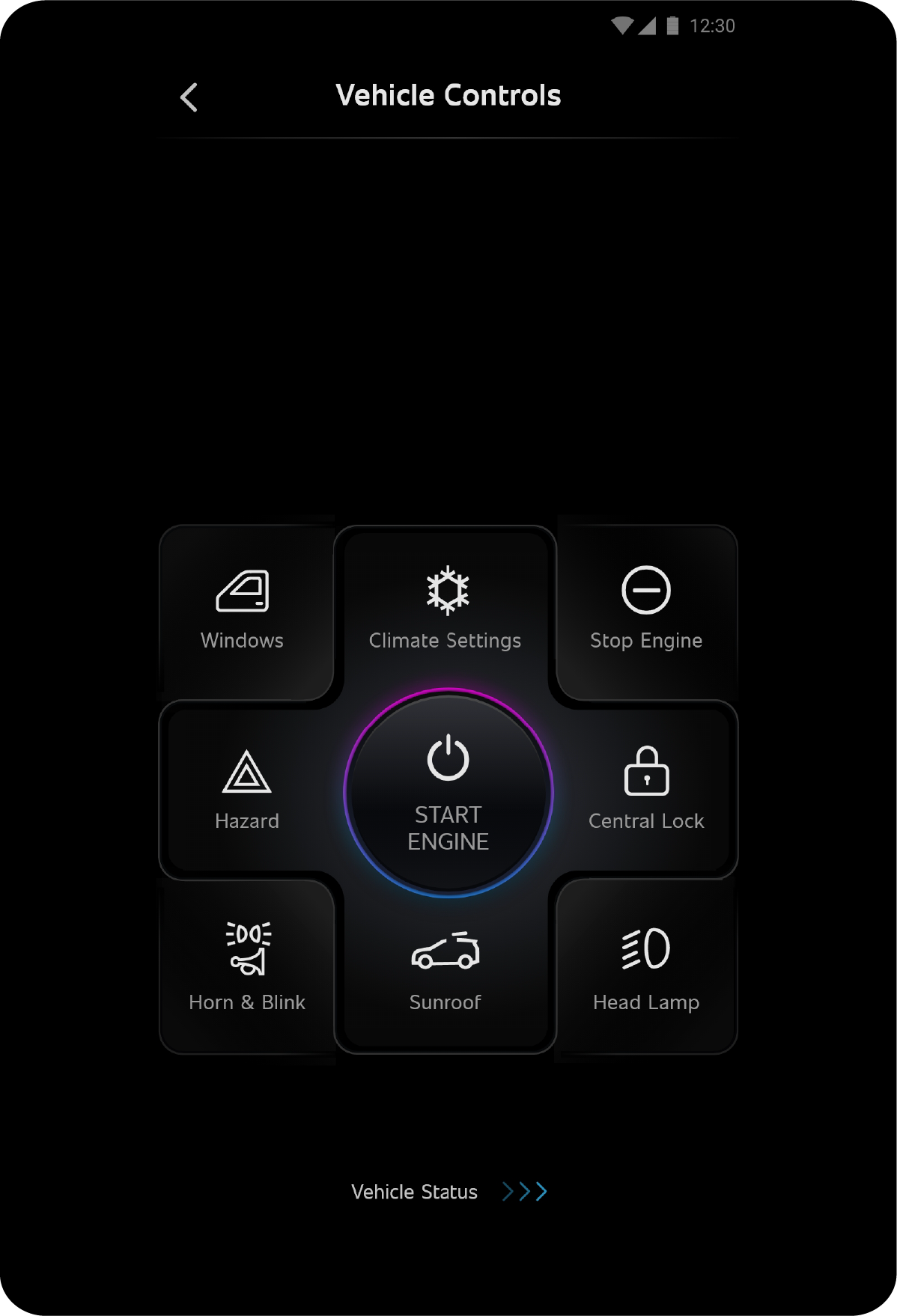
Power Window Smart Open
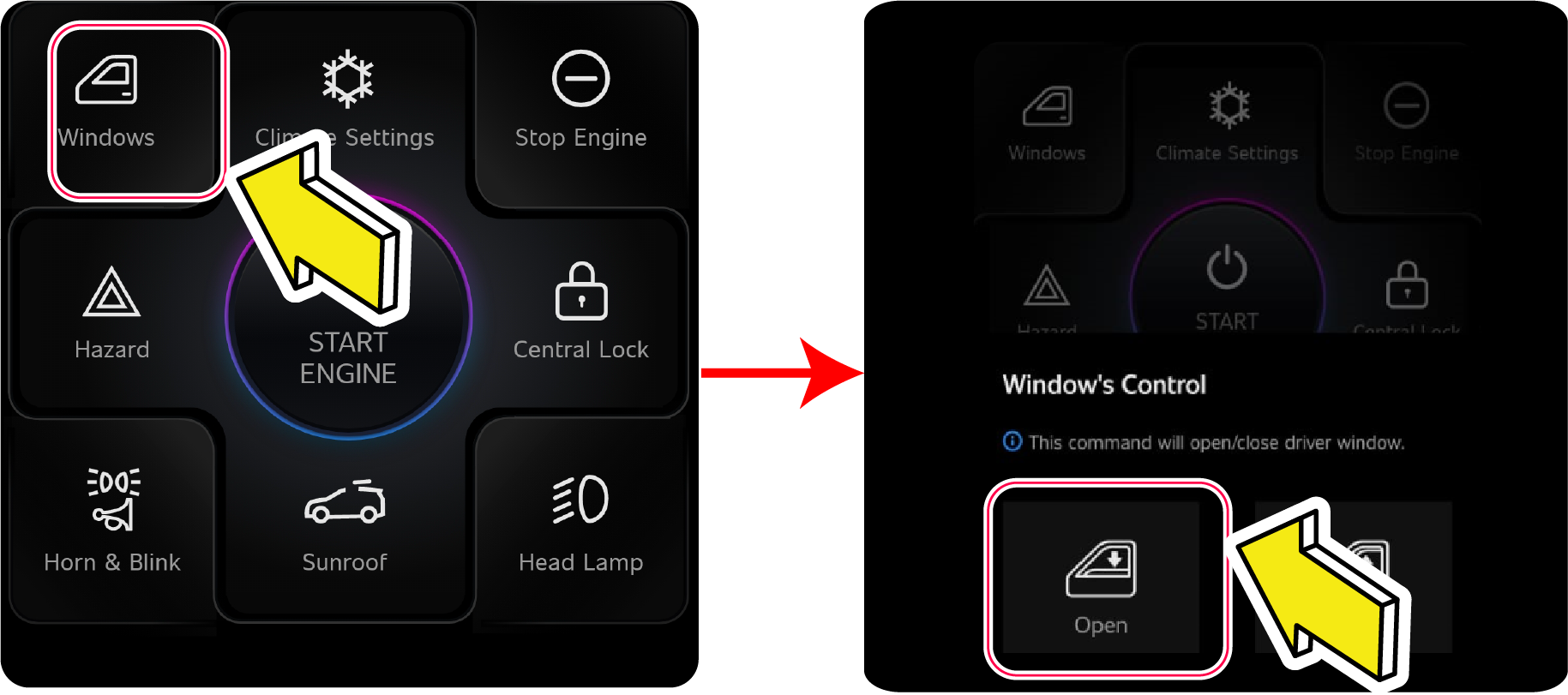
Power Window Smart Close
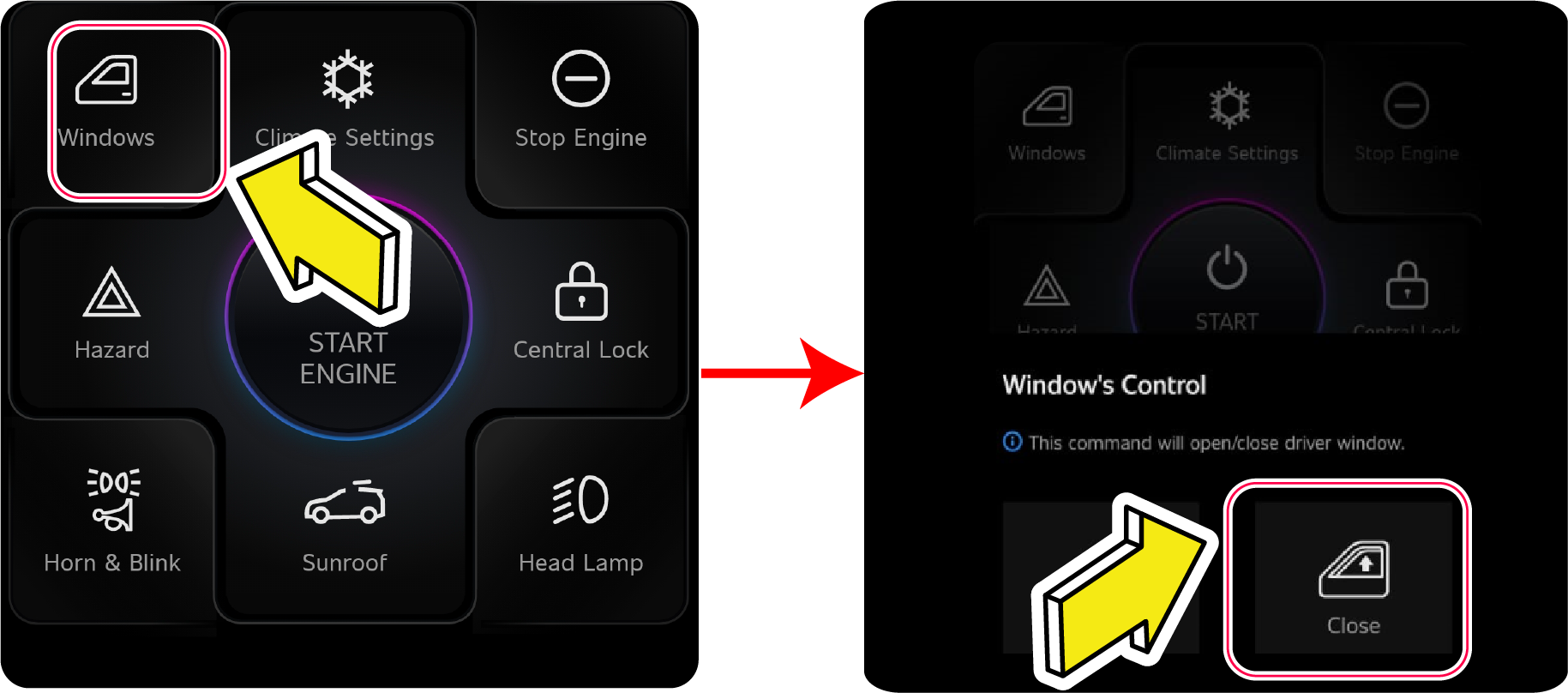
Sunroof Smart Open
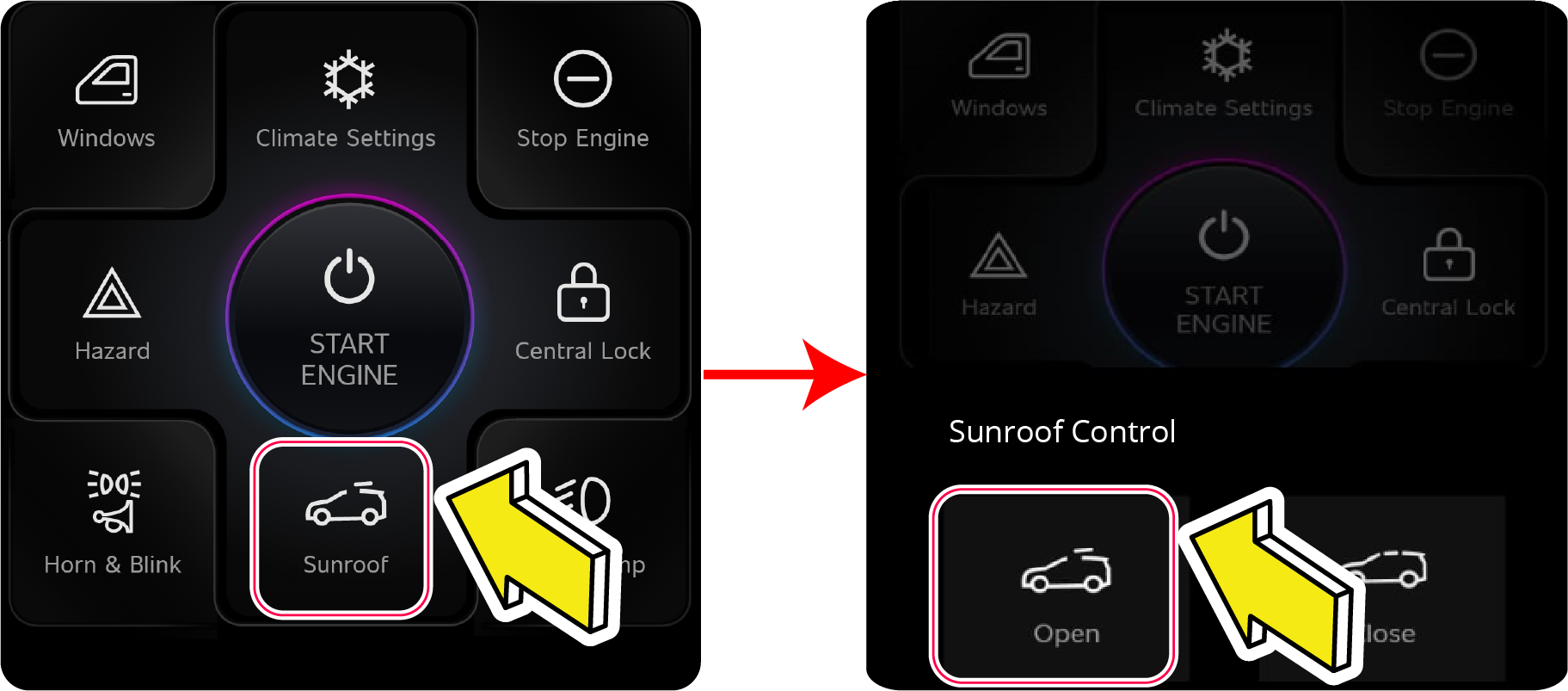
Sunroof Smart Close
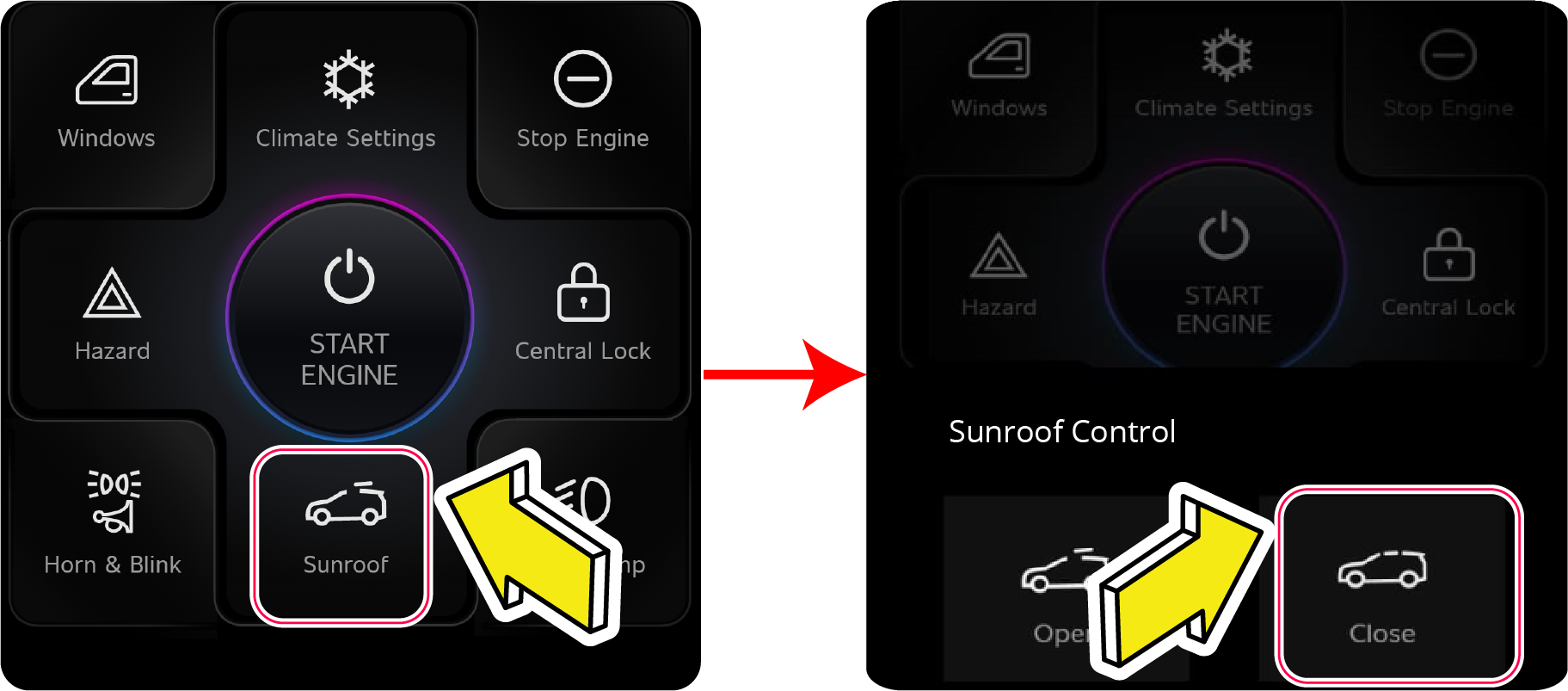
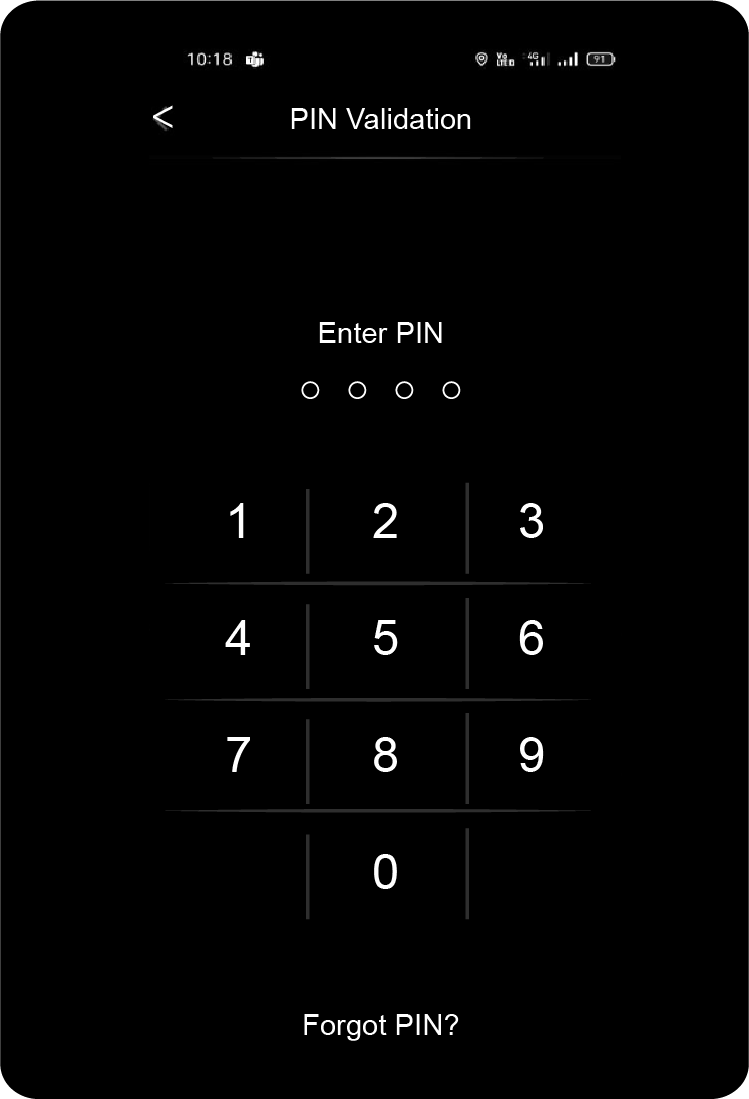
|

User set PIN
will be required to execute AdrenoX commands
|
c). Timer Based
Control
(Applicable only for RLS variants)
Sunroof Smart
Close -
During ignition off, if Sunroof is open for more than a predefined time (for approximately 12
hours),
sunroof will get
closed automatically.
d). Rain detection
based control
(Applicable only for RLS variants)
Sunroof Smart
Close -
During ignition off and doors are in locked condition, If rain is detected sunroof will be
automatically closed.
7.2.2 Smart operations in
Ignition
ON State
a). Using Alexa
Voice Command
User can open and close Sunroof via voice command
through Alexa during
Ignition ON.
. .Alexa, Open Sunroof ....... .Alexa, Close Sunroof
User can open and close driver side power window via
Voice command
through Alexa during ignition ON (will open/close only
driver side window)
. .Alexa, Open Windows....... .Alexa, Close Windows
b). While Wiper is
ON
Sunroof & Power Window
Smart
Close- During ignition ON condition, if front
wiper is ON for approximately around 10 seconds (varies based on wiper modes), a
notification
requesting user confirmation for closing the Power Window & Sunroof will be displayed.
On
confirming the same, both will be
closed.

7.3 Heating, Ventilation And
Air-Conditioning System (HVAC)
HVAC system provided in the vehicle enables occupants to
automatically/manually adjust air flow distribution pattern, air
flow rate, air intake mode and air temperature inside passenger compartment.
By appropriately adjusting the control knobs/switches
provided on the
DATC/ETC control panel, located on center console, occupant’s
comfort can be ensured.
HVAC system also helps in defogging / de-misting the windshield and
windows. Air flow direction can be further controlled
by adjusting louvres of air vents. An air filter is provided at the outlet of HVAC blower and before
cooling coil.
Engine coolant is utilized to heat the cabin air. For cooling the
cabin
air, an air conditioning circuit based on the vapor
compression refrigeration cycle is used. The air conditioning system uses a refrigerant along with a
suitable lubricating
oil.
Although being non-ozone depleting, the refrigerant is a greenhouse
gas,
hence once allowed to escape in the atmosphere, it
adversely affects the environment by contributing to global warming/climate change

Refrigerant used in
system
is a hazardous liquefied gas and is under high pressure.
The refrigerant is
colorless and has ethereal or faint sweetish odor. Exposure of refrigerant to skin or eyes
may cause irritation
and frostbite.
They can also cause
suffocation, dizziness and loss of concentration. When mixed with compressed air or
certain
other refrigerants,
it may form flammable mixture. Never try to service HVAC system yourself which would
involve
refrigerant handling.

- If you sleep while
operating the air conditioner or heater with all the windows closed, You may suffocate to
death due to
lack of ventilation. When you operate the air conditioner or heater, ventilate
frequently.
Multiple vents are provided for distributing the air, being
force-circulated by HVAC blower, throughout the passenger compartment.

To ensure sufficient air
flow and hence adequate HVAC system performance, air flow path should be kept free of
obstructions.
Keep system’s air intake, located near plenum appliqué, free of snow, leaves and other
debris. Also keep the area in front
of air vents free of any obstruction inside the cabin.
7.3.1 Air Vents
|
|
Side Vents: The two
side
vents are located one each at the left and right extreme ends of the instrument panel. Both the
side
vents provide
air flow to the front seat passengers.
Centre Vents: Two
center
vents are located on both sides of the infotainment screen in the center console. Both the center
vents provide
air flow to the front seat passengers. Direct air to the desired direction by adjusting the Louvres
left/right.
Defogger Vents: There
are
four defogger vents in your vehicle: two side defogger and two windshield defogger vents.
They are located just below the windshield. The side defogger
vents
prevent the front windows from defogging.
Second Row AC
Unit/AC Vents:
The second row AC unit/AC vents are located on the rear side of the center console based on
the variants.
7.3.2 Electronic Temperature
Control (if equipped)
|
A
|
Temperature control Knob
|
|
B
|
Air distribution/Mode switches
|
|
C
|
Front defogger switch
|
|
D
|
Blower speed control knob
|
|
E
|
Rear Defogger switch
|
|
F
|
Recirculation mode switch
|
|
G
|
A/C switch
|
Temperature Control
Knob
By operating the temperature control knob, temperature of air being
discharged from various vents can be adjusted to the desired
level. Engine coolant is utilized to heat, whereas the air conditioner is used to cool the air
inside
the AC unit. Based upon
selected position of the temperature control knob, the desired discharged air temperature can be
obtained.
By rotating the knob anti-clockwise and setting it to the extreme
left
position, maximum cooling is obtained. When the knob
is rotated clockwise, the discharged air progressively starts getting warmer and at the extreme
right
position, hot air is
discharged.
Blower Speed Control
Knob
The blower force-circulates the air through the HVAC
unit and
distributes it throughout the passenger compartment.
Blower is OFF when the blower speed control knob is set to small
(Blower Symbol) position (extreme left). To switch-ON the
blower, rotate the control knob clockwise which progressively increases the blower speed.
A/C switch
This button turns the air-conditioner ON or OFF.
When the air conditioner is functioning, air gets cooled and
de-humidified before being circulated inside the cabin. In hot
weather conditions, it will take a slightly longer time to cool the interior as compared to cooler
weather. Fuel consumption
will be relatively higher if the vehicle is being driven with the air conditioner ON.

AC will function only when
both
engine and blower are switched ON.
| • | In certain operating conditions when the engine gets overheated, the engine management system may switch off the air conditioner intermittently |
| • | The air conditioner should be operated at least for ten minutes once every fortnight, even during winter months. This allows AC system components to get lubricated periodically and ensures optimum system |
| • | During extreme cold weather conditions, the air conditioner may not function until temperature of the air near the evaporator rises above a predefined threshold |
| • | When air conditioner is ON, moisture is extracted from the air. The resulting condensate is drained off from the vehicle. It is therefore normal, if you see a small pool of water under your vehicle |
Re-circulation Mode
(Re-circulation mode switch ON)
To set the HVAC system to recirculation mode, press the
recirculation
mode button. The LED on the button illuminates, indicating
the recirculation mode is active. In this intake mode, the air from inside the passenger
compartment
will be sucked by the
blower and utilized further to ventilate /cool / heat the cabin.
For quick cabin cooling/heating or while driving through
dusty/polluted region, re-circulation mode can be selected for short
periods. Driving with this mode active, may lead to better fuel economy and longer HVAC filter
life.
However, running the
air conditioner in re-circulation mode for long will make cabin air too dry and oxygen level drops
inside cabin the turning
the air stale. On the contrary, keeping air intake control in recirculation mode for long, with air
conditioner switched OFF,
will make cabin air too humid and windshield and window are more likely to become foggy. Hence,
never
drive in recirculation
mode for long, shift back to fresh air mode intermittently.

Never keep
recirculation mode
selected continuously for long period. Prolonged use of the HVAC system in recirculation mode
may cause windshield/windows to mist/fog-up, impairing visibility which can lead to an
accident,
endangering you and others.
Fresh Air Mode
(Re-Circulation
Mode Switch Off)
To set the HVAC system to fresh air mode, press the re-circulation
mode button again. The LED on this button switches OFF,
indicating that fresh air mode is active. In this intake mode, fresh air from outside the vehicle
is
sucked by the blower
and utilized further to ventilate /cool / heat the cabin.
Air
Distribution/Mode
switches
The air flowing out of various vents can be controlled
by the air
distribution/mode switches.
| • | Face Mode — When face mode switch is pressed, air is discharged from the Center vents and side vents. This mode is most suitable for directing air flow towards the face of the passengers |
| • | Face-Foot Mode — When Face-Foot mode switch is pressed, air is discharged from the Center vents, Foot vents and side vents. This mode is most suitable for directing air flow towards both the face and feet of passengers at the same time |
| • | Foot Mode — When foot mode switch is pressed, air is discharged from the two foot vents. This mode is most suitable for directing air flow towards the feet of passengers seated on front seats |
| • | Foot and Front Defogger Mode — When foot and front defogger mode switch is pressed air is discharged from the foot vents, side defogger vents and windshield defogger vents. This mode is most suitable for directing air flow towards the feet of passengers while de-misting/defogging. |
| • | Front Defogger Mode — When Front Defogger mode switch is pressed air is discharged from the side defogger vents and windshield defogger vents. This mode is most suitable for directing air flow towards the front windshield to ensure de-misting / defogging. |
Rear Defogger Switch
(If equipped)
Rear defogger switch is located on the ETC control panel. Press the
switch once to activate the rear defogger. The LED on
the switch illuminates upon activation and the rear defogger heats the rear windshield clearing the
fog / mist. Switch OFF
the rear defogger by pressing the switch once as soon as the fog / mist is cleared.
If the rear defogger switch is not switched OFF manually, it will
turn
OFF automatically after a pre-defined time, based on
ambient temperature. If you want to switch the rear defogger ON again, press the rear defogger
switch
again.
On second and subsequent activations of the rear defogger in the
same
ignition cycle, the rear defogger ON time will be half
the duration of the first activation.
7.3.3 Dual Automatic
Temperature
Control (if equipped)
|
A
|
Co–Driver Temp control Knob
|
G
|
Driver temp control knob
|
|
B
|
Front defogger switch
|
H
|
A/C ON Switch
|
|
C
|
Rear Defogger switch
|
I
|
OFF switch
|
|
D
|
Blower speed control Switches
|
J
|
MAX A/C Switch
|
|
E
|
Auto Mode Switch
|
K
|
Mode Switch
|
|
F
|
Recirculation Mode Switch
|
L
|
Dual mode switch
|
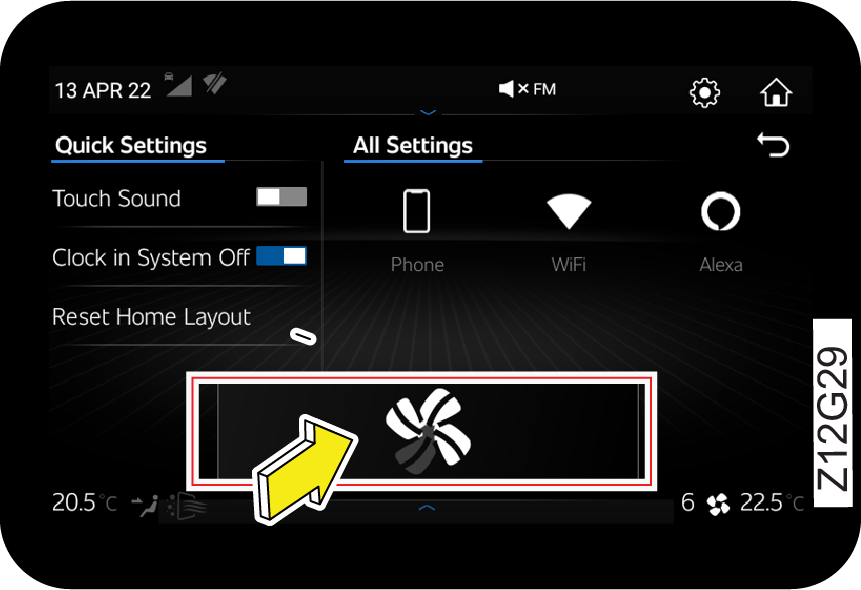
|
Below mentioned switches/knobs in DATC control panel
is
pressed/Rotated, respective icons and changes are displayed in the
infotainment screen.
|
Blower speed control switches
You can adjust the airflow by Pressing the Blower speed control
switches with ignition ON. If you adjust the airflow using
blower speed control switches in AUTO mode, the AUTO indicator on Infotainment screen goes off and
the
operation mode is changed
to the manual mode.
Blower speed can be increased by pressing the blower speed '+'
switch
and blower speed can be decreased by pressing the blower
speed '-' switch.

The air conditioner does not operate by directly pressing the
blower speed control switches if the A/C switch is not pressed.
However, the air flows due to the fan operation.
AUTO switch
If you press the AUTO switch with AC ON, AUTO indicator appears on
Infotainment screen and the set temperature is maintained
while the airflow and air distribution are automatically controlled.
The indicator lamp lights up while AUTO switch is
operating, and the
lamp turns off when press the other switches to turned
OFF.
Front Defogger
switch
Use this switch for quick defogging with the engine ON.
When you press this switch, its indicator lamp turns ON, and the
airflow direction is changed to the windshield and door glasses
while outside air comes in with A/C operation.
At this time A/C, front defogger and Fresh air indicators shows up
in
the Infotainment screen. If you press the switch again,
front defogging stops with the indicator lamp turns off and the mode returns to the previous
operation. While the front defogger
switch is operating, its indicator lamp turns ON and the lamp turns off when the front defogger
mode
switch is turned ON.
OFF switch
You can turn off the Dual automatic Temperature
controller (DATC) by
using this switch.
Co–Driver
temperature control
knob
To adjust the co-driver
side temperature as desired, rotate the co-driver temperature control knob while the AC is
ON. The
temperature decreases, when the co-driver temperature control knob is rotated in
anticlockwise direction & Temperature increases,
when the co-driver temperature control knob is rotated in clockwise
direction.
The co-driver
set
temperature is visible on the infotainment screen

When co-driver temperature knob is rotated, Dual mode
automatically
Turns ON.
When the DUAL mode switch is turned off, the passenger temperature returns to the driver side set temperature.
When the DUAL mode switch is turned off, the passenger temperature returns to the driver side set temperature.
Recirculation mode switch
If you press this switch with AC ON, the indication lamp lights
turn
up and the air recirculation indicator on Infotainment
display is displayed. If you press this switch again, the indication lamp turns off and the air
source
selection is changed
to Fresh air intake mode.

Do not use
recirculation
mode in the vehicle for extended periods of time with every window closed. Doing so can
cause headache,
drowsiness and fogged window due to lack of oxygen
If exhaust gas comes
in,
there is a danger of carbon monoxide poisoning. Set to the fresh air intake mode after
passing through
a dusty or polluted area with air recirculation mode in operation.
Automatic selection
of the fresh
or air circulation mode
When the front defogger switch is pressed, outside air
automatically
comes in. When the switch is pressed again, the previous
mode is restored.
DUAL switch
This function allows controlling the Co-Driver side
temperature
separately with engine ON.
| • | If you press the DUAL mode switch, the indicator lamp lights up and DUAL mode indicator on the infotainment displays comes on |
| • | When the driver temperature control knob is rotated, the driver side temperature on the infotainment display is adjusted as desired and when co-driver temperature control knob is rotated, co-driver side temperature on the infotainment display is adjusted as desired |
| • | While the DUAL mode switch is operating, its indicator lamp turns ON and the lamp turns off when the DUAL mode switch is turned OFF. |

When the DUAL mode switch is turned off, the passenger
temperature
returns to the driver side set temperature.
Mode switch
Each time you press this switch with IGN ON, the air distribution
mode
is changed and displayed as shown in the figure below.
When you press this switch in AUTO mode (AUTO indicator ON), the system is changed to the semi-auto mode (AUTO indicator OFF).
When you press this switch in AUTO mode (AUTO indicator ON), the system is changed to the semi-auto mode (AUTO indicator OFF).
|
|
Face-Mode
|
|
Foot-Mode
|
|
|
Face/Foot-Mode
|
|
Foot/Defogger-Mode
|

When choosing foot mode,
some
air flows out from windshield defogger vents , Side defogger vents and side vents.
Driver temperature
control knob
To adjust the temperature as desired, rotate the driver side
temperature control knob. The temperature decreases, when the
driver temperature control knob is rotated in anti-clockwise direction & temperature increases,
when the driver temperature
control knob is rotated in clockwise direction
A/C Switch
This button turns the
air-conditioner ON or OFF.
MAX A/C switch
MAX AC mode can be used to attain MAX cooling in a short
period of
time.
When MAX AC switch is pressed
| 1. | In cabin temperature is set to minimum |
| 2. | Blower fan speed is set to Max |
| 3. | Air intake mode is set to recirculation mode |
| 4. | Air distribution mode is set to Face mode |
Rear Defogger Switch
Rear defogger switch is located on the DATC control panel. Press
the
switch once to activate the rear defogger. The LED on
the switch illuminates upon activation and the rear defogger heats the rear windshield clearing the
fog / mist. Switch OFF
the rear defogger by pressing the switch once as soon as the fog / mist is cleared.
If the rear defogger switch is not switched OFF manually, it will
turn
OFF automatically after a pre-defined time, based on
ambient temperature. If you want to switch the rear defogger ON again, press the rear defogger
switch
again.
On second and subsequent activations of the rear
defogger in the same
ignition cycle, the rear defogger ON time will be half
the duration of the first activation.
7.3.4 DATC – Auto Operation Mode
|
1
|
Co–driver Temp Control Knob
|
|
2
|
Auto Indicator ON
|
|
3
|
Driver Temp Control Knob
|
Use only when the engine is running.
| 1. | Press the AUTO switch. |
| 2. | AUTO indicator is displayed on the Infotainment Screen. |
| 3. | Set the desired cabin temperature with the temperature control knob. |
| 4. | The temperature of the passenger compartment is automatically maintained according to the set temperature. |
| 5. | If the driver and co-driver require different temperatures in their respective zones, the same can be done by pressing the dual mode Switch and subsequently, setting different temperatures using temperature control. |
When you use the blower speed control switches, mode switch (air
source selection switch) or defogger switch during the auto
operation mode, AUTO indicator on the display goes out
and
the air conditioner system can be controlled manually.
7.3.5 DATC – Manual Operation
Mode
|
1
|
Co–driver Temp Control Knob
|
4
|
Recirculation Mode Switch
|
|
2
|
Mode Switch
|
5
|
Driver Temp Control Knob
|
|
3
|
Blower Control Speed Switch
|
||
Use only when the engine is running.
| 1. | Press AC ON switch |
| 2. | Set the desired temperature by rotating the temperature control knob |
| 3. | Adjust the blower speed by pressing the blower speed control switches |
| 4. | Select the air flow by pressing the air distribution/mode switch |
| 5. | Select the air source mode by pressing recirculation mode switch |
In manual mode, the AUTO indicator on display does not come on and
you
can manually adjust the climate conditions by controlling
the temperature, blower speed, mode (air distribution), A/C, air source selection, and DUAL temp.
selection control switches.

To activate the auto operation mode, press AUTO switch.
7.3.6 DATC – Climate Control
Through Infotainment Screen
Climate Control Setting also can be done through infotainment
screen.
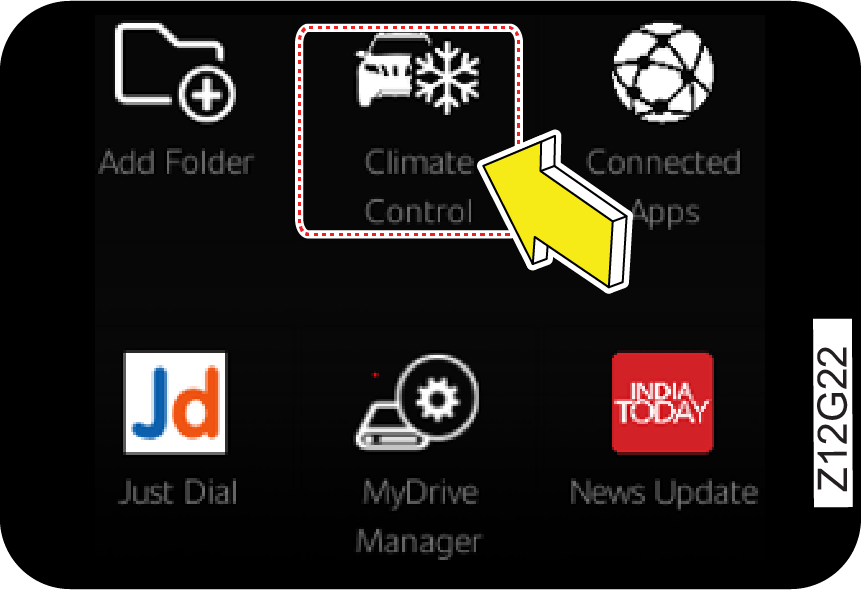
|
|
| • | Under Climate control screen select Climate icon |
| • | All HVAC setting can be changed by pressing respective symbols or buttons in climate screen |
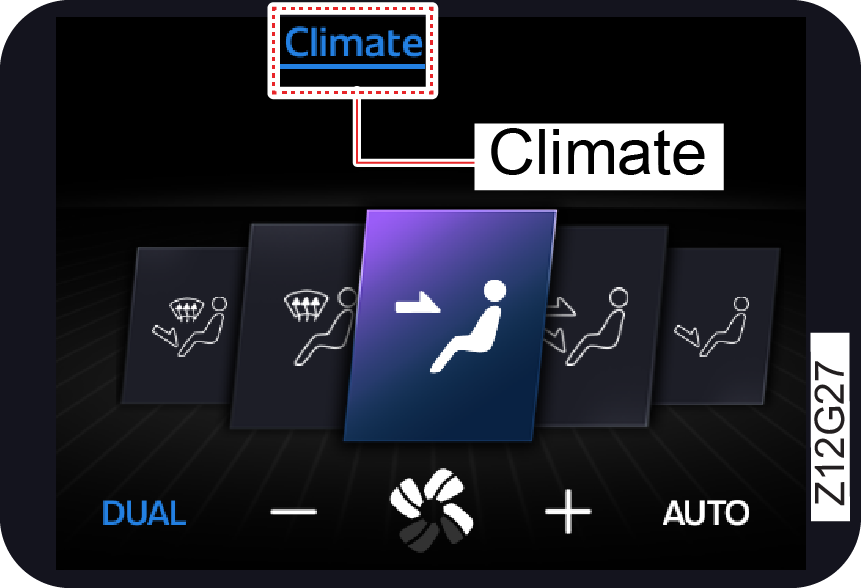
|
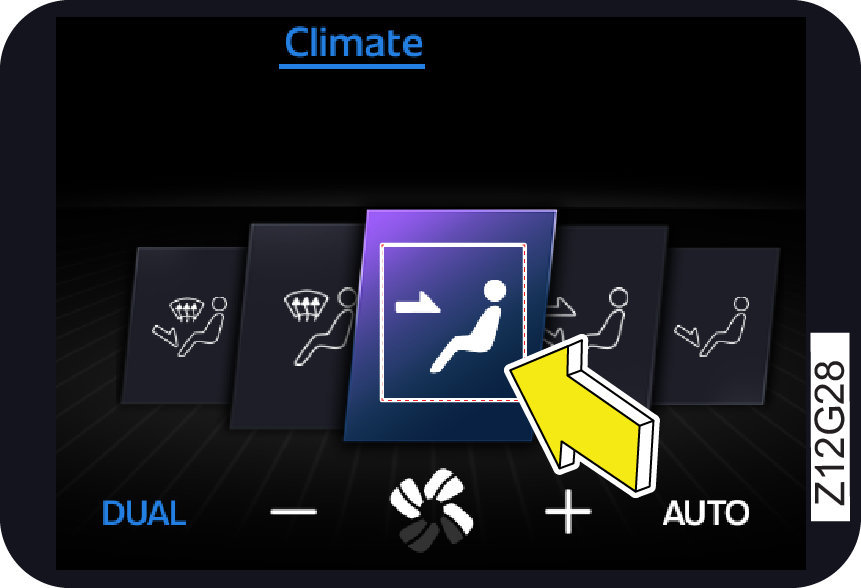
|
7.3.7 Remote Cooling
|
|
Remote cooling feature allows user to control Cabin
climate settings from outside the vehicle.
|
Activate Remote Cooling
feature
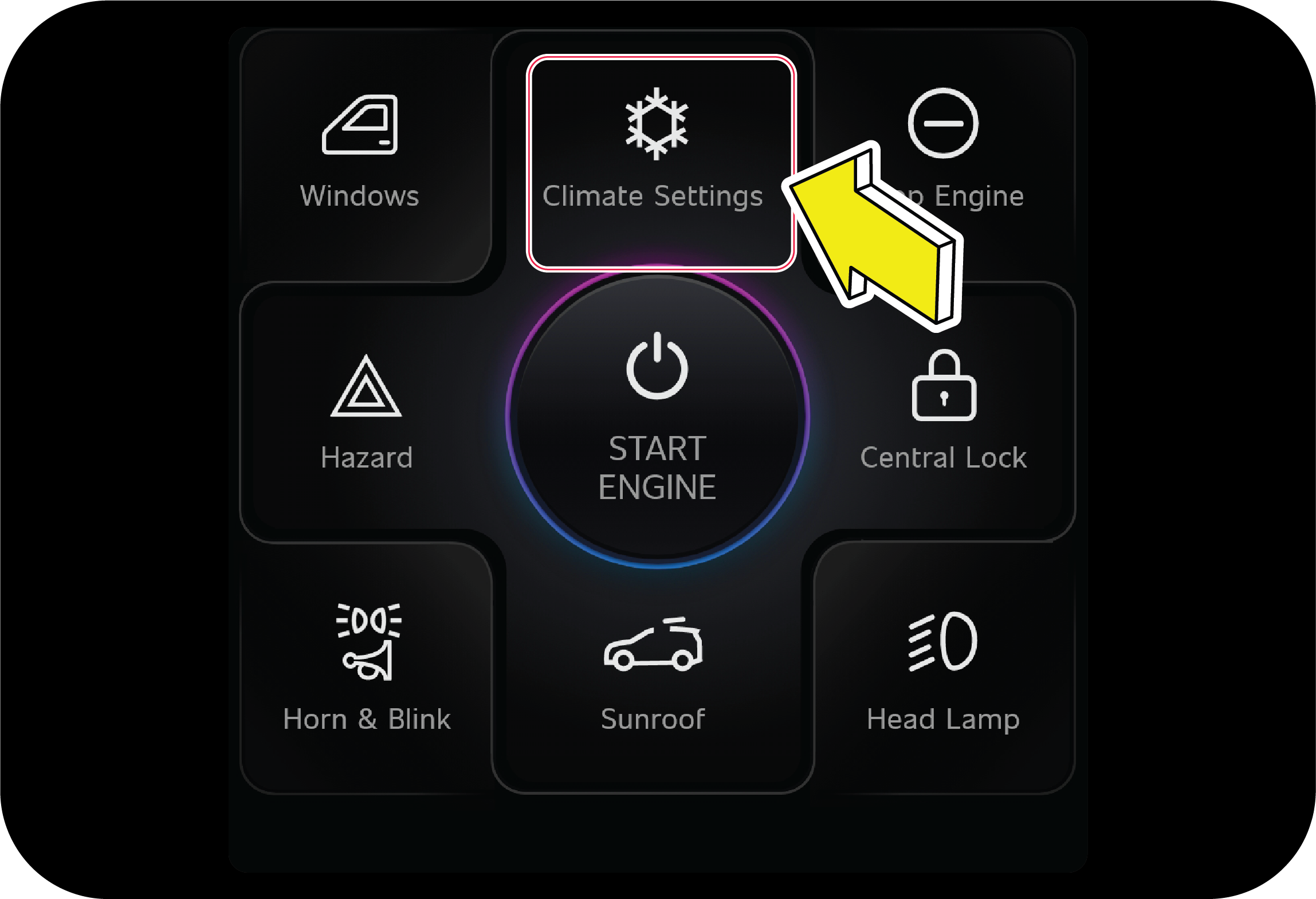
|
Remote cooling starts by automatically once we press
"start engine" button in the AdrenoX Connect mobile App
|
In Automatic
transmission
vehicle
| • | All Doors closed |
| • | Gear is in PARK position |
| • | Fuel level is greater than 10 liters |
| • | Vehicle should be in Standstill |
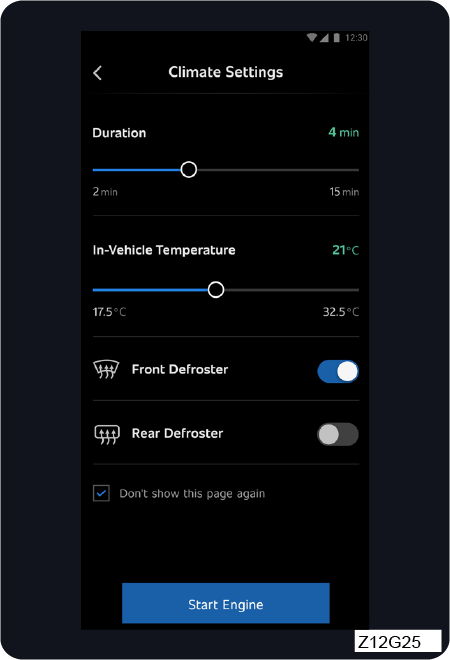
|
When vehicle is started remotely using AdrenoX
connect
mobile App, By default Cabin climate settings will be changed to 18
deg C in Auto mode.
In remote Engine start condition user will have
access
to control below Cabin climate setting under Climate settings
|
| 1. | Duration time : User can select the time duration for which remote cooling will be active using AdrenoX connect mobile App, Duration can be selected from minimum of 2 mins to maximum of 15 mins. |
| 2. | Cabin Temperature settings: User can change temperature settings during Remote cooling |
| 3. | Front defrost: User can Activate /De-activate front defrost during remote cooling by selecting front defrost option in mobile app |
| 4. | Rear Defrost: User can Activate /De-activate Rear defrost during remote cooling by selecting Rear defrost option in AdrenoX connect mobile App, |
Once vehicle is started remotely customer will get
feedback in the AdrenoX connect mobile App,
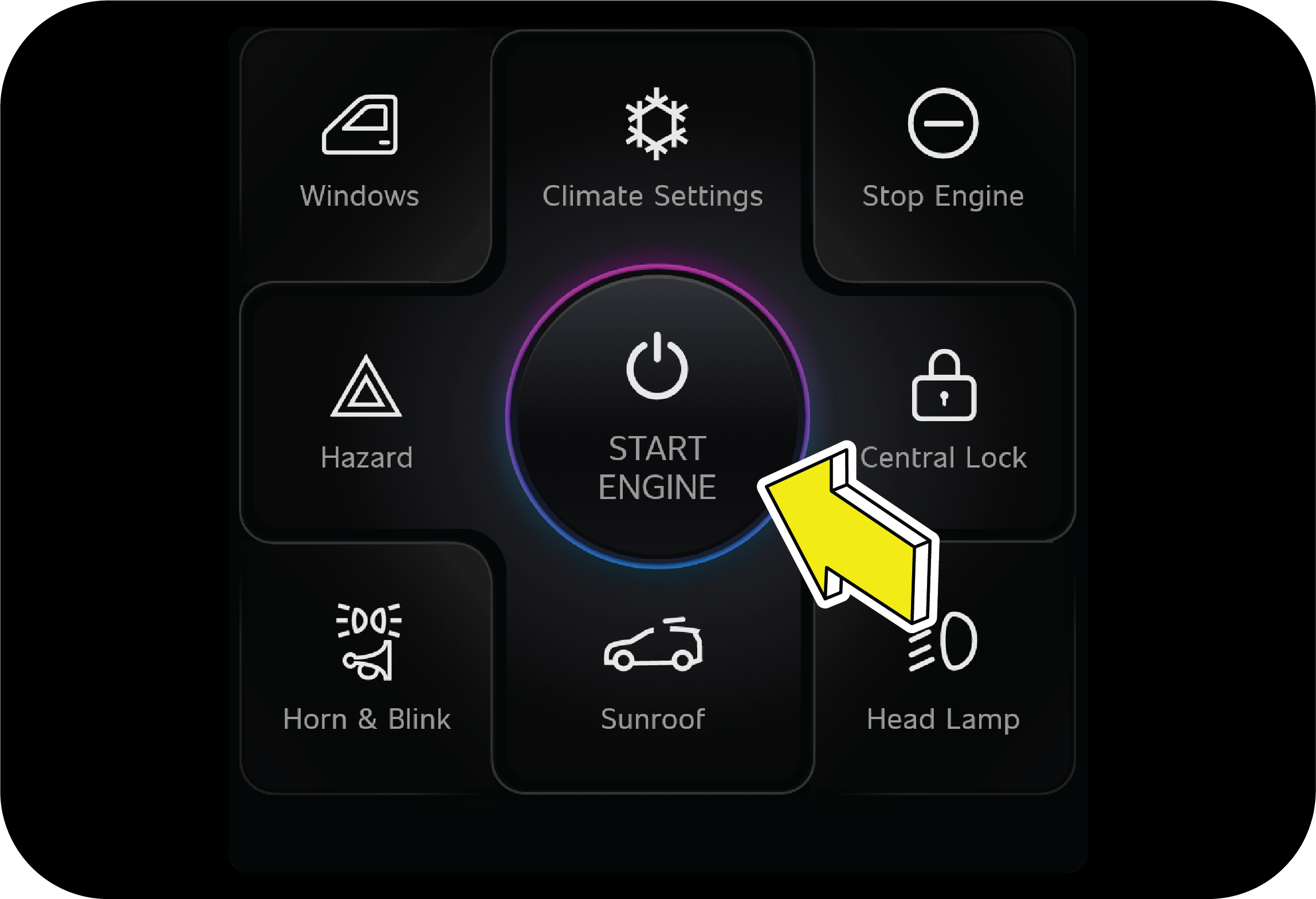
|
Remote cooling can be De-activated by using Mobile
App.
if vehicle is already in Remote start condition by Pressing start
engine button, Remote cooling will be deactivated.
In Mobile App customer will get notification if
Remote
cooling is failed.
|
Remote cooling operation is suggested to be used while vehicle is
parked in open sunny area for long duration. It is recommended
not to operate Remote cooling when vehicle is parked in a closed environment.
7.3.8 Rear AC Control
Second Row Blower
Speed
Control
Rear blower speed control knob is provided below the second row
center
console. Individual blower speed provided to make the
comfort for second row and third-row passengers.

The second row AC is
switched
ON by the Rear AC button on the DATC/ETC Control panel . The airflow is controlled by the
rear
AC blower speed control knob on the second row RH side trim.
7.3.9 Rapid Cabin Cooling
Rapid Cabin Cooling
In DATC
For rapid cooling of the cabin, the following AC
settings are
recommended:
| • | Make sure that all the windows are fully closed |
| • | Fully open the vents and adjust Louvres to direct air toward face |
| • | Turn ON AC |
| • | Press MAX AC Switch |
Rapid Cabin Cooling
In ETC
For rapid cooling of the cabin, the following AC
settings are recommended:
| • | Make sure that all the windows are fully closed |
| • | Set the blower to maximum speed |
| • | Fully open the vents and adjust Louvres to direct air toward face |
| • | Set the air distribution control to face mode |
| • | Set air intake control to recirculation mode |
| • | Turn the air conditioner ON |
| • | Set the temperature control knob to extreme left (coolest) position |
For faster cabin cooling, you can select re-circulated air intake
mode
initially. Once passenger compartment reaches a comfortable
temperature, shift to fresh air mode. Also blower speed and temperature control knob can be
re-adjusted as desired.

If your vehicle was
parked in the hot sun with all the windows closed, drive the vehicle with windows open
for
the first few
minutes. This will help in venting the hot interior air out and allow the air
conditioner
to cool the cabin quickly. In case
you are leaving the vehicle parked in sun frequently then activate the Active Cooling
Option.
7.3.10 Rapid Cabin Heating
For rapid heating of the cabin, the following AC
settings are
recommended:
| 1. | Make sure that all the windows are fully closed. |
| 2. | Set the blower to maximum speed. |
| 3. | Set the air distribution control to foot mode. |
| 4. | Set air intake control to recirculation mode. |
| 5. | Set the temperature control knob to extreme right (hot) position. |
| 6. | For de-humidified heating, switch the air conditioner ON. So on rainy conditions if the heater is ON then also keep the AC ON. |
For faster cabin heating, you can select re-circulated air intake
mode
initially. Once passenger compartment reaches a comfortable
temperature, blower speed and temperature control knob can be re-adjusted as desired.

In extreme cold
weather
conditions, the engine coolant takes time to get heated up. Hence, it might take a
while
for hot air
discharge, even when blower is running and temperature control dial is set to hot
position.
7.3.11 Points to Remember
| • | For quickly defogging/de-misting outside of front windshield, it is advisable to operate the windshield wiper/washer for few times intermittently |
| • | If snow has deposited on windshield, use ice scraper to remove ice deposited before using wiper |
| • | In freezing weather, warm the front windshield with the defogger before using the windshield washer. Also use a washer fluid having anti-freezing properties. These will help prevent the washer fluid from freezing on your windshield |
| • | Dirty/contaminated windshield would make misting / fogging-up worse. Always keep the inside and outside of windshield clean |
| • | Reduced air flow because of clogged HVAC filter or any other obstructions in air flow path may lead to inadequate defogging/de-misting performance. If air flow seems to have considerably reduced, get the filter cleaned or replaced immediately. Air flow path should be kept free of obstructions |
| • | Reduced cooling performance from air conditioner may lead to inadequate defogging/de-misting. If cooling effect seems to have dropped considerably, get the air conditioning system checked by an Mahindra Authorised Dealer |

Your vehicle is
equipped
with a HVAC filter. If the AC performance is considerably low, it is recommended to
have
the HVAC
filter checked at the nearest Mahindra Authorised Dealer.
Keep in mind that a
choked filter will also lead to poor cooling.

Never operate HVAC
system with the filter removed. This may result in premature failure of system
components.
8 STARTING AND DRIVING 1
8.1 Safety
Tips - Before Starting Your Vehicle
Before starting the
vehicle, inspect the interior and exterior of the vehicle; for any damages, leaks, loose
parts, foreign
objects/debris. In case of any abnormality noticed, Contact Mahindra Authorised
Dealer.
Before starting your
journey, check and ensure proper functioning of safety devices/components like brake
system,
steering
system, all lamps & tyres. Also ensure no critical warning lamps are ON in the
cluster.
In case of any safety device/component
not functioning as intended or any critical warning lamps found ON in cluster, contact
Authorised Mahindra service center
and get it rectified before starting the journey.
Adjust the seat
headrest,
steering wheel and fasten the seat belt as described in this manual. Never perform any
seat /
steering
adjustments when the vehicle is in motion. Start the vehicle only when seated and belted
in
the driver's seat

Engine idle speed is
controlled by engine management system. When the engine starts, idle RPM runs higher
than
normal in
order to warm the engine. The engine idle speed RPM reduces once the engine warms
up.

Never start your
vehicle
in a closed garage or in an enclosed area. Exhaust fumes can be toxic. Always keep the
garage door
open or start the engine in an open area.
Mirror
Adjustment: Ensure
that the rear view mirror and both the ORVM’s are adjusted for an unobstructed view of the road
behind.
Exterior Lamps: With the
help of someone observe and confirm normal operation of all exterior lamps while you work on the
controls from the
driver seat. Also, check functioning of all lamps in the instrument panel.
Door Latches:
Check for
positive closing, latching, and locking of all doors, both from inside and outside.
Fluid Leaks: Check the
area
under the vehicle after an overnight parking for fuel, power steering fluid, brake fluid, engine
coolant, oil,
or other fluid leaks. If leaks are observed contact Authorised Mahindra Dealer.
8.2 Starting the Engine
Make sure all vehicle
occupants are properly seated in their seats and have buckled their safety belts. For more
information
on seat, headrest positioning, safety belts and their proper usage, refer “Seat Belts”
section.

Before cranking the
engine
| • | Make sure the gear shift lever is in Neutral/Park mode |
| • | Ensure that the parking brake is engaged. Turn the key to IGN position but do not turn the key to start |
Automatic
Transmission-AT
| 1. | Turn the ignition ON by pressing the start stop button or through ignition key |
| 2. | Shift the gear shift lever to Park or Neutral position, if found in any other position |
| 3. | Apply parking brake, if found not applied |
| 4. | Do not press the accelerator |
| 5. | Depress the brake pedal and press the start stop button or Turn the key momentarily to the START position to crank the engine |
| 6. | Once the engine starts, release the Start Stop Button or key. |
Manual
Transmission-MT
| 1. | Turn the ignition ON by pressing the start stop button or through ignition key |
| 2. | Shift the gear shift lever to neutral position. if found in any other position |
| 3. | Apply parking brake, if found not applied |
| 4. | Do not press the accelerator. |
| 5. | Depress the clutch pedal and press the start stop button or Turn the key momentarily to the START position to crank the engine |
| 6. | Once the engine starts, release the Start Stop Button or key |

Do not continue cranking
after
the engine has started.
If the engine fails to start, attempt to restart after about 10
seconds. If the engine fails to start even after repeated
attempts as per the procedure given above, contact the nearest Mahindra Authorised Dealer.
To prevent damage to the
starter, wait 10 seconds before attempting to restart the engine.

If the vehicle battery has
discharged, use booster cables, a booster battery or a battery from another vehicle to start.
Jump-starting
a vehicle can be dangerous if done improperly. Refer to the “Jump-starting procedure” section
in
this manual for correct procedure.
If the engine still fails to start, contact an Mahindra
Authorised
Dealer for assistance.
Ensure the following when the engine is running:
| • | All warning lamps are OFF |
| • | Low oil pressure lamp is OFF |
Engine Idling: The idle
speed is controlled automatically, and it will decrease as the engine warms up.
After idling for a few seconds, follow the below steps to drive away:
After idling for a few seconds, follow the below steps to drive away:
Manual
Transmission-MT
| 1. | Release the parking brake |
| 2. | Depress the clutch |
| 3. | Shift the gear lever to 1st gear |
| 4. | Release the brake pedal |
| 5. | Drive by releasing the clutch and depressing the accelerator pedal simultaneously |
Automatic
Transmission-AT
| 1. | Release the parking brake |
| 2. | Depress the Brake pedal |
| 3. | Shift the gear lever to D or R or M |
| 4. | Drive by releasing the brake pedal and depressing the accelerator pedal simultaneously |
Engine Idling - In Cold
Weather: Avoid full throttle operation when
the
engine is cold and prolonged idling at low ambient temperatures. Long periods of idling
is harmful to engine. Combustion chamber temperatures can drop to low temperatures, where
the
fuel injected may not burn completely.
Incomplete combustion allows carbon and varnish to form on piston rings and injector
nozzles.
Also, the unburned fuel can
enter the crankcase, diluting the oil and causing rapid wear to the engine.
For smooth functioning and reliable operation of the engine during cold weather conditions, use suitable fuel (Petrol/Diesel) which will be available at filling stations during winter months. Check with your fuel retailer for details.
Coolant in the radiator will survive up to ambient temperature of -15 degree C. If the ambient temperature is expected go below -15 degree C, during operation, the engine will require a different coolant/coolant concentration. Contact a Mahindra Authorised Dealer for assistance.
For smooth functioning and reliable operation of the engine during cold weather conditions, use suitable fuel (Petrol/Diesel) which will be available at filling stations during winter months. Check with your fuel retailer for details.
Coolant in the radiator will survive up to ambient temperature of -15 degree C. If the ambient temperature is expected go below -15 degree C, during operation, the engine will require a different coolant/coolant concentration. Contact a Mahindra Authorised Dealer for assistance.
8.3 Stopping the Engine
Your vehicle is powered by a turbo engine. Before turning the
engine
OFF, always allow the engine to return to normal idle
speed and run for few seconds. This assures proper cooling and lubrication of the turbocharger.
This
is particularly necessary
after any hard driving.

To reduce the risk of personal injury, before turning OFF the
engine and leaving the vehicle, always follow the below mentioned
safety tips.
Manual
Transmission-MT
| • | Keep your right foot on the brake pedal |
| • | Turn front wheels towards the road curb |
| • | Switch OFF the ignition, turn the key to the steering lock position and remove the key |
| • | Press the start stop button once to switch off the vehicle (for PKE only) |
| • | Engage the parking brake |
| • | Move the gear shift lever to 1st gear position (reverse gear if parking on an incline). |
| • | Slowly release the brake pedal |
| • | Lock your vehicle when leaving |
Automatic
Transmission
| • | Keep your right foot on the service brake pedal |
| • | Turn front wheels towards the road curb |
| • | Engage the parking brake |
| • | Shift the gear lever to Park “P” position |
| • | Switch OFF the ignition, turn the key to the steering lock position and remove the key |
| • | Press the start stop button once to switch off the vehicle (for PKE only) |
| • | Slowly release the brake pedal |
| • | Lock your vehicle when leaving |

Alert will be
displayed
in the infotainment screen if the gear shifter is not in P position. Engine will not
switch off unless
shifter is in P position.
8.4 Exhaust Gases
Protection against exhaust gas entry into the vehicles
interior is
considered in the design of the exhaust system.
| • | Vehicle exhaust contains Carbon Monoxide, Carbon Dioxide, Nitrogen Oxides, Hydrocarbons and Particulate Matter. These are potential environmental and health hazards |
| • | Avoid inhaling the exhaust gases. Carbon Monoxide is a colorless and odorless gas and can cause unconsciousness or even death |
| • | If the exhaust system is damaged for any reason or you notice a change in the exhaust noise, have the vehicle checked by an Mahindra Authorised Dealer immediately |
| • | Do not start the vehicle in a closed garage or in an enclosed area where ventilation is poor for the exhaust gases |
| • | Since the engine compartment and exhaust system components are hot and can ignite a fire, do not park or leave the vehicle with the engine idling over dry grass, leaves, paper, rags or any combustible material |

Never keep the engine
running
when the vehicle is parked in an area which is not properly ventilated. This could lead to
serious
respiratory problems and/or death
8.5 Driving Your Vehicle
8.5.1 Pedals
|
MT
|
AT
|
|
|
|
|
A: Accelerator Pedal
|
B: Brake Pedal
|
C: Clutch Pedal
|
8.5.2 General Driving
Precautions

Always observe the
following
precautions to minimize the risk of accidents leading to serious personal injury or damage
to
your vehicle.
| • | Before you drive your vehicle, please read this manual carefully |
| • | Before you start driving, check proper operation of the brakes and steering system |
| • | If, while driving, you hear any strange noise or feel unusual vibration, or if you have any concerns whatsoever, or if any warning lamps illuminate or buzzers sound, park/stop the vehicle in a safe location as soon as possible. Identify the cause and take any necessary remedial action. Contact your Mahindra Authorised Dealer if necessary |
| • | Never overload or improperly load your vehicle |
| • | Always be attentive while driving and follow safe driving practices |
| • | Always maintain the recommended inflation pressure in tyres |
| • | Always drive at a safe speed appropriate for given driving conditions. You must follow the speed limits |
| • | While backing up, keep a constant lookout for people, particularly children, or other obstructions or hazardous material that might be present behind the vehicle |
| • | Avoid loading any items on the roof that will raise the vehicles center of gravity and make your vehicle more unstable |
| • | Loaded vehicles, with a higher center of gravity, may handle differently than unloaded vehicles. Extra precautions, such as slower speeds and increased stopping distance, should be taken when driving a heavily loaded vehicle |
| • | Always slowdown in gusty crosswinds. Because of its profile and higher center of gravity, your vehicle is more sensitive to side winds than an ordinary passenger car. Slowing down will allow you to have much better control |
| • | When driving in off-road or on rugged terrain, do not drive at excessive speeds, jump, make sharp turns, strike objects, etc. This may cause loss of control or vehicle rollover causing serious injury. You are also risking expensive damage to your vehicle's suspension and chassis |
| • | Maintain steering wheel control at all times, especially on rough terrains. Sudden changes in terrain can result in abrupt steering wheel motion. Make sure you grip the steering wheel from the outside. Do not grip the spokes |
| • | If the vehicle goes from one type of surface to another (e.g. from concrete to gravel/sand/mud/snow) there will be a change in the way the vehicle responds, especially the way it responds to steering, braking and accelerating inputs |
| • | Be extremely careful when driving on pavements made slippery by loose sand, water, gravel, snow or ice |
| • | If your vehicle goes off the edge of the pavement, slow down, but avoid severe brake or steering application. Ease the vehicle back onto the pavement only after reducing your speed. Do not turn the steering wheel too sharply while returning to the road surface |
| • | It may be safer to stay on the apron or shoulder of the road and slow down gradually before returning to the pavement. You may lose control if you do not slow down or if you turn the steering wheel too sharply or abruptly |
| • | In an unavoidable emergency situation where a sudden sharp turn must be made, turn the steering wheel only as rapidly and as far as required to avoid the emergency. Excessive steering will result in less vehicle control. Additionally, smooth variations of the accelerator and/or brake pedal pressure should be utilized if changes in vehicle speed are called for. Avoid abrupt steering, acceleration or braking which could result in an increased risk of loss of vehicle control, vehicle rollover and/or personal injury. Use all available road surfaces to return the vehicle to a safe direction of travel |
8.5.3 Off-Road Driving
Precautions
| • | When driving in off-road or on rugged terrains, never over speed or make sharp turns. This may cause loss of control or vehicle rollover causing serious injury |
| • | Always maintain steering wheel control, Sudden changes in terrain can result in abrupt steering wheel motion |
| • | Drive cautiously to avoid vehicle damage from concealed objects such as rocks and stumps. You should either know the terrain or map-out your route before driving in the area |
| • | Always perform a maintenance inspection after each day of off-road driving that has taken you through rough terrain, sand, mud or water |
8.5.4 If your vehicle is
submerged
If Your stationary Vehicle is Submerged up to over the bumper
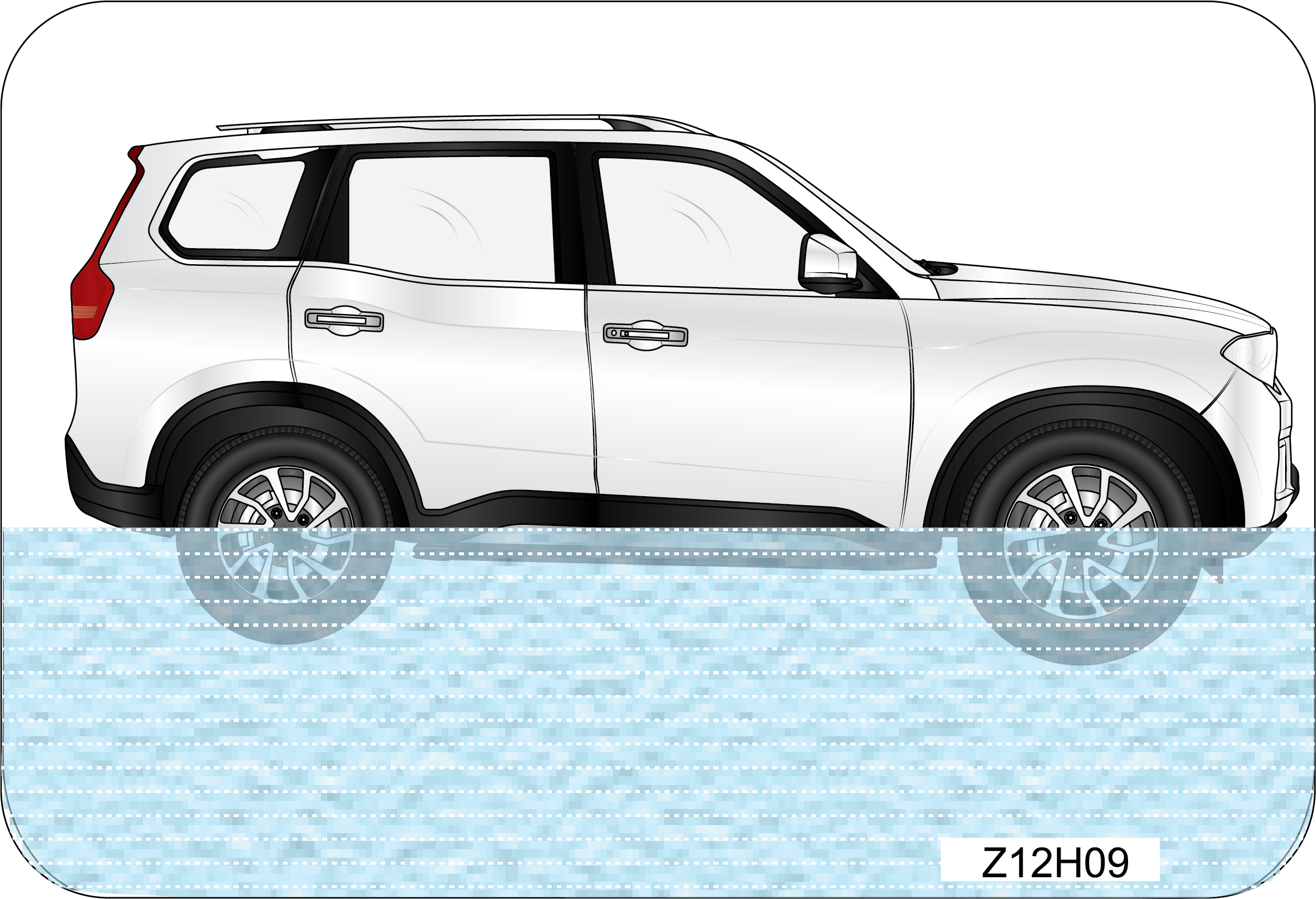 |
Contact your Mahindra Authorised Dealer
immediately.
Have the vehicle towed to nearest Mahindra Authorised Dealer to check
any entry of water into the engine
|
All fluids including engine and transmission fluids required to
be
changed in case of water ingress and contamination

Never attempt to
start the engine, without the advice from Mahindra Authorised Dealer
technician.
| • | Never drive through water when it flows above the bottom portion of the bumper or above the tyre center line |
| • | The engine could get damaged internally if attempts are made to cross through deep water |
| • | Wet brake discs have a lower coefficient or friction resulting in reduced braking efficiency. Tab the brake pedal while driving to remove the film of water |
8.5.5 Driving Through
Water
Although your vehicle is capable of driving through shallow
water,
there are a number of precautions that must be considered
before entering the water.

Never drive through still
water that is higher than the bottom of the axle hubs. Not following this instruction will
allow
water to enter vehicle components causing internal damage to the components, affecting
drivability, safety, emissions, and
reliability.
When driving through
water,
drive very slowly and at constant speed, less than 8 kmph. Drive with out pressing
accelerator
pedal and control speed using only the brakes. At higher speed waves can be generated by
the
front of the vehicle. These water
waves may enter air intake, causing severe engine damage or cause a vehicle to get
stalled.
You must slow down while
driving through shallow water. Speeding may cause water to splash onto the windshield,
impairing
your vision. In extreme conditions, you may get a water wedge formation between the road
and
tyre causing loss of control
in the vehicle.
| • | The ground under the water might not be firm which could result the water being deeper than expected when driving the vehicle through it |
| • | Do not stop or shut OFF the engine while immersed in water. It helps in preventing water getting inside the exhaust pipes |
| • | When backing down a ramp, do not allow the exhaust tail pipe to immerse in water |
| • | Water can wash the grease from wheel bearings, causing rusting and premature failure. It may also enter the differentials, transmission, and transfer case, reducing the oil's lubricating qualities. If these are submerged in water, the lubricants should be replaced as required |
| • | Water entering the transmission will cause deterioration in shift quality, locking up of your transmission accompanied by vibration, and ultimately damaging the transmission |
| • | Sand, mud/sludge that has accumulated in around brake discs may affect braking efficiency. This may also damage brake system components. Wet brakes cannot stop the vehicle as effectively as dry brakes. Drying can be improved by driving the vehicle slowly while applying light pressure on the brake pedal |
| • | When driving through water, traction or brake capability may be limited. Always perform a maintenance inspection after each day of off-road driving that has taken you through water |
8.5.6 Flowing Water
If the water is swift flowing and rising (as in storm run-off)
avoid crossing until the water level recedes and/or the flow
rate is reduced. The flowing water can erode the streambed causing your vehicle to sink into
deeper
water. Determine the exit
point(s) that are downstream of your entry point to compensate for drifting.
8.5.7 After Driving Off-Road
or
through Water
Off-road operation puts more stress on your vehicle than does
most
on-road driving. Always perform a maintenance inspection
after each day of off-road driving that has taken you through rough terrain, sand, mud, or
water.
| • | After going off-road, it is always a good idea to check for damage. Completely inspect the underbody of the vehicle for any damages |
| • | Check for accumulations of plants or bushes. or polyethylene / plastic. These could be a fire hazard at high temperatures. |
| • | Inspect all the tubes/hoses and check for any fluid leakages |
| • | Get heat exchangers (radiator and condenser) cleaned |
| • | We also recommend that the vehicle be checked at the Mahindra Authorised Dealer for any water entry into the transmission / axle or the engine. |

Abrasive material in any part of the brakes may cause
excessive
wear or unpredictable braking. You might not have full braking
power when needed leading to accidents. If you have been operating the vehicle in off-road
conditions, get the brakes checked
and cleaned as necessary.
| • | If any unusual vibration is experienced, check the wheels for impacted material. Impacted material can cause a wheel imbalance. Get it inspected/corrected as soon as possible |
| • | After driving through deep water, inspect your vehicle fluids and lubricants (engine oil, transmission/transfer case/axle oils) to ensure the fluids have not been contaminated |
8.6 Tips for Better
Fuel
Economy
Fuel mileage
(efficiency)
depends on the average speed of the vehicle, number of times the gears are shifted/Clutch
pressed
and number of times the brakes are applied. Vehicles operating in city traffic condition
/bumper to bumper traffic will exhibit
lower fuel mileage as compared to vehicles operating in open highways with higher average
speeds.
DOs
| • | Ensure that your vehicle is maintained as per recommendation (Refer to Warranty and Service Information Guide) |
| • | Ensure
that the tyre pressures are as per recommendation (Ref to sticker on door
pillar or Page 9-3 ) |
| • | Ensure parking brakes are released fully |
| • | Use
Engine
Start-Stop feature to the maximum (Ref Page no 8-42), if applicable |
| • | Drive with all the windows closed to reduce aerodynamic drag |
| • | Accelerate smoothly with a light foot on the accelerator |
| • | Anticipate stops and slow down in coasting mode before applying brake |
| • | In manual transmission, shift gears at the right speeds (Ref page 6-14 for gear shift indication prompts) |
Don'ts
| • | Fitting roof carrier will increase drag and reduce fuel mileage |
| • | Driving at speeds above 80 Kms/hr reduces fuel mileage |
| • | Do not rest the left foot on the clutch pedal in manual transmission vehicles as it will reduce the fuel mileage as well as damage clutch/transmission components |
| • | Do not attempt to use brakes with the left foot in Automatic transmission vehicles |
|
Managing the Air
conditioner for optimum fuel
efficiency
Recommended
AC modes for obtaining optimum fuel efficiency.
|
|
|
|
|
How to Measure /Read Fuel Mileage
Values?
| • | The Fuel mileage value is displayed in the cluster as AFE (Average Fuel Economy) in Kms/lit. |
| • | The AFE can be set to multiple modes. |
| • | Refer to Page 3-15 for the procedure for resetting AFE modes. |
8.7 Ignition Switch (if equipped)
|
|
An illuminator ring is provided on the face of the
ignition switch to help in locating the ignition switch at night. The ring
will illuminate the moment the driver door is opened and will remain glowing till the
driver door is closed.
|
The different positions of the ignition switch are:
LOCK
- This is the ignition and steering lock position. The vehicle circuits and engine
is
completely switched OFF. The steering
wheel is also locked, and the key can be removed from the ignition only in this
position.
ACC - The steering is unlocked and can be rotated. In this position,
all
electrical circuits are enabled. Use this mode when you
want to listen to music, etc., with the engine temporarily switched OFF.
ON - All electrical circuits are enabled. Some of the warning or
information lamps illuminate in this position. While some of
the lamps will go out after a few seconds, some will continue to remain ON till the engine is
started. When the vehicle is
being driven, ignition switch remains in the ON position.

Do not leave the ignition in ON when the engine is OFF. This
could lead to battery drain and ignition switch damage.
START - This position is to start the engine by cranking the starter
motor. This is a momentary position. When the key is turned
to start position, the starter cranks the engine. Once the engine is running, release the
key,
and the key reverts back to
ON position and the starter motor disengages from the engine.

Do not continue cranking after
the
engine has started.

If turning the key is difficult, jiggle the steering wheel
from
side to side and try again.
The key can be removed only in the LOCK position. When the key is removed, the steering column lock is activated, and the steering wheel cannot be turned.
The key can be removed only in the LOCK position. When the key is removed, the steering column lock is activated, and the steering wheel cannot be turned.

Never return the key to the LOCK position or try to remove the
key when the vehicle is in motion. Removing the key allows
the steering wheel to lock. You will lose the control of the vehicle and may cause
serious
accident. Remove the key only when
the vehicle is parked.
8.8 Horn
Press the pad on the steering wheel to blow/sound the horn.
The horn functions even when the ignition has been switched
OFF.

|
Horn will get activated when horn switch/pad is pressed
It will get deactivated when horn switch/pad is
released
or after 10 sec of continuously pressing.
|

If Horn Switch Input is ON for
more than 10 sec, Horn will get deactivate after 10 sec.
8.9 Manual Transmission
The first few shifts on a new vehicle may be somewhat rough. This is a
normal phenomenon, and precision shifts will develop
with the initial few hundred kilometers of running.
8.9.1 Gear Lever
|
|
Your vehicle is fitted with manual transmission
having
six forward and one reverse gear. This shift pattern is imprinted on
the gear lever knob.
|
The transmission is fully synchronized in all forward gears, so
shifting to either a higher or a lower gear is easily accomplished.
The clutch pedal should be depressed fully while shifting, and then released slowly.
8.9.2 Gear Recommendation
Gear information shows the actual gear in which user has
to drive the
vehicle.
Based on the various parameters, it will suggest to
change the gear
for better fuel economy with up/down recommendation.
|
Display
|
|
|---|---|
|
High
|
Low
|
|
|
|
Operating
Condition
The numeral is the suggested gear. The Up or down arrow
is to upshift
or downshift. When no arrow, it indicates vehicle is
in which gear.
8.9.3 Neutral Position
This position stops the transmission of power from the engine to
drive
axle. With the gear lever in neutral and brakes released,
the vehicle can move freely by pushing or towing. The engine can be started in this mode. It is
always
recommended to keep
the brake pedal depressed in this position. It is advisable to shift into neutral when the vehicle
is
standstill for longer
durations with the engine idling.

Coasting the vehicle with the gear lever in neutral and engine
ON/OFF is not recommended. In an event of panic braking, you
will not have the power of engine braking to slow down the vehicle. This may lead to personal
injury or accident.

Do not leave the vehicle
with
the gear lever in neutral position. Always engage manual parking brake before leaving the
vehicle,
to prevent any vehicle movement leading to possible injury to a bystander or damage to
vehicle.
8.9.4 Gears 1-6
Use the gears 1 to 6 as per vehicle load, road/traffic conditions
or
as per requirement. The current gear selection is indicated
in the cluster.

Always depress the clutch
fully
before moving the gear lever from the current position to any desired position. Perform
up-shifts
or down-shifts one gear at a time, do not jump gears.
8.9.5 Recommended Gear Shifting
Speeds
Upshifting -
Diesel
| Shift Range | Vehicle Road Speed (kmph) | Engine RPM Range |
|---|---|---|
|
1–2
|
16
|
1600–2000
|
|
2–3
|
27
|
|
|
3–4
|
42
|
|
|
4–5
|
54
|
|
|
5–6
|
70
|
Downshifting
-Diesel
| Shift Range | Vehicle Road Speed (kmph) | Engine RPM Range |
|---|---|---|
|
2–1
|
14
|
1000–1200
|
|
3–2
|
25
|
|
|
4–3
|
40
|
|
|
5–4
|
52
|
|
|
6–5
|
61
|
Upshifting -
Petrol
| Shift Range | Vehicle Road Speed (kmph) | Engine RPM Range |
|---|---|---|
|
1–2
|
18
|
1600–2300
|
|
2–3
|
30
|
|
|
3–4
|
44
|
|
|
4–5
|
54
|
|
|
5–6
|
70
|
Downshifting
-Petrol
| Shift Range | Vehicle Road Speed (kmph) | Engine RPM Range |
|---|---|---|
|
2–1
|
14
|
1000–1200
|
|
3–2
|
25
|
|
|
4–3
|
40
|
|
|
5–4
|
52
|
|
|
6–5
|
61
|

Shift gears at suitable
engine
or road speeds to safeguard the transmission components. Avoid driving in high RPM’s
frequently.

When parking on an incline,
gear alone may not be sufficient to prevent the vehicle from moving. Always set the manual
parking
brake in addition to shifting the gear lever into gear. It is also recommended to turn the
front
wheels towards the road curb.
8.9.6 Reverse
|
|
This gear is to enable the vehicle to move in the
reverse direction. Move the gear lever into this position only after the
vehicle has come to a complete stop and the gear lever is in neutral position.
|
The reverse lock ring located immediately below the gear
shift knob
must be pulled upward while moving the shift lever to
the reverse (R) position.

To avoid transmission
damage,
shift into or out of reverse gear only after the vehicle has come to a complete stop and the
engine is at idle speed. It is recommended you to wait approximately for three seconds in
neutral gear to shifting into or
out of reverse gear.

For brief stops, e.g. at
traffic lights, keep the gear shift in neutral and hold the vehicle with the brake pedal. For
prolonged
stops, it is recommended to switch OFF the engine and apply the Parking brake. When stopping
the
vehicle on an uphill gradient,
do not hold it with the clutch/accelerator; use the brake to avoid unnecessary clutch
wear/heat
build up.

Do not leave children
unattended in the vehicle or with access to an unlocked vehicle. Children could move the gear
lever,
which could result in an accident or serious injury.
On slippery/wet road
surfaces,
never downshift to obtain braking action. This could result in a wheel slip and reduced
vehicle
control.
8.9.7 Uphill and Downhill
Driving
To prevent the engine from high stress at a low RPM when driving
uphill gradients or with your vehicle heavily loaded, downshift
when necessary to maintain engine RPM within the best torque range. Similarly, while driving
downhill,
downshift to utilize
the engine braking in an optimum manner.
8.10 Automatic Transmission (AT)
8.10.1 Gear Selector Lever
|
|
Your vehicle is equipped with 6 Speed automatic
transmission having Electric controls with an Adaptive Transmission Control
Strategy.
|
This adaptive Transmission strategy offers optimal
transmission
operation and shift quality in different driving conditions.
The transmission electric are self-calibrating. Therefore, the
first
few shifts on a new vehicle may be somewhat rough. This
is a normal phenomenon, and precision shifts will develop within the initial few hundred kms of
running.
|
P : Park position
|
M : Manual Shift
|
|
R : Reverse position
|
M+ : Manual up-shift
|
|
N : Neutral position
|
M- : Manual down shift
|
|
D : Drive position
|
Shift Logic
Table
| Movement | Possibility |
|
P-R
|
Yes-Brake pedal + knob button
|
|
R-N
|
No
|
|
N-D
|
No
|
|
D-M
|
No
|
|
M-D
|
No
|
|
D-N
|
No
|
|
N-R
|
Yes-Only knob button
|
|
R-P
|
Yes-Only knob button
|
The current gear lever position is indicated in the
centre of the
cluster display.
8.10.2 P : Park Position
|
|
Use this position to park your vehicle, warm up the
engine, or stay in a location for an extended length of time.
|
To shift in to any other position, first depress the
brake pedal, then
press knob button and move the TGS to R or N or D as
desired.

| • | Stop the vehicle completely before shifting into “P” |
| • | Never shift to “P” when the vehicle is moving, To avoid damage to transmission |
| • | If the lever is shifted to P when the vehicle has not come to stop and in forward motion, then a ratchet noise will be heard. This is not abnormal. However we do not recommend moving to P till the vehicle has come to standstill . As repeated such instances can damage the internal parts |
| • | To shift from the “P” position to another position, the ignition switch must be turned to “ON” and the brake pedal should be depressed. Any forcible attempts to move the selector lever from “P” without the two procedures may damage the selector lever |
8.10.3 R : Reverse position
|
|
Use this position to drive the vehicle in reverse
To shift into “R” from “P” or “N” (with the knob
button
press), completely stop the vehicle and depress the brake pedal. When
the shift lever is in “R”, parking aid system will be automatically activated.
|

| • | Never shift into “R” when the vehicle is moving |
| • | Please note that the vehicle may slowly move backward when the selector lever is at “R” |
8.10.4 N : Neutral position
|
|
At this position, the engine does not transfer power
to
the wheels and the vehicle will not move on a flat road. However,
for safety, apply the brake when the gear is in this position.
|

| • | Warm up the engine for approximately 3 minutes when the ambient temperature is below -15°C. Otherwise, shifting of gears in Forward or Reverse direction may not be smooth |
| • | If you have to stop on a hill and would like to use this neutral position, depress the brake pedal firmly |
| • | Never attempt to move the gear selector lever to “N” when the vehicle is in motion |

Depress the brake pedal while shifting the gear lever from “N”
to
“D” or “R” for your safety.

For shifting R to P, press the knob button and for shifting to N
or
D, only shift lever to moved. Refer the shift logic table
for more clarity.
8.10.5 D : Drive position
|
|
Use this position for normal driving conditions. The
transmission is automatically shifted from 1st gear up to 6th gear according
to the level of depression on the accelerator pedal
|

| • | Do not abruptly drive off or sharply accelerate the vehicle immediately after shifting into “D” or the transmission will be damaged. Wait for D symbol to come in the cluster before pressing the accelerator pedal |
| • | Even while the gear is in “D”, the vehicle can roll down an uphill according to the gradients, so you have to depress the brake |
| • | Please note that the vehicle may creep forward on level ground when the selector lever is in “D” even without pressing the accelerator pedal and this behavior is known as forward creep |
8.10.6 M : Manual Shift
|
|
To shift to manual mode move the lever in left side
from “D” position. Driving gear can be adjusted by operating the shift
lever in front or back direction.
|
In manual shift mode, the user can upshift or downshift
from 1 to 6
forward gears by moving the shift lever in front or back
direction.
Shift up:
Move the shift
lever forward towards + direction and release once to shift up one gear.
Shift Down:
Move the shift
lever backwards towards - direction and release once to shift up one gear.
The gears can be shifted without requiring to release
the Accelerator
pedal.
In manual mode, downshifts are made automatically when the vehicle
slows down. Similarly, upshifts are automatically made
when the engine rpm exceeds the threshold.
When starting to drive on a snow or icy road, upshift of
the gear to
2nd or 3rd is possible to avoid loss of traction.
For safety reason maximum three shifts “+” / ”-” can be
allowed at
given point of time.

| • | Before leaving the Driver’s seat always make sure that the shift lever is in the P (park) position |
| • | Shifting into P position while the vehicle is in motion will cause the drive wheels to lock which will cause you to lose control of the vehicle |
| • | Always fully depress the brake pedal before and while shifting out of the Drive (D) position into another position (other than M Mode) to avoid inadvertent motion of the vehicle |
| • | The shift from D to M (Manual Mode) and M to D can be performed while the vehicle is moving |
| • | Never press accelerator pedal when moving the gear shifter lever |
| • | To maintain the required levels of vehicle performance and safety, the system may not execute certain gearshifts when the shift lever/ tip switch is operated |
Use of Engine
Brake: To use
the engine as a brake, change into the manual gear shift mode first, then operate the shift lever
to
switch to next
lower gear.

| • | Abruptly downshifting and using the engine brake may make the vehicle unstable, especially when driving on roads covered with snow or ice |
8.10.7 Gear Shift Interlock
system
The Automatic
Transmission
has a shift lock system which prevents shifting the transmission from P into R unless the
Brake
Pedal is depressed
|
|
|
In case of malfunction of
the shift lock system or vehicle battery got drained, Open up the shift lock cap which is
present
in front of the shift lever on the shift bezel. Then with the help of Screw driver
available
in toolkit, Press the button
and move the shift lever out of P mode.
8.10.8 Starting and Driving
Off
| • | Always start the engine while the selector lever is in “P”. For your safety, avoid starting the engine from “N” even though you can do so. |
| • | Check whether or not the engine idling speed is normal. Keep the brake pedal depressed and shift into “D” or “R”. |
| • | To move the vehicle, release the brake pedal and depress the accelerator pedal gradually. |

| • | Do not abruptly drive off or sharply accelerate the engine after shifting into “D”. Otherwise the transmission will be damaged. Especially, when you start off after stopping, wait for a while until the “D” shift indicator comes on with the brake pedal depressed |
| • | When driving on a down hill, never shift the selector lever to “N” If you try to shift the lever to “D” from “N”, a sudden gear engagement can damage the drive train |
| • | HDC (Hill Descent Control) is designed for driving down a steep hill. When HDC is applied, do not shift to “N”. Otherwise, HDC will be deactivated |

| • | For your safety, always depress the brake pedal before moving the gear selector lever with the vehicle stopped |
| • | Never depress the accelerator pedal when moving the gear selector |
| • | If you have to stop on a hill, depress the brake pedal fully |
| • | To avoid any mechanical damages or accidents, never shift into “P” or “N” while the vehicle is in motion |
| • | A high engine speed can cause your vehicle to move abruptly from the parked position. To avoid this, wait until the engine rpm becomes stable |
| • | When you start off on a hill after stopping and parking the vehicle, wait for a while until the “D” shift indicator comes on, with the brake pedal depressed |
| • | Do not press the accelerator pedal and the brake pedal at the same time |
| • | We suggest that right leg only should be used for brake pedal operation |
8.10.9 Creep Function
Without any actuation of the accelerator pedal, your vehicle will
move
slowly if the selector lever is in any position other
than “P” or “N”. This is called the creep effect. You can control your vehicle’s movement by only
applying the brake in heavy
traffic or narrow areas.

On a steep decline or incline, your vehicle may move in the
opposite direction of the intended direction despite the creep
effect. When stopping on a steep hill, always depress the brake pedal
8.10.10 Kick-down Function
If you need to accelerate rapidly, depress the accelerator pedal to
its travel end. Then, a lower gear will be automatically
engaged. This is called the kickdown function.

| • | Do not use the kick-down function while driving on slippery or sharply curved roads |
| • | If you use the kick-down function too frequently, the fuel economy of the vehicle will get worse |
8.10.11 Engine Braking
When the accelerator pedal is released while the vehicle
is in motion,
the engine speed decreases.
On a down hill, engaging a lower gear can generate a
higher engine
braking and eventually slow down the vehicle speed.
By using engine behavior as a brake, you can decrease
your vehicle
speed without excessively using the brake system.
The lower gear, the higher braking force.

Do not excessively apply the brake pedal while going down a long
slope. The brake system will overheat, experience vapor lock
or the fade phenomenon, and lose the braking force
Be aware that the engine brake does not work when the gear
selector
lever is in the “N” position
Avoid any abrupt engine braking on slippery roads, or the tyres
may
slip
8.10.12 Limp Home Mode (LHM)
When there is a malfunction in the transmission, it goes into Limp
Home Mode to maintain minimum driving conditions and also
to prevent critical transmission damage.
This status is indicated by the transmission check lamp
illumination
in the instrument cluster.
Contact the nearest Mahindra Authorised Dealer for
further
assistance.

The transmission is held either in 3rd/ 5th gear when LHM is
activated.
8.11 4XPLOR Mode (If equipped)
Your vehicle is equipped with a 4XPLOR Drive Mode System that allows
the
driver to enhance the off-road performance of the
vehicle, by selecting the mode best suited to the terrain and driving conditions. Each mode changes a
number of the vehicle
parameters within the engine, transmission, traction control and Four-Wheel Drive systems
4XPLOR Drive Mode System is designed to adjust the
vehicle’s driving
characteristics based on the terrain.
Drive Modes
Mahindra’s 4XPLOR Drive Mode System has four driver-selectable modes
that
can be operated along with the shift-on-the-fly
4WD system. Just by selecting the desired mode, the system automatically controls 4WH, Engine
response,
Transmission shift
pattern, Traction Control & Stability.
| • | Normal Mode – General everyday driving normal roads. |
| • | Grass/Gravel/Snow Mode —Improved vehicle stability for low-traction conditions |
| • | Mud/Ruts Mode — Maximum torque availability at all four wheels |
| • | Sand Mode — Momentum of the vehicle is maintained to keep moving on soft ground |

Do not drive in 4H when in tarmac or firm road, this is essential
to
avoid damage to drive line components.
All modes can be used in either 4HI or 4LO mode.
To enable 4XPLOR Drive Management System
1. Locate the Intelli Command Center (ICC) knob on the
center
console.
2. Rotate the ICC knob in clockwise or anti-clockwise
direction to
select
the desired drive mode from existing mode

Single step rotation results in shifting to next mode based on
rotational direction. If more than 1 step is rotated, based
on the number of steps and direction of rotation, the modes corresponding to steps moves will get
selected
|
|
3. Once the ICC knob is rotated to desired drive mode,
the
LED on ICC switch corresponding to the mode selected will start
blinking and once the mode gets activated, the LED remains continuously ON.
|

| • | If the vehicle is in 2WD and user had selected any drive mode other than normal, 4WH will get engaged automatically |
| • | 4WH warning lamp turns ON in cluster
|
| • | Selected mode indication turns ON in cluster |
| • | Mode activation message displays in cluster |
|
Mode
|
Normal
|
Grass/Gravel/Snow
|
Mud/Rut
|
Sand
|
|
2H
|
Yes
|
No
|
No
|
No
|
|
4H
|
Yes
|
Yes
|
Yes
|
Yes
|
|
4L
|
Yes
|
Yes
|
Yes
|
Yes
|
8.11.1 Normal Mode:
This is a default mode which gets activated after
every
ignition
cycle. This is the ideal mode for normal road conditions.

4WH/4WL also can be engaged in this mode. For more information
refer 4WD session
|
|
Normal mode LED in ICC glows which indicates vehicle
is
in normal mode.
|
|
|
Normal mode icon will be displayed in cluster
Also “Normal Mode activated” alerts will be
displayed
in cluster and goes OFF
|
8.11.2 Grass/Gravel/Snow
To select this mode rotate the ICC switch:
|
||||||
|
or
|
||||||
|
||||||
|
or
|
||||||
or
|
|
|
Once this mode is selected 4WH will be automatically
engaged (If not engaged previously). LED lamp on ICC corresponding to
this mode starts blinking and on activation of the mode, the LED remains ON
continuously.
|
|
|
Grass/Gravel/Snow mode icon will be displayed in
cluster
Also “Grass/Gravel/Snow Mode activated” alerts will
be
displayed in cluster and goes OFF
|

| • | This mode improves overall traction of the vehicle. Use this mode to drive in surfaces covered with snow, ice, water, grass or gravel |
| • | MAX speed possible in 4WH is 120kmph & 4WL is 60kmph |
|
|
|
For automatic
transmission vehicles:
| • | Vehicle will be launched automatically in 2nd gear if TGS lever is in Auto mode |
| • | Driver can select 2nd gear to launch the vehicle manually using TGS lever in Manual mode |
| • | Gear early upshift & late downshift is normal in this mode |
| • | In snow conditions. Avoid giving strong inputs. Also avoid sharp braking. The ABS and ESP can help but they can not overcome the physical laws of friction. |
8.11.3 Mud/ Rut Mode
To select this mode rotate the ICC switch:
|
|||
|
or
|
|||
|
|||
|
or
|
|||
|
|
|
Once this mode is selected 4WH will be automatically
engaged (If not engaged previously). LED lamp on ICC corresponding to
this mode starts blinking and on activation of the mode, the LED remains ON
continuously.
|
|
|
Mud/ Rut mode icon will be displayed in cluster
Also “Mud/ Rut Mode activated” alerts will be
displayed
in cluster and goes OFF
|

| • | This mode provides best traction for slippery road conditions. Use this mode to drive in surfaces covered with mud or if vehicle is stuck in rut. |
| • | 4WL also can be selected manually based on requirements |
| • | MAX speed possible in 4WH is 70 kmph & 4WL is 60 kmph |
| • | When vehicle goes beyond 70 kmph in 4WH, 4Xplor mode will change to Normal Mode |
| • | Once it goes out from mud & rut mode , User can manually reengage the mud mode once again in the same driving cycle - only after the vehicle speed comes below 60 Kmph |
| • |
|
For automatic transmission vehicles:
| • | Gear late upshift & early downshift is normal in this mode |
8.11.4 Sand Mode
To select this mode rotate the ICC switch:
|
|||
|
or
|
|||
|
|||
|
or
|
|||
|
|
|
Once this mode is selected 4WH will be automatically
engaged (If not engaged previously). LED lamp on ICC corresponding to
this mode starts blinking and on activation of the mode, the LED remains ON
continuously.
|
|
|
Sand mode icon will be displayed in cluster
Also “Sand Mode activated” alerts will be displayed
in
cluster and goes OFF
|

| • | This mode ensures maintains the momentum of the vehicle to keep the vehicle moving on soft ground. Use this mode to drive in surfaces covered with sand. |
| • | 4WL also can be selected manually based on requirements |
| • | MAX speed possible in 4WH is 120kmph & 4WL is 60kmph |
| • |
|
For automatic transmission vehicles:
| • | Gear late upshift & early downshift is normal in this mode |
| • | In sandy terrain, it is essential that the vehicle momentum is maintained ESP. going up the dune. At the same time do not give too sharp steering input, the wheel can dig into sand. |

As soon as non-sandy area is reached. Please reinflate to
recommended pressure. Do not drive in non-sandy area with speed
in order to ensure vehicle safety. If air pump not available, do it low speed and caution.
8.12 Four Wheel Drive (4WD) System
(if
equipped)
The 4WD system can be used for off-terrain driving or steep
inclines
like
ghat sections and hill terrain regions.
|
High
|
Low
|
|
|
|
The 4WD selector switch is located on the floor console next to the
gear
lever. It allows the operator to choose between three
different modes depending on the torque requirement.
|
4WD
Shifting
Conditions
|
|
|
Mode
Shift
|
Conditions
|
|
Shifting in to 4H
|
Vehicle Speed < 80 kmph
|
|
Shifting out of 4H
|
No speed limit
|
|
Shifting to 4L
|
Vehicle speed< 0 kmph
|
|
P/N mode (for AT),
Clutch pressed/Gear in N (For MT) |
|
|
Shifting out of 4L
|
Vehicle speed<2 kmph
|
|
P/N mode (for AT),
Clutch pressed/Gear in N (For MT) |
|

The operator can switch to 4H mode from 2H at <80kmph. To
engage or disengage 4L from any mode, the vehicle speed must be
zero, and the transmission in neutral.
8.12.1 Operating
Instructions/Precautions
|
High
|
Low
|
|
|
|
Use the 4WD selector switch on the floor console to
select the
following transfer modes.
4H: All four wheels are
driven at 1:1 speed ratio. The four wheel drive telltale lamp illuminates when 4H mode is selected.
This
mode provides additional traction and maximum pulling power for loose, slippery road surfaces such
as
ice, snow, gravel, sand
and dry pavement. Front and rear drive shafts are locked together in this mode which forces the
front
and rear wheels to rotate
at the same speed.
4L: All four wheels are
driven at 2.48:1 speed ratio. Use this mode for maximum pulling power and traction. Use 4L position
for
climbing or descending steep hills, off-road driving, hard pulling in sand, mud or deep snow. Front
and rear drive shafts
are locked together in this mode which forces the front and rear wheels to rotate at the same
speed.
Pro-longed driving in
the 4L position on dry hard surfaced roads may cause increased tire wear and damage to driveline
components. Take care not
to over rev the engine when driving in this mode. When operating your vehicle in 4L, the engine
speed
(RPM) is considerably
higher than that of the 4H position at a given road speed.

4H or 4L mode shall not be
used
on rough tarmac road surface, especially during sharp turns to avoid gear box winding and
damage the gear box.
To Shift from 4H to
4L
|
High
|
Low
|
|
|
|
| 1. | Bring the vehicle to a complete stop |
| 2. | Brake pedal depressed |
| 3. | Shift the gear lever into P/N mode (for AT) & Clutch pressed/Gear in N (For MT) |
| 4. | Press/Rotate the four wheel drive selector switch to the 4L position. The 4WD LOW lamp in the cluster should illuminate and the 4WD HIGH lamp goes OFF. If the 4WD LOW lamp does not illuminate within 10 sec repeat the above steps again |
To Shift from 4L to
4H
|
High
|
Low
|
|
|
|
| 1. | Bring the vehicle to a complete stop |
| 2. | Brake pedal depressed |
| 3. | Shift the gear lever into P/N mode (for AT) & Clutch pressed/Gear in N (For MT) |
| 4. | Press/Rotate the four wheel drive selector switch
to
the 4H position. The 4WD LOW lamp in the cluster goes OFF and the 4WD
HIGH lamp should illuminate. If the 4WD LOW lamp doesn't go out within 10 sec, drive
forward or reverse for a short distance,
stop the vehicle completely, shift the gear lever into neutral and operate the
selector
switch again. If the problem persists contact an Authorized Mahindra Dealer as soon as possible. There may be a malfunction in the four wheel drive system |
To Shift from 2H to
4H
Vehicle speed should be less than 80 kmph.
Press/Rotate the four wheel drive selector switch to the
4WH
position.

Exceeding 25 mph (40 km/h)
while the transfer case is engaged in 4L may result in an engine overspeed condition and
engine
damage

Because the four-wheel drive
provides improved traction, there is a tendency to exceed safe turning and stopping
speeds.
| • | Do not believe than you can go faster than road conditions permit |
| • | Do not shift to a lower gear than necessary to maintain forward motion |
| • | Over-revving the engine can spin the wheels and traction will be lost. You will not be able to stop or control your vehicle |
| • | Braking performance is dramatically reduced in wet/icy/slippery conditions. Avoid abrupt downshifts on slippery roads, engine braking may cause skidding and loss of control resulting in an accident |
| • | Do not press the clutch while descending steep hills as you may lose control of the vehicle. Always descend in-gear |
| • | In heavy snow or when pulling a load, or for additional control at slower speeds, select a low gear and/or shift the transfer case to the 4L range. |
8.12.2 Wheel Locking Hubs (Only
for 4WD vehicles)
Automatic Locking
Hubs

When you shift to 4WD mode, an audible ‘click’ will
indicate
that front axle disconnect are engaged and therefore power is
being transmitted to the front wheels. While changing back to the 2WD mode, the hubs
need to be released.
To release the
locking
hubs
| • | Shift from 4WD to 2WD |
| • | Reverse the vehicle in a straight line for about a metre |
| • | An audible ‘click’ will indicate that the hubs have been released. |
| • | Unlocking is necessarily required to be done to isolate front axle and transfer case from transmission and from front wheels. |

If auto lock hubs make a clattering noise when driving in
2H
mode, stop and move the vehicle about 2 to 3 metres in backward
direction.

When engaging and disengaging, the front axle disconnect
will
make a clicking noise. It is normal.
8.12.3 Mechanical Lock
Differential (MLD)
On the vehicle fitted with MLD, if one rear wheel begins to
spin/slip,
the mechanical lock differential is designed to help/improve
traction by automatically getting locked and transmitting driving force to the other rear wheel
fully.
Hence spinning of the
wheel is avoided and torque is transmitted to the wheel which is not slipping, which helps the
vehicle
to move on loose terrain.
After locking the MLD lock opens up automatically on the
followings:-
| 1. | Torque reversal/coasting |
| 2. | Slight turning on the same side on which side the wheel was slipping |
| 3. | Slight steering input |
| 4. | Braking |
| 5. | The system gets de-activated over a speed of 30km/h |
In normal driving condition the differential behaves as an open
differential.
8.12.4 4WD Lamps - Instrument
Cluster
4WD LOW Lamp
This lamp alerts the driver that the vehicle is in the 4L (four
wheel
drive low mode). The 4WD LOW lamp illuminates in the
cluster when the transfer case has shifted to the 4L mode. If the lamp fails to illuminate when the
ignition is switched ON,
or the lamp continuously remains ON even if the switch is not in the 4L position, then have the
system
checked by an Authorized
Mahindra Dealer.
4WD HIGH Mode
Lamp
This lamp alerts the driver that the vehicle is in the 4H (four
wheel
drive high mode). The 4WD HIGH lamp illuminates in the
cluster when the transfer case has shifted to the 4WD HIGH mode. If the lamp fails to illuminate
when
the ignition is switched
ON or the lamp continuously remains ON even if the switch is not in the 4H position, then have the
system checked by an Authorized
Mahindra Dealer.
If 4WD Malfunction showing on cluster, The vehicle
should be taken
to
an Authorized Mahindra Dealer immediately.
8.12.5 4Xplor Mode Alerts
During 4XPLOR Mode except
Normal
mode , if user chooses 2WD then the system will request user to switch to 4WH and alert
pops
up in the Cluster.

In case if user does not switch to 4WH mode then system
will wait for few secs and then it will come out of 4XPLOR Mode to
Normal mode.
During 4XPLOR Mode selection or when vehicle is in any
of
the 4XPLOR modes, in case of any internal failure in the system
then it will exit from 4XPLOR mode.
| Display | Operating Conditions |
|---|---|
|
|
The warning will be displayed if user
request
4WH above 80 kmph vehicle speed
|
|
|
The warning will be displayed if user enter
or
exit 4WL mode during driving. (MT Variant)
|
|
|
The warning will be displayed if user enter
or
exit 4WL mode during driving. (AT Variant)
|
|
|
The warning will be displayed if user enter
or
exit 4WL/4WH mode during driving.
|
Keep the mode in snow or Sand as appropriate.
It is suggested that in normal operating conditions use 4H and relevant 4XPLOR mode.
If the vehicle is badly stuck and not getting out even after repeated attempts of going forward and reverse or due to extreme load coming. Drive in 4L. However as soon as the extreme patch is over, we suggest to move out to 4H.
Tyre pressure : In sand it is essential that the tyre pressure be reduced.
It is suggested that in normal operating conditions use 4H and relevant 4XPLOR mode.
If the vehicle is badly stuck and not getting out even after repeated attempts of going forward and reverse or due to extreme load coming. Drive in 4L. However as soon as the extreme patch is over, we suggest to move out to 4H.
Tyre pressure : In sand it is essential that the tyre pressure be reduced.
8.12.6 Do’s and Dont’s for
Front
Axle Having Disconnect System
|
Drive
Mode
|
Operation
of Drive Mode
|
Do’s
|
Dont’s
|
|---|---|---|---|
|
2WD
|
Normal
Operation of vehicle.
|
Normal
operation of vehicle
|
|
|
Rear
Wheels
are powered only. The disconnect and the transfer case are
disengaged.
|
|||
|
4WH
|
Front and
rear wheels are powered. The disconnect is engaged and the transfer case is
locked
The front
axle will transfer power to the ground at all times.
To shift
from 2WD to 4WH rotate the selector switch to the 4WH position or Press the 4WH selector switch.
This
can be done at vehicle speed < 80 kmph.
To shift
from 4WH to 2WD rotate the selector switch to 2WD or Press the 4WH selector switch. This can be done
at
no speed limit.
|
Engage
4WH
only when the vehicle has been traveling straight for greater than 15
seconds.
|
Do not
operate the vehicle in 4WH mode on dry, hard-surfaced
roads
|
|
Do not
shift
into of 4WH while the rear wheels are slipping.
|
|||
|
It is not
recommended to operate the vehicle in 4WH mode with a Temporary spare tyre.
If
4WH drive operation is necessary,
do not operate at speeds above 16 kmph and/or for distance greater than 80
km.
Extended operation in 4WH with Temporary spare
tyre may result in damage to drivetrain components.
|
|||
|
4WL
|
Front and
rear wheels are powered.
The
disconnect is engaged and the transfer case is locked in low
gear.
The front
axle will transfer power to the ground at all times.
To shift
from 2WD or 4WH into 4WL. Stop the vehicle, depress the brake and place the
automatic transmission in N (Neutral)
or depress the clutch on vehicles with a manual transmission. Rotate the
selector switch to the 4WL position.
To shift
from 4WL to 2WD or 4WH. Stop the vehicle, depress the brake and place the
automatic transmission in N (Neutral) or
depress the clutch on vehicles with a manual transmission. Rotate the
selector
switch to 2WD/4WH or Press 4WH/4WL for 2WD.
|
Engage
4WL
only when the vehicle's transmission is in neutral or the clutch is
depressed
and the vehicle is stopped.
|
Do not
operate the vehicle in 4WL mode on dry, hard-surfaced
roads.
|
|
Do not
shift
into or out of 4WL while vehicle is moving or the rear wheels are
spinning.
|
|||
|
Do not be
concern about some momentary clunks and ratcheting sounds when initially
shifting into 4WL mode. The noise is caused
by the front drivetrain engagement
|
|||
|
It is not
recommended to operate the vehicle in 4WL mode with a Temporary spare tyre.
If
4WL drive operation is necessary,
do not operate at speeds above 16 kmph or for distance greater than 80 km.
Extended operation in 4WL with temporary spare
tyre may result in damage to drivetrain components.
|
8.13 Drive Modes (if equipped)
Drive Mode is a quick and easy way to change driving style of your
vehicle. With Drive mode settings, you can instantly adjust
driving dynamics and feel of your vehicle, all on the go. The system is incredibly easy to use, simply
chose you choice of
"Drive Mode" and experience 3 different vehicles in one.
To activate the Drive modes, Press Drive mode hard switch on center
fascia switch bank and select required drive mode from
cluster Screen
Press drive mode switch to enable drive mode selection menu in cluster
display and further consecutive switch press leads
to navigate the drive mode options. The highlighted one is selected after no switch press for at least
2
seconds.
Note:
1. If any alerts triggered in cluster, First press of drive mode
switch
the particular alert message will suppress (if applicable).
Then in immediate next press selection menu will be triggered.
2. In Case alert is not suppressed user has to wait untill
alert
timeout
to select drive mode menu..
You can select from
multiple
drive modes options any time during your Drive, meaning you can switch to the perfect mode
when
the situation calls for it. Whether you're looking for an relaxed commute or a sporty back
roads
adventure, Drive Mode allows
you to perfectly tailor your vehicle for your unique driving style.

Drive Modes
essentially
offers
you the Driver a Drive Experience of 3 different cars in one car.
| • | You can choose ZAP mode to experience a TRUE SUV drive, a drive that is true to the Mahindra SUV experience. This is the default mode. |
| • | You can choose ZIP mode for a normal comfortable city drive. The Engine Power and shift points (in AT) will be suitable for traffic conditions. |
| • | You can choose ZOOM Mode for the Adrenaline Rush. Engine Power, Gear shifts , Braking will all work together to give you an absolute THRILL to your driving experience. |
Driving Modes changes vehicle handling, dynamics and entire Drive Feel
at
a touch of an icon. This essentially enables Driver
to experience multiple calibrations seamlessly.
Driving modes alters
| 1. | Sensitivity of Accelerator pedal along with engine power delivery |
| 2. | Gear shift patterns |
| 3. | Steering effort |
| 4. | TCS Control |
Based on the mode selected driving
ZAP Mode: ZAP Mode offers
regular everyday performance. The car runs like a true Mahindra should. It offers a good balance
between
ZIP
and ZOOM settings and is ideal for day-to-day use. The vehicle will be default in ZAP mode every time
the
vehicle Ignition
is turned ON. This is the default mode.
ZIP Mode: ZIP
mode is the
accelerator pedal response and shift points (in AT) have been modified so as to have comfortable and
easy
control for traffic condition.
ZOOM Mode: This mode is for
a
more spirited driving. ZOOM mode is offered to make the car more fun, as it produces more engaging and
potent ride-quality. In this mode, accelerator will become more responsive, i.e. the car accelerates
more
readily. The steering
gets heavier, Gear shift and is delayed.
Once any of the modes is selected, we would have an ALERT
message in
cluster.
Based on the mode selected the Alert message would vary for
ZAP: ZAP MODE
ACTIVATED
ZIP: ZIP MODE
ACTIVATED
ZOOM: ZOOM MODE
ACTIVATED
Once selected we would have a permanent indication in the
CLUSTER.
Also,
the skin of the cluster also changes as per the mode.

1. When in Cruise control Vehicle will always be defaulted
to ZAP MODE
2. ON every IGNITION Cycle, vehicle will always start in ZAP MODE
 |
This alert is displayed when Zip drive mode is
activated.
|
 |
This alert is displayed when Zap drive mode is
activated.
|
 |
This alert is displayed when Zoom drive mode
is
activated.
|
|
|
3. IN case of any faults at vehicle level , that
doesn't
allow the vehicle to be in the mode of choice Customer is alerted
by an alert message – “Drive Mode Not Possible” in cluster screen and the Mode choice
in
the Cluster would be Blank.
|
8.14 Micro Hybrid Technology (Engine
Stop/Start System) – MT/AT (If equipped)
Engine Stop/Start system automatically “stops” and “starts”
the engine
when idle at signals or long traffic jams. This in
turn gives a better fuel efficiency.
8.14.1 Engine Stop/Start System
Overview– MT
Engine Stop/Start system is activated by the Engine
Stop/Start
button
in the driver side switch bank. The LED on the button
indicates the status of the button.
How does the Engine
Stop/Start
System Work?
Let’s take a simple example of driving in traffic conditions within
your city. Assume that your vehicle has stopped at a traffic
junction due to a red signal. The following steps illustrate how the system functions:
| • | The vehicle has come to a halt at a traffic signal, is in the neutral gear and the clutch pedal is released |
| • | The Engine Stop/Start lamp in the cluster will blink indicating that the engine is going to stop shortly. The engine will shut down automatically after a specific time period |
| • | The Engine Stop/Start lamp will illuminate in the instrument cluster indicating the engine was stopped by the “Engine Stop/Start” System |
| • | Once the signal turns green, press the clutch pedal and the engine starts immediately |
| • | The indicator in the cluster goes OFF indicating that the engine has started again and you are ready to drive on |
For auto stop to
happen, the
following conditions are to be met:
| • | Engine Stop/Start system is in active condition by default and should not be turned off using the selection switch |
| • | Bonnet is fully closed |
| • | In the current ignition cycle, the vehicle has crossed 7 kmph at least once |
| • | Current status of the engine is idling |
| • | Vehicle speed is zero |
| • | Accelerator pedal and clutch pedal are fully released |
| • | Vehicle battery should be in healthy condition |
| • | Engine is warm (Engine coolant temperature is between 25 degree C and 100 degree C). This is an extra precaution to ensure safe working of the engine |
| • | Fuel temperature is less than 60 degree C |
| • | Gear in neutral |
| • | DPF REGEN should not be in active state |
| • | Vehicle should not have DEF error codes E14, E24 & E34l |
| • | OBD and CHECK ENGINE telltale in OFF condition |
For auto start to
happen, the
following conditions are to be met:
| • | Vehicle should have been stopped by the Engine Stop/Start System |
| • | Gear lever is in the neutral position, Clutch pedal is fully de-pressed |
| • | Vehicle speed is zero |
| • | Engine Stop/Start System is in active state |
| • | Bonnet should be closed |
8.14.2 Engine Stop/Start System
Overview – AT
Engine Stop/Start system is activated by the Engine
Stop/Start
button
in the driver side switch bank. The LED on the button
indicates the status of the button.
How does the Engine
Stop/Start
System Work?
Let’s take a simple example of driving in traffic conditions
within
your city. Assume that your vehicle has stopped at a traffic
junction due to a red signal. The following steps illustrate how the system functions:
| • | The vehicle has come to a halt at a traffic signal, is in the “D” Mode and the brake pedal is pressed |
| • | The Engine Stop/Start lamp in the cluster will blink indicating that the engine is going to stop shortly. The engine will shut down automatically after a specific time period |
| • | The Engine Stop/Start lamp will illuminate in the instrument cluster indicating the engine was stopped by the “Engine Stop/Start” System |
| • | Once the signal turns green, release the brake pedal and the engine starts immediately |
| • | The indicator in the cluster goes OFF indicating that the engine has started again and you are ready to drive on |
For auto stop to
happen, the
following conditions are to be met:
| • | Engine Stop/Start system is in active condition by default and should not be turned off using the selection switch |
| • | Bonnet is fully closed |
| • | In the current ignition cycle, the vehicle has crossed 7 kmph at least once |
| • | Current status of the engine is idling |
| • | Vehicle speed is zero |
| • | Brake pedal is fully pressed |
| • | Vehicle battery should be in healthy condition |
| • | Engine is warm (Engine coolant temperature is between 25 degree C and 100 degree C). This is an extra precaution to ensure safe working of the engine |
| • | Fuel temperature is less than 60 degree C |
| • | Gear shift Lever in ‘D’ mode |
| • | Vehicle should not be in slope |
| • | DPF REGEN should not be in active state |
| • | Vehicle should not have DEF error codes E14, E24 & E34l |
| • | AT Warning telltale in OFF condition |
| • | OBD and CHECK ENGINE telltale in OFF condition |
For auto start to
happen, the
following conditions are to be met:
| • | Vehicle should have been stopped by the Engine Stop/Start System |
| • | Gear lever is in ‘D’ mode and brake pedal is fully released |
| • | Vehicle speed is zero |
| • | Engine Stop/Start System is in active state |
| • | Bonnet should be closed |
Frequently Asked
Questions
(FAQs)
| 1. | What is the advantage of the system?
The Engine Stop/Start System aids in attaining
better
fuel efficiency on your vehicle and thus reducing your running costs.
However, the mileage improvement will depend upon various parameters such as
prevailing
traffic, driving patterns, etc.
|
| 2. | What are the other advantages of the system?
|
| 3. | Is it possible to start the engine through the
clutch
pedal for the first time?
No, the engine can be cranked only with the ignition
key for the first time. If the engine is stopped automatically by the
system, only then it is possible to start the engine through clutch pedal in MT.
|
| 4. | How to activate/deactivate the system?
The system is activated by default during every
ignition cycle. The LED indication on the Engine Stop/Start switch indicates
the status of the system. The system can be turned OFF or back ON using the Engine
Stop/Start switch.
|
| 5. | Whether the system will get activated as soon as
the
engine is started the first time with the ignition key?
No, the Engine Stop/Start system can be activated
only
by the Engine Stop/Start switch, provided all listed conditions (in
the previous section) are met. This is to ensure better performance of the engine in
terms of fuel economy and durability.
|
| 6. | What is to be done, if I don’t want the system to
stop my engine at traffic signals/jams?
The system can be turned OFF by the Engine
Stop/Start
button in the central bezel switch bank.
|
| 7. | Whether the A/C will function, if the engine is
switched off?
No, the A/C will not work. However, the blower will
be
in operation when the ignition is ON.
|
| 8. | What will happen if I keep the clutch continuously
pressed at traffic signals/jams?
The system will not stop the engine if the clutch is
continuously pressed since it indicates the driver’s intention of moving
the vehicle immediately.
|
| 9. | When the battery charge is low, whether the engine
will be switched off?
If the battery charge drops below a certain
threshold
level, the system will not stop the engine so as to preserve the battery
from further draining.
|
| 10. | Whether I will be able to operate the engine with
the
normal ignition key?
Yes, normal operation with the ignition key is
always
possible.
|
| 11. | Whether the vehicle will start (or) stop in gear
for
MT?
The vehicle will not start or stop automatically in
gear to ensure safety. It will do so only in the neutral position of the
gear lever.
|
| 12. | Whether the system will stop my engine in moving
traffic?
No, the engine will be stopped only when the vehicle
speed is zero.
|
| 13. | Whether the audio system will be switched OFF,
when
the engine shuts down?
No, the audio system will not be switched OFF and
you
can continue to enjoy the music.
|
| 14. | Whether the engine will re-crank whenever the
clutch
pedal is pressed in MT?
No, when the engine is running, the starter motor
will
not attempt to re-crank.
|
| 15. | If any component involved in the system fails,
what
will happen?
The system has a built-in diagnostic module which
understands the failure and immediately goes to bypass mode. In the bypass
mode, the engine can be turned ON and OFF by ignition key as usual.
|
8.15 Fuel-BS VI
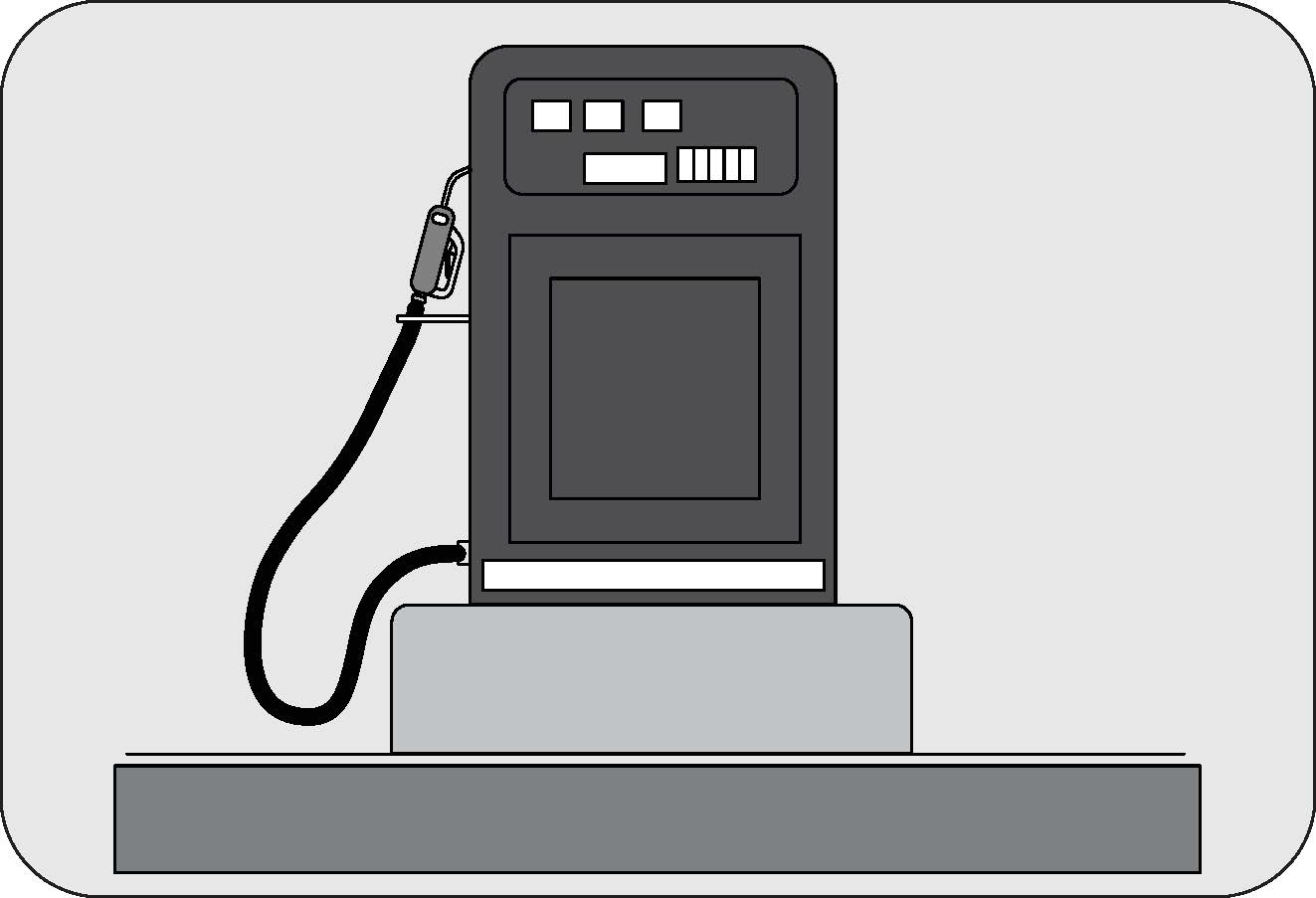
|
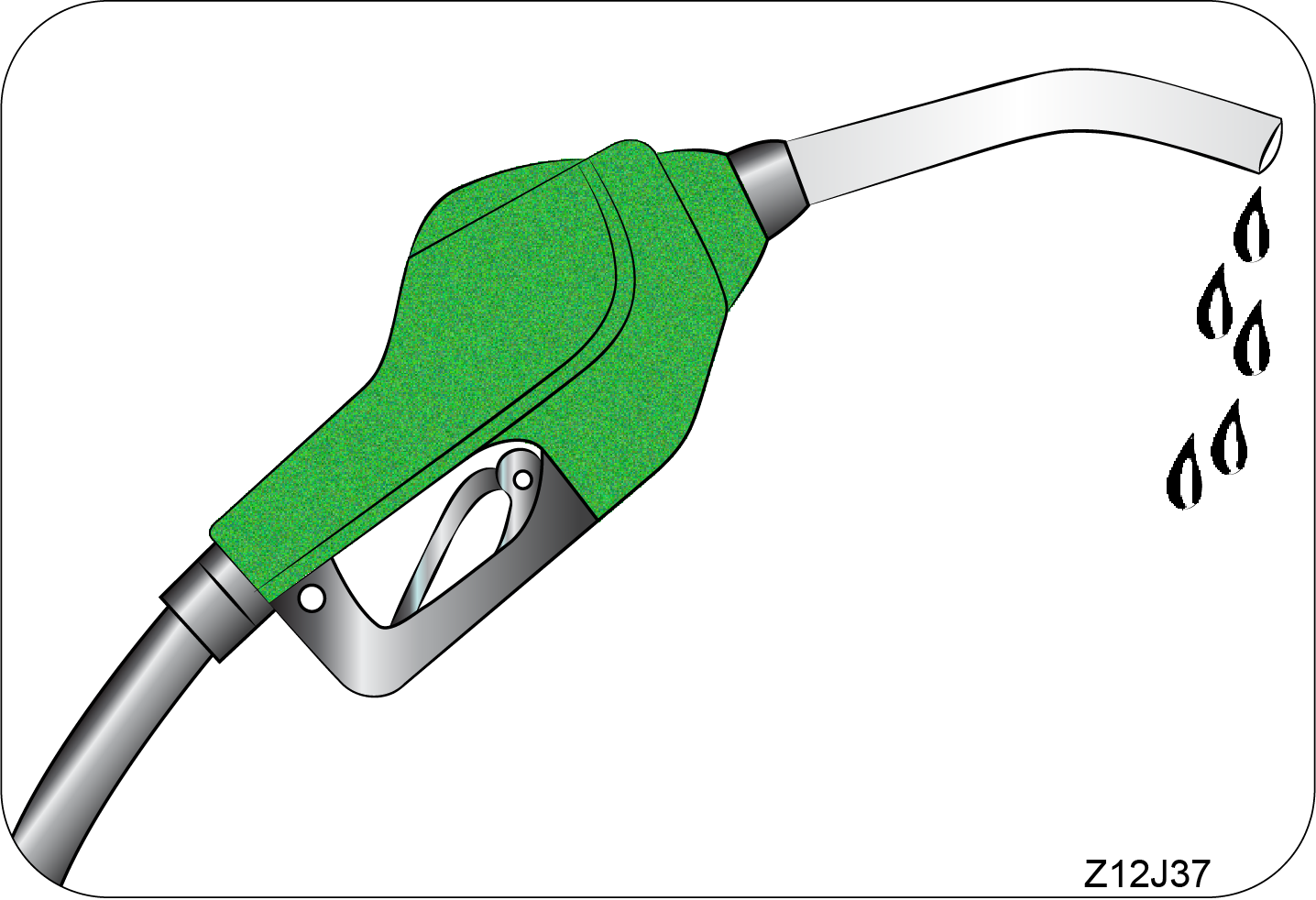
|
For Diesel: Use
commercially
available vehicular Ultra-low Sulfur Highway Diesel that meets the BIS standard (IS 1460; 2017 BS VI
specification
or equivalent). Information on diesel quality can normally be found in the fuel pump.
Please contact filling station personnel in case labels in the pump
cannot be found. If the diesel fuel with high sulfur content
(more than 10 PPM) and unspecified additives are used, it can cause the DPF system damage and emission
warranty issues.
For Petrol: Use only
commercially available Petrol fuel conforming to Indian Standard (IS 2796: 2017 BS-VI specification or
equivalent).
Information on Petrol quality can normally be found in the fuel pump. Please contact filling station
personnel in case labels
in the pump cannot be found.

Stop refueling after the nozzle
automatically shuts off the second time when refueling. Overfilling will lead’s to expansion
space in the fuel tank and fuel system damage.
Always check that the fuel cap
is
installed securely to prevent fuel spillage in the event of an accident

Do not fill the fuel tank or
mix
the fuel with alcohol based fuels, kerosene, etc. This will damage the engine, fuel and exhaust
system components.
If you have accidentally filled
the fuel tank with incorrect or non- approved fuel, do not start the vehicle. Contact an
Authorized
Mahindra Dealer to have the fuel system drained completely.
8.15.1 Fuelling during Winter
During freezing weather, if fuel is not winterised or is
insufficiently winterised, waxing/gelling may start in fuel, leading
to interruption in fuel supply to engine. For smooth functioning and reliable operation of the
engine
during cold weather
conditions, use winterised ULSD which are available at the filling stations during winter months.
Check with your fuel retailer
for further details.

Avoid inhaling fuel vapours
and
any skin or clothing contact. Direct skin contact with diesel /Petrol or the inhalation
of fuel vapour may affect your health.

Diesel/Petrol is highly
flammable and poisonous. It burns violently and can cause serious injury. Never allow sparks,
flames
or smoking materials near diesel/Petrol. Turn OFF the engine before refuelling. Whenever you
are
around diesel/Petrol, extinguish
all smoking materials.
8.15.2 Minimum Fuel Requirement
It is recommended maintaining a minimum of 10 litres of fuel in the
fuel tank. Driving the vehicle till the fuel tank is
empty is not recommended. Always have sufficient fuel in the tank. Check the fuel level prior to
starting your journey.

Never carry fuel in separate
containers in the vehicle, it is dangerous and may lead to inadvertent fuel leak or spillage.
8.16 Brakes
Your vehicle is equipped with disc brakes in the front and
rear
wheels.
Disc brakes offer good braking capability and reduced stopping
distance.
Wet brake discs result in reduced braking efficiency.
After a car wash or driving the vehicle through water, apply and release brake pedal mildly while
driving
to remove the film
of water from the brake disc.

Front & Rear brake
pad
: The Front & Rear brake pads are equipped with
Mechanical Pad Wear Sensors, thus when the brake pads are worn out, there
will be a metallic rubbing noise from the brake pads. Replace the brake pads
immediately
Even if the power assist
(vacuum assistance) is completely lost, the brakes will still work. The brake pedal would
be
much
harder than normal and the vehicle stopping / braking distance will be longer than
usual
In some driving and
climatic conditions may cause a brake squeal when applying first time or lightly applying
the
brake. Squeal
noise may be produced when the vehicle is out of operation for a long time or friction
faces
get rusted after raining. As
long as squeals are produced at a lower frequently there is no need for any special
attention.
Attention: If brake squeal is excessive and occurs on every brake
application, then brakes needs to be checked at your dealership.

Driving with wet brakes is dangerous. Stopping distance increases
considerably while braking
8.16.1 Parking on a
Hill/Incline
If you have to park the vehicle with front side facing the uphill,
select first gear for MT vehicle & park position for AT
vehicles and also turn the front wheels away from the kerb.
If you have to park the vehicle with front side facing
downhill,
select reverse gear and turn the front wheels towards the
kerb.
Always ensure that the vehicle is in gear and parking
brakes is
engaged before leaving the vehicle.
|
|
When parking on an uphill, turn the front wheels
away
from the Kerb/Pavement
|
|
|
When parking on a downhill, turn the front wheels
towards the Kerb/Pavement.
|
8.16.2 Parking Brake
|
|
To apply the parking brake, pull the park brake
lever
up as firmly as possible. When the parking brake is applied with the
ignition ON, the parking brake warning lamp in the instrument cluster illuminates.
|
To release the parking brake, pull the parking brake
lever up
slightly, press the release button on the lever tip and lower
the parking brake lever completely.

The parking brake warning
lamp
indicates only the parking brake status. It does not indicate the degree of brake
application.
Be sure the parking brake is firmly set when parked and the gear shift lever is in gear. When
parking on a hill; first apply
the parking brake; after that shift the TGS lever to the P position (for AT) and gear for MT.
This will avoid the load on
the transmission, locking mechanism may make it difficult to move the shift lever out of
gear.

Be sure the parking brake is
fully disengaged before driving off. Failure to do so can lead to brake problems due to
excessive
heating of the rear brakes. It will also result in reduced fuel efficiency lowered brake pad
life and rear brake squeal
| • | Engaging the parking brake while the vehicle is in motion can cause the rear wheels to lock up. You could lose control of the vehicle and cause an accident |
| • | Always apply the parking brake when leaving the vehicle, and be certain to leave the transmission in gear. Failure to do so may allow the vehicle to roll and cause damage, hit a bystander resulting in personal injury |
| • | Leaving unattended children in a vehicle is dangerous for a number of reasons. Children should be warned not to touch the parking brake or the gear shift lever. Do not leave the key in the ignition. A child could move the vehicle leading to accidents |
| • | The parking brake should always be applied when the driver is not in the vehicle |
8.17 Hazard on Panic Braking
Hazard lamps are turned ON during panic braking for 5
seconds when the
following conditions are met:
| • | Ignition is ON |
| • | Vehicle speed is greater than 50 kmph |
| • | Panic/sudden brake is applied and high deceleration rate is sensed |
8.18 Anti-Lock Brake System (ABS)
The Anti-lock Brake System (also called as ABS) is designed to help
prevent lock-up of the wheels and stable stopping of vehicle
during a sudden, panic emergency braking or braking on slippery road surfaces. The ABS system takes
input
from wheel speed
sensors and brake pedal switch to control the brake fluid pressures at the wheels to avoid wheel
lock-up.
It allows vehicle
to be steered during braking.
The minimum speed for ABS to function is 12 kmph. ABS is
activated
only
during wheel lock conditions where ABS takes over
and prevents wheel lock.
During the ABS operation, a slight pulsation may be felt in the brake
pedal to indicate ABS is active. You may also hear motor
noise from the engine compartment. It is recommended to hold the brake pedal firmly while the ABS is
active rather than pumping
the brake pedal.
Depressing the brake pedal on slippery road surfaces as on a manhole
cover, a steel plate at a construction site, a joint
in a bridge, etc. on a rainy day, tends to activate the anti-lock brake system.
The ABS warning lamp lights up when you switch ON the ignition and
should
go out after a few seconds. If the ABS warning lamp
does not go out or if it comes ON while driving, it means there is a fault in the ABS system. In both
cases, the normal braking
system remains efficient, exactly as on a vehicle without ABS. The vehicle should be examined as soon
as
possible by an Mahindra
Authorised Dealer.
The ABS is not designed to shorten the stopping distance: Always
drive
at a moderate speed and maintain a safe distance from
the vehicle in front of you. The stopping distance may be longer in the following cases:
| • | Driving on rough, gravel or snow-covered roads |
| • | Driving with tyre chains installed |
| • | Driving over the steps such as the joints on the road |
| • | Driving on roads where the road surface is potholes or large differences in surface height |

Do not overestimate the
Anti-lock
Brake System: Although the Anti-lock Brake System assists in providing vehicle control,
it is still important to drive with all due care and maintain a moderate speed and safe distance
from the vehicle in front
of you. There are limits to the vehicle stability and effectiveness of steering wheel operation
even with ABS active.
If tyre grip performance
exceeds
its capability, or if hydroplaning occurs during high speed driving in the rain, the Anti-lock
Brake System will not be able to completely avoid wheel lock-up
8.19 Electric Brake Force
Distribution
(EBD)
EBD is a subsystem of the ABS system, It prevents least loaded wheel
from
locking on application of brakes, thus allows the
wheel to maintain tractive contact with the road surface. The system monitors the wheel speed and when
it
identifies any slip,
the pressure in the wheel cylinders is dumped thus preventing the wheels from locking.
A fault with EBD is indicated by illumination of the parking brake as
well as ABS warning lamps. The vehicle should be examined
as soon as possible by an Mahindra Authorised Dealer.
8.20 Electronic Stability Program
(ESP)
(if equipped)
This system enhances directional control and stability of the vehicle
under various driving conditions. The ESP corrects for
over-steering and under-steering behavior of the vehicle by applying the brake on the appropriate
wheel
automatically.
ESP uses inbuilt sensors to determine the path that the driver intends
to
steer the vehicle , compares it to the actual path
of the vehicle. When the actual path does not match the intended path, the ESP applies the brake of
the
appropriate wheel
to assist in counteracting the condition of over-steer or under-steer.
|
|
Over-steer -
When the vehicle is turning more than appropriate for the steering wheel position.
Under-steer
-
When the vehicle is turning less than appropriate for the steering wheel position.
|

The ESP cannot overrule the
natural laws of physics from acting on the vehicle, nor can it increase the traction due to
the prevailing road conditions. The ESP cannot prevent accidents, including those resulting from
excessive speed in turns,
driving on very slippery surfaces, or hydroplaning. Only a safe, attentive, and skilful driver
can
prevent accidents. The
capabilities of an ESP-equipped vehicle can not compensate for reckless or dangerous driving
that
could endanger the user’s
safety or the safety of others on road or passerby.
8.20.1 ESP ON
Whenever the vehicle is started, the ESP system will be in active
mode. This mode should be used for most driving conditions.

When the ESP is in
operation,
ESP indicator lamp will blink in the instrument cluster.
When the ESP is operating,
you
can feel a slight pulsation in the brake pedal. This is normal and indicates that braking
had gone to ABS zone. Suggest that the driver should slow down the speed are not matching the
road surface.
When moving out of the mud
or
slippery road, accelerator response may be different because ESP system controls the engine
RPM to come out of this slippery road condition. This is normal.
8.20.2 ESP OFF
In some driving conditions, to maximize traction, it may
be
beneficial
to de-activate ESP.
Such conditions are:
| • | To start in deep snow or on a loose surface |
| • | Driving in deep sand |
| • | Driving through deep mud etc. |
To de-activate ESP, press ESP OFF button on the driver control
switch
bank. Once ESP OFF mode is selected, a warning indicator
illuminates in the instrument cluster.
Press ESP OFF button again to activate ESP function.

For safety reasons, ESP will
be
automatically re-activated once the vehicle speed crosses 64 kmph
Mahindra recommends that ESP
be
operational in all normal driving conditions.
When ESP is in OFF mode,
other
functions like HHC (Hill Hold Control), HBA (Hydraulic Brake Assist), HDC (Hill Descent
Control),
DTC (Drag Torque Control), ROM (Roll Over Mitigation) will be available
ESP, by default, will be in
ON
condition for every ignition cycle.
If the ESP indicator blinks while driving, it indicates that ESP
is
working. However If this lamp is blinking continuously
or remains ON, it indicates a malfunction in the ESP system. Drive carefully to the nearest
Mahindra Authorised Dealer and
get the ESP system checked.
8.21 Hydraulic Brake Assist (HBA)
The HBA function is designed to optimize the vehicles braking ability
during emergency braking situations, the system detects
a panic braking situation by sensing the rate and amount of brake application and generates an
additional
brake-force boost
to the driver if required.
During a panic braking situation, the brake pressure is raised to the
locking pressure. For the HBA to become active, the
brake Pedal must be pressed throughout the braking maneuver, that is the brakes must not be pumped and
released.

The HBA function gets deactivated, when the brake pedal is released
thus do not release brake pressure unless braking is no
longer needed

| • | The HBA system cannot prevent collisions, the capabilities of an HBA equipped vehicle must never be exploited in a reckless or dangerous manner that could risk the user’s safety. |
| • | The Safety of the vehicles always lies in the hands of the driver, never rely on the HBA feature to prevent accidents. |
8.22 Hill Descent Control (HDC) (if
equipped)
This System assists the driver to descend a steep slope by means of
brake
intervention limiting the vehicle speed without
driver's input on brakes. This does not replace cruise control
During HDC, if the wheel slip becomes excessive, ABS will
be activated
automatically.
HDC is a user-intended function. To activate, press HDC button on the
driver control switch bank. The LED on the button illuminates
indicating the status. Press the button again to deactivate HDC.
The HDC feature can control the vehicle speed from 9 kmph to 35 kmph,
Above 35 kmph the HDC feature will go to ready mode.
The HDC feature will be deactivated automatically if vehicle speed is more than 60 kmph. (For
Activating
the HDC feature again,
the driver needs to press the HDC button once again within the specified speed limits)
The HDC should be enabled only on steep gradient. It is not
recommended
to be ON in plain road- to avoid accidental intervention
While HDC is controlling the vehicle speed, descent speeds
can be
varied
by cruise buttons, accelerator pedal & brake pedal.
To Set the desired descending speed, follow the steps listed below:
| • | SET Speed — This is the driver desired speed at which vehicle should descent. This can be set using HDC switch or brake/accelerator pedals.(example: when the driver activates HDC at a speed of 30 kmph, then set speed will be 30 kmph). HDC will limit vehicle descent speed to set value). |
| • | If driver presses the accelerator pedal and increases the speed from 30 kmph to 34 kmph and then releases the accelerator pedal. Now the new SET speed will be 34 kmph |
| • | Similarly, if the driver applies brake and reduces the speed from 30 kmph to 10 kmph and then releases the brake pedal, now the new SET speed will be 10 kmph |
| • | If the vehicle cruise speed is with in the HDC active region, similarly the set speed can be modified using cruise +/- buttons (by tapping the “SET —” or “SET +” buttons. Each press of the button will adjust the speed by approximately 0.5 kmph) |
The descent speed increases only if the gradient is sufficiently steep
to
cause the vehicle to accelerate as the braking effect
is reduced. On a shallow slope, pressing the “SET +” button may result in no speed increase.
8.23 Hill Hold Control (HHC) (if
equipped)
Imagine a situation where your vehicle is stopped on an uphill
incline.
If you release the brake while moving off, there are
chances that your vehicle may roll back. HHC helps in such situations by holding the vehicle from
rolling
back.
Hill Hold Control function uses the inbuilt acceleration sensor to
identify the gradient and holds the vehicle for 2 seconds
in MT and 1 seconds in AT vehicles after the brake pedals are released. If the driver does not apply
the
throttle before this
time expires, the system will release brake pressure and the vehicle will roll down the hill as normal
The Following conditions must be met in order for the HHC
to activate:
| 1. | The Vehicle must be equipped with HHC |
| 2. | The vehicle must be on sufficient gradient |
| 3. | The Parking brake must not be applied |
| 4. | Engine must be running |

The HHC will function on both vehicle facing Up hill and vehicle
facing downhill, provided the correct gears are selected.
| • | Vehicle Facing Uphill – Gear should be in Forward |
| • | Vehicle Facing Downhill – Gear should be in Reverse |
For Manual Transmission only, Neutral will be considered as Forward
Gear.

| • | In some situations, when the conditions are not met, the HHC may not get activated. In such cases slight rolling may occur. |
| • | The Safety of the vehicles always lies in the hands of the driver, never rely on the HHC system to prevent rolling. |
8.24 Roll Over Mitigation (ROM)
Roll Over Mitigation system is a safety function which anticipates the
wheel lift due to lateral forces. The ROM function
analyses the rate of change of steering wheel angle and the wheel speed to determine any possible
wheel
lift, the system then
applies appropriate brake and may also reduce the engine power to reduce the chances of wheel lift.
In any instance where physical limits of Long. and lateral tyre road
grip
are not exceeded, RMF reduces the lateral forces
that will lead to a critical roll moment about the center of gravity.
Minimum Vehicle speed for ROM = 25 kmph
Maximum Vehicle speed for ROM = 120 kmph

| • | Many factors, such as vehicle loading, road conditions and driving conditions, influence the chance that wheel lift or rollover may occur. |
| • | The ROM system cannot prevent all roll overs; thus ROM equipped vehicle must never be exploited in a reckless or dangerous manner which could jeopardize the user's safety or the safety of others. |
8.25 Brake Disc Wiping
When a vehicle is driven in a wet condition; the
accumulated wetness
on
the brake disks leads to an elongated brake response
time.
The BDW function actuates the brakes with a low pressure, such that;
the
brake pads comes in contact with the rotating brake
disks, creating a wiping action; thereby removing the moisture from the brake disks.
For the Brake Disc Wiping function to get activated, the
following
conditions must be met.
| 1. | Vehicle speed above 70kmph. |
| 2. | Accelerator Pedal must be pressed. |
| 3. | The Wipers must be in ON condition (Low/High Speed) |
The Pressure generated in the BDW function is very small
and this is
not
felt by the driver during normal driving conditions.

| • | The system will not be able to sense water splashed on disc from situations such as water wash or water puddles. |
| • | It is suggested that the driver dry the brakes in the above said conditions by driving at very slow speed and applying the brakes lightly until the brake performance becomes normal. |
8.26 Electric Brake Prefill - EBP
EBP is a value-added feature in ESP, the target of the function is to
reduce the air gap of the wheel brake by putting low
brake pressure to the brake pads such that the brake pads come in close proximity to the brake
disc.
The system detects an emergency braking by monitoring the rate of release of the acceleration pedal. A sudden release of accelerator pedal signifies an upcoming sudden braking.
By actively pre-filling the brake-system, the brake response time is reduced for an upcoming braking and full vehicle deceleration is achieved earlier. This results in a shorter stopping distance.
The system detects an emergency braking by monitoring the rate of release of the acceleration pedal. A sudden release of accelerator pedal signifies an upcoming sudden braking.
By actively pre-filling the brake-system, the brake response time is reduced for an upcoming braking and full vehicle deceleration is achieved earlier. This results in a shorter stopping distance.
8.27 Driver Drowsiness Detection
System
(DDD)
The Driver Drowsiness Detection system advises the driver to take a
break
from continuous long duration driving when driver
fatigue can be detected based on the driver's steering behavior. The system evaluates the steering
behavior at speeds of 60-200
km/h.
Conditions under which a break from driving is detected by the system are as follows.
Conditions under which a break from driving is detected by the system are as follows.
| • | The vehicle is stopped and the ignition switched off. |
| • | The vehicle is stopped, the seat belt removed, and the driver's door opened. |
| • | The vehicle is stopped for more than 30 minutes. |
If none of these conditions are met or if the driving style
is not
changed, the system recommends a driving break again after
15 minutes.
The Drowsiness alert should be enabled in the driver
assistance
screen.
|
Pause
Recommendation
|
|
|
|
This alert comes in the display of instrument cluster
when
the system detects the driver is quiet sleepy or very sleepy,
along with audible signal.
|

| • | When the vehicle is driven continuously for more than 2 hours and if the system detects driver as “Quite Sleepy”, an alert message along with audio signal appears in the instrument cluster. Cluster will display the alert message till the user presses the “OK” button from steering wheel switch. |
| • | After pressing the OK button, if break is not detected by the system for next 15 minutes, alert message will repeat again. If the drowsiness is continuously sensed and if the system detects driver as “Very Sleepy”, next level alert message & audio signal will be triggered along with steering wheel haptic feedback. |
Driver Attention Level: The
Driver attention level is calculated based on driving behavior and many external parameters and the
attention level is
displayed to the driver in the Drive Info Tab
|
Driver
Attention Level
|
Description
|
|---|---|
|
|
Very Awake
|
|
|
Quite Awake
|
|
|
Neither Awake nor Sleepy
|
|
|
Quite Sleepy
|
|
|
Very Sleepy
|

| • | The driving ability is always the driver's responsibility. Never drive if you feel tired. |
| • | The system may not detect all cases where a break is needed. |
| • | Therefore, take regular, sufficient breaks during long trips. |
| • | There will be no system warning during the so-called micro-sleep. |

| • | In some situations, the system can evaluate the steering behavior incorrectly and therefore falsely display a break recommendation. |
| • | The system is designed primarily for use on highways. |
9 STARTING AND DRIVING 2
9.1 Wheels and Tyres
9.1.1 Tyre Information
|
A
|
RADIAL TYRES OR BIAS-PLY TYRE
|
|
B
|
“TUBELESS” OR “TUBE TYPE”
|
|
C
|
TYRE SIZE
|
|
D
|
MAX. LOAD LIMIT
|
|
E
|
TREAD WEAR
|
9.1.2 Tyre Rating
Your vehicle is originally equipped with tyres supplied by a
reputable
manufacturer. If you ever have any questions regarding
your tyres, please refer to literature supplied by the tyre manufacturer, or to the separate tyre
warranty provided by the
tyre manufacturer. You may also contact Mahindra Authorised Dealer directly, or the tyre
manufacturer.
The tyre rating of your vehicle is:
| • | 245/65 R17 107 H |
| • | 255/60 R18 108H |
Tyre rating is explained as below:
Tyre size (Example: 245/65 R17
107H)
Callout (A) : 245 (Three-digit number) : This number gives the width in millimetres of the tyre from sidewall edge to sidewall edge. This is called as “Section Width”.
Callout (A) : 245 (Three-digit number) : This number gives the width in millimetres of the tyre from sidewall edge to sidewall edge. This is called as “Section Width”.
Callout (B) : 65
(Two-digit
number) : This number, known as the aspect ratio, gives the tyres ratio of height to
section
width.
Callout (C) : R
: This is
the Tyre Construction Code. The “R” stands for Radial.
Callout (D) :17
(Two-digit number)
: This number is the wheel or rim diameter in inches.
Callout (E) :107
(Two or
three-digit number) : This number is the tyres load index. It is a measurement of how
much
weight each tyre can support.
Callout (F) : H :Tyre
speed
rating or speed symbol. Never drive the vehicle faster than the tyre speed rating. The speed rating
denotes the
speed at which a tyre is designed to be driven for extended periods of time under a standard
condition
of load and inflation
pressure.
9.1.3 Speed Rating
| SPEED SYMBOL | MAX. SPEED CAPABILITY |
|---|---|
| KM/HR | |
|
L
|
120
|
|
M
|
130
|
|
N
|
140
|
|
P
|
150
|
|
Q
|
160
|
|
R
|
170
|
|
S
|
180
|
|
T
|
190
|
|
U
|
200
|
|
H
|
210
|
|
V
|
240
|
|
W
|
270
|
|
Y
|
300
|
|
Z
|
240+
|
9.1.4 Tyre Label (Vehicle
Placard)
|
|
Tyre Label (Vehicle Placard) is located on the
driver
side inner B-pillar.
|
this placard tells you important information about tyre size
designed
for your vehicle, and the tyre inflation pressures
for the front & rear tyres.

Never overload your vehicle. Overloading can cause tyre failure,
affect vehicle handling, and increase your stopping distance,
resulting in an accident and/or serious personal injury.
Improper inflated tyres can adversely affect vehicle handling or
can fail unexpectedly, resulting in an accident and/or
serious personal injury.
| Regular Tyre | SpareTyre | |
|
Dynamic Rolling radius (mm)
|
364 +/- 7
|
|
9.1.5 Tyre Pressure
Proper Tyre inflation pressure is essential to the
safe and
satisfactory operation of your vehicle. Three primary areas are
affected by improper Tyre pressure:
| • | Safety |
| • | Economy |
| • | Ride Comfort and Vehicle Stability |
Proper Tyre inflation contributes to a comfortable and safe
ride.
Over-inflation produces a jarring and uncomfortable ride.
Both under-inflation and over-inflation affect the stability of the vehicle and can produce a
feeling of sluggish response
or over responsiveness in the steering. Unequal Tyre pressures can cause erratic and
unpredictable
steering response or may
cause the vehicle to drift left or right.
Improper inflation pressures can cause uneven wear patterns to
develop across the Tyre tread. These abnormal wear patterns
will reduce tread life resulting in a need for earlier Tyre replacement. Under inflation also
increases Tyre rolling resistance
and results in higher fuel consumption.

The proper cold Tyre
inflation pressure is listed in the Tyre Label (Vehicle Placard), located on the front
passenger side
inner B-pillar.
9.1.6 4XPLOR mode
|
4XPLOR
Mode
|
Traction
/Drive
|
Mode
|
Recommended tyre pressure
|
||
|
17
Tyre
|
18
Tyre
|
Caution
|
|||
|
NORMAL (Tarmac & Cement surface)
|
2WD
|
Normal
|
34 PSI
|
34 PSI
|
-
|
|
4WD
|
Normal- 4H
|
34 PSI
|
34 PSI
|
||
|
GRASS / SNOW
|
4WD
|
Snow- 4 H
|
34 PSI
|
34 PSI
|
Reduce
speed
to keep the vehicle under control and avoid giving aggressive steering
input.
If Manual
transmission try to start in 2nd
gear unless in steep gradient.
|
|
MUD & RUTS
|
4WD
|
Mud- 4H
|
34 PSI
|
34 PSI
|
Reduce
speed
to keep the vehicle under control and avoid giving aggressive steering
input.
|
|
SAND
|
4WD
|
Sand 4 H
|
Lower pressure as appropriate
|
Lower pressure as appropriate
|
Needs to
maintain the vehicle momentum on soft surfaces to move ahead & Engine
RPM
maintained to be higher
Avoid
braking and giving sharp steering input.
|
|
In the
snow
or mud or sand. The default 4H will be ON. However if the vehicle gets
badly
stuck and not able to come out then
4L can be used to come out of the tricky situation and shift to 4H as soon
as
possible.
Similarly
when the tyre pressure is reduced to drive in Sand. As soon as the sand is
over fill tyre pressure. If pump not
available , drive with reduced speeds to the nearest tyre shop/ fuel
bunk.
|
|||||
9.1.7 Inspection and Adjustment
Procedure
The Tyre pressure should be checked and adjusted, as well as
inspected
for signs of Tyre wear or visible damage, at least
once a month. Use a good quality pressure gauge to check Tyre pressure. Do not make a visual
judgement
when determining proper
inflation. Radial Tyres may look properly inflated even when they are underinflated. At the same
time,
each Tyre should be
inspected for signs of Tyre wear or visible damage.
Inflation pressures specified on the placard are always cold Tyre
inflation pressures. Cold Tyre inflation pressure is defined
as the Tyre pressure after the vehicle has not been driven for at least three hours, or driven less
than 1 km after a three-hour
period. Check Tyre pressures more often if subject to a wide range of outdoor temperatures, as Tyre
pressures vary with temperature
changes. Tyre pressures change by approximately 1 psi (7 kPa) per 7°C of air temperature change.
Keep
this in mind when checking
Tyre pressure inside a garage, especially in the winter.
When it was new, the spare Tyre in your vehicle was fully inflated.
However, a spare Tyre can lose pressure over time. In
order to avoid being stranded, check the spare Tyre air pressure frequently.
9.1.8 Inflating Your Tyres
Safe operation of your vehicle requires that your Tyres
are properly
inflated. Remember that a Tyre can lose up to half of
its air pressure without appearing flat.
At least once a month or before long trips, inspect each Tyre and
check the Tyre pressure with a Tyre gauge (including spare
Tyre). Inflate all Tyres to the recommended inflation pressure.

Under-inflation is the most
common cause of Tyre failures and may result in severe Tyre cracking, tread separation or
“blowout”,
with unexpected loss of vehicle control and increased risk of injury. Under-inflation
increases
sidewall flexing and rolling
resistance, resulting in heat buildup and internal damage to the Tyre. It also may result in
unnecessary Tyre stress, irregular
wear, loss of vehicle control and accidents.
| • | Over or under inflation may reduce the tyre life |
| • | Do not correct the tyre pressure immediately after the vehicle is stopped after operation, server handling or long distance drive. Check the inflation pressure when the vehicle is idle for 3 hours or 10 minutes of driving after 3 hours in idle condition |
| • | Do not drive the vehicle with lower pressure than recommended, which may lead to over heating of sidewall resulting in tyre damage |
| • | Check the tyre pressures once in a month or before long distance travels |
| • | Check your tyres regularly for any damages or cut on the sidewall. Please replace the tyres immediately. |
Always inflate your Tyres to the recommended pressure even if it is
less than the maximum inflation pressure information found
on the Tyre. The recommended Tyre inflation pressure is found on the Tyre Label which is located on
the front passenger side
inner B-pillar. Failure to follow the Tyre pressure recommendations can cause uneven tread wear
patterns and adversely affect
the way your vehicle handles.

If you overfill the Tyre,
release air by pushing the metal stem in the centre of the valve. Then recheck the
pressure.

After inspecting or
adjusting
the Tyre pressure, always reinstall the valve stem cap (if equipped). This will prevent
moisture
and dirt from entering the valve stem, which could damage the stem, resulting in an
unexpected
loss of Tyre pressure, an accident
and/or personal injury.
9.1.9 Radial Ply Tyres

Combining radial ply Tyres
with
other types of Tyres on your vehicle will cause your vehicle to handle poorly, resulting in
an accident and/or personal injury. Always use radial Tyres in sets of four. Never combine
them
with other types of Tyres.
Cuts and punctures in radial
Tyres are repairable only in the tread area because of sidewall flexing. Consult your
Mahindra
Authorised Dealer for radial Tyre repairs.
9.1.10 Tread Wear Assessment
Tyre wear can be assessed by looking the tyre wear indicator (TWI).
The TWI will appear as a band across the tyre tread when
the tyre wears out to the minimum allowed tread depth of 1.6 mm
Tyre Wear Indicator
(TWI)
A mark of triangle in the Tyre side wall indicates the
position of the
Tyre wear indicators at 6 to 8 locations around the
circumference of the tyre.
The TWI appear as raised portions inside the tread in a
new or
partially worn tyre (A).
As the tyre wears out to its minimum allowable tread
depth, the TWI
will appear as a band across the tyre tread (B).
The tyre should be replaced at this stage or before this
stage.
|
New
Tread
(A)
|
Worn
Tread
(B)
|
|
|
|

It is extremely dangerous to drive with worn out tyres
on wet roads/rainy
seasons. The vehicle can skid and aquaplane on wet
surfaces, if the tyre tread depth is insufficient.
Replace the tyre before the tyre tread depth reached
the minimum
acceptable limit.
9.1.11 Life of Tyre
The service life of a Tyre is dependent upon various
factors including
but not limited to:
. Driving style 00 . Tyre pressure 00. Distance driven

Tyres and the spare Tyre should be replaced after six
years,
regardless of the remaining tread. Failure to follow this warning
can result in sudden and unexpected Tyre failure, leading to an accident and/or
personal injury.
Do not use a Tyre, wheel size or speed rating other than
that
specified for your vehicle on the Tyre placard. Combinations
of unapproved Tyres and wheels may change suspension geometric and performance
characteristics, resulting in changes to steering,
handling and braking of your vehicle. This can cause unpredictable handling, stress
to
steering and suspension components.
You could lose control of the vehicle or the Tyre can unexpectedly fail, resulting
in
an accident and/or personal injury.

Keep dismounted Tyres in a cool, dry place with as little
exposure to light as possible. Protect Tyres from contact with oil,
grease and fuels.
Replacing original Tyres with Tyres of a different size may
result in false speedometer and odometer readings.
9.1.12 Snow Chains
Snow chains cannot be used on these Tyres.

In case of harsh winter
driving
conditions, it is recommended using winter Tyres with the same specifications for better
stability,
safety and performance.
9.1.13 Tyre Rotation
Recommendations
|
Type 1 -
Applicable for RWD & 4WD Vehicles - 5 Steel Wheels
|
|
|
|
Tyres on the front and rear axles of vehicles
operate
at different loads and perform different steering, handling, and braking
functions. For these reasons, they wear at unequal rates and develop irregular wear
patterns.
|
Rotation will increase tread life, help to maintain mud, snow, and
wet
traction levels, and contribute to a smooth, quiet
ride. Follow the recommended tyre rotation frequency for your type of driving.
Type 2 – Applicable
for RWD &
4WD Vehicles - 4 Alloy Wheels
It is recommended rotating the tyres as per the
“Maintenance
Schedule”.
The suggested rotation method is the “forward-cross” shown in the
diagram. The benefits of rotation are especially worthwhile
with aggressive tread designs such as those on On/Off-road type tyres.
|
|
Rotation will increase tread life, help to maintain
mud, snow, and wet traction levels, and contribute to a smooth, quiet
ride. Follow the recommended tyre rotation frequency for your type of driving.
|
More frequent rotation is permissible if desired. The
reasons for any
rapid or unusual wear should be corrected prior to rotation
being performed.
9.1.14 Non-Standard Spare Wheel
|
|
The Non - standard spare wheel provided on your
vehicle
is for temporary purpose only. Do not use the spare wheel for continuous
running.
|
When Using the
Non-Standard Spare
Wheel
| • | Non - Standard Spare wheel provided specifically designed for your vehicle. Do not use your non standard spare tyre on another vehicle. |
| • | Do not use more than one non-standard Spare Wheel simultaneously. |
| • | Drive the shortest possible distance with Non-standard Spare Wheel. |
| • | While using Non standard spare wheel reduce speed, Avoid sharp cornering, Avoid sudden acceleration, abrupt steering, sudden braking and shifting operations that cause sudden engine braking. |
When Non-Standard
Spare Wheel is
attached
The vehicle speed may not be correctly detected, and the
following
systems may not operate correctly:
ABS, Cruise control (If equipped), EPS, Rear View
monitor system (If
equipped), Navigation system (If equipped)
Speed Limit when
using
Non-Standard Spare tyre
Do not drive at speeds in excess of 80 km/h when a
Non-standard Spare
Wheel is installed on the vehicle.
The Non-Standard Spare Wheel is not designed for driving
at high
speeds. Failure to observe this precaution may lead to an
accident causing death or serious injury.

| • | The vehicle becomes lower when driving with the Non Standard Spare tyre compared to when driving with standard tyres. Be careful when driving over uneven road surfaces. |
| • | Inflate the tyres as per manufacturers recommendation, refer Tyre pressure label on the door panel |
| • | TPMS is not provided in spare wheel |
| • | Do not fit tyre chains to the spare tyre. Tyre chains may damage the vehicle body and adversely affect driving performance. |
| • | Tyre to be loaded within the max allowable load limit specified by the load rating index marked on the tyre. |
| • | Tyre to be operated with in the speed limit specified by the speed rating index marked on the tyre |
| • | Do not use the tyre for longer distance than recommended. Repair & refit the regular tyre as soon as possible. |
| • | Recommended to drive Max 50 km in a stretch or reach nearest Mahindra Authorised Dealer |
| • | Refer the Feature Matrix for the spare wheel size |
9.1.15 Changing a Flat Tyre
Refer to “Changing a Flat Tyre” section in the
Emergencies chapter for
details.
9.1.16 Wheel Tightness
When you change a wheel, remove all rust and dirt at all locations
where the wheel contacts the wheel hub. Use a scraper or
wire brush to be sure that you remove all rust and dirt. A loose wheel could have damaged or
elongated
the holes in the rim,
or damaged the rim/hub assembly. If any of the wheel nuts are damaged, contact the nearest Mahindra
Authorised Dealer.

Always tighten the nuts in a
criss-cross sequence. Never use oil or grease on your wheel nuts.
Never overtighten the nuts
on
the wheel stud. You could damage the wheel stud or the nut.
Torque tighten the wheel
nuts
to the specified value at the nearest Authorised Mahindra Workshop.

The tyres fitted in this
vehicle meet the requirements of BIS and they comply with the requirements under the Central
Motor
Vehicles Rules (CMVR) 1989.
9.2 Tiretronics (if equipped)
The tiretronics system checks the pressure and temperature of the air
inside the pneumatic tyres of the vehicle. System alerts
the driver during driving if any of the tyre parameters are not in acceptable limits due to any
reason.
The system will continue to alert until the warning
condition is resolved
to the actual placard values.
Appropriate tyre pressure and tyre temperature is required
for;
| • | Adequate braking |
| • | Road grip |
| • | Vehicle handling |
| • | Vehicle maneuvering |
| • | Reduced tyre wear and tear |
| • | Reduced tyre strain and safety |
| • | Good fuel efficiency |
The instrument cluster displays all alerts & visual
warnings related
to Tiretronics system.

|

|
9.2.1 Operation of Tiretronics
Tiretronics uses wireless sensor technology that is mounted on the
wheel rim to checks the tyre pressure levels. They transmit
the data to the receiver inside the vehicle which is in turn is communicated and displayed on the
instrument cluster.
In the instrument cluster screen all the tyre locations will
display
the status as pressure and temperature. Spare tyre (if
TPMS sensor equipped) information on tiretronics screen shall be available only during any alerts
and
warning in the spare
tyre. (User Shall verify spare tyre pressure manually, In certain conditions system may not update
pressure for Spare tyre
correctly)
The Tiretronics has been customized only for the manufacturer’s
genuine tyres and wheels. Tiretronics pressure limits and
warning messages have been established and calibrated for the tyre size equipped on your vehicle.
Replacement of manufacturer’s
parts with a different size, type or style of components may damage the sensor and lead to
incorrect
readings.
Do not use aftermarket tyre sealants or balance beads if your
vehicle
is equipped with Tiretronics. Failure to comply may
lead to sensor damage.
The Tiretronics is not intended to replace normal tyre care and
maintenance or to warn of any tyre failure condition. The
system should not be used as a replacement for a pressure measuring gauge to adjust the vehicle
tyre
pressure.
Driving with under-inflated tyres cause the tyres to overheat and
may
lead to tyre failure. Under-inflated tyres reduce fuel
efficiency, tyre tread life and may affect the vehicle's maneuverability and braking ability.
It is the driver's responsibility to maintain correct tyre pressure
using an accurate pressure gauge, even if under-inflation
has not reached the level to trigger illumination of the Tiretronics warning indicator.
9.2.2 Tiretronics Warning Lamp
The Tiretronics warning lamp in the instrument cluster illuminates
for
any alert condition and also for low/high tyre pressure/High
temperature alerts and malfunction.
9.2.3 Tiretronics Sensor
Installation
|
|
First apply lubricant (paste) or soapy water to rim
hole or valve nozzle bar, as shown in the following figure (the diagram
is for reference only, and it is operated according to the degree of automation of
the
customer's production line)
|
|
|
|
| 1. | Line the sensor up with the rim hole and attach the TTV insertion tool to the end of the valve ready for pull in |
| 2. | Ensure the TTV insertion tool is positioned to the correct notch and that the sensor is pulled through in a direction parallel to the valve whole axis and NOT at an angle to it |
| 3. | The picture below shows a correctly fitted sensor. Note the rubber bulb of the valve resting against the rim and the front face of the enclosure is NOT touching the rim. Apply tyre soap solution to the rubber portion of the valve stem and the top of the enclosure |
| 4. | Place the inner tyre bead over the rim |
| 5. | Place the outer tyre bead over the rim |
| 6. | Inflate all tyres to the prescribed pressure, check the valve area for leakage and re-balance the wheels prior to installing back on the vehicle |

Starting to mount the tyre
from
the valve location is a wrong fitment. The fixing tool/stem may hit the sensor and damage
it. Start from the opposite direction.
9.2.4 Tiretronics Sensor Removal
|
|
|
| • | Remove the tread and ensure that the extractor
forceps is inserted into the tyre at the yellow position shown below and turn
the rim clockwise.
|
| • | To remove the sensor, firstly remove the screw
using
a T6 TORX screwdriver.
|
|
|
|
| • | Cut the rubber bulb and attach the TTV tool to the valve. Remove the valve from the rim by pulling through the rim, or simply pull through without cutting the bulb |
| • | Lift the outer tyre bead over the rim using a tyre tool |

The valve must be positioned
just left of the start position to avoid sensor damage. Do not touch the sensor with the tyre
tool.
| • | Lift the inner tyre bead over the rim using the tyre tool |
| • | Remove existing valve stem |

Starting to mount the
tyre
from the valve location is a wrong fitment. Fixing tool/stem may hit the sensor and damage
it.
Start from the opposite direction.
9.2.5 Functionalities of
Tiretronics System
| • | Low Pressure Alert |
| • | High Pressure Alert |
| • | Pressure Leakage Alert |
| • | Sensor Signal Missing (Communication error) |
| • | Tiretronics Sensor Faulty. |
| • | Tyre Auto Learn |
| • | Tyre Fill Assist (TFA) |
| • | Tyre Pressure Imbalance |
Low Pressure
Alert
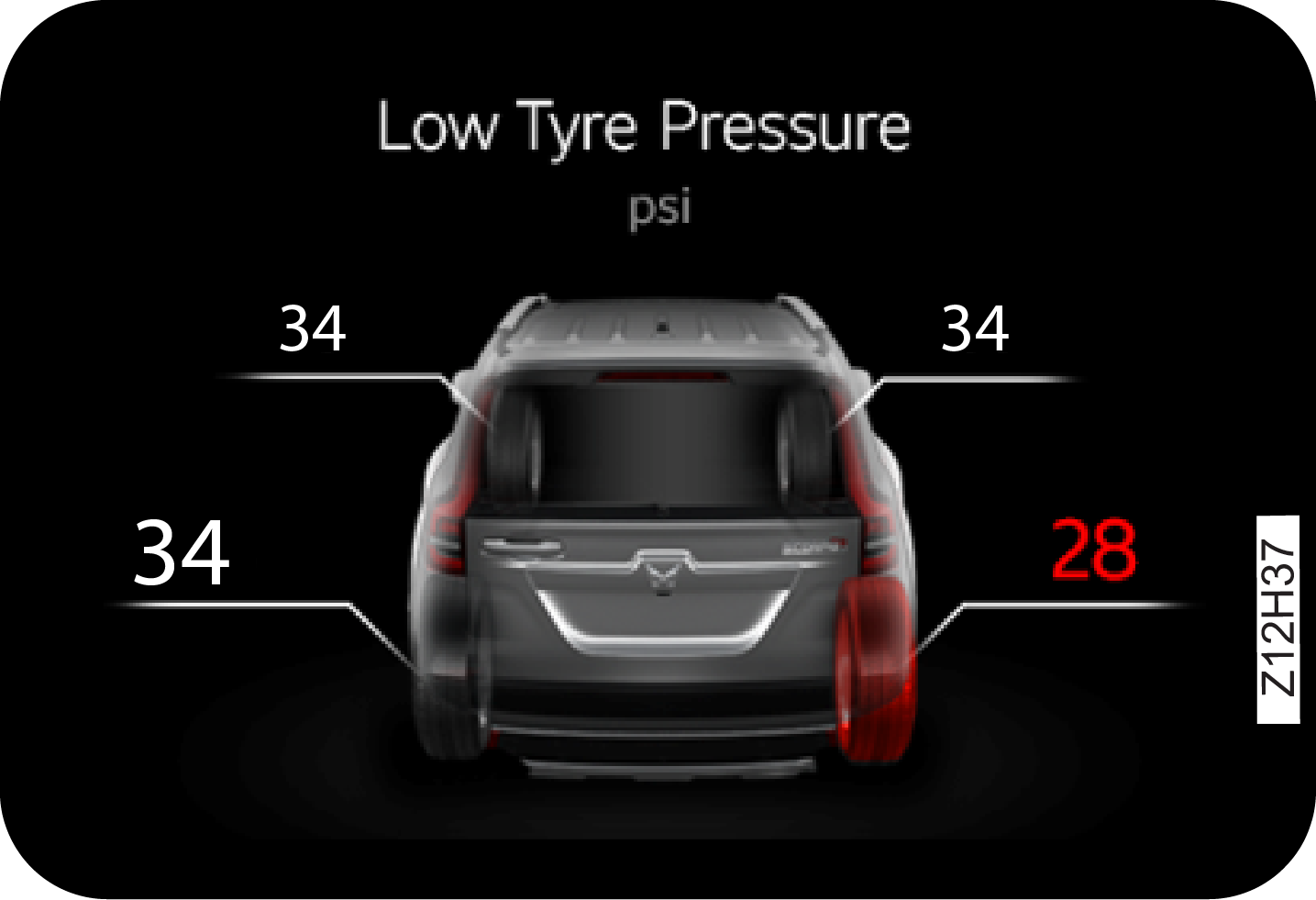
|
Low pressure monitoring is to indicate low tyre
pressure. Please note the following points.
|
| • | Low pressure alert will be set only when the tyre pressure value goes below threshold. Low pressure will be set based on the temperature value. |
| • | Low pressure alert in the main alert screen will pop up once for driver notification when the alert is set and the vehicle is in running condition. Otherwise the alert will remain in the information screen and alert register screen |
| • | If low pressure is observed, respective tyre should be rectified with cause of low pressure and then fill air |
| • | Once low pressure alert is set with tyre pressure below threshold the alert shall not be cleared until the pressure is filled to the placard value |
High Pressure
Alert
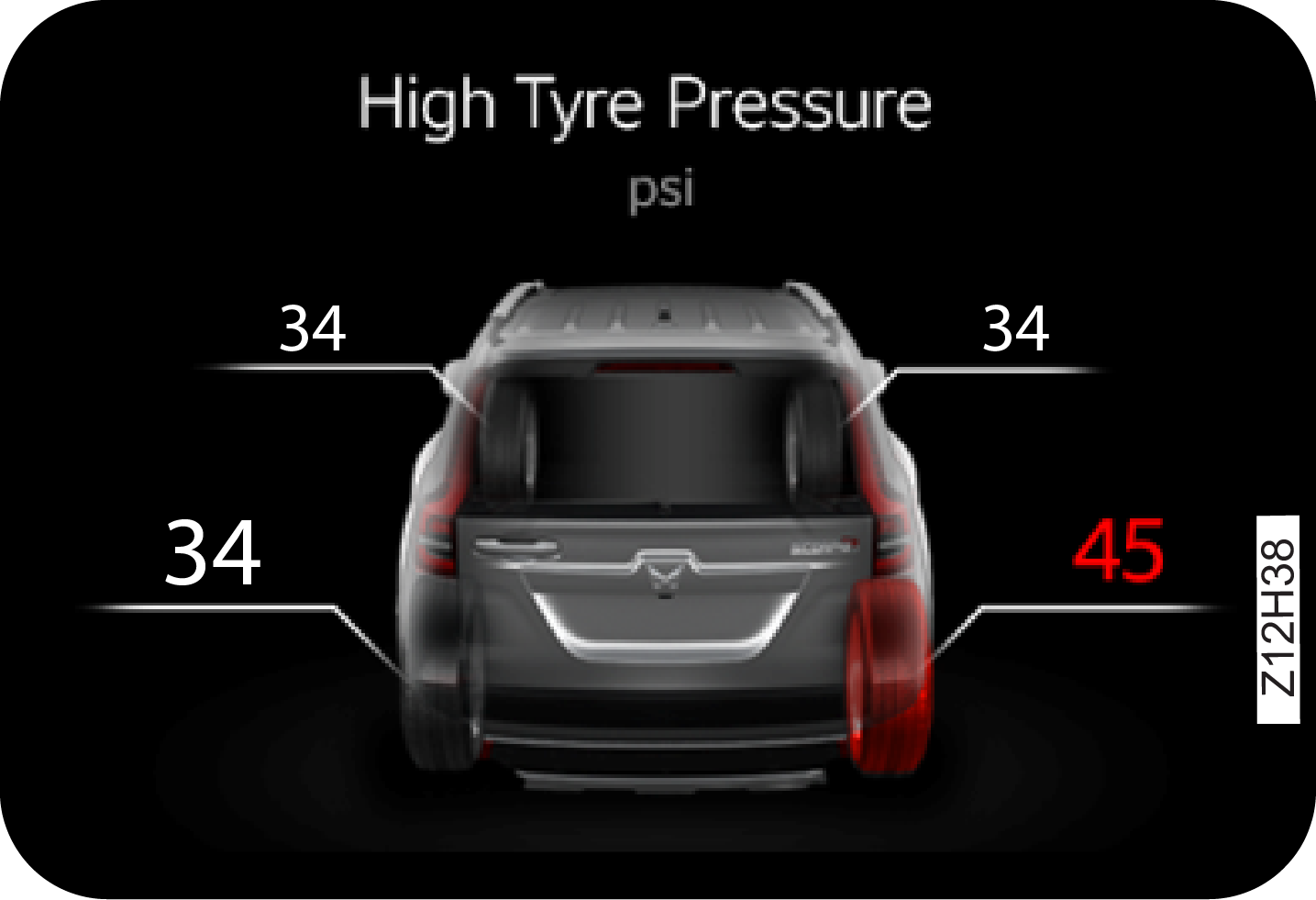
|
High pressure monitoring is to indicate high
pressure
alert. Please note the following points.
|
| • | High pressure alert will be set only when the tyre pressure value goes above threshold |
| • | High pressure alert in the main alert screen will pop up once for driver notification when the alert is set and the vehicle is in running condition. Otherwise the alert will remain in the tiretronics screen |
| • | If high pressure value is observed, air has to be released from the respective tyre until the pressure reduces to the placard value |
| • | The vehicle should be driven above 40 kmph for the new pressure value to be updated and the alert to be cleared |
| • | Once the high pressure alert is triggered the alert shall not get cleared until the respective tyre pressure is reaches to the placard value |
Pressure Leakage
Alert
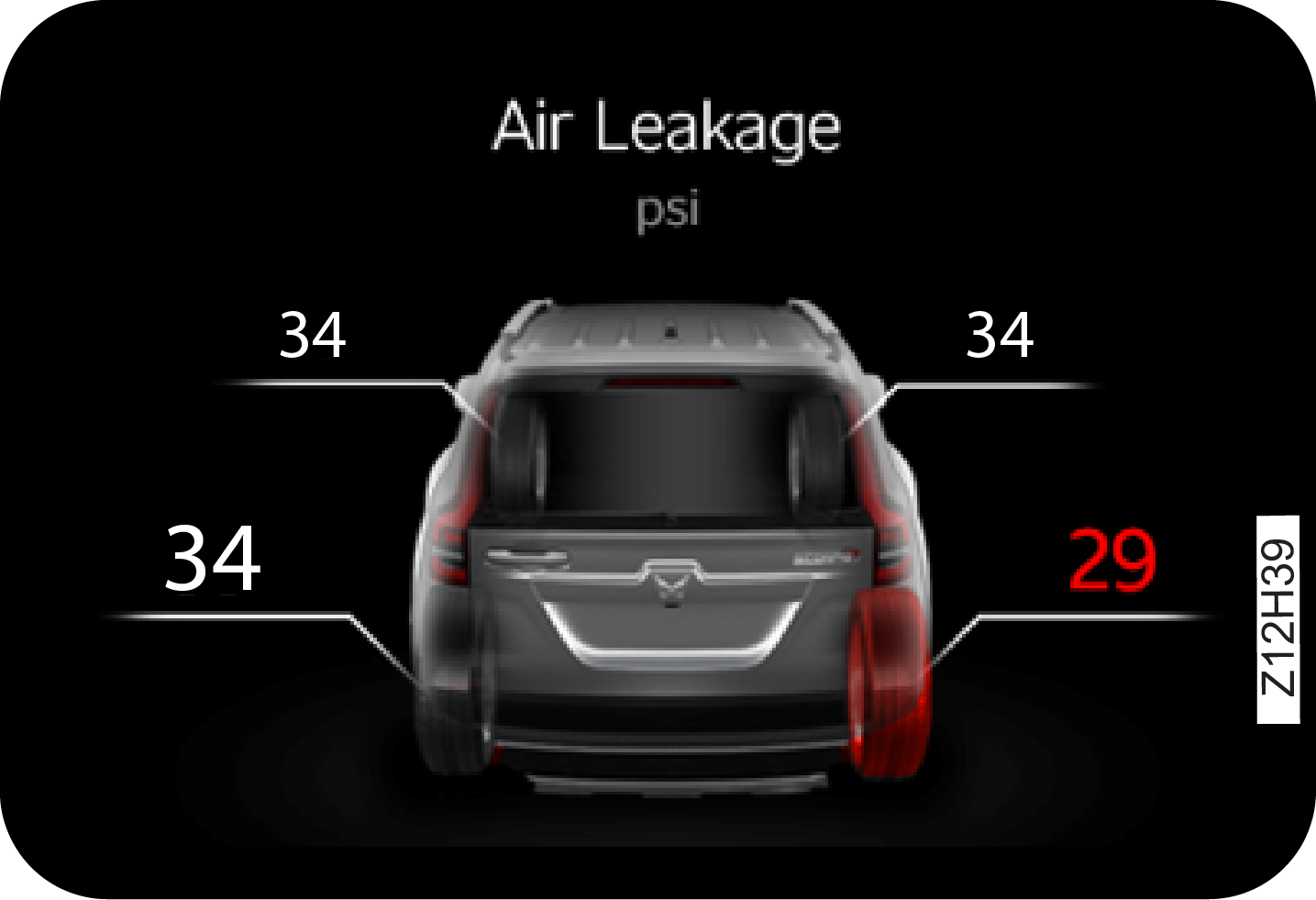
|
Pressure leakage monitoring is to indicate pressure
leakage in any of the vehicle tyres. Please note the following points.
|
| • | Pressure Leakage alert will be set only when the tyre pressure is leaking at a rate greater than defined threshold |
| • | In the pressure leakage condition if the tyre pressure goes too below threshold then the low pressure alert will also be set |
| • | The pressure leakage alert in the main alert screen will pop up once when the alert is set for driver notification and will be shown in tiretronics screen when the vehicle is in running /ignition ON condition |
| • | Once pressure leakage is observed the respective tyre should be observed for air leakages and the puncture condition has to be rectified. Proper placard value should be filled after puncture rectification |
| • | If the vehicle is running in an extremely rocky and acute bumpy condition then fluctuating pressure leakage alert may get set which will get rectified when the vehicle runs back on a normal road. This happens due to sudden change in pressure levels due to rocky conditions |
Sensor Signal
Missing Alert

|
When the vehicle runs in speed above 40kmph,
Tiretronics system receives signal from all the Tiretronics sensor installed
in all running tyres.
|
| • | On account of any issue in signal reception or Tiretronics sensor damage or tyres changed with out performing manual learning then the signal will not be received |
| • | If the Signals from the tiretronics sensor are not received atleast once, when the vehicle is driven at a speed greater than 40kmph for more than 10 minutes, "Signal Missing" alert will be set for the respective tyre and Tiretronics Telltale will be ON. |
| • | When the Tiretronics signal missing is set then perform manual learning once. If manual learning is not done successfully then the corresponding position tyres sensor needs to be checked by carefully opening the tyre |
| • | If the sensor is found to be damaged then it should be replaced with a new one and manual/auto learning should be done |
Sensor Faulty / Low
Battery Alert
Each tiretronics sensor in the vehicle tyres has an internal
individual battery . If the battery level is too low or the sensor
by itself is malfunctioning then the Tiretronics system shall give this alert.
| • | If the Tiretronics sensor low battery/faulty is set then the corresponding position tyres sensor needs to be removed by carefully opening the tyre and replacing it with a new sensor |
| • | Post replacing the new sensor, manual/auto learning should be done |
|
Tyre Auto Learn
Process (If Enabled in cluster)
|
|

|

|
In case of tyres location changed from its original location,
Automatically tyre swap location shall be identified and pressure
and temperature value for respective tyre shall be updated within 10 min of vehicle driving based
on
environmental condition
& vehicle drive condition auto location shall take one or more drive cycle to auto learn.
In case of a new TPMS replaced in the tyre, automatically system shall identify the tyre swapped location and update the warnings and alert for new location.
In case of a new TPMS replaced in the tyre, automatically system shall identify the tyre swapped location and update the warnings and alert for new location.

If spare wheel tyre get swapped with any of the running
tyres
then display shall show Signal missing in the cluster for respective
tyre location and TPMS indication lamp will blink for 90 sec and remain ON. TPMS
indication lamp will continue until the error
condition is rectified.
Refer cluster settings for the “TPMS Auto Learn ” in the”
Instrument Cluster Features” chapter for further details
Tyre Fill Assist
(TFA) (If Enabled
in cluster)
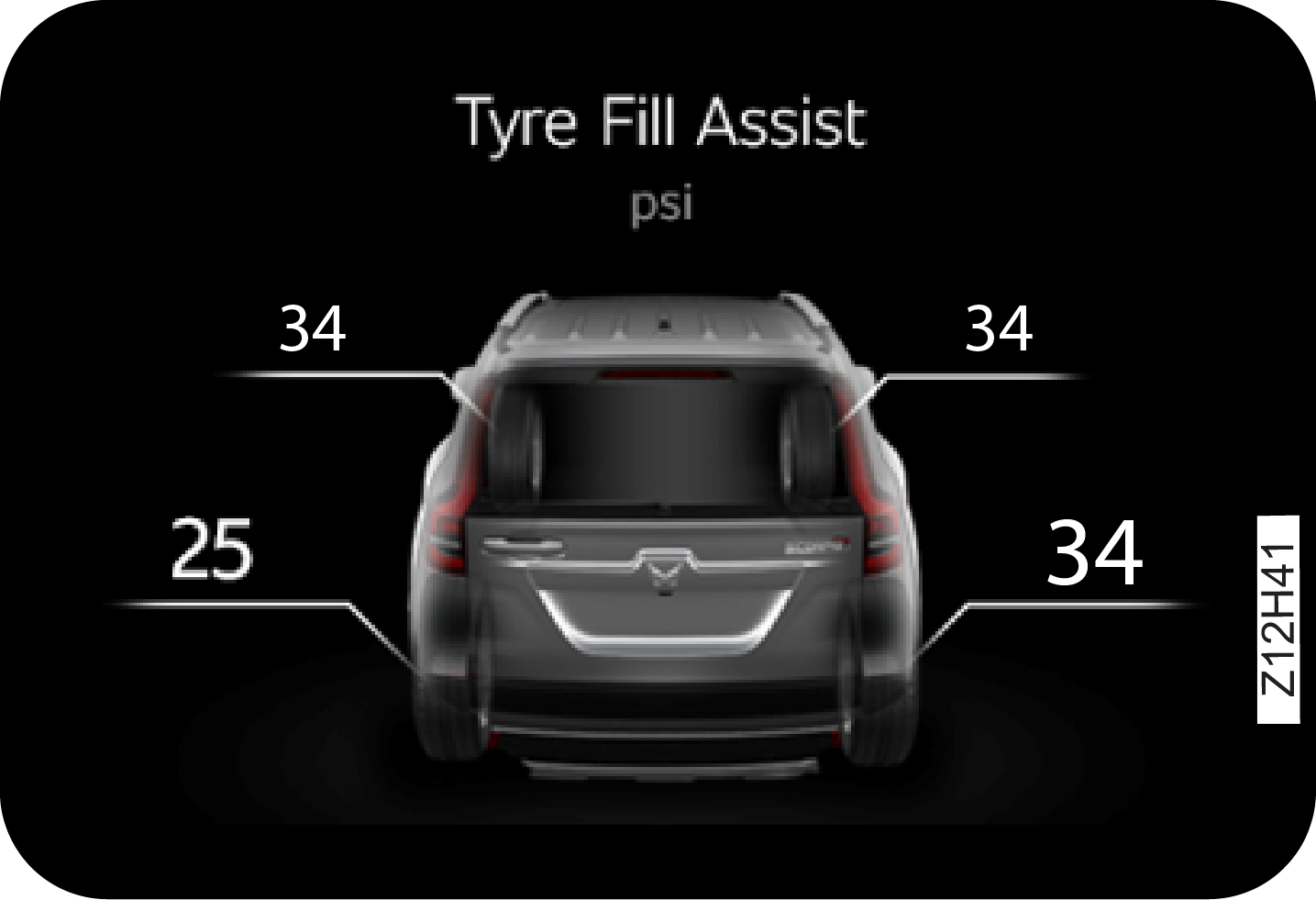
|
During Air Filling in tyre, Hazard lamps shall blink
until placard value reaches.
During air filling If tyre Pressure has reached the
Placard Value, then Horn shall activate one time
|
During Air filling If tyre Pressure exceeds Placard
Value, then Hazard
lamps shall blink at faster rate.

Refer cluster settings for
the
“Tyre Fill Assist ” in the” Instrument Cluster Features” chapter for further details
Tyre Pressure
Imbalance
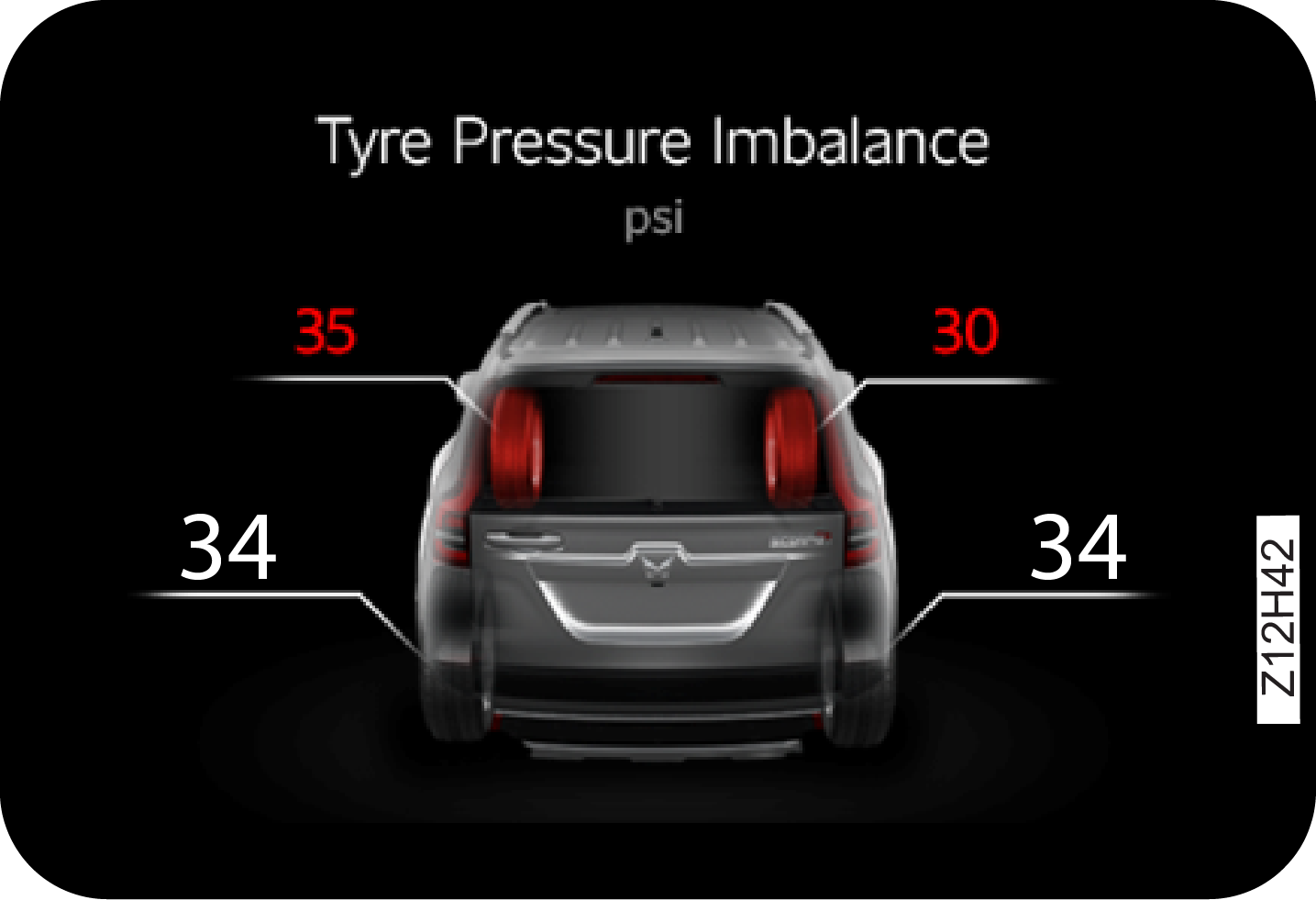
|
During driving if the system identifies tyre
Pressure
imbalance on front two tyres / Rear two tyres then Instrument Cluster
shall popup Tyre Pressure imbalance warning.
|
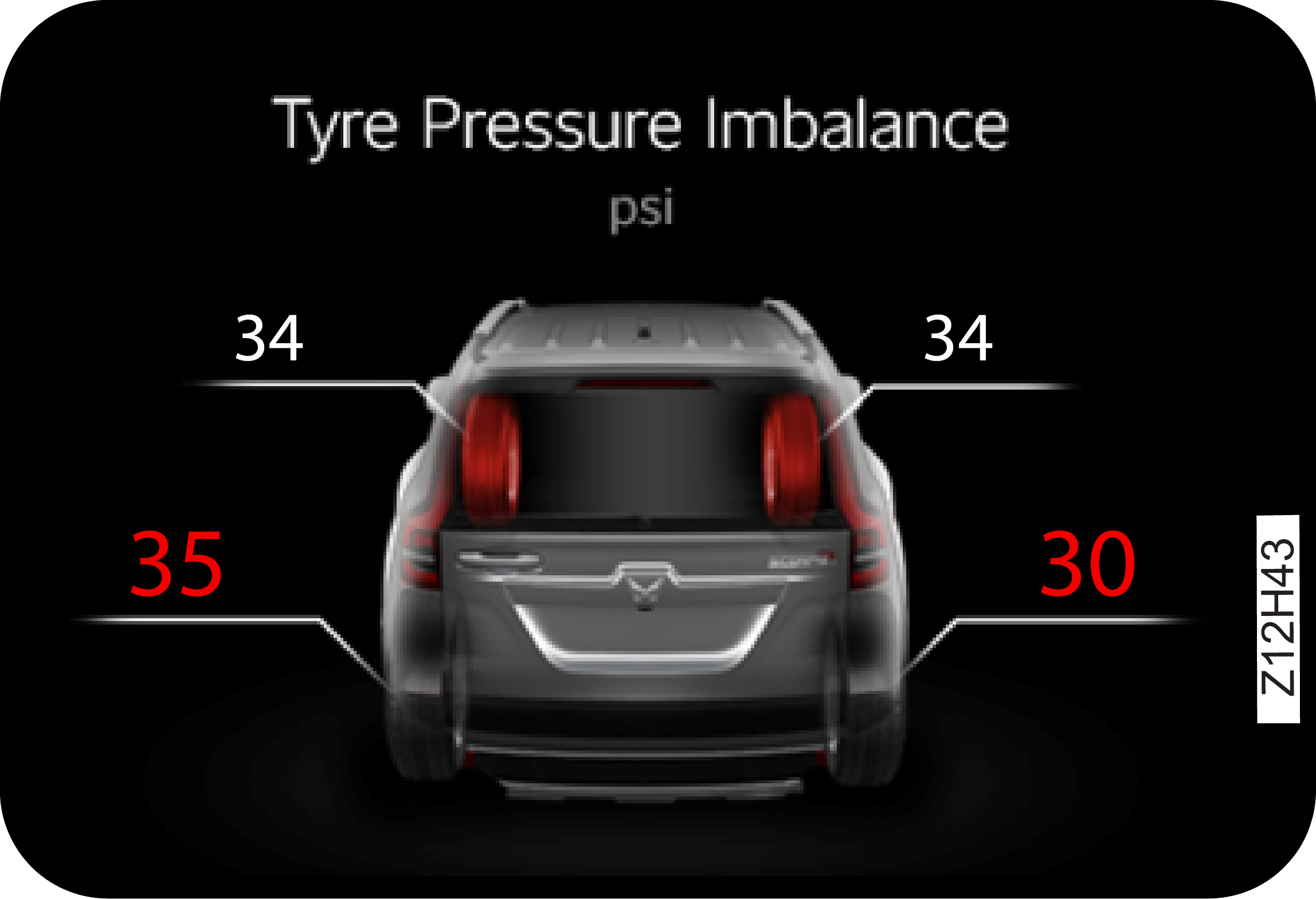
|
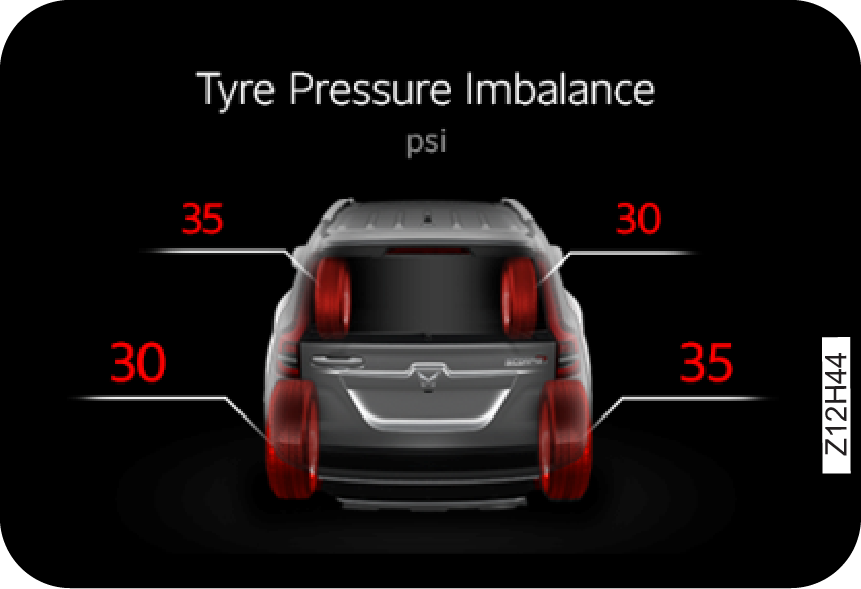
|
9.2.6 Tiretronics Manual
Learning
After tyre rotation or Tiretronics sensor replacement,
the receiver
must be learnt, else the Tiretronics warning lamp will
be ON, indicating malfunction.
Mandate Points: Manual
learning is the process by which the identities of 4 sensors installed inside the tyres are learnt
and
programmed
in to the memory of the receiver module.
| 1. | Manual learning should be compulsorily performed
on
any of the following conditions or operations done
|
| 2. | Once manual learning is initiated, the sensors inside the tyres need to be triggered by leaking the air from each tyre one at a time and should be completed within certain value post to each event for learning all 4 tyres |
| 3. | Do not perform Manual learning process at the same time on two vehicles with in the radius of 20 meters |
| 4. | It is mandatory that manual learning of tyres should follow the sequence of ‘front left tyre position, front right tyre, rear right tyre and rear left tyre. |
| 5. | It is required to ensure the tyres have pressure > 32psi and < 36psi before initiating the manual learning process |
| 6. | Post manual learning, all tyres should be filled to the placard pressure value |

It is mandatory that manual
learning of tyres should follow the sequence of ‘front left tyre position, front right tyre,
rear
right tyre and rear left tyre.
Initiating the
Manual Learning
Process
|
|
1. Press & Hold the enter button in UP position.
2. Turn the ignition key on
|
3. Wait for the cluster’s tachometer and speedometer to rotate to
highest position and then release the enter button in up
position. Then observe the cluster for the Tiretronics telltale to blink, vehicle siren will
indicate
by 2 chrips & 2 times
turn lamps blink and instrument cluster screen shows ‘TPMS MANUAL LEARNING’
If failed to enter in to the manual learning mode;
If failed to enter in to the manual learning mode;
| • | Try initiating the manual learning once again |
| • | Check if the reverse gear is engaged, if it is engaged disengage it |
| • | Check if the Enter button is working fine |
If problem still persist, contact an Authorized Mahindra
Dealer for
further assistance.
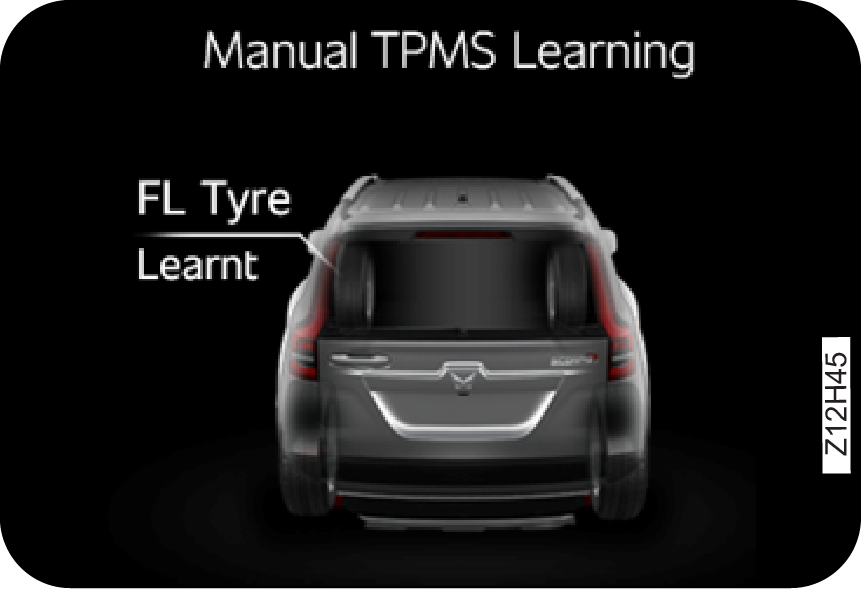
|
Starting from
Front
Left Tyre: Start leaking the air from the front left for 30 to 40 sec and
stop for 5 sec. Repeat until the tyre gets learnt
|
If the front left tyre is learned, 1 siren chirp sound
is heard and
turn lamps turn on 1 time and the FL tyre shows learned
in the cluster screen.
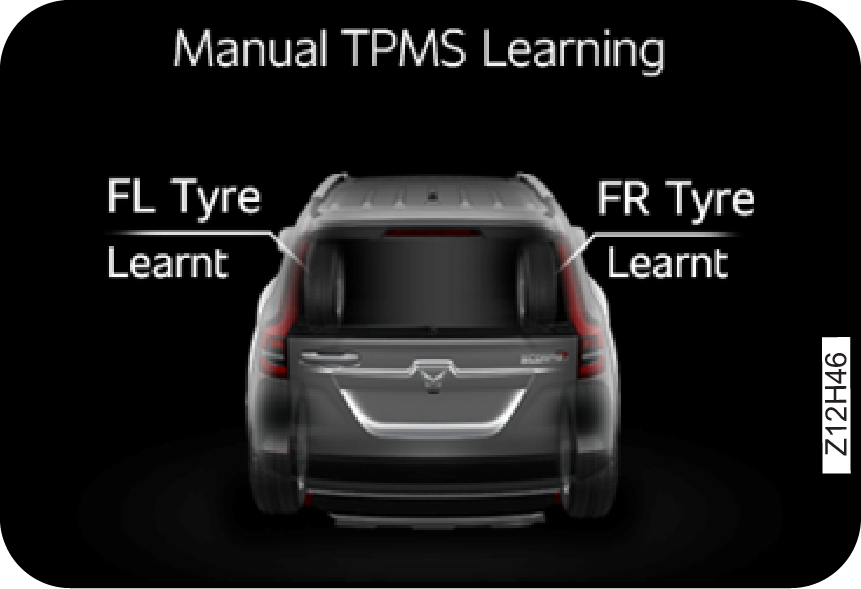
|
Learning the
Front
Right Tyre: Start leaking the air from the front right for 30 to 40 sec
and
stop for 5 sec. Repeat until the tyre gets learnt.
|
If the front right tyre is learned, 1 siren chirp sound
is heard and
turn lamps turn on 1 time and the FR tyre shows learned
in the cluster screen.
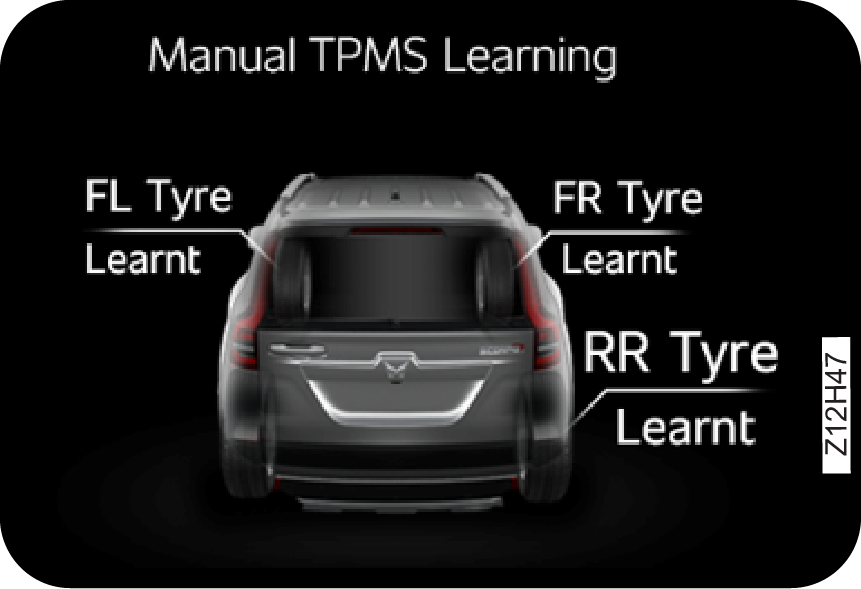
|
Learning the
Rear
Right Tyre: Start leaking the air from the rear right for 30 to 40 sec and
stop for 5 sec. Repeat until the tyre gets learnt.
|
If the rear right tyre is learned, 1 siren chirp sound
is heard and
turn lamps turn on 1 time and the RR tyre shows learned
in the cluster screen.
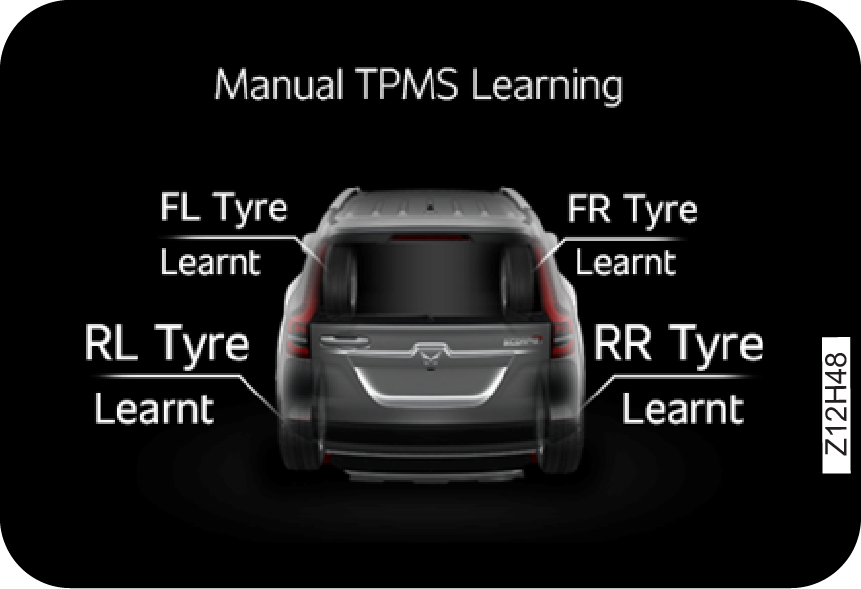
|
Completing the
Learning with Rear Left Tyre: Start leaking the air from the rear left
tyre
for 30 to 40 sec and stop for 5 sec. Repeat until the tyre gets learnt.
|
If the rear left tyre is learned, 1 siren chirp sound is
heard and
turn lamps turn on 1 time and the RL tyre shows learned
in the cluster screen.
If rear left tyre is
also
learned, then 1 siren chirp is heard and turn lamps turn on 1 time and aLL tyres shows
learned at
respective tyre positions and ‘TPMS Manual Learning successful’ in the centre of the
screen.
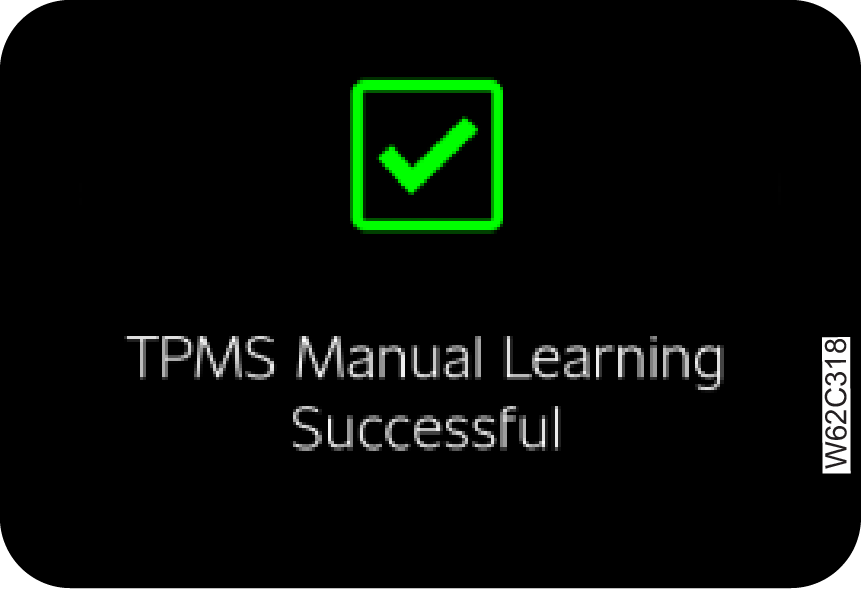
If learning is not
successful at any point of time, or at any point of time during the learning process if
the
learning takes
more than 90 secs of time for each tyre position then the system shall exit the learning
mode
and shows the ‘TPMS Manual Learning
Not Successful’ screen, and 4 siren chirps is heard also turn lamps turn on 4
times.
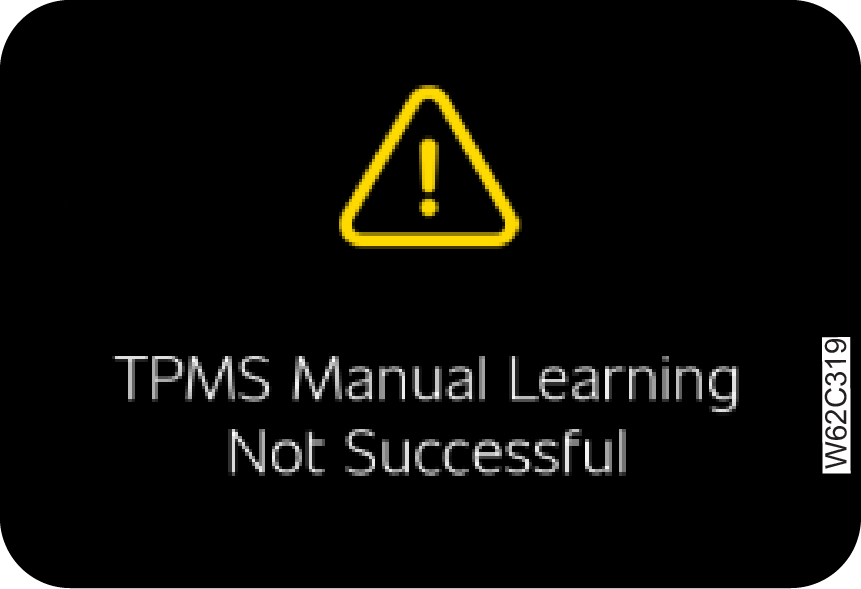
Limitations
| • | The Tiretronics monitors only tyre pressure and temperature. It does not monitor conditions such as tyre wear |
| • | The Tiretronics will not be able to detect an instant tyre burst and inform the driver in advance |
| • | There may be the possibility of getting all the tyre location indicators on the Tiretronics display blinking along with the Tiretronics telltale, on passing environment area prone to heavy power lines and RF signal. It will come back to normal condition when interference gets cleared |
9.2.7 Tiretronics — Points to
Remember
| • | It is recommended to fill the pressure to 34 psi at a digital gauge station only |
| • | Every 15 days, inflate all the tyres up to 34 psi and inflation should be done at cold condition/ambient temperature |
| • | Pressure deviation between the Tiretronics display
and gauge will depend upon the following factors:
|
| • | Tiretronics measures pressure of the tyre |
| • | Pressure deviation is defined for 0.5 psi (min) and 3 psi (max) |
| • | If the vehicle battery/fuse is disconnected and reconnected, it will update the pressure after the vehicle is driven or sensor is activated |
| • | If the vehicle tyres are rotated or any of the tyres sensors are replaced, then tires have to be learned via either manual or auto learning. Refer Tyre Auto/Manual learn process in Tiretronics section for more details |
| • | If more than one tyre needs to be learned, learn all 4 tyres as per manual learning procedure |
| • | Tiretronics is only a warning or indicating device. Pressure and temperature values displayed by the system is for indication prior to alert purposes only. The Tiretronics system should not be used as a measuring device to correlate or calibrate against other systems |
| • | During winter or in cold conditions, there may be chances of getting a pressure alert with the corresponding tyre location indicator in the display, if the tyre pressure is near the thresholds level. i.e. between 28 psi to 24 psi. However, this alert will get cleared after driving a few kilometers depending upon the climatic condition |
9.2.8 Recommended Playcard
Value
|
Ambient Temp. (Deg C)
|
Recommended Pressure Front & Rear (34
Psi
Placard)
|
|
<0
|
28
|
|
10
|
29
|
|
20
|
31
|
|
30
|
32
|
|
40
|
34
|
|
50
|
35
|
|
60
|
37
|

If the vehicle was previously halted for more than 45 min &
is
driven less than 15 min before filling the air then the tyres
shall be filled to the respective playcard as per the ambient temperature else to the next
playcard
value.
Example: If a vehicle was halted at a ambient of 30 deg c for 50
min and driven to a air filling station within 5 min then
respective play card value will be 32.0 PSI for front & rear. Else 33.5 PSI
9.4 Parking Assistance System (PAS) –
RPAS & FPAS (If equipped)
Parking assistance system
is
provided to aid the driver while parking the vehicle in reverse and in front. While Parking,
PAS will detect the obstacles at the rear and front side of the vehicle within the sensing
zone,
which cannot be viewed through
the internal rear-view mirror and the outside rear view mirrors and windshield. The PAS will
then alert the driver by a beep
sound and display about the location of the detected obstacle from the vehicle. The alert
sound
level will vary proportional
to the distance. Smaller the distance shorter the interval between the
beeps.
9.4.1 Parking Assistance System
Sensors
|
Front Sensor
Location
|
Rear Sensor
Location
|
|
|
|
RPAS sensors
are located in
the rear bumper and FPAS sensors are located in front Bumper to assist driver for hassle
free
parking

RPAS and FPAS will give proper alerts at vehicle speed less than
8kmph.
Always keep the sensors
clean
and free from ice formation, dust, water etc. for proper working of the system.
Do not press or shock the
sensors by hitting or using a high-pressure water gun while washing. The sensors could be
damaged.
Magnetic devices present in
the
detection range could vastly affect the sensor performance and the distance displayed may
not be accurate.
9.4.2 Driving and Operation

| • | PAS is an aiding system. Under no circumstances mahindra will accept any responsibility or can be held liable for any direct or indirect, incidental or consequential damage caused by this system |
| • | System will not sense pot holes, trenches or drainages which are below the ground level |
| • | Repainting of the sensor will affect the performance of the system |
9.4.3 Activation &
De-activation of PAS
| • | The Vehicle should be in IGN ON state to activate the Parking assistance system |
| • | RPAS will be activated automatically when reverse gear engaged |
| • | RPAS will get deactivated when reverse gear is disengaged |
| • | FPAS will be activated automatically when Vehicle speed is in between 1 to 8 kmph and hand brake is dis engaged or clutch is pressed, Hand brake is disengaged and vehicle is standstill or reverse gear is engaged |
| • | In case of AT variant FPAS will be activated automatically when the vehicle is in D gear and hand brake is disengaged . |
| • | FPAS will get deactivated when vehicle speed is more than 8kmph or hand brake is engaged or reverse gear is disengaged. |
| • | When the obstacles come in the sensing range, the system starts giving the indication based on the distance and direction of the obstacles as defined in the detecting zones. The closer the obstacles, more display bars illuminated & beeps alerts |
9.5 PAS (RPAS & FPAS) Information
on
Instrument Cluster Screen
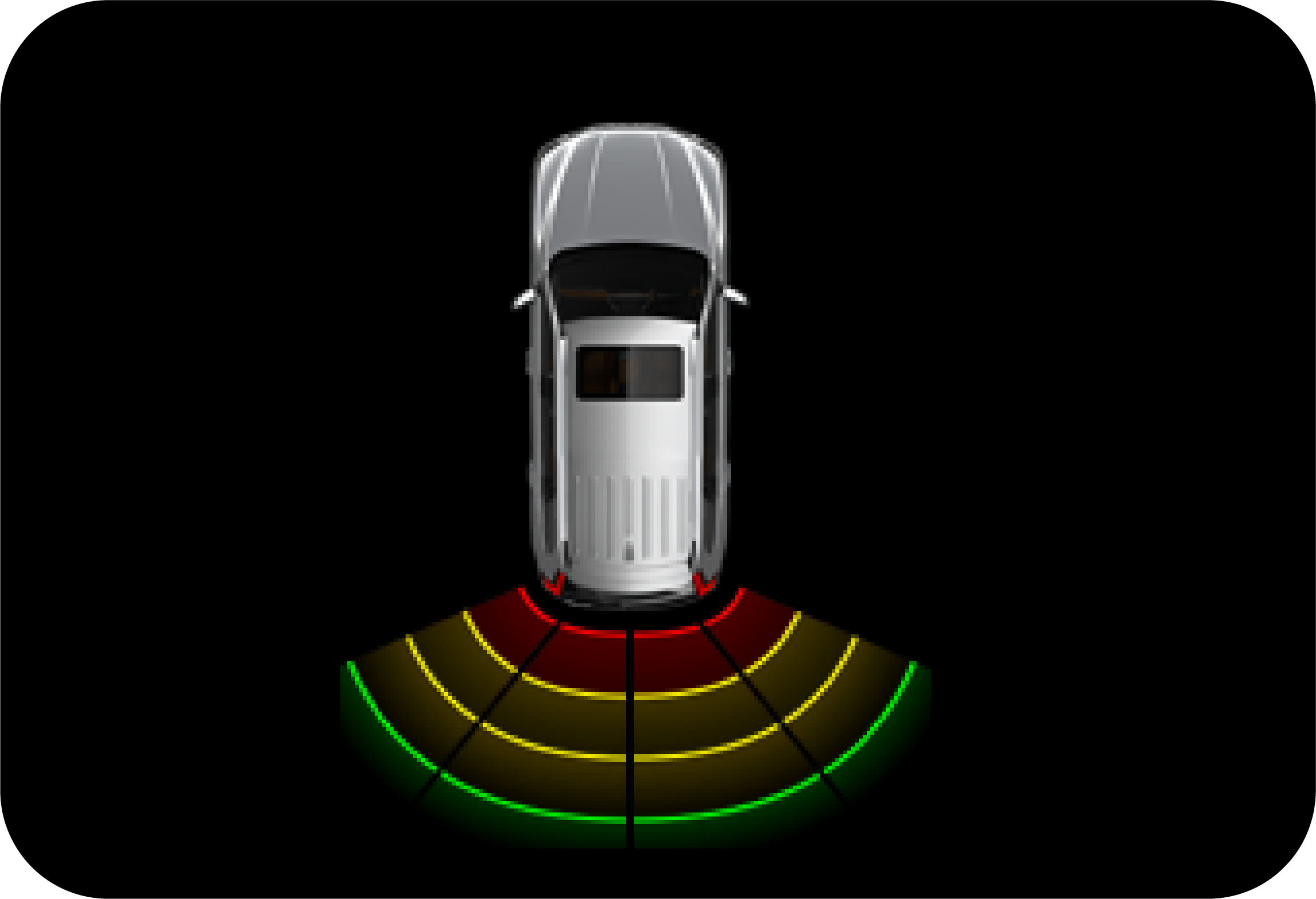
|
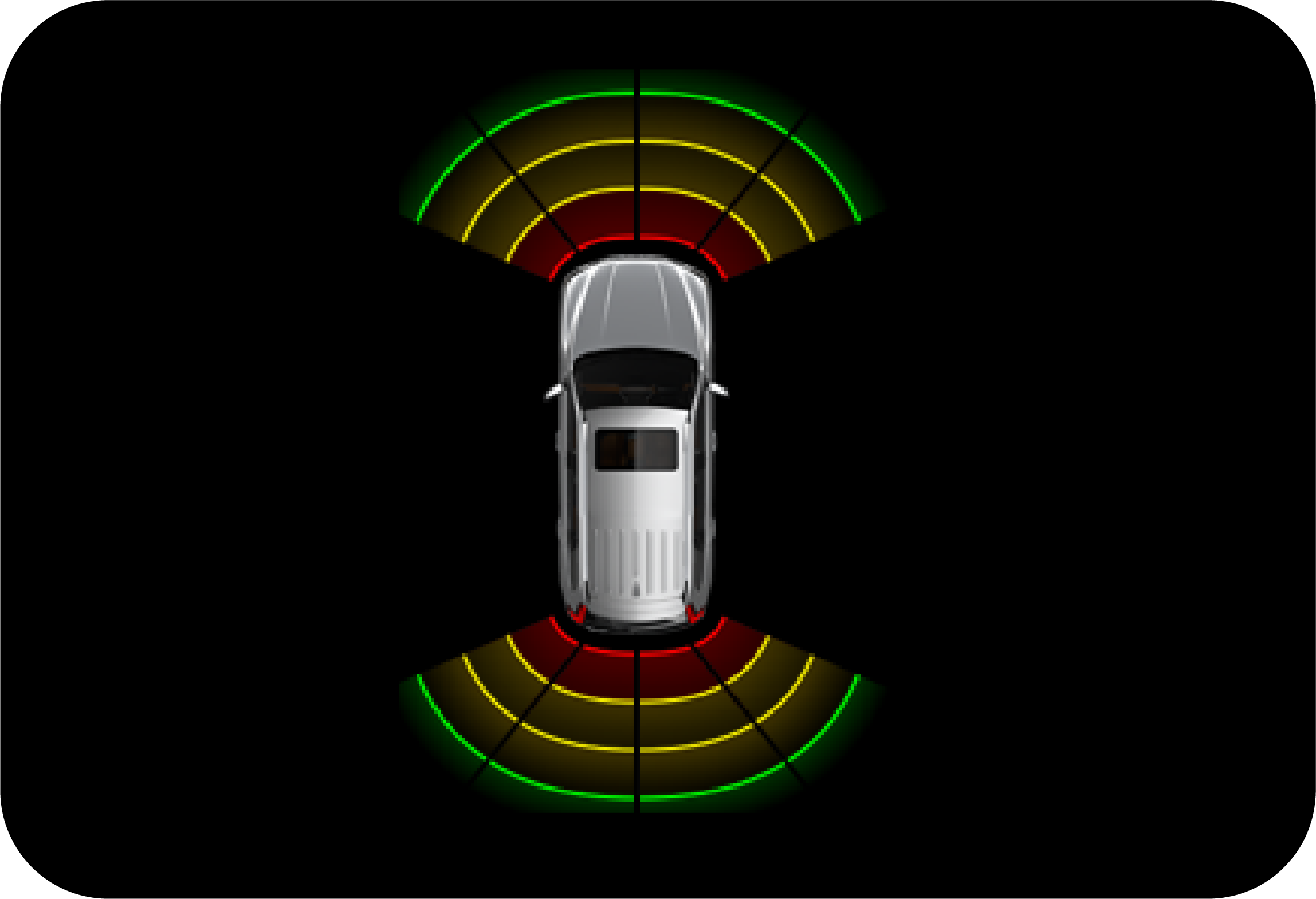
|
RPAS display on
instrument cluster
screen gives the following information:
. Left zone indicates obstacle on left side
. Right zone indicates obstacle on right side
. If Obstacle is in center then left and Right both zone will get highlight.
. Right zone indicates obstacle on right side
. If Obstacle is in center then left and Right both zone will get highlight.

Number of Zones getting changed according to variant.
FPAS display on
instrument cluster
screen gives the following information:
. Left Corner zone indicates obstacle on left side
. Right Corner Zone indicates obstacle on the right side
. Right Corner Zone indicates obstacle on the right side
9.6 Operation of PAS
| 1. | Start the vehicle (Ignition is turned ON) |
| 2. | Change the gear to Reverse (engage reverse gear) and
Dis
engage Hand brake. RPAS & FPAS will be displayed as like below in
Instrument Cluster. The RPAS & FPAS both will be displayed as like below in the instrument cluster screen during obstacle detection 
|
| 3. | For FPAS alone, disengage Hand brake and drive the
vehicle forward with speed limit within 1 to 8kmph
|
|||||
| 4. | The Beep sound can be heard from the Cluster speaker.
Frequency of the beep will increase if obstacle detected by sensor is
closer (crossing each display bar) and the sound will be continuous if any of the
obstacle
is near the vehicle.
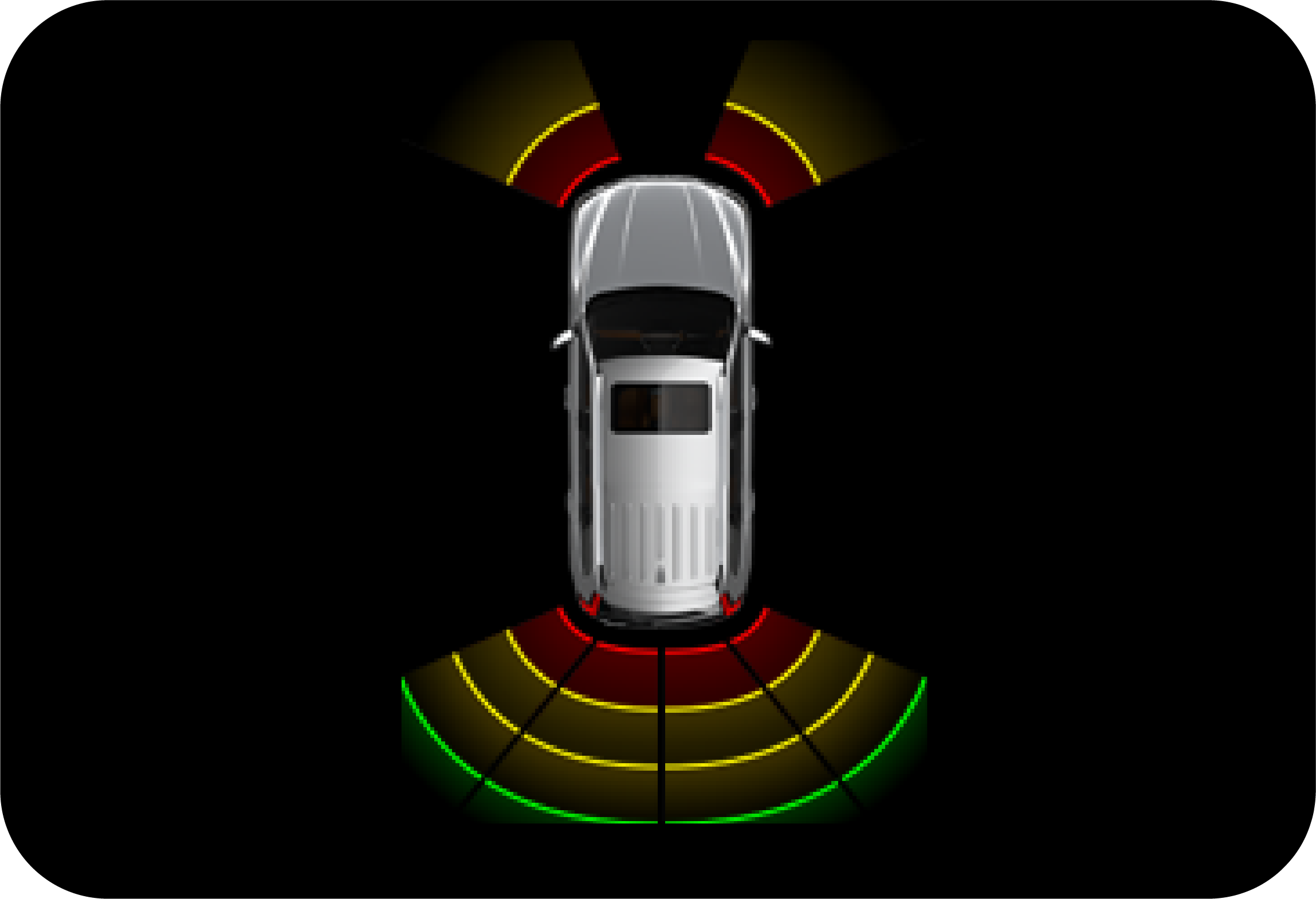
|
| 5. | The RPAS distance displayed will be the minimum of
distances sensed by left and right sensors. And 120 cm is the maximum detection
range & The FPAS distance displayed will be the minimum of distances sensed by left
and right sensors 70cm is the maximum
detection range
For Example: Assume 2 obstacles are placed as mentioned
below:
On engaging the gear in reverse, instrument cluster
will
display as below:
Since obstacle is at 70 cm in left - minimum distance
is
shown in the distance indicator.
|
| 6. | FPAS warning sound can be disabled using PAS Switch,
available on IP. PAS switch LED will not glow when FPAS sound is in active
state and will be in ON state when PAS sound deactivated.
|
9.7 Pay Attention
| 1. | If bars in any one of the sides are displayed with
‘X’
marks is displayed on instrumental cluster display, contact an Authorised
Mahindra Dealer.
|
| 2. | If all bars are displayed with ‘X’ marks on
instrumental
cluster display, contact an Authorised Mahindra Dealer.
|
| 3. | Obstacle in the blind zone cannot be sensed by the
system. Applicable for all sensors.
|
| 4. | Please check the condition of the obstacle behind and
in
front of your vehicle before moving. In some cases, the display may
be not as same as reality due to the installed sensor level, obstacle shape and
reflection
condition.
|
| 5. | Point B will be detected sooner or later, but A may
not
be detected at all. Applicable for all sensors.
|
| 6. | Not all obstacles are detected from 120 cm. For
instance, a person is detected from 75 cm because of the weak reflection or
absorption of the waves of the clothes.
|
| 7. | The distance indication may move up and down due to
different sizes of the obstacle at different positions.
|
| 8. | Though the obstacle is in the sensing zone, obstacle
may
not be detected since the ultrasonic waves are not reflected back
to the sensor.
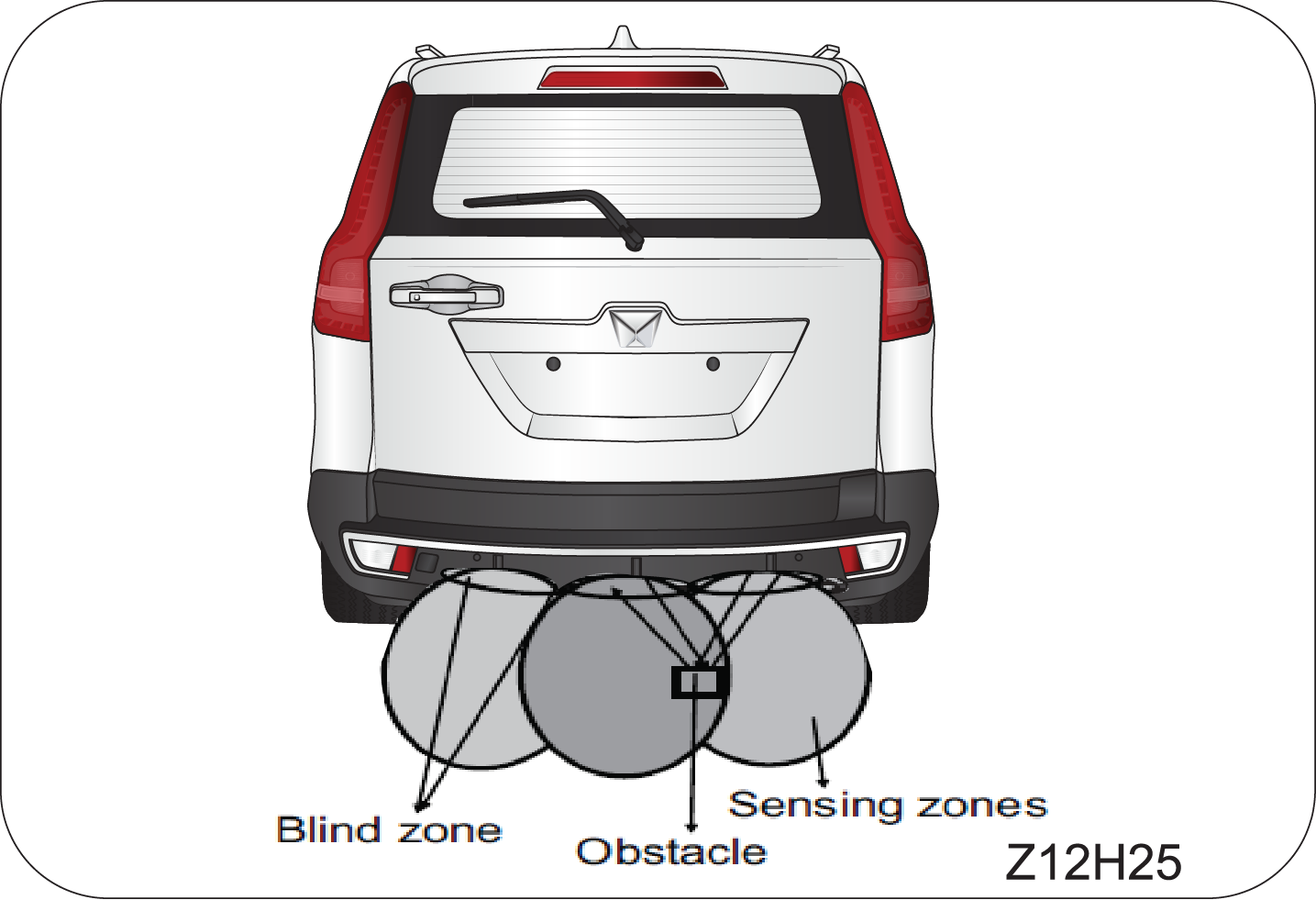
|
| 9. | The obstacle of a conical shape may not be detected,
since the ultrasonic waves get reflected away
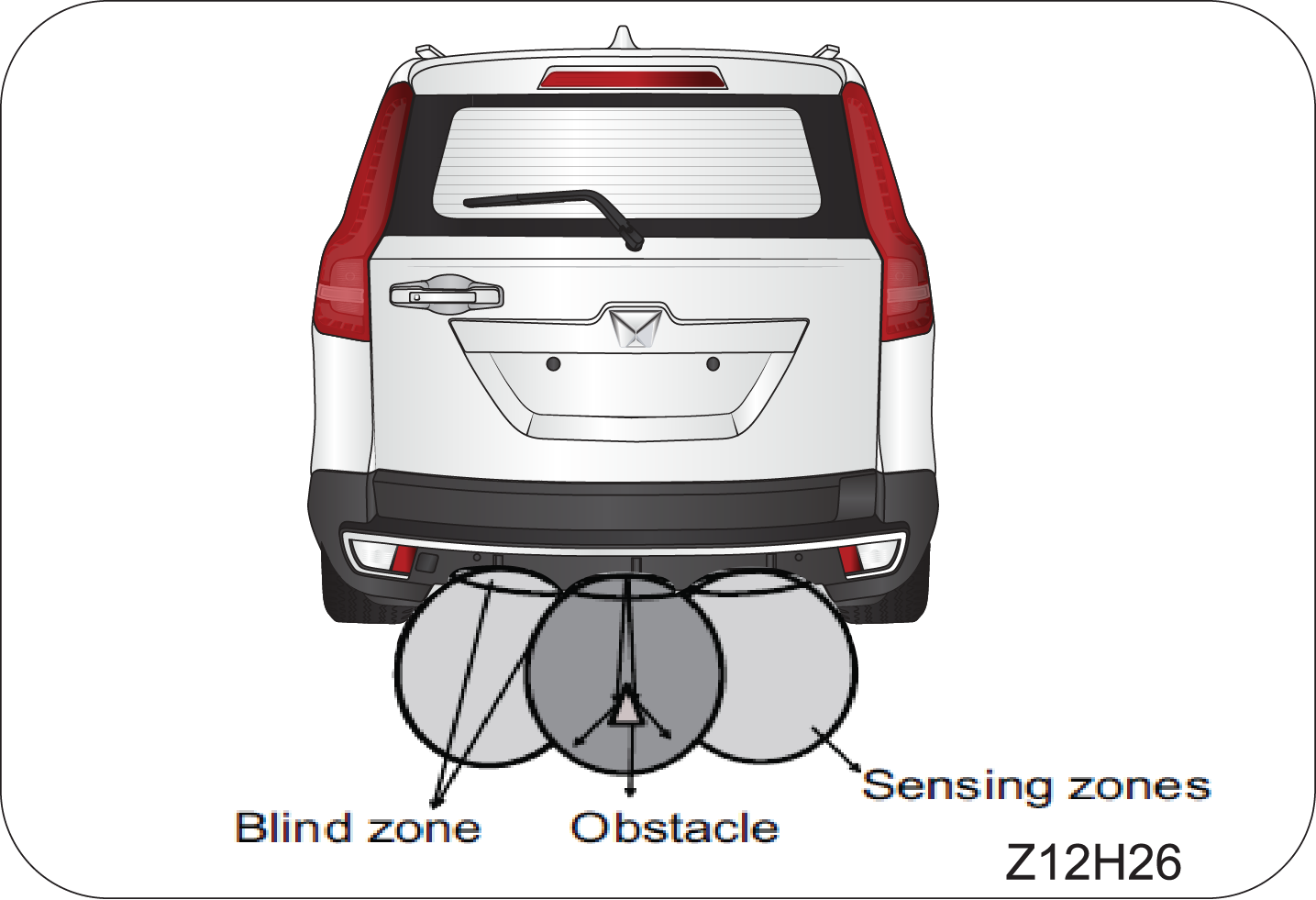
|
9.8 Limitations of PAS
| • | System may not sense obstacles like wire mesh, handrail, small objects which are below the bumper level |
| • | System may not sense obstacles with cotton or spongy surface, which will absorb ultrasonic waves emitted by PAS |
| • | System performance is dependent on the reflection angle of the obstacle |
| • | System may give false alert without obstacles while parking/reversing the vehicle on grasslands, gravels and bumpy roads considering it to be an obstacle |
| • | System may alert you by sensing the ground when the bumper is not fitted in its intended position or when the vehicle is overloaded |
| • | System may give false signal while the vehicle moves from plain ground to a slope terrain and vice versa |
| • | System may give false signal by sensing the ground when the bumper is tilted more from the normal position or when the vehicle is heavily overloaded |
| • | System may give false signal an alarm during heavy rain, snow and heavy wind conditions |
| • | The shape of the obstacle may prevent a sensor from
detecting it. Some obstacles for example as follows:
|
| • | Depending upon the shape of the obstacle and other environmental factors, the detection distance may shorten or detection may be impossible |
| • | Obstacles may not be detected if they are too close to the sensor |
| • | Thin posts or objects lower than the sensor may not be detected when approached, even if they have been detected once |
| • | Because of other ultrasonic sources, sensor may give false alarm for e.g., sweeping machines, high pressure steam cleaners and neon lights |
| • | Due to vehicle horns, motorcycle engines, air brakes of large vehicles, or other loud noises producing ultrasonic waves, the vicinity of the vehicle is noisy. It may cause sensor to give false alarm |
| • | Front parking sensors coverage is limited to only corner area of front bumper |
9.9 Rear View Camera (If equipped)
|
|
Rear View Camera is located under tail gate applique.
Rear View Camera assists the driver while reversing
&
manoeuvring the Car at lower speeds. It has the following features:
|
| 1. | Normal View |
| 2. | Zoom-in View |
| 3. | Full View |
| 4. | Merged Corner View |
| 5. | Left Corner View |
| 6. | Right Corner View |
| 7. | Static & Dynamic Guidelines |
| 8. | Parking assistance
|
9.9.1 Feature Description
1. Normal View
By selecting Normal View Icon, Rear View camera provides view of
vehicle's rear surrounding on the Infotainment screen.
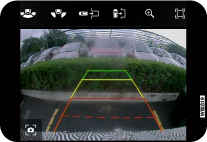
|
It overcomes limitation of IRVM, where ground is
visible only after longer distance from vehicle rear. Whereas with the RVC,
the ground will be visible closer to Vehicle’s Rear
|
|
2. Zoom-In
View
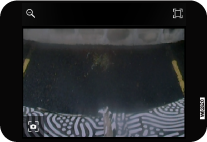
|
Press Zoom-In button to view objects closer and
press
Zoom-Out button to go back to the normal parking view.
|
|
3. Full
View/Wider
View
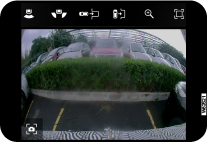
|
By selecting Full View Icon Rear View camera
provides
about wide rear view of vehicle's rear surrounding on the Infotainment
screen.
|
Full view is wider than Normal View.
|
4. Merged Corner
View
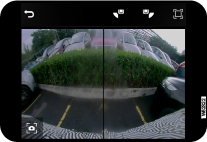
|
By selecting Merged Corner Rear View camera provides
a
wide view focussed on the left and right corners to provide a better
visibility of crossing traffic for safe manouvre.
|
Merged Corner View shows merged view of rear left and right
corners.
|
5. Left Corner
View
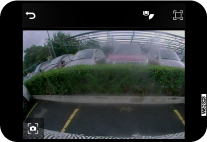
|
If user wants to focus on the left side crossing
traffic, then "Left Corner View" icon can be pressed to select the view.
|
Select “Back” Icon to switch to Merged Corner View.
|
6. Right Corner
View
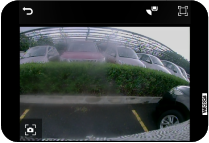
|
If user wants to focus on the right side crossing
traffic, then "Right Corner View" icon can be pressed to select the view.
|
Select “Back” Icon to switch to Merged Corner View.
7. Static and
Dynamic
Guidelines
Static Guidelines
indicate
the placement of the vehicle with respect to the parking slot during parking. During parking,
compare the Static
guidelines against the Parking Slot Lines to know if vehicle placement is in-line with the
parking slot lines.
Color coding on Static lines help in assessing the distance of
obstacle from the vehicles’ rear. In the RVC Video, if Red
color dashed line falls on a object on the floor then the Object is within 0.5 meter distance from
the
vehicle’s rear. Likewise,
Red solid line indicates 0.5-1mts, Yellow indicates 1-2 mts, and Green indicates 2-3 mts.
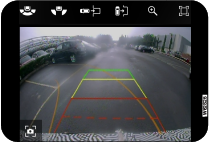
|
Dynamic
Guidelines (orange color in below image) indicate path, the vehicle will
traverse with current steering position. As per the steering
angle movement, dynamic guidelines move and show the vehicle predicted moving
direction
to help the driver.
|
8. Parking
Assistance
The feature assists the driver with the help of parking overlays to
park the vehicle in target parking slot. Parallel or Vertical
Parking option can be selected by driver based on parking slot availability.

Overlays and guidelines are
displayed regardless of the current vehicle environment. The driver is responsible for
checking
and ensuring that there is no obstacle in the selected parking slot.
Parallel
Parking
Parallel Parking guides the driver to park the vehicle in a slot
parallel to the vehicle.
|
A. Selecting
Parking Slot
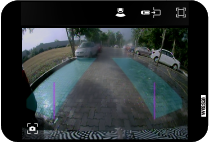
|
Drive ahead of the parking slot, until it is fully
visible. Now select “Parallel Parking”
Icon from infotainment. After selection,
Infotainment
displays below screen image1.
|
|
B. Setting the
steering angle:
|
Drive the vehicle Forward or Backward and ensure
the
greenish -blue rectangle [consider right rectangle if parking image
slot is on right side and consider left rectangle if parking slot is on left side],
is
placed in the parking slot. Make sure
obstacles are not present
|

Ensure, there is enough
space
(min.3ft) sideways between your vehicle and the parked vehicle before engaging
reverse.
In the parking slot after the vertical pole.
| • | Now start turning the steering wheel towards the direction in which parking slot is present. A shorter rectangle box will appear which will change the color according to the steering position. |
|
|
When the box is green(image 2), stop turning the
steering wheel and hold the position.
|
Green color:
Represents
suitable parking location. You can try an attempt to park.
Red color:
Represents
unsafe/potential risk parking. Your vehicle may hit the side of the vehicle already parked.
Blue color: Represents
unsafe/potential risk parking. Final parking space length needed will be larger than the desired
length of parking
space. May lead to wrong vehicle direction movement.

Green/Blue/Red colors in this mode are for guiding the vehicle to the parking
slot and it would not detect the obstacles or
alert the driver in that zone. It is the sole responsibility of the driver to ensure the
rear
end obstacles/ vehicles which
can lead to damage while parking.
|
C. Complete
Parking
|
With current steering position, start moving the
vehicle backward. An orange arc line will appear. When the orange arc (image
3)touches the parking slot end position, stop the vehicle
|
| • | Now rotate the steering wheel to maximum in the opposite direction. Arc is then replaced by dynamic and static parking line. Continue backing the vehicle with the help of dynamic guideline. |
|
|
|
Vertical/Perpendicular
Parking
Vertical/Perpendicular parking assistance guides the driver to park
the vehicle in a parking slot perpendicular to the vehicle.
Below are the steps to achieve Vertical parking.
|
Selecting
Parking
Slot
|
Drive ahead of the parking slot, until it is fully
visible. Now select “Vertical
|
Parking” icon present on infotainment screen. After selection,
Infotainment display’s below screen:
Setting the steering
angle
Based on the side driver prefers to park, either blue or pink arc
needs to be taken into consideration Drive the vehicle,
either forward / backward and ensure that preferred side arc’s tip is touching the starting edge of
target parking slot.
Once done, stop the vehicle.
|
|
Turn steering wheel to the maximum position, towards
direction of the parking slot. Pink/ blue overlay disappears, and the
dynamic and static overlay appears on the screen as shows in the image.
|
Complete
Parking
Hold steering in the maximum position and start driving the vehicle
backwards. when static lines are parallel to target parking
slot, bring steering to centre position and continue driving backward until the whole vehicle is in
target parking slot. Parking
Completed
9.9.2 Entry and Exit Conditions
Entry
Conditions
Turn on ignition and apply the reverse gear,
Infotainment will enter
into ‘Rear View Camera Mode’ and displays the video.
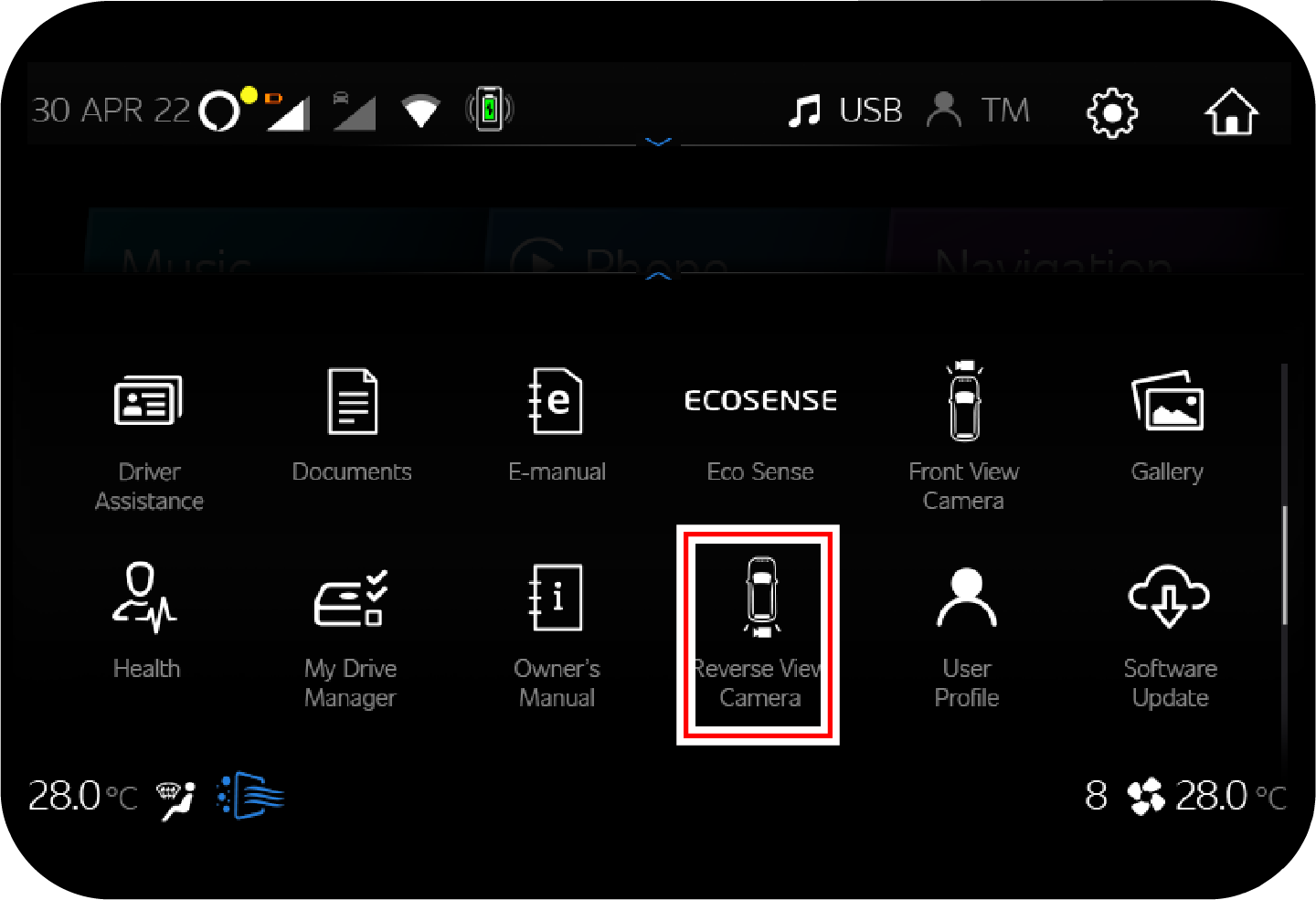
|
You can also view vehicle’s rear surrounding, by
selecting Rear View Camera option present on Infotainment Screen, irrespective
of the gear position.
|
Exit
Conditions
| • | If the driver is not in Parallel or Vertical Parking mode and Infotainment has entered ‘RVC Mode’ by reverse gear option, then RVC mode exits when reverse gear is disengaged |
| • | If the driver is not in Parallel or Vertical Parking mode and Infotainment has entered ‘RVC Mode’, due to “Rear View Camera” selection present on the Infotainment, then RVC mode can be exited, by selecting the Cancel button appearing on the screen |
| • | Irrespective of RVC entry conditions, when Parallel or Vertical Parking Mode is active, driver can exit the RVC Mode using Cancel button that appears, whenever vehicle is in forward gear |
| • | When ignition is off |
| • | If equipped with FVC and (if Reverse Gear engaged or RVC screen is in Parking Mode) and FVC piano switch is pressed then Infotainment exits RVC mode and enters FVC mode. |
9.9.3 Camera Maintenance
Always keep the Camera lens clean from dust. Presence of
dirt on lens
may lead to poor image quality.
Always use clear water & soft nonabrasive cloth to
clean the lens.

Don’t clean the camera lens and the area around the rear view
camera with a power washer.
| • | In case of any RVC-related issues, the Infotainment displays ‘ Please Contact Service Centre’ and vehicle needs to be taken to the Service Centre. Avoid using the Rear-View Camera under these circumstances. |
| • | If rear of your vehicle is damaged or if the Camera position is changed, please contact the nearest Mahindra Authorised Service Center immediately. |
9.9.4 System Limitations
| • | Rear view camera may not operate normally, when you drive in the extremely high or low temperature area. (Operating temperature: -20°C ~ 65°C) |
| • | Under certain circumstances given below, the rear view camera system will work with limitation or will not function fully: |
- In heavy rain, snow or fog.
- At night or in very dark places.
- If the camera is exposed to very bright light sources.
- Display may flicker, if the camera area is lit by LED
or fluorescent
lighting.
- If there is a sudden change in temperature, from cold
to hot areas.
- If the camera lens got dirty or obstructed.
| • | If the rear of your vehicle got damaged. And if the Camera position and the settings got changed. Please contact the nearest Mahindra Authorised Service Center |
| • | Camera image reproduced slightly delayed and not in real time due to processing. As the display is 2-dimensional, pointed and protruding obstacles are hard to depict and thus very difficult to recognise. Please avoid rear view camera in the above situation. It could you otherwise injure others or damage objects and your vehicle |
| • | The performance gets affected sometimes due to deposition of ice, dust, heavy rain, heavy wind, heavy exhaust on the camera |

| • | Images shown on the display is a mirror-inverted manner, as like the rearview mirror. Make sure that no persons or animals or any objects/materials are in the manoeuvring area. Pay attention and ensure safety before manoeuvring the car. Driver is legally responsible for their car |
| • | The rear view camera is only a supplementary function and may display obstacles from a distorted perspective & inaccurately |
| • | Avoid using of rear view camera, if you are having eye colour blindness or impaired colour vision |
| • | Objects above the ground or hanged may appear to be far away than they are. But in reality, objects shall be closer to your car. In such cases, avoid using guidelines to judge the distance. Since it leads to mis-adjustments and increase the risk of collision with your car |
| • | It is driver’s responsibility to identify the suitable parking area to park car safely |
| • | Rear view video is shown, whenever reverse gear is applied, but it cannot be used as a rear view monitoring system, which cannot replace the driver for looking into exterior and interior view mirrors |

Rear View Camera is only meant to aid the driver and to enhance
convenience while parking. It does not in any way replace
the driver’s abilities and driving skills while using this system. Under any circumstances,
Mahindra accepts no responsibility
and cannot be held liable for any direct or indirect, incidental or consequential damage caused
by
this system.
9.10 Front View Camera (If equipped)
|
|
Front View Camera is located on front grill applique.
Front View Camera assists the driver while manoeuvring
the
Car at lower speeds. It has the following features:
|
| 1. | Normal View |
| 2. | Zoom-in View |
| 3. | Full View |
| 4. | Merged Corner View |
| 5. | Left Corner View |
| 6. | Right Corner View |
| 7. | Static & Dynamic Guidelines |
9.10.1 Feature Description
1. Normal
View
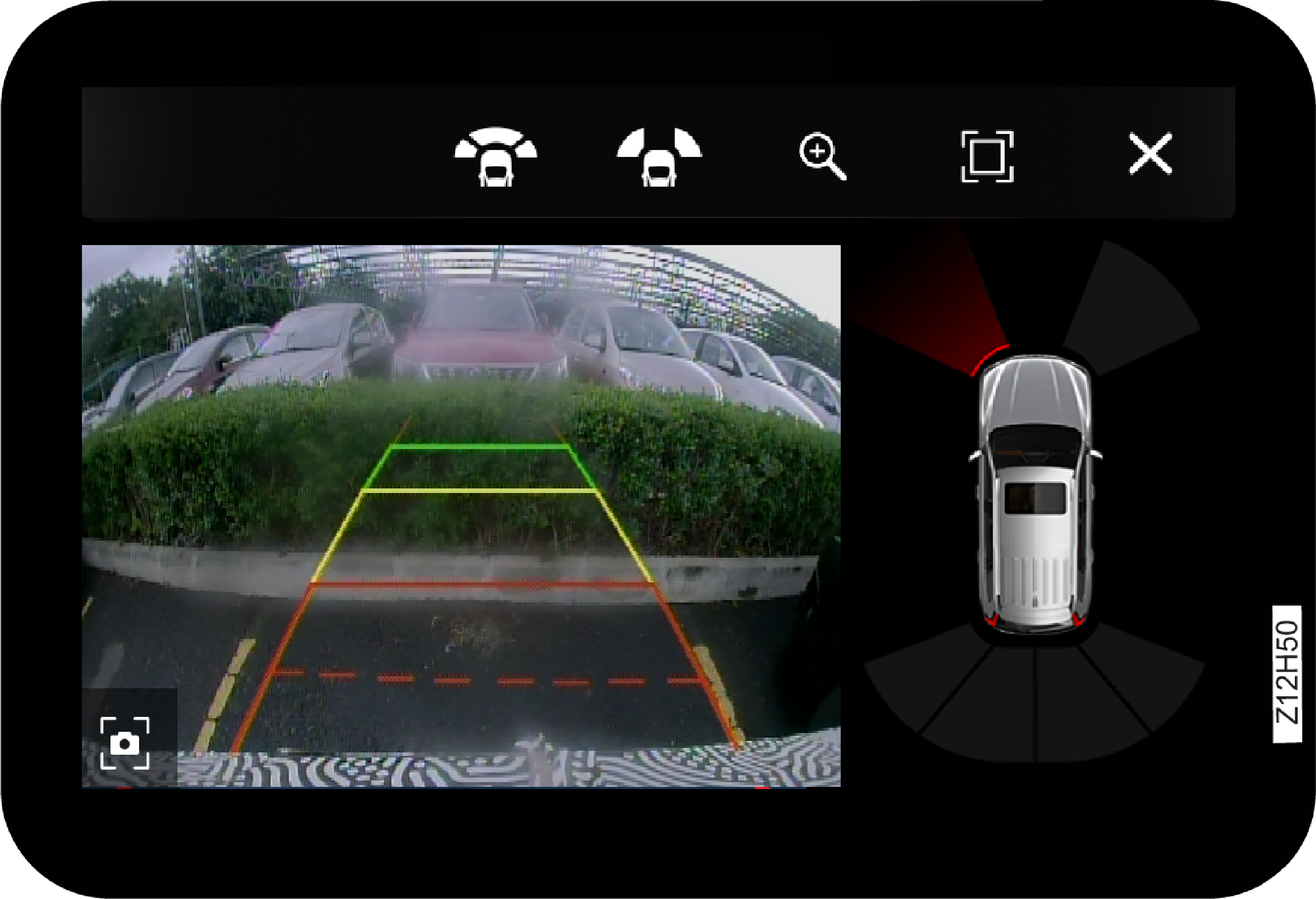
|
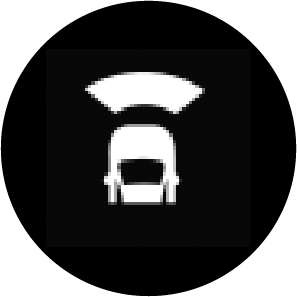
By selecting Normal View Icon, Front View camera
provides view of vehicle's front surrounding on the Infotainment screen.
|
|
2. Zoom-In
View
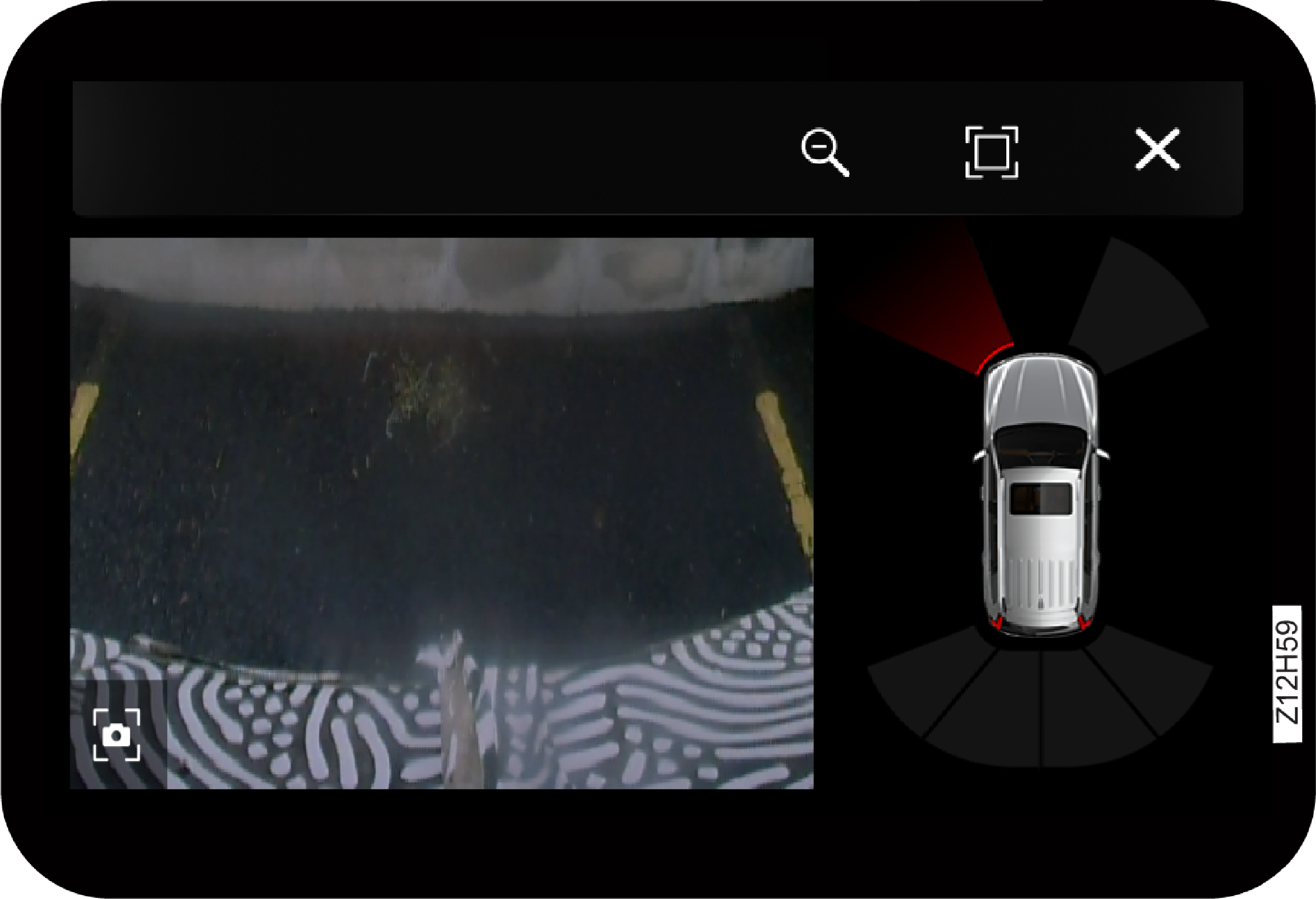
|
Press Zoom-In button to view objects closer and
press
Zoom-Out button to go back to the normal parking view.
|
|
3. Full
View/Wider
View
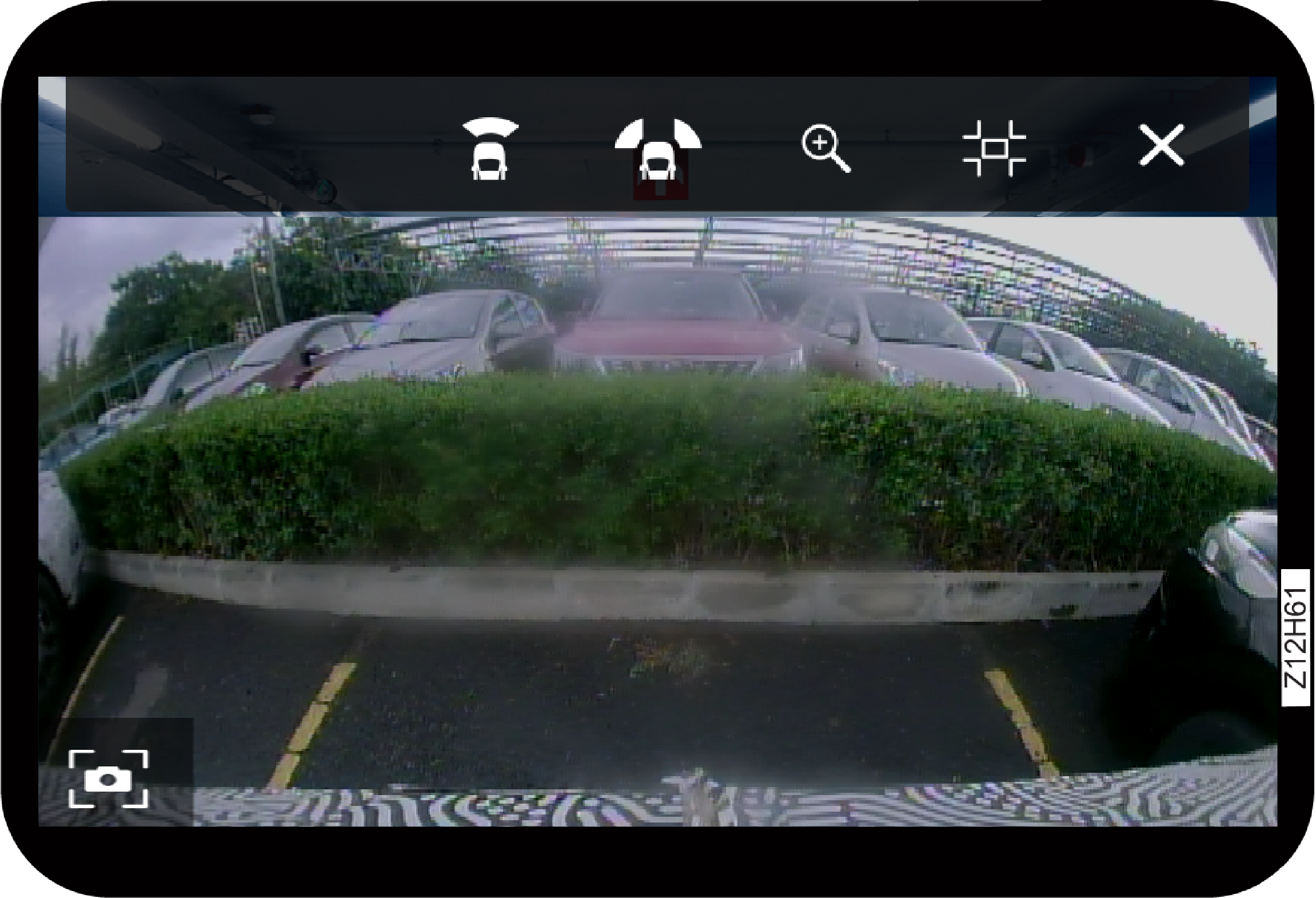
|
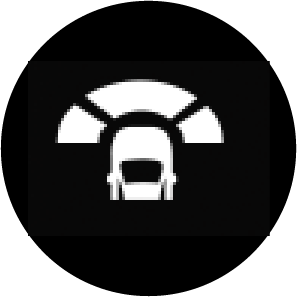
By selecting Full View Icon Front View camera
provides
wide front view of vehicle's front surrounding on the Infotainment
screen.
|
Full view is wider than Normal View.
|
4. Merged Corner
View

|
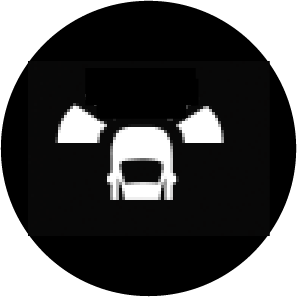
By selecting Merged Corner front View camera
provides a
wide view focussed on the left and right corners to provide a better
visibility of crossing traffic for safe maneuverer.
|
Merged Corner View shows merged view of front left and right
corners.
|
5. Left Corner
View

|
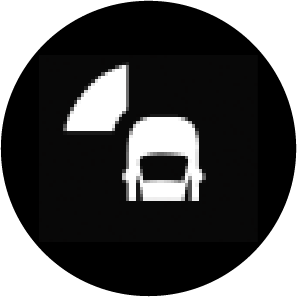
If user wants to focus on the left side crossing
traffic, then "Left Corner View" icon can be pressed to select the view.
|
|
Select “Back” Icon to switch to Merged Corner View.
|
|
|
6. Right Corner
View

|
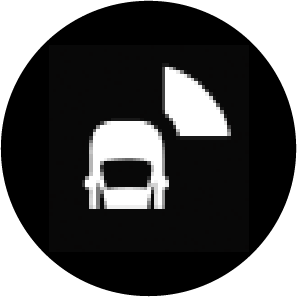
If user wants to focus on the right side crossing
traffic, then "Right Corner View" icon can be pressed to select the view.
|
Select “Back” Icon to switch to Merged Corner View.
7. Static and
Dynamic
Guidelines
Static Guidelines
indicate
the placement of the vehicle with respect to the parking slot during parking. During parking,
compare the Static
guidelines against the Parking Slot Lines to know if vehicle placement is in-line with the
parking slot lines.
Color coding on Static lines help in assessing the distance of
obstacle from the vehicles’ front. In the FVC Video, if Red
color dashed line falls on an object on the floor then the Object is within 0.5 meter distance from
the vehicle’s front. Likewise,
Red solid line indicates 0.5-1mts, Yellow indicates 1-2 mts, and Green indicates 2-3 mts.
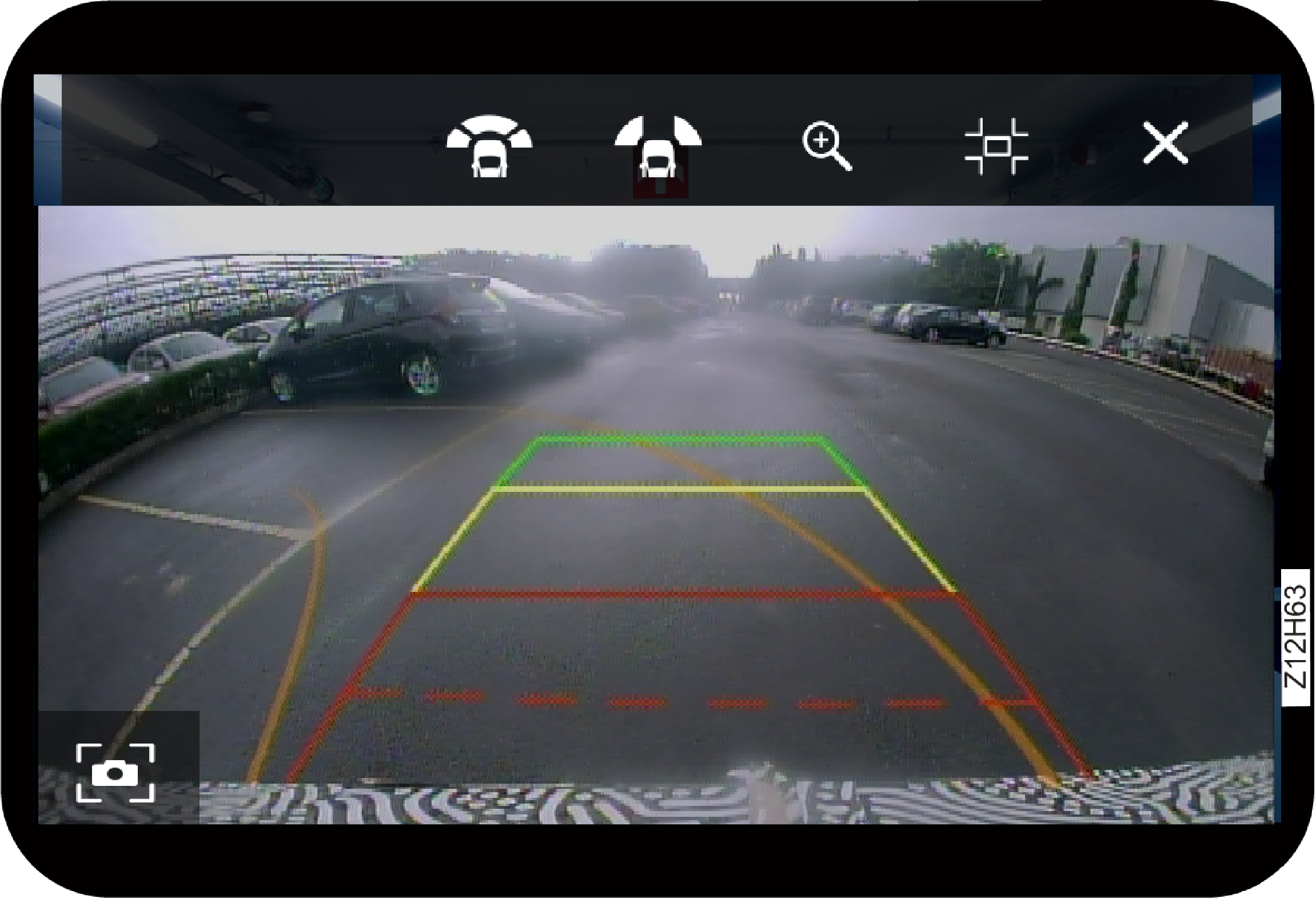
|
Dynamic
Guidelines (orange color in below image) indicate path, the vehicle will
traverse with current steering position. As per the steering
angle movement, dynamic guidelines move and show the vehicle predicted moving
direction
to help the driver.
|
9.10.2 Entry and Exit
Conditions
Entry
Conditions
Turn on ignition and press the FVC piano switch, Infotainment will
enter into ‘Front View Camera Mode’ and displays the video.
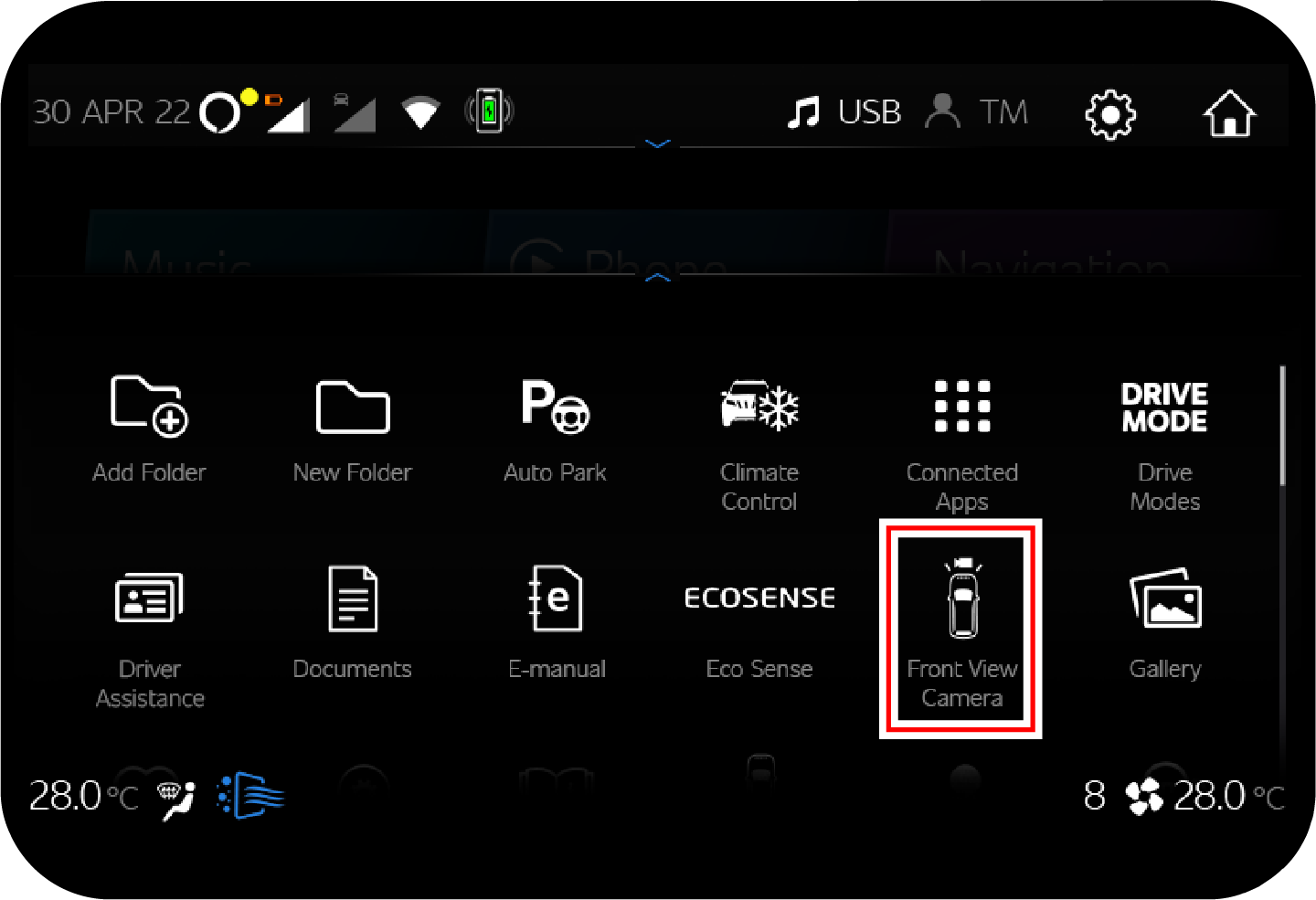
|
You can also view vehicle’s front surrounding, by
selecting front View Camera option present on Infotainment Screen.
|
Exit
Conditions
| • | If the driver has selected entry to ‘FVC Mode’ by selecting Front View Camera option present on Infotainment Screen or the FVC piano switch option, then FVC mode exits when reverse gear is engaged. |
| • | If the driver has selected entry to ‘FVC Mode’ by selecting Front View Camera option present on Infotainment Screen or the FVC piano switch option, then FVC mode exits by selecting the cancel button appearing on the screen. |
| • | When ignition is off. |
9.10.3 Camera Maintenance
Always keep the Camera lens clean from dust. Presence of
dirt on lens
may lead to poor image quality.
Always use clear water & soft nonabrasive cloth to
clean the lens.

Don’t clean the camera lens and the area around the front view
camera with a power washer.
| • | In case of any FVC-related issues, the Infotainment displays ‘ Please Contact Service Centre’ and vehicle needs to be taken to the Service Centre. Avoid using the Front-View Camera under these circumstances. |
| • | If front of your vehicle is damaged or if the Camera position is changed, please contact the nearest Mahindra Authorised Service Center immediately. |
9.10.4 System Limitations
| • | Front view camera may not operate normally, when you drive in the extremely high or low temperature area. (Operating temperature: -20°C ~ 65°C) |
| • | Under certain circumstances given below, the front view camera system will work with limitation or will not function fully: |
- In heavy rain, snow or fog.
- At night or in very dark places.
- If the camera is exposed to very bright light sources.
- Display may flicker, if the camera area is lit by LED
or fluorescent
lighting.
- If there is a sudden change in temperature, from cold
to hot areas.
- If the camera lens got dirty or obstructed.
| • | If the front of your vehicle got damaged. And if the Camera position and the settings got changed. Please contact the nearest Mahindra Authorised Service Center |
| • | Camera image reproduced slightly delayed and not in real time due to processing. As the display is 2-dimensional, pointed and protruding obstacles are hard to depict and thus very difficult to recognise. Please avoid front view camera in the above situation. It could you otherwise injure others or damage objects and your vehicle |
| • | The performance gets affected sometimes due to deposition of ice, dust, heavy rain, heavy wind, heavy exhaust on the camera |

| • | Images shown on the display is a mirror-inverted manner, Make sure that no persons or animals or any objects/materials are in the manoeuvring area. Pay attention and ensure safety before manoeuvring the car. Driver is legally responsible for their car |
| • | The front view camera is only a supplementary function and may display obstacles from a distorted perspective & inaccurately |
| • | Avoid using of front view camera, if you are having eye colour blindness or impaired colour vision |
| • | Objects above the ground or hanged may appear to be far away than they are. But in reality, objects shall be closer to your car. In such cases, avoid using guidelines to judge the distance. Since it leads to mis-adjustments and increase the risk of collision with your car |
| • | It is driver’s responsibility to identify the suitable parking area to park car safely |

Front View Camera is only meant to aid the driver and to enhance
convenience while parking. It does not in any way replace
the driver’s abilities and driving skills while using this system. Under any circumstances,
Mahindra accepts no responsibility
and cannot be held liable for any direct or indirect, incidental or consequential damage caused
by
this system.
9.11 Steering
Your vehicle is equipped with Power steering (Electric Power Steering
(EPS) (or) Hydraulic Power Steering (HPS)). This system provides an external assist, so that the driver can easily
rotate the steering wheel without much effort.
The power steering system will give you good vehicle response and increased ease of manoeuvrability in
tight spaces. If for
some reason the power assist is interrupted, it will provide mechanical steering capability to steer
the
vehicle. Under these
conditions, you will observe a substantial increase in steering effort, especially at very low vehicle
speeds and during parking
manoeuvres.

Continued operation with
reduced
power steering performance could pose a safety risk to yourself and others. Have the vehicle
serviced at specified intervals or whenever a power steering problem is noticed.
Keep both hands especially your
thumbs on the outside of the steering wheel rim. Do not hold the steering wheel spokes.

If the power steering system
breaks down (or if the engine is turned OFF or Not availability of vehicle speed / Power cut
off), you can still steer the vehicle manually, but it takes more effort.
If the steering wanders or pulls, check for:
| • | Under inflated tyre(s) on any wheel(s) |
| • | Uneven vehicle loading |
| • | High crown in the centre of the road |
| • | High crosswinds |
| • | Wheels out of alignment |
| • | Wheels out of balance |
| • | Loose or worn suspension components |

For HPS during initial start-up in cold weather, the power steering pump may
produce noise for a short amount of time. This is due
to the cold, thick fluid in the steering system. This noise should be considered normal, and it
does not in any way damage
the steering system.
Precaution to help prevent damage to the power steering
pump:
| • | Never hold the steering wheel to the extreme right or the extreme left for more than a few seconds when the engine is running |
| • | Heavy or uneven steering efforts may be caused by low power steering pump fluid level. Check the low power steering pump fluid level before seeking service from an Authorized Mahindra Dealer |
| • | Do not fill the power steering pump reservoir above the MAX mark on the reservoir, this may result in leaks from the reservoir |
9.11.1 Tilt Steering
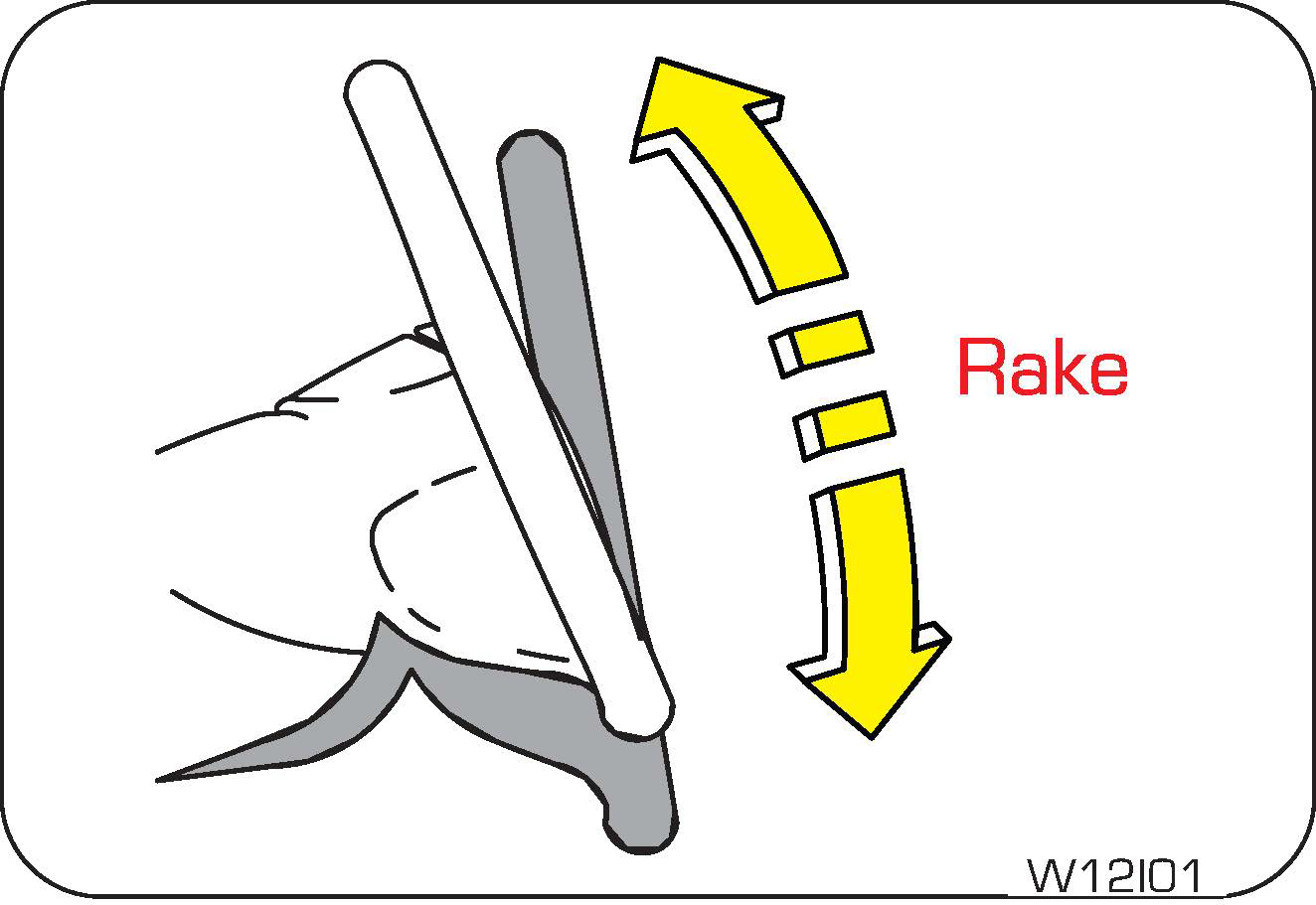
|
The steering wheel can be adjusted as required using
the lever in the steering shroud under the steering wheel.
|
To tilt/adjust the steering wheel:
|
|
1. Pull the tilt lever down to unlock.
2. Raise or lower the steering wheel to the desired
position.
|
3. Move the steering wheel to the desired position.
4. Push the tilt lever back up to its original position
to lock the
steering.

Improperly locked steering
wheel could cause loss of control and lead to accidents. Never adjust the steering wheel
while
driving.
9.12 Steering Controls - Audio (if
equipped)
The steering wheel also houses switches to control the main
audio
functions.
Steering Audio
Operations
|
A: Mute
|
E: Source
|
|
B: Volume +
|
F: SEEK UP
|
|
C: Volume -
|
G: SEEK DOWN
|
|
D: Call Connect
|
H: Voice / Call Disconnect
|
| • | SOURCE - Press SOURCE button to toggle between TUNER, USB, BT AUDIO and MYDRIVE |
| • | VOLUME CONTROL - Press ‘+’ and ‘- button to increase or decrease the volume |
| • | MUTE - Press MUTE button to mute audio while in TUNER mode and pause the song while in USB mode |
| • | USB MODE - Press the seek button 'UP' / 'DOWN' moves to next / previous track of MP3 and video Playing |
| • | TUNER MODE - Press the seek 'UP' / 'DOWN' button briefly: Manual Search, moves to selected channel. Press and hold the seek button 'UP' / 'DOWN' for 2 seconds to AUTO Search |
| • | Call Connect - Press to accept incoming call to the paired BT phone. |
| • | Call Dis Connect - Press to reject or end active call to the paired BT phone. |
| • | Call Dis Connect - Press to activate Alexa or OK Google or Siri voice assistant. |
9.13 Cruise Control (if equipped)
Cruise control allows you to maintain a set speed without the need to
keep your foot on the accelerator pedal. It should be
used for cruising on straight, open highways. Never use it for city driving, inclines, winding roads,
slippery roads, heavy
rain or in bad weather conditions.
It works on the closed loop system principle to maintain the set speed
of
the vehicle; the system controls the fuel injection
of the engine in order to maintain the set speed.
|
A
|
CRUISE ON/OFF
|
F
|
UP
|
|
B
|
SET +
|
G
|
ENTER
|
|
C
|
SET –
|
H
|
DOWN
|
|
D
|
CRUISE RESUME
|
I
|
FAVOURITE
|
|
E
|
CLUSTER MENU
|
Cruise control enhances your comfort while driving and allows you to
effortlessly maintain the desired lane speed limit. Improper
use of the cruise control can lead to an accident.

Cruise control is designed to
operate above a vehicle speed of 20kmph - MT / 35kmph - AT for all gears except 1st and reverse
gears. The cruise lamp in the instrument cluster functions only if the cruise control is
active.
Cruise control will
function only
under the following conditions;
| • | The vehicle is cruising above 20kmph - MT / 35kmph - AT |
| • | Engine RPM above 1200 RPM |
| • | Vehicle is in any gear except 1st and reverse |
| • | Clutch pedal released. |
| • | Brake pedal released. |
| • | Cruise button has to be pressed to activate cruise control |
| • | Cruise is activated first time in an ignition cycle by SET + / SET - button |
| • | Subsequent cruise engagements can be done by RESUME SET+ /SET- buttons in the same ignition cycle |
Cruise control is
deactivated under
the following conditions:
| • | CRUISE OFF button is pressed |
| • | Brake or clutch pedal depressed |
| • | If the vehicle speed exceeds the cruise set speed by 30 kmph by accelerator pedal intervention |
| • | If vehicle speed is increased by 10 kmph for more than 30 seconds by pressing the accelerator pedal |
| • | When Set+/Set- switch is pressed for more than 12 seconds (In this case, vehicle will not go into cruise mode in that ignition cycle. In order to restore the cruise function, switch OFF the ignition, wait for 30 seconds and switch ON the ignition) |
| • | Cruise influencing error indicated by Check Engine Lamp, OBD lamp, etc. |
9.13.1 Cruise Control
Activation
Drive the vehicle to the desired cruising speed (any value greater
than 20 kmph), press and hold the SET+ button until the
cruise lamp in the instrument cluster illuminates.
If cruise is deactivated (e.g. by depressing brake to handle an
intervention in the road etc.) in current driving cycle, reactivate
the Cruise to the last active Cruise Speed by pressing the RESUME button.
Cruise control may not hold the set speed when you are going up or
down hills, and the vehicle may come out of cruise control.
This is indicated by the cruise lamp going OFF in the instrument cluster.
9.13.2 Cruise Control
De-activation
You can cancel cruise control in any of the following
ways:
| • | Press the CRUISE OFF button in the steering wheel |
| • | Press the brake pedal |
| • | Gear selector moved into neutral |
| • | HDC or ESP becomes active |
9.13.3 SET + Button
SET + button is used to activate cruise control and also
to increase
the cruise set speed.
To increase the speed in very small amounts, press the SET +
button.
Each time you press, the cruise set speed increases by
about 2 kmph. When you wish to continuously increase the cruising speed, press and hold the SET +
button and release when
the desired speed is reached.
9.13.4 SET - Button
To decrease the speed in small amounts, press the SET - button.
Each
time you press, the cruise set speed decreases by about
2 kmph. When you wish to continuously decrease the cruising speed, press and hold the SET- button.
When the desired speed
is reached, release the button.

If switch is pressed for more than 12 secs., the switch is
assumed to be malfunctioning and the cruise functionality ceases
to function in that ignition cycle. To resume functionality, ignition has to
toggled.

The cruise control is a convenience system designed to
assist
the driver during vehicle operation. The driver must at all
times remain alert of road / traffic conditions and responsible for the vehicle
brake
operation / steering control.
Never activate cruise control in traffic or when driven in
adverse road conditions (heavy rains, windy, slippery
etc.)
9.13.5 RESUME Button
With the help of RESUME, you can opt for the previous
set cruising
speed of the vehicle in the same ignition cycle. This is
best explained with the following example:
| 1. | Assume, you have activated cruise mode and set the vehicle speed at 50 kmph. |
| 2. | Due to an obstacle or a sharp turn, you have deactivated the cruise mode either by pressing the brake pedal or by switching OFF the CRUISE control. |
| 3. | Vehicle comes out of the cruise mode. |
| 4. | When the road condition is suitable to switch over back to cruise control mode, press RESUME button once. The system activates the cruise control mode to the previous cruising speed of 50 kmph. |
| 5. | To resume the previous cruise set speed, the vehicle speed should be above 20 kmph. |
9.13.6 Override Function
This function enables user to ramp up the cruising speed
to overtake
front vehicle.
The cruising speed can be increased by using accelerator pedal.
User
has to complete this action within 30 seconds, to maintain
the cruise mode. If user exceeds the 30 seconds limit, cruise mode will be deactivated.
10 EMERGENCIES
10.1 Hazard Warning Flashers
The hazard
warning flasher
button is in the central bezel switch bank.
Press the button
to turn ON
the hazard warning flashers, all directional turn signals will flash to warn oncoming
traffic.
This is an emergency
warning
system and should be used only when there is an emergency. Use it when your vehicle is
disabled
and is a safety hazard for other motorists. Hazard warning flasher will work in all positions
of
the ignition key and even
when the vehicle is fully locked.

With extended use, the hazard warning flasher may drain your
vehicle battery.
10.2 Towing
Tow hook is a screw on type, and it is available in the
tool kit behind
the rear seats on the floor.
Remove/pry out the tow hook cover in the Front/Rear bumper using a
screwdriver, Screw in the tow eye in the anti-clockwise
direction (tow eye is LH threaded) by holding the cover and tighten. Fasten a cable or chain
specifically
intended for use
in towing vehicles to the towing hook.
|
Front Tow
Hook
|
Rear Tow
Hook
|
|
|
|
The rear tow hook should be used when your vehicle is
utilized for towing
other vehicles.
If your vehicle needs to be towed, call a professional towing service.
If
a towing service is unavailable in an emergency,
your vehicle may be temporarily towed by a towing cable or chain.
10.2.1 Towing Equipment
Towing equipment are of two types:
Sling-type equipment -
The
tow truck uses metal cables with hooks on both ends. These hooks go around parts of the frame or
suspension and lift
the end of the vehicle off the ground. This is not a good method of towing as it may damage the
vehicle's suspension and body.
Avoid a tow with sling type equipment
Flat-bed equipment -
Your
vehicle is loaded on the back of a truck. This is the safest and best way of towing
|
Towing
Option
|
2WD
|
Towing
Condition
|
Wheels
OFF the Ground
|
4WD
Models
|
|
|
ü
|
On Trailer
|
ALL
|
ü
|
|
|
O
|
Flat Tow
|
NONE
|
O
|
|
|
O
|
Dolly Tow
|
Front
|
O
|
|
|
ü
|
REAR
|
O
|
10.3 Emergency Assistance
In case of emergencies, driver/customer can follow the
below steps to
connect with our Emergency assistance service either
from the car or through mobile phone.
|
|
e-Call# : In
an
unfortunate event of your car meeting with an accident, triggering the airbags, your
SCORPIO-N will initiate the following actions - |
|
|
1. A call will be triggered automatically from your
SCORPIO-N to 108* Ambulance Service for medical assistance
|
|
|
|
|
2. Mahindra With You Hamesha team will call you back
for
support and guidance
|

* [108] number is the default option. This number can be changed
based
on your preference/location . Contact a Mahindra Authorised
Dealer
^This feature is available only in cars fitted with telematics unit
# On cars without telematics unit, this function will work if a
mobile
phone is paired through Bluetooth and connected to
the car at the time of the incident.
SOS Call from
vehicle^
|
SOS button
in
Center Fascia Switch
|
SOS button
in
infotainment
|
|
|
|
For SOS call, the driver can either operate the switch
located in center
fascia switch (1)or touch the SOS icon in the Infotainment
(2).
By operating the SOS icon, a call will be triggered
automatically from
your SCORPIO-N to 108* Ambulance Services for Medical
assistance
RSA call from vehicle
^
By touching the RSA icon in infotainment, your SCORPIO-N
will connect you
to Mahindra Roadside Assistance for support.
(3) RSA icon in infotainment screen
Emergency Assistance
from
Mobile
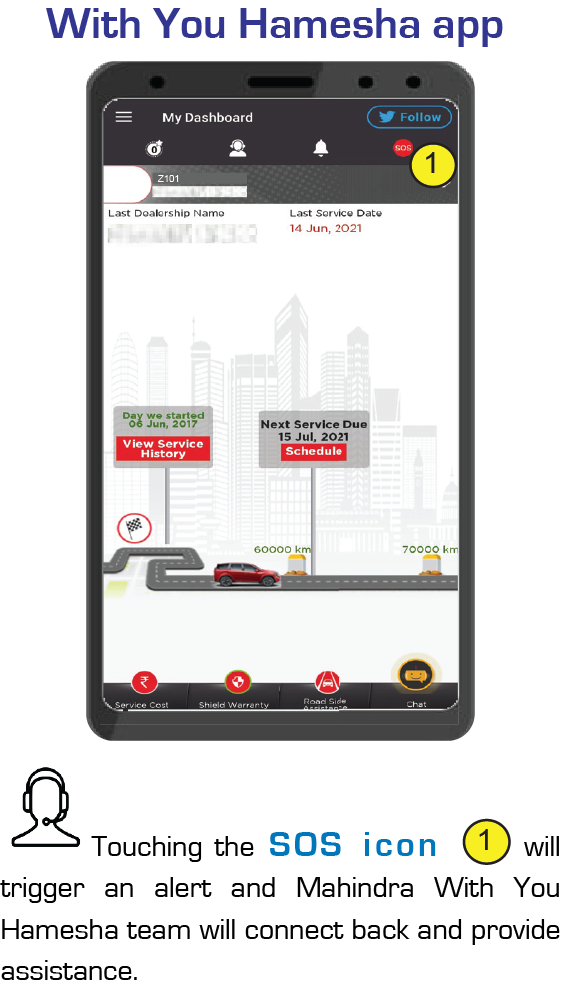
10.4 Vehicle Does
Not
Start - Checks
Before making
these checks,
make sure you have followed the correct starting procedure and that you have sufficient
fuel.
If the engine is not
cranking or
is cranking too slowly / intermittently
| 1. | Check that the battery terminals are tight and clean. |
| 2. | If the battery terminals are firmly fastened, switch ON the interior lamps. |
| 3. | If the lamps do not illuminate, glow dim or go OFF when the starter is cranked, then it indicates a weak or discharged battery. Try jumpstarting. Follow ‘jump starting’ instructions given later in this chapter. |
| 4. | Check the fuses in the Engine Compartment Fuse Box and Instrument Panel Fuse Box. |
If the engine cranks
normally, but
does not start
If the engine is cranking normally, but if the engine
does not start
even after repeated cranking, Contact an Mahindra Authorised
Dealer.

To prevent damage to the starter, do not crank the engine for
more
than 15 seconds at a time. Wait 10 to 15 seconds before
trying again.
If the engine stalls
while
driving
| • | Reduce your speed gradually, keeping a straight line. Move cautiously off the road to a safe place. |
| • | Turn ON your hazard warning flashers and check for any malfunction lamps in the instrument cluster. |
| • | Turn the ignition OFF, wait for approximately 90 seconds and try starting the engine again. |
| • | If the vehicle still does not start, contact an Mahindra Authorised Dealer. |

If the engine stalls while running, the power assist for the
brakes
will not work. Braking will be much harder than usual.
If the engine speed
does not
increase
| • | If the engine speed does not increase when the accelerator pedal is depressed, there may be a problem in the Engine Management System, electrical or electronic controls. |
| • | In case of certain faults, the engine may go to limp home mode, which is indicated by the check engine lamp. |
| • | Have your vehicle checked by an Mahindra Authorised Dealer as soon as possible. |
10.5 Engine Overheating
If the temperature gauge
moves beyond the normal operating range toward “H” mark. it indicates the engine
overheating
that
may damage the engine.
When the engine overheats, the Engine Management System reduces engine power substantially and may even shut the engine OFF; it is dangerous to continue driving when the engine has overheated. You need to first cool the engine down before starting to drive again.
When the engine overheats, the Engine Management System reduces engine power substantially and may even shut the engine OFF; it is dangerous to continue driving when the engine has overheated. You need to first cool the engine down before starting to drive again.
Follow the
below
instructions to cool the engine down:
| • | Progressively reduce the vehicle speed and bring the vehicle to a stop at the side of the road |
| • | Turn ON the hazard warning flashers |
| • | Keep the engine running at idle |
| • | Engage the parking brake |
| • | Switch off the air conditioner |
| • | Wait till the engine coolant temperature drops sufficiently such that the temperature gauge is around halfway between C and H |
Now switch the engine
OFF
and carefully open the bonnet/hood to visibly inspect the engine cooling system parts. Be
cautious
while doing an inspection as vehicle parts will still be too hot. Verify that the engine
coolant level in the coolant recovery
tank is maintained between the 'Min' and 'Max' mark. Check for possible fluid leakages.
Check
for damages to heat exchangers
and connecting hoses. Also verify that the radiator shrouds, cooling fan blades and the
engine belt all are in good condition.
If any evidence of failure is observed, contact the nearest Mahindra Authorised Dealer for help. In case, no system leakage/ failure is suspected, driving can be continued.
Either due to severe operating conditions or due to any system leakages or failures, the engine can get overheated. However, if the engine is getting overheated repeatedly, even in normal operating conditions, get the vehicle checked by an Mahindra Authorised Dealer as soon as possible.
If any evidence of failure is observed, contact the nearest Mahindra Authorised Dealer for help. In case, no system leakage/ failure is suspected, driving can be continued.
Either due to severe operating conditions or due to any system leakages or failures, the engine can get overheated. However, if the engine is getting overheated repeatedly, even in normal operating conditions, get the vehicle checked by an Mahindra Authorised Dealer as soon as possible.

Refer to the 'High Engine Coolant Temperature' section
under
the 'Instrument cluster features' chapter for details.

If the high engine coolant temperature warning is ignored,
the
engine shuts OFF abruptly to safeguard engine components from
overheating and consequent failure. Abrupt engine shut-off can lead to
uncontrollable
driving condition and accidents.
Stay clear of hot and rotating vehicle parts while visually
inspecting the vehicle. The coolant inside the cooling system
is under high pressure and temperature. Never open the pressure cap of the degassing
tank when the engine is hot. Not taking
precautions may lead to serious injury to your
skin/eyes.

For optimum performance of the cooling system, you must
maintain the required coolant level and use only recommended engine
coolant.
10.6 Jump Starting
Jump start can be performed when the battery charge is low
which can be
confirmed by performing the following operations:
| 1. | Turn headlamp ON and check whether lights are dim |
| 2. | Try to start the vehicle and check whether engine cranks slowly or not crank at all. |
| 3. | Open the bonnet and locate the battery.

It may be necessary to remove the disabled vehicle’s
battery cables from the battery terminals and clean both cables and terminals.
Use a stiff wire brush to remove all corrosion. Reconnect the cables to the battery
terminals before jump starting the vehicle.
|
| 4. | The positive terminal will be marked with a plus sign (+) and will usually have a RED cable attached on it. |
| 5. | The negative terminal will be marked with a minus sign (-) and will usually have a BLACK cable attached to it. |
| 6. | A standalone booster battery can be used to start the engine when the vehicle battery is low. |
| 7. | Take jumper cables and unwind the red and black cables. |
| 8. | Wear safety gear and connect one end of red clamp of the jumper cable to the positive (+) terminal of the discharged battery and other end to the positive (+) terminal of the booster battery. |
| 9. | Similarly, connect one end of black clamp of the jumper cable to the negative (-) terminal of the booster battery and other end to the negative (-) terminal of the discharged battery. |
| 10. | Once the jump starting assembly is done, crank the engine for starting. |
| 11. | Once the vehicle gets started, carefully remove the jumper cables in the reverse order of attachment. |
| 12. | Disconnect the black clamp of the jumper cable from the negative (-) terminal of the discharged battery and the other end of the black clamp from the negative (-) terminal of the booster battery. |
| 13. | Similarly, disconnect the red clamp of the jumper cable from the positive (+) terminal of the booster battery and the other end of the red clamp from the positive (+) terminal of the discharged battery. |
| 14. | Close the bonnet |
| 15. | Keep the vehicle's engine running and slightly accelerate the vehicle to charge the battery. |

If the problem persists on next starting cycle, please visit
Mahindra
Authorised Dealer
|
|
|

Make sure none of the cables are dangling into the engine
compartment,
where they could be exposed to moving parts.
| • | Remove the jumper cables once the vehicle starts. Do this in the reverse of the order in which they were attached, and don't let any of the cables or clamps touch each other (or dangle into the engine compartment) |
| • | Disconnect the black clamp of the jumper cable from the negative (-) terminal of the discharged battery |
| • | Disconnect the other end of the black clamp from the negative (-) terminal of the booster battery |
| • | Disconnect the red clamp of the jumper cable from the positive (+) terminal of the booster battery |
| • | Disconnect the other end of the red clamp from the positive (+) terminal of the discharged battery |
Replace any positive (+) red post protective covers if applicable (You
have had to remove or open these in the beginning)
These covers help prevent accidental short circuiting of the battery
| • | Keep the vehicle's engine running. Run the vehicle above idle (slightly revved up with your foot on the accelerator). This should give the battery enough charge to start the vehicle again. If it does not start, either your battery might be dead or faulty alternator. |
Improper jump starting procedures can result in battery
explosion and
acid burn hazard.
Loosely connected battery cables could damage the
electronic control
units.
To disconnect battery terminals, wait for at least 2
minutes to allow
discharge of high voltage or it could lead to personal
injury.
While disconnecting, always disconnect the -VE terminal
first and while
connecting, always connect the -VE terminal last.
Do not connect battery terminals with opposite polarity, it
will lead to
alternator, Electronic control unit failures.
Towing a vehicle to start could be dangerous. The vehicle
being towed
could surge forward when the engine starts, causing
the two vehicles to collide, injuring the occupants.
Modern vehicles with electronic management systems should
not be jump
started without ‘protected’ jump starter leads.
10.7 Limp Home Mode
Limp Home Mode is an emergency declared by the EMS (Engine
Management
System) due to failure or malfunction of one/more critical
sensors/actuators. In this mode, the EMS (Engine Management System) will revert back to basic
minimum
requirement (fuel quantity
/ injection timings) to aid the driver to bring the vehicle back to the nearest workshop. The
drivability & fuel consumption
will be greatly affected.
If vehicle acceleration worsens or if there is a drop in vehicle
performance, there might be a malfunction in the engine management
system which triggers/activates the Limp Home Mode. This condition is accompanied by the check
engine
lamp illuminating in
the instrument cluster. In this mode, the vehicle speed is limited, and the accelerator pedal may
not
function normally. It
is recommended you contact an Mahindra Authorised Dealer immediately for assistance.
If the above telltale is ON/blinking, It indicates an emergency
situation declared by the EMS (Engine Management System) due
to failure of one/more critical sensors/actuators and triggers/activates the Limp Home Mode.
10.8 Fuses & Relays
A fuse is electric
protection
device. A fuse is placed in an electrical circuit, so that when current flow exceeds the
rating
of the fuse, it blows off. The element in the fuse melts, opening the circuit and preventing
other components of the circuit
from being damaged by the over current. The size of the metal fuse element determines the
rating. Once a fuse blows off, it
must be replaced with a new one.
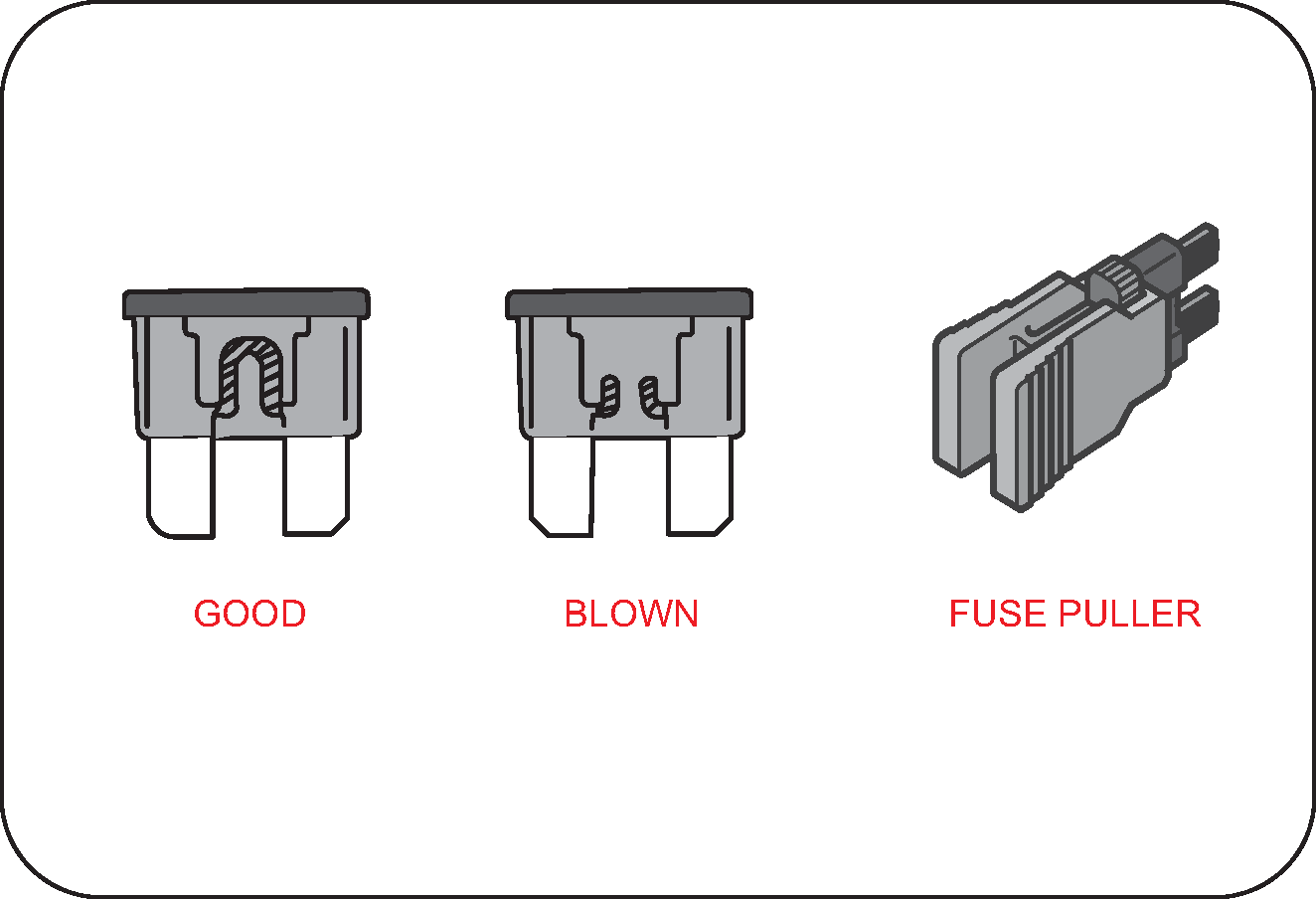
|
Switch the ignition and all electrical equipment OFF
before touching or attempting to change a fuse.
|
|
|
Fuse puller is available at the engine compartment fuse
box .
|

Fit replacement fuse
with
the same rating as the one you have removed.

You can identify a blown
fuse by a break in the filament. All fuses except high current fuses are push fit. A fuse
puller
should be used to remove the fuse from its position.
10.8.1 Engine Compartment Fuse
Box
|
|
|
Engine compartment fuse box is located adjacent to vehicle battery.
Release the lock to access the fuse box contents. Remove
the fuse box cover by pressing the clips from both sides using both hands simultaneously. Spare
fuses
are provided in the
fuse box for replacement of blown fuses. Ensure the correct rating fuse is replaced with the blown
fuse.
|
“EF”
Fuses (Mini Fuses)
|
||
|---|---|---|
|
Fuse
No.
|
Circuit
|
Fuse
Rating (A)
|
|
F1*
|
EMS Batt 1
|
15 (Diesel)
|
|
30 (Petrol)
|
||
|
F2
|
EMS Batt 2 (Diesel)
|
10
|
|
VVTIN/EX, VOP, CANISTER (Petrol)
|
||
|
F3*
|
HFM/FMU/Fuel Pump Relay Coil
|
10 (Diesel)
|
|
Ignition Coil/Fuel Pump Relay
|
15 (Petrol)
|
|
|
F4*
|
BMS
|
5
|
|
F5
|
Spare
|
—
|
|
F6
|
EMS ECU Permanent Batt
|
5
|
|
F7
|
Spare
|
—
|
|
F8
|
Horn
|
20
|
|
F9*
|
DRL B+
|
10
|
|
F10
|
Spare
|
—
|
|
F11
|
Spare
|
—
|
|
F12
|
EMS Load - Relays (GP/SCR/AC)/EGR Bypass
|
15
|
|
Lamda Sensor/HFM/AC Relay Coil
|
||
|
* - If equipped
|
||
|
“EF”
Fuses (Mini Fuses)
|
||
|---|---|---|
|
Fuse
No.
|
Circuit
|
Fuse
Rating (A)
|
|
F13
|
Brake Switch
|
10
|
|
F14
|
FR Blower
|
40
|
|
F15
|
Spare
|
—
|
|
F16
|
ABS Valve
|
25
|
|
F17
|
Spare
|
—
|
|
F18
|
ABS Motor
|
40
|
|
F19
|
Spare
|
—
|
|
F20
|
EMS Main Relay
|
40
|
|
F21 - F24
|
Spare
|
—
|
|
F25*
|
SCR Relay (Diesel)
|
10
|
|
Inter Cooler Fan (Petrol)
|
||
|
F26 - F29
|
Spare
|
—
|
|
F30
|
AC Compressor
|
10
|
|
F31
|
Fuel Pump
|
20
|
|
F32 - F36
|
Spare
|
—
|
|
F37
|
Starter
|
30
|
|
F38*
|
Glow Plug
|
50
|
|
* - If equipped
|
||
|
“EF”
Fuses (Mini Fuses)
|
||
|---|---|---|
|
Fuse
No.
|
Circuit
|
Fuse
Rating (A)
|
|
F39
|
Main Batt+3
|
50
|
|
F40
|
Cooling Fan Low Speed
|
40
|
|
F41
|
Main Batt+2
|
60
|
|
F42
|
Main Batt+3
|
60
|
|
F43
|
Main Batt+1
|
40
|
|
F44
|
ABS Ignition
|
5
|
|
F45*
|
EPS Ignition
|
5
|
|
F46
|
EMS Ignition
|
5
|
|
F47
|
Water Pump (Diesel)
|
10
|
|
Turbo Rec Valve (Petrol)
|
||
|
F48
|
Nox/WIF (Diesel)
|
10
|
|
F49*
|
EPS
|
80
|
|
F50
|
Radiator Fan (High Speed)
|
50
|
|
F51
|
Alternator
|
150
|
|
* - If equipped
|
||
|
Relays
|
||
|---|---|---|
|
Relay
No.
|
Relay
Type
|
Application Detail
|
|
R2
|
ISO Power Relay
|
Cooling Fan High Speed
|
|
R3*
|
ISO Power Relay
|
Glow Plug (Diesel Only)
|
|
R9
|
Ultra Micro Relay
|
Intercooler Fan (Petrol Only)
|
|
R11
|
Ultra Micro Relay
|
Fuel Pump
|
|
R13
|
Ultra Micro Relay
|
Horn
|
|
R14
|
Mini Relay
|
EMS Main
|
|
R15
|
Mini Relay
|
Cooling Fan Low Speed
|
|
R16
|
Mini Relay
|
Front Blower
|
|
R22
|
ISO Micro Relay
|
Starter
|
|
R23
|
Ultra Micro Relay
|
AC Compressor
|
|
R25*
|
Ultra Micro Relay
|
SCR (Diesel Only)
|
|
R1, R4, R5, R6, R7, R8, R10, R12, R17, R18,
R19, R20, R21, R24, R26 & R27
|
Spare
|
|
10.8.2 Instrument Panel Fuse
Box
Opening Procedure
Wide open the driver door and slide the driver seat
backwards. This
fuse box as located below the Instrument Panel on the
driver side
To access the IP fuse box, Pull out the fuse box cover
as shown in the
image.
|
Fuses
|
||
|---|---|---|
|
Fuse
No.
|
Circuit
|
Fuse
Rating
|
|
F1*
|
4WD B+
|
20A
|
|
F2*
|
ORVM SW
|
5A
|
|
F3
|
MBFM B+3
|
25A
|
|
F4
|
HVAC B+
|
10A
|
|
F5
|
MBFM B+2
|
25A
|
|
F6*
|
PKE BAT1
|
10A
|
|
F7
|
Wireless Charge/Diagnostic
|
5A
|
|
F8
|
MBFM B+1
|
25A
|
|
F9*
|
Crank
|
10A
|
|
F10*
|
ICC
|
10A
|
|
F11
|
PWR WIN RH
|
30A
|
|
F12
|
PWR WIN LH
|
30A
|
|
F13*
|
Sunroof
|
20A
|
|
F14
|
Spare
|
|
|
F15
|
Spare
|
|
|
F16
|
Roof/Sunvisor LP
|
10A
|
|
F17
|
Rear PWR WIN
|
30A
|
|
F18*
|
SC/NSC
|
20A/15A
|
|
F19*
|
RLS
|
5A
|
|
* - if equipped
|
||
|
Fuses
|
||
|---|---|---|
|
Fuse
No.
|
Circuit
|
Fuse
Rating
|
|
F20*
|
Power Seat
|
15A
|
|
F21
|
ACC-PKE/MBFM
|
5A
|
|
F22*
|
Blower Coil/AMP ACC
|
10A
|
|
F23*
|
ACC-RR USB Charg/INFO NSC
|
10A
|
|
F24
|
PWR Outlet
|
15A
|
|
F25*
|
RPAS IGN
|
5A
|
|
F26*
|
IGN - INHIBI
|
10A
|
|
F27*
|
P/W Smart Close RH
|
30A
|
|
F28*
|
4WD Actuator
|
10A
|
|
F29
|
PAB/SAS/CFS IP SW Bank
|
10A
|
|
F30
|
EC IGN Loads
|
10A
|
|
F31
|
IGN-Gateway/MBFM/Cluster
|
10A
|
|
F32*
|
IGN-FVC/RVC
|
5A
|
|
F33
|
IGN-Airbag
|
5A
|
|
F34
|
IGN-Info NSC/HVAC/AMP
|
10A
|
|
F35
|
IGN-PKE/Immobi
|
5A
|
|
F36*
|
P/W Smart Close LH
|
30A
|
|
F37*
|
IGN-APA
|
5A
|
|
F38*
|
Reverse Lamp
|
10A
|
|
* - if equipped
|
||
|
Fuses
|
||
|---|---|---|
|
Fuse
No.
|
Circuit
|
Fuse
Rating
|
|
F39*
|
W/L Charg
|
5A
|
|
F40*
|
IGN-AT/4WD
|
10A
|
|
F41*
|
AT B+
|
15A
|
|
F42
|
MBFM B+5
|
25A
|
|
F43*
|
Gateway Cont B+
|
5A
|
|
F44*
|
Cluster
|
5A
|
|
F45
|
MBFM B+4
|
25A
|
|
F46
|
PKE BAT2/Imobi
|
10A
|
|
F47*
|
ESCL Batt
|
10A
|
|
F48*
|
RR Blwr
|
10A
|
|
F49
|
Spare
|
10A
|
|
F50
|
Spare
|
15A
|
|
F51
|
Spare
|
5A
|
|
F52
|
Spare
|
20A
|
|
F53
|
Spare
|
25A
|
|
F54
|
Spare
|
30A
|
|
F55
|
||
|
F56*
|
FSS- Amplifier B+
|
30A
|
|
* - if equipped
|
||
|
Relays
|
||
|---|---|---|
|
Relay
No.
|
Relay
Type
|
Relay
Rating
|
|
R1
|
-
|
-
|
|
R2
|
Power Window Ext Relay
|
70A
|
|
R3*
|
AT Solenoid Relay
|
20A
|
|
R4*
|
RR Blower Relay
|
20A
|
|
R5*
|
Accessory Start Relay
|
40A
|
|
R6*
|
Ignition Relay HC
|
35A
|
|
R7
|
-
|
-
|
10.9 Changing a Flat Tyre
In case of a flat tyre during driving, reduce your speed gradually,
keeping a straight line. Move cautiously off the road
to a safe place well away from traffic. Park on a level spot with firm ground. Stop the engine and
turn
ON your hazard warning
flashers.
Firmly apply the parking brake. Have everyone come out of
the vehicle on
the side away from traffic.

Never stop your vehicle in a
traffic lane to change a tyre. You could be hit by an oncoming vehicle. Keep driving until you
reach a safe location.
Lifting a vehicle to change a tyre or perform maintenance is very
dangerous if you do not have the requisite tools, safety
equipment and training. The jack provided along with the vehicle is to be used only for changing a
spare
tyre. It is never
to be used to perform any other maintenance or repair on the vehicle.
Never place any part of your body
under any portion of the vehicle when it is supported only by the jack. You could be crushed
by the vehicle if it falls off a jack. Keep bystanders away from the vehicle.
Find level, solid ground
that
is clear of oncoming traffic. If you cannot find a safe place to stop, it is better to drive
on a flat tyre and damage the rim than it is to risk being hit by oncoming traffic. After
changing a flat Tyre, never store
the tyre or other equipment in the passenger compartment of the vehicle. This loose equipment
could strike an occupant in
the event of a sudden stop or collision. Store all of these items in the proper
place.
The following sections
outline the
procedure for changing a flat tyre;
10.9.1 Warning Triangle
The warning triangle is a necessary device for your
safety.
It is placed below the third row seat cushion.
Follow the below steps to access the warning triangle
|
|
|
| • | Tumble the seat again and Open the velcro for taking the warning triangle out. |
|
|
|
When you pull over your breaking down vehicle to a safe place, set
up
a warning triangle behind your vehicle. (Daytime: 100
Meters behind, Night: 200 Meters behind)
When the Vehicle has
a Serious
Problem during Driving
Turn on the hazard flasher and move the vehicle out of traffic to a
safe place. Set up the warning triangle behind your vehicle
(Daytime: 100 Meters, Night: 200 Meters) to warn other vehicles
Have all passengers get out of the vehicle and stay away
from the
traffic.
When your safety is secured, contact your Mahindra
Authorised Dealer
for your emergency service
10.9.2 Tool Kit
The tool kit is placed
behind the rear seats on the floor. It consist of Screwdriver (+and-), Jack operating
lever,
Tow bar,
DEO Spanner (10mm x 12mm) and Wheel spanner
|
|
|
|
1. Plug
|
5. Jack Operating extension Lever
|
|
2. Screwdriver
|
6. Tow Bar
|
|
3. Wheel Spanner
|
7. DEO Spanner 10mm x 12mm
|
|
4. Jack Operating Lever
|
10.9.3 Jack Removal Procedure
Jack is located on the left side of luggage compartment.
To remove the jack out follow the process below:
|
|
Fold the 3rd row seat and pull out the trim cover
snaps
as shown in the image.
|
|
|
Loosen the jack sufficiently .
|
|
|
Slide the bottom of jack towards out of the trim and
take out.
|
10.9.4 Spare Wheel Removal
Spare wheel is located below the floor at the rear end
of the vehicle.
It is held in place by a securing nut underneath the
rear luggage compartment floor carpet.
Locate the plug covering the securing nut below the rear luggage
compartment floor carpet and remove the plug
|
|
|
Loosen the securing nut anti-clockwise to winch down/lower the
secured
spare wheel to the ground
|
|
|
| • | Tilt and Remove the securing bracket out of the spare wheel hub |
| • | Remove/pull away the spare wheel |
|
|
|

The spare wheel provided on your vehicle is for temporary
purpose
only. Do not use the spare wheel for continuous running.
When Using the Spare
Wheel
| • | Spare Wheel provided is specifically designed for your vehicle. |
| • | Do not use more than one Spare Wheel simultaneously. |
| • | Drive the shortest possible distance with Spare Wheel. |
| • | While using spare wheel reduce speed, Avoid sharp cornering, Avoid sudden acceleration, abrupt steering, sudden braking and shifting operations that cause sudden engine braking. |
| • | Do not drive at speeds in excess of 80 km/h when a Temporary Spare Wheel is installed on the vehicle. |

Refer to “ Spare Wheel” section in the Starting and Driving
chapter
for more details.
The spare wheel provided on your vehicle is smaller in size
(T155/90 R18 113M) and for temporary purpose only. Do not use
the spare wheel for continuous running.
10.9.5 Wheel Nut Loosening
Before loosening the wheel nut, Wheel cover/cap must be removed. To
remove the wheel cover, wrap the tip of a screwdriver
with cloth, insert it near the lugs of the wheel cover and pry the cover away from the wheel.

Do not try to pry off the wheel cover by hand alone. Take due
care
in handling the wheel cover to avoid unexpected personal
injury.
|
|
Always loosen the wheel nuts before raising the
vehicle. Turn the wheel nuts anti-clockwise to loosen as per the sequence.
|
To get maximum leverage, fit the spanner to the nut so that the
handle
is on the left side. Grab the spanner near the end
of the handle and push down on the handle. Be careful that the spanner does not slip off the nut.
Do
not remove the nuts but
loosen them by one or two turns.

Do not apply force with your legs (or stand) on the wheel
spanner
while tightening or Loosening the wheel nuts.
|
|
A: Flat
Tyre
B: Chocks
Blocks
|
Block the wheel diagonally opposite the flat tyre to keep the
vehicle
from rolling when it is jacked up. When blocking the
wheel, place a wheel block in front of one of the front wheels or behind one of the rear wheels.
10.9.6 Jacking
Front jack up point
- On
the chassis long member just behind the front wheels.
Rear jack up point
- Under
the rear axle.
|
A
|
Rear Jacking Points
|
B
|
Front Jacking Points
|
|
Front
|
Rear
|
|
|
|
To raise the vehicle,
insert the jack handle end along with the extension into the jack and turn it clockwise
with
the jack
handle. As the jack touches the vehicle and begins to lift, re-check that it is properly
positioned. Raise it high enough
ensuring the spare wheel can be installed, but not to raise up above the ‘yellow’ line.
Remember you will need more ground
clearance when putting on the spare tyre than when removing the flat
tyre.

Make sure to set the jack
properly in the jacking point. Raising the vehicle with an improperly positioned jack will
damage
the underbody of the vehicle or may allow the vehicle to fall off the jack and cause personal
injury.
| • | Use the jack only for lifting your vehicle during wheel changing |
| • | Do not raise the jack with someone in the vehicle |
| • | When raising the vehicle, do not place any objects on top of or underneath the jack |
| • | Raise the vehicle only high enough to remove and change the wheel |
| • | Usable extended height of jack is up to the yellow line/mark. Do not raise the jack above the yellow line. |
| • | Follow jacking instructions |
| • | Do not start or run the engine while your vehicle is supported by the jack |

Never get under the vehicle when the vehicle is supported by the
jack alone.
Remove the wheel nuts. Lift the flat tyre straight off and place it
aside. Roll the spare wheel into position and align the
holes in the wheel with the hub. Lift up the wheel and get at least the top nut inserted through
its
hole. Wiggle the wheel
and press it back for fitting balance nuts.
Before putting on the wheels, remove any corrosion on the mounting
surfaces with a wire brush or such. Installation of wheels
without good metal to metal contact at the mounting surface can cause wheel nuts to loosen and
eventually cause a wheel to
come off while driving.
|
|
Reinstall the
wheel
nuts with the tapered end inward and tighten by hand. Press the wheel inward and
tighten the wheel nuts
further.
|

Never use oil or grease on the nuts. Doing so the spanner slips,
damaging the nuts and may cause personal injuries. Also,
nuts may loosen, and the wheels may fall off, which could cause a serious accident. If there is
oil
or grease on any nut,
clean before installing wheel nuts.
Lower the vehicle completely and tighten the wheel nuts using the
wheel spanner. Turn the jack-operating lever anti-clockwise
using the wheel spanner to lower the vehicle, making sure the handle remains firmly fitted onto the
jack handle extension.
Do not use other tools or any additional leverage other than your hands, such as a hammer, pipe or
your foot. Make sure the
spanner is securely engaged over the nut.
|
|
Tighten each nut
a
little at a time in the diagonally opposite order as shown. Repeat the process
until
all the nuts are tight.
|

Improperly or loosely tightened wheel nuts are dangerous. The
wheel
could wobble or come off. This could result in loss of
vehicle control and cause a serious accident. Always make sure all the wheel nuts are
properly/securely tightened to the specified
torque.
When lowering the vehicle, make sure all portions of your body
and
all other persons are clear off the vehicle as it is lowered
to the ground. Have the wheel nuts tightened with the torque spanner to 83-104Nm, as soon as
possible after changing wheels.

If you have rotated,
repaired,
changed your tyres or changed the wheel rims, check the wheel nuts are still tight after
driving
about 1,000 kms (Torque 120 Nm).
Put the wheel cover into position aligning the nozzle on the wheel
to
the nozzle clearance on the wheel cover. Tap it firmly
on the sides with your hand to snap it into place.
Restore the tools (jack, wheel spanner, Punctured tyre,
etc.) in their
storage locations.
|
|
|
Drive slowly to the
nearest
service station and inflate to the correct pressure. Always reinstall the valve cap after
checking
or adjusting tyre pressure, dirt and moisture could get into the valve core and cause air
leakage or valve damage.
11 MAINTENANCE
11.1 Dimensions
11.2 Technical Specifications
|
Technical
Specifications
|
|||
|---|---|---|---|
|
ENGINE
|
Diesel
(175
PS)
|
Diesel
(132
PS)
|
Petrol
(203
PS)
|
|
Displacement/Cubic Capacity
|
2183 cc
|
2183 cc
|
1997 cc
|
|
Type
|
D22 Engine with Intercooler Turbocharger
|
D22 Engine with Intercooler Turbocharger
|
G20 Engine with Turbocharger
|
|
Compression Ratio
|
16 : 1
|
16 : 1
|
9.5 : 1
|
|
Max. Engine Output
|
128.6kW @ 3500 +/- 50 rpm
|
97 kW @ 3750 +/- 50 rpm
|
149.14 kW @ 5000 +/- 50 rpm
|
|
Max. Torque
|
370 Nm @ 1500 to 3000 rpm (MT) /
400 Nm @ 1750 to 2750 rpm (AT) |
300 Nm @ 1500 to 3000 rpm
|
370 Nm (MT) / 380 Nm (AT) @ 1750 to 3000 rpm
|
|
TRANSMISSION
|
|||
|
Type
|
6 Speed Manual/Automatic
|
||
|
No. of Gears
|
6 Forward, 1 Reverse
|
||
|
STEERING
|
|||
|
Type/Description
|
Electric Power Steering - EPS
(With Rack mounted motor)
|
Hydraulic Power Steering - HPS
|
Electric Power Steering - EPS
(With Rack mounted motor)
|
|
SUSPENSION
|
|||
|
Type/Description
|
Front:
Double wishbone Suspension
Rear:
Multi Link Rear Suspension with Watt’s Linkage
|
||
|
BRAKES
|
|||
|
Service Brake
|
Hydraulic & Vacuum assisted Booster with
ABS
|
||
|
Front/Rear
|
Disc
|
||
|
Parking Brake
|
Mechanical Hand Operated (Conventional Type)
|
||
|
WHEELS
&
TYRES
|
|||
|
Rim
|
7J X 17” (Steel & Alloy), 7.5J X 18”
(Alloy)
& 7JX18” (Steel)
|
||
|
Tyres
|
P255/60 R18 (or)P245/65 R17
|
||
|
Type
|
Radial Tubeless
|
||
|
Laden Tyre Pressure (Psi)
|
Front /
Rear/Spare - 34
|
||
|
FUEL
|
|||
|
Fuel Tank Capacity
|
57 liters
|
||
|
DEF Tank Capacity
|
20 liters (only for Diesel)
|
||
|
ELECTRICAL
SYSTEM
|
|||
|
System Voltage
|
12V
|
||
|
Battery Rating
|
70 AH (DIN)
|
||
11.3 Bulb Specification
|
Lamp
Bulb
|
Wattage
|
Bulb
Type
|
No. of
Bulbs
per Vehicle
|
|---|---|---|---|
|
Head Lamp - High Beam*
|
12V 55W
|
H7 55W/LED
|
2
|
|
Head Lamp - Low Beam*
|
12V 55W
|
H7 55W/LED
|
2
|
|
DRL / Front Position Lamp*
|
LED
|
—
|
|
|
Turn Indicator Lamp (Front/Rear)*
|
12V 21W
|
PY21W
|
2
|
|
Turn Indicator Lamp (Front/Rear)*
|
Sequential LED
|
2
|
|
|
Side Turn Indicator Lamp*
|
LEDs
|
2
|
|
|
Front Position Lamp*
|
12V 5W
|
W5W
|
2
|
|
Front Fog Lamp*
|
LEDs
|
2
|
|
|
Front Cornering Lamp*
|
LEDs
|
2
|
|
|
Rear Position Lamp
|
LEDs
|
||
|
Stop Lamp
|
12V 21W
|
W21 W
|
2
|
|
Reverse Lamp
|
12V 21W
|
PY21W
|
2
|
|
Registration Plate Lamp
|
LEDs
|
2
|
|
|
High Mounted Stop Lamp
|
LEDs
|
1
|
|
|
* - If equipped
|
|||
11.4 General Owner's
Information
Your vehicle has been designed for fewer maintenance requirements
with
longer service intervals to save both your time and
money. However, each regular maintenance, as well as day-to-day care is more important to ensure a
smooth, trouble-free, safe
and economical operation. It is the owner's responsibility to make sure the specified maintenance,
including general maintenance
service is performed. Note that both the new vehicle limited warranty and emission control system
limited warranties specify
that proper maintenance and care must be performed. See Warranty and Service Information Guide for
complete warranty information.
Where to go for
service?
Mahindra technicians are well trained specialists and are kept up
to
date with the latest service information through technical
bulletins, service tips and in dealership training programmes. They learn to work on Mahindra
vehicles
before they work on
your vehicle, rather than while they are working on it.
You can be confident that your Mahindra Authorised Dealer service
department does the best job to meet the maintenance requirements
on your vehicle reliably and economically.
Get the most from your vehicle with routine maintenance:
Routine maintenance is the best way to help ensure you get the
performance, dependability, long life and better resale value
you expect from your vehicle. This is exactly why we've put together this Maintenance Section. It
outlines the services required
to properly maintain your vehicle and when they should be performed. The focus is on maintaining
your
vehicle while it's running
great, which goes a long way toward preventing major repairs and expenses later.
Here are a few suggestions to help you get started on
routine
maintenance:
| • | Familiarize yourself with your vehicle by going through your Owner's Manual |
| • | Take a few minutes to review this Maintenance Section |
| • | Make it a habit to use this manual to record scheduled maintenance in the warranty and Service Information Guide |
| • | Consult with your Mahindra Authorised Dealer for all your vehicle's needs |
Suggestions for
Obtaining Service
for your Vehicle
Prepare for the
Appointment: If you have warranty work to be done, be sure to have the right papers with
you. All work to be performed may not be covered
by the warranty. Discuss additional charges with the service manager. Keep a maintenance log of
your
vehicle's service history.
Prepare a List: Make a
written list of your vehicle's problems or the specific work you want done. If you've had an
accident
or work done
that is not on your maintenance log, let the Service adviser/Relationship manager know about it.
Be Reasonable with Requests:
If your list has several items and you must have your vehicle by the end of the day,
discuss
the situation with the Service
adviser/Relationship manager and list the items in order of priority.
Need Assistance? : It
is
recommended talking to an Mahindra Authorised Dealer service manager first. Most matters can be
resolved with this
process. If for some reason you are still not satisfied, talk to the general manager or owner of
the
dealership.
If an Mahindra Authorised Dealer is unable to resolve the concern,
you
may contact any Mahindra Customer Care Executive. They
would need the following information:
Owner's name and address, owner's telephone number (home and
office),
Mahindra Authorised Dealer name, Vehicle Identification
Number (VIN), vehicle delivery date and mileage.
Warranty Information:
Read
the Warranty Information given in the ‘Warranty and Service Information Guide’ for the terms and
provisions of Mahindra
warranties applicable to this vehicle. Mahindra genuine parts, fluids, lubricants and accessories
are
available at any Mahindra
Authorised Dealer. They will help keep the vehicle operating at its best.
Protect your Warranty:
Routine maintenance is not only the best way to help keep your vehicle performing as
intended,
it's also the best way to protect
your warranty. Failure to perform scheduled maintenance specified in the warranty and Service
Information Guide will invalidate
warranty coverage on parts affected by the lack of maintenance. We can't stress enough how
important
it is to keep records
of all maintenance. Damage or failures due to neglect or lack of proper maintenance are not covered
under warranty.
Keeping maintenance records is easy with the ‘Warranty
and Service
Information Guide’
It's important to document the maintenance of your vehicle. For
your
convenience to maintain records of service, the scheduled
maintenance coupons are provided in the service coupon booklet. Every time you bring your vehicle
in
for scheduled maintenance,
be sure to present this booklet and certify the work. Also record the date of service and mileage
at
the time of service.
This will make record keeping easy and, should your vehicle ever require warranty coverage, you
will
have all the documentation
to show you've properly maintained it.
Oils, Fluids and Flushing:
In many cases, fluid discoloration is a normal
operating characteristic by itself, and does not necessarily indicate a concern
or that the fluid needs to be changed. However, discolored fluids that also show signs of
overheating and/or foreign material
contamination should be inspected immediately by a qualified expert such as the factory
trained technicians at your Mahindra
Authorised Dealer. Your vehicle's oils and fluids should be changed at the specified
intervals or in conjunction with a repair.
Chemicals and Additives:
Non-Mahindra approved chemicals or additives are not
required for factory recommended maintenance. In fact, Mahindra recommends
against the use of such additive products unless specifically recommended by Mahindra for
a
particular application.
Your vehicle is very
sophisticated and built with multiple complex performance systems. Every manufacturer
develops these
systems using different specifications and performance features. That's why it's important
to
rely on your Mahindra Authorised
Dealer to properly diagnose and repair your vehicle.
When planning
your
maintenance services, consider your Mahindra Authorised Dealer for all your vehicle's
needs.
Get the most from your Service
and
Maintenance visits: Getting your vehicle
serviced
at an Mahindra Authorised Dealer adds great value to your vehicle in number of ways.
Hence,
it is recommended to service your vehicle at an Mahindra Authorised Dealer
only.
Maintenance Interval:
Mahindra establishes recommended maintenance
intervals based upon engineering testing to determine the most appropriate mileage
to perform the various maintenance services. This protects your vehicle at the lowest
overall
cost to you. Mahindra recommends
that you do not deviate from the maintenance schedules presented in this Maintenance
Schedule.
Vehicle Self
Maintenance - General
Precautions
| • | Refer to relevant sections of the manual before starting |
| • | Set the parking brake |
| • | Block the wheels to prevent the vehicle from moving unexpectedly |
| • | Turn OFF the engine and remove the key |
| • | Stay clear of hot vehicle parts |
| • | Avoid repeated contact with fluids |
| • | Do not let fuel, coolant and other fluids spill over electrical and hot vehicle parts |
| • | Keep all open flames and other burning material like cigarettes away from the battery and all fuel-related parts |

Do not start/run the engine
when any engine/peripheral parts are removed.
11.5 Engine Compartment – Petrol
|
A
|
Degassing Tank
|
D
|
Engine
Oil filling Cap
|
G
|
Battery
|
|
B
|
Brake
Fluid Reservoir
|
E
|
Engine
Oil Dipstick
|
||
|
C
|
Windshield Washer Fluid
Reservoir
|
F
|
Engine
Compartment Fuse Box
|
Diesel Layout — 175
PS
|
A
|
Degassing Tank
|
D
|
Engine
Oil filling Cap
|
G
|
Battery
|
|
B
|
Brake
Fluid Reservoir
|
E
|
Engine
Oil Dipstick
|
||
|
C
|
Windshield Washer Fluid
Reservoir
|
F
|
Engine
Compartment Fuse Box
|
Diesel Layout — 132
PS
|
A
|
Degassing Tank
|
D
|
Engine
Oil filling Cap
|
G
|
Engine
Compartment Fuse Box
|
|
B
|
Brake
Fluid Reservoir
|
E
|
Hydraulic Steering
Fluid
|
H
|
Battery
|
|
C
|
Windshield Washer Fluid
Reservoir
|
F
|
Engine
Oil Dipstick
|
11.6 General Maintenance

Exercise extreme caution when the hood is open and engine is ON.
Listed below are the general maintenance items that should be
performed frequently. In addition to checking the items listed
below, if you notice any unusual noise, fluid leakages, smell or vibration, you should investigate
the
cause or take your
vehicle to your Mahindra Authorised Dealer or a qualified service shop immediately.

Make these checks only with
adequate ventilation if you intend to run the engine.
In the Engine
Compartment
| • | Front windshield washer fluid level |
| • | Engine coolant level |
| • | Battery condition |
| • | Brake/Clutch fluid level |
| • | Engine oil level |
| • | Fluid leaks |
| • | Hoses, joints and pipes for any abnormalities |
Inside the
Vehicle
| • | Lights |
| • | Warning lamps |
| • | Windshield wiper and wash |
| • | Steering wheel |
| • | Seats/Seat belts |
| • | Accelerator pedal/Brake pedal |
| • | Brakes |
| • | Parking brake |
| • | Gear lever shift mechanism |
Outside the
Vehicle
| • | Lamps |
| • | Fluid leaks |
| • | Doors and engine bonnet latches |
| • | Tyre inflation pressure |
| • | Tyre surface/thread and wheel nuts |
11.7 In the Engine Compartment
Fluid Leaks: Check the engine compartment and the underbody of the
vehicle for any leaks. If you smell fuel vapor or notice any leak,
have the cause found and corrected immediately.
Engine Oil: Engine oil has the primary functions of lubricating and
cooling the inside of the engine. It plays a major role in maintaining
the engine in proper working order. Therefore, it is essential to check the engine oil
regularly.
Engine Oil Consumption: It is normal for engines to
consume some engine
oil during operation. Causes of consumption in a normal engine are as
follows:
| • | Oil is used to lubricate pistons, piston rings and cylinders. Thin films of oil, left over when pistons move in cylinders, are sucked into the combustion chamber due to high negative pressure generated when the vehicle is decelerating. This oil gets burnt in the combustion chamber |
| • | Oil is also used to lubricate the stems of intake valves. Some of this oil is sucked into the combustion chamber together with the intake air and is burnt there |
| • | Engine oil consumption depends upon the viscosity and quality of the oil, and upon the conditions in which the vehicle is driven. Oil consumption will be more due to high speed driving and frequent acceleration and deceleration. A new engine may consume more oil since its pistons, piston rings and cylinder walls are not conditioned |
11.7.1 Checking/Topping the
Engine
Oil
| • | Make sure the vehicle is on ground level |
| • | Turn the engine OFF and wait a few minutes for the oil to settle down into the oil sump |
| • | Apply the parking brake |
| • | Open the bonnet, use stay rod to support the bonnet. Protect yourself from engine heat |
| • | Locate and carefully remove the engine oil level dipstick |
| • | Wipe the dipstick with a clean cloth. Insert the dipstick fully, then remove it again |
| • | If the
oil
level is between “Min” and
“Max” marks, the oil level is
acceptable. DO NOT ADD
OIL
|
| • | To access the engine oil filling remove the engine top cover. |
| • | If the oil level is below or near the "Min" mark, add enough oil through the oil filler cap to raise the level within the “Min” and “Max” marks. Wait for few minutes after every top-up for the oil to settle down before checking the level |
|
|
|

Kindly refer the Warranty
and
Service Information Guide for Engine oil capacity and grade.
Draining/Changing of engine
oil
should always be done by an Mahindra Authorised Dealer.

To avoid possible oil loss
and
injury due to hot blow-by gas, DO NOT operate the vehicle with the engine oil level dipstick
and/or the engine oil filler cap removed.
11.7.2 Checking/Topping Engine
Coolant Level
| • | Park the vehicle on flat-horizontal surface. Keep the parking brake fully engaged. Shut-off the engine |
| • | Wait till the engine cools down and hence coolant temperature comes down to normal room temperature |
|
|
|
| • | In case the coolant level is below the "MIN" marking, the coolant should be topped-up |
| • | The coolant should be filled till the level rises above the 'MIN' but remain below the “MAX” marking on the degassing tank |
| • | However, if the degassing tank is found to be near empty, it is recommended that the system be checked at Mahindra Authorised Dealer |

Kindly refer the Warranty
and
Service Information Guide for Engine Coolant capacity and grade.
Top-up only with recommended
Ready To Use (RTU) coolants for ensuring performance, anti-freezing and corrosion protection.
Do not add water directly. Mixing with other brand of coolants is not recommended and should
be
avoided.
Draining or changing of
engine
coolant should always be done by Mahindra Authorised Dealer.

Never open the pressure cap
when the engine is hot. Hot coolant may splash resulting in serious personal injury or severe
burns by the erupting liquid.
11.7.3 Checking/Topping
Brake/Clutch Fluid
The brake and clutch systems are supplied fluid from the same
reservoir (Applicable for manual transmission vehicle).
|
|
The brake fluid level will drop slowly as the brakes
wear and will rise when the brake components are replaced. Fluid levels
between the “MIN” and “MAX” lines are within the normal operating range; there is no
need to add fluid.
|
If the fluid levels are
below the “MIN” mark, the performance of the systems could be compromised; the
brake/clutch
operation
could be spongy and gear change harder. Top-up the recommended brake/clutch fluid till the
“MAX” mark or contact an Mahindra
Authorised Dealer immediately.
Carefully clean the cap
on
the reservoir before you remove it and be sure no debris fall in the reservoir. Do not
keep
the
reservoir open for longer than necessary to add brake fluid.
Use only
brake/clutch fluid
that meets Mahindra specifications.

Kindly refer the Warranty
and
Service Information Guide for Brake/Clutch Fluid capacity and grade.
Draining or changing of
brake
fluid should always be done by Mahindra Authorised Dealer.
11.7.4 Windshield Washer Fluid
Top-up
Top-up the windshield washer reservoirs as and when
required.
|
|
The windshield washer is located behind the RH Head
lamp in the engine bay.
|
In very cold weather conditions, fill the reservoir with
washer fluid
premixed with anti-freeze.

If you operate your vehicle
in
very low temperatures, use washer fluid with anti-freeze protection. Failure to use washer
fluid with anti-freeze protection in cold weather could result in impaired windshield vision
and
increase the risk of injury
or accident.
11.7.5 Fuel Filter Water
Draining
(If equipped)
The Fuel filter is located in LH side of the underbody as shown in
the
image.
|
|
The fuel filter needs to be drained when there is
water
entry in the fuel filter and respective tell tale ON in cluster.
|
Follow the below procedure to drain the water;
| 1. | Park the vehicle on a ground level |
| 2. | Apply Parking brake and block the wheels. |
| 3. | Switch off the ignition |
| 4. | Turn the drain plug anti-clockwise 3–4 rounds, but DO NOT remove the plug |
| 5. | Wait till the water drains (few seconds) |
| 6. | Turn the drain plug clockwise to close and tighten the plug firmly |
11.8 Maintenance -
Inside the Vehicle
Lights: Make
sure the Head
lights, stop lights, tail lights, turn signal lights and other lights are all working. Check
headlight
aim.
Warning Messages and
Lamps:
Check all warning lamps appearing in the instrument cluster. Refer to the relevant sections
in
this manual for further details.
Seats: Check that all
seat
controls such as seat adjusters, seat back recliner, etc. operate smoothly and that all latches
lock
securely
in any position. Check that the head restraints move up and down smoothly and that the locks hold
securely in any latched
position.
Seat Belts: Check that
the
seat belt system such as buckles, retractors and anchors operate properly and smoothly. Make sure
the
belt
webbing is not cut, frayed, worn or damaged.
Accelerator Pedal:
Check
the pedal for smooth operation, uneven pedal effort or stickiness. Check the foot well and remove
obstructions, if any.
Brake/Clutch Pedal:
Check
the pedal for smooth operation and proper clearance. Check the foot well and remove obstructions,
if
any.
11.9 Maintenance
-
Outside the Vehicle
The following checks should be carried out from time to
time, unless
otherwise specified.
Lamps: Check
and ensure
proper functioning of all exterior lamps.
Fluid Leaks: Check the
engine compartment and the underbody of the vehicle for any leaks. If you smell fuel vapor or
notice
any leak, have
the cause found and corrected immediately.
Doors and Engine Hood:
Check all doors and latches including the tailgate for proper functioning. Make sure the
engine
hood secondary latch secures
the hood from opening when the primary latch is released.
Tyre Inflation
Pressure:
Check the Tyre pressure with a pressure gauge every week.
11.10 Battery
Your vehicle is equipped with a Mahindra authorized genuine battery.
For
longer, trouble-free operation, keep the top of the
battery clean and dry. Also, make certain the battery cables are always tightly fastened to the
battery
terminals.
If you see any corrosion on the battery or terminals, remove the
cables
from the terminals and clean with a wire brush. To
prevent corrosion, apply petroleum jelly to the battery terminals. Tighten loose terminals and hold
down
clamp nuts only enough
to keep the battery firmly in place. Tightening excessively may damage the battery terminals.
For Best Battery
Service
| • | Keep the battery securely mounted |
| • | Keep the battery top clean and dry |
| • | Keep the terminals and connections clean, tight, and coated with petroleum jelly or terminal grease |
| • | Rinse any spilled electrolyte from the battery immediately with a solution of water and baking soda |

Do not disconnect battery
terminals while the engine is running. This will adversely affect all electronic
controllers.

While removing the battery,
always
disconnect the negative terminal first. And while installing the battery, ensure the negative
terminal is connected last.
It is recommended that the negative battery cable terminal be
disconnected from the battery if you plan to store your vehicle
for an extended period of time. This will minimise the discharge of your battery during storage.
Battery fluid is a corrosive
acid
solution; do not allow battery acid to contact eyes, skin or clothing. Don't lean over battery
when attaching clamps or allow the clamps to touch each other. If acid splashes in the eyes or
on
the skin, flush contaminated
area immediately with large quantities of water.
A battery generates hydrogen
gas
which is flammable and explosive. Keep any flame or spark away from the vent holes.
Keep batteries out of reach of
children. Battery posts, terminals and related accessories contain lead and lead components.
Wash hands after handling batteries.
If the battery has been
disconnected or a new battery has been installed, the clock (if equipped) and the preset radio
(if
equipped) stations must be reset once the battery is reconnected.
The replacement battery must
meet
the specification of the originally fitted battery.
Checking the
Electrolyte Level
Check the electrolyte level and specific gravity at intervals of three
months. Check all the six cells for proper electrolyte
levels. If the level is below the lower marker, add distilled water until the level reaches the upper
marker.
Adding distilled water:
| • | Remove the vent plugs |
| • | Add distilled water to all the cells that require the fluid and secure the plugs properly |
11.11 Wiper Blades
Lift the wiper arm from its position. Expose the blade lip for
inspection. Clean the wiper blade lips with water applied with
a soft sponge. If the wiper blade is not wiping the glass satisfactorily or is worn-out, cut,
cracked
or bulging, get it replaced
at an Mahindra Authorised Dealer.
11.11.1 Changing the Wiper
Blade
| 1. | Lift the arm and position the wiper blade at
right
angles to the wiper arm.
|
| 2. | Press the lock and pull it off the wiper blade towards left side of the user, disengage the wiper blade from arm. |
| 3. | Carefully insert the wiper blade assembly in the reverse order of removal. |

To prevent damage to the
windshield, don’t let the wiper arm slap down on to it.
11.12 Appearance
Care
and Protection
11.12.1 Washing the Exterior
| • | Wash your vehicle regularly with cool or lukewarm water and a neutral pH soap |
| • | Never use strong household detergents or soap, such as dish washing or laundry liquid. These products can discolor and spot painted surfaces |
| • | Never wash a vehicle that is ‘hot to the touch’ or during exposure to strong, direct sunlight |
| • | Always use a clean sponge or car wash mitt with plenty of water for best results |
| • | Dry the vehicle with a chamois cloth or soft terry cloth towel in order to eliminate water spotting |
| • | It is especially important to wash the vehicle regularly during the winter months, as dirt and road salt are difficult to remove and cause damage to the vehicle |
| • | Immediately remove items such as gasoline, diesel fuel, bird droppings and insect deposits; they can cause damage to the vehicle's paint work and trim over time |
11.12.2 Engine Compartment

Do not wash the engine or
engine compartment or underbody with pressurized water.
11.12.3 Exterior Chrome
| • | Wash the vehicle first, using cool or lukewarm water and a neutral pH shampoo |
| • | Use the custom bright metal cleaners, available at your Mahindra Authorised Dealer. Apply the product as you would wax to clean chrome parts; allow the cleaner to dry for a few minutes, and then wipe off the haze with a clean, dry rag |
| • | Never use abrasive materials such as steel wool or plastic pads as they can leave scratches on the chrome surface |
| • | After polishing the chrome parts, you can also apply a coating of Premium Liquid Wax, available at your Mahindra Authorised Dealer, or an equivalent quality product to help protect from environmental effects |
11.12.4 Paint Chips
| • | Mahindra dealers have the exact touch-up paint to match your vehicle's color |
| • | Take your vehicle to an Mahindra Authorised Dealer for paint touch-up or paint repairs |
| • | Remove particles such as bird droppings, tree sap, insect deposits, tar spots, road salt and industrial fallout before repairing paint chips |
| • | Always read the instructions before using the products |
11.12.5 Alloy Wheels and
Wheel
Covers (if equipped)
Alloy
wheels and wheel
covers are coated with a clear coat of paint finish. In order to maintain their
shine:
| • | Clean weekly with wheel and Tyre cleaner, which is available at your Mahindra Authorised Dealer. Heavy dirt and brake dust accumulation may require agitation with a sponge. Rinse thoroughly with a strong stream of water |
| • | Never apply any cleaning chemicals to hot or warm wheel rims or covers |
| • | Do not use hydrofluoric acid-based or high caustic-based wheel cleaners, steel wool, fuels or strong household detergents |
11.12.6 Plastic
(Non-painted)
Exterior Parts
Use only
approved
products to clean plastic parts. These products are available with your Mahindra
Authorised Dealer. You
can use these cleaners:
1. For
routine cleaning
of plastic parts
2. For tar
or grease
spots
3. For
plastic head lamp
lenses
11.12.7 Windows and Wiper
Blades
The front/rear
windshield, side windows and the wiper blades should be cleaned regularly. If the
wipers
do not wipe properly,
substances on the vehicle's glass or the wiper blades may be the cause. These may
include
hot wax treatments used by commercial
car washes, water repellent coatings, tree sap, or other organic contamination; these
contaminants may cause squeaking or
chatter noise from the blades and streaking and smearing of the
windshield.
To clean these items, follow these tips:
| • | The windshield, rear windows and side windows may be cleaned with a non-abrasive cleaner such as Clear Spray Glass Cleaner, available at your Mahindra Authorised Dealer |
| • | The wiper blades can be cleaned with alcohol or Premium Windshield Washer Concentrate, available at your Mahindra Authorised Dealer. This washer fluid contains a special solution in addition to alcohol which helps remove the hot wax deposited on the wiper blade and windshield. Be sure to replace wiper blades when they appear worn or do not function properly |
| • | Do not use abrasives, as they may cause scratches |
| • | Do not use fuel, kerosene, or paint thinner to clean any glass parts |
If you cannot remove
those streaks after cleaning with the glass cleaner or if the wipers chatter and move
in a
jerky motion,
clean the outer surface of the windshield and the wiper blades using a sponge or soft
cloth with a neutral detergent or mild-abrasive
cleaning solution. After cleaning, rinse the windshield and wiper blades with clean
water.
The windshield is clean if beads
do not form when you rinse the windshield with water.
Do not use sharp objects, such as a razor blade, to
remove decals,
as it may cause damage to the glass or rear windshield
heater grid lines (if equipped).
11.12.8 Interior
Maintenance
For fabric, carpets, cloth seats, safety belts and
seats:
| • | Remove dust and loose dirt with a vacuum cleaner |
| • | Remove light stains and soil with carpet and upholstery cleaner |
| • | If grease or tar is present on the material, spot-clean the area first with a stain remover |
| • | Do not use household cleaning products or glass cleaners, which can stain and discolor the fabric and affect the flame- retardant abilities of the seat materials |
| • | Do not use cleaning solvents, bleach or dye on the vehicle's safety belts, as these actions may weaken the belt webbing. |
11.12.9 Display Maintenance
& Cleaning
Infotainment/Cluster Display
Maintenance:
Infotainment/Cluster display is a precise electrical product and
the surface is covered with soft optical film/coating. Therefore
user should take necessary precaution and care for cleaning the display visible surface.
Cleaning the
display
area:
| • | It is recommended to use soft and micro-fiber lint free cloth to clean the display visible surface. |
| • | Wipe gently. Do not rub, as the optical film is sensitive to scratch formation. |
| • | Be careful for scratch by hard matter like finger nail or steel wool. |
| • | Do not try to peel off the optical film or coating on the screen, since it is attached strongly. |
| • | Do not add another commercial optical film on to the display visible area. |
| • | Do not touch the screen with oily/dirty/wet moisturized fingers as the optical film is very sensitive to stains. Incase of such an event please clean with soft cloth immediately. |
| • | The display visible surface must not come in contact with sharp objects or regular day to day ornaments like finger rings, watches, bracelets, bangles, car keys etc… |
| • | When you find a scratch on the screen, do not wipe it strongly. Otherwise it will worsen. |
| • | Display surface is not so strong for chemical agent. Glass cleaner including alkali or acid, sunscreen must not be used. Alcoholic thinner, petrol, abrading agent must not be used. This may cause discoloration or strain. |
| • | Antiseptic solution must not be used for cleaning, since it is not pure alcohol. This may cause stains and/ or discoloration. |

Display care: Your
SCORPIO-N has an exquisite display integrated with high-end technology. To keep the display
looking new and pristine,
wipe the display with a clean soft cloth.
continued usage of display with dust or dirt can create
micro-scratches do not wipe dust or dirt with dry rough cloth or by
hand
11.12.10 Instrument
Panel/Interior Trim
Use only
soft
microfiber, dry cloth to clean Instrument Panel/Interior Trim.
Clean the instrument
panel/Interior trim areas with neutral PH soap and water using soft microfiber / cotton
cloth / sponge,
then with a clean and dry white cotton cloth; you may also use Dash and Vinyl Cleaner
on
the instrument panel and interior
trim areas.
| • | Avoid cleaners or polishes that increase the gloss of the upper portion of the instrument panel. The dull finish in this area helps protect the driver from undesirable windshield reflection |
| • | Do not use household or glass cleaners as these may damage the finish of the instrument pane and interior trim |
If a staining liquid like coffee/juice has been
spilled on the
instrument panel or on the interior trim surfaces, clean as
follows:
| • | Wipe up spilled liquid using a clean white cotton cloth |
| • | Apply vinyl cleaner to the wiped area and spread around evenly |
| • | Apply cleaner to a clean white cotton cloth and press the cloth onto the soiled area and allow this to set in at room temperature for 30 minutes |
| • | Remove the soaked cloth, and if it is not soiled badly, use this cloth to clean the area with a rubbing motion for 60 seconds |
| • | Following this, wipe area dry with a clean white cotton cloth |

Do not use chemical
solvents
or strong detergents when cleaning the steering wheel or instrument panel.
11.12.11 Leatherette Seats
(where applicable)
Your leatherette seating surfaces have a clear,
protective coating
over the leather:
| • | To clean, use a soft microfiber / cotton / sponge cloth with a leather and vinyl with approved cleaners. Dry the area with a soft cloth |
| • | To help maintain its resiliency and color, use the leather care kit, available from an Mahindra Authorised Dealer |
| • | Do not use household cleaning products, alcohol solutions, solvents or cleaners intended for rubber, vinyl and plastics, or oil/petroleum-based leather conditioners. These products may cause premature wearing of the clear, protective coating |

In some instances, a
color
or dye transfer can occur when wet clothing meets leather upholstery. If this occurs,
clean
the
leather immediately to avoid permanent staining.
11.13 Air
Conditioning System Maintenance
Your vehicle's air-conditioning is a sealed system. Any major
maintenance, such as recharging should be done by a qualified
technician. However, you can do a few things by yourself to make sure the air conditioning works
efficiently.
Run the air-conditioning system at least once a week, even during
the
cold weather months. Run it for at least ten minutes
with the engine running at normal operating temperature. This circulates the lubricating oil
contained
in the refrigerant.

Whenever you get the
air-conditioning system serviced, make sure the service facility uses a refrigerant recycling
system.
This system captures the refrigerant for re-use. Releasing the refrigerant into the
atmosphere
may cause damage to the environment.
11.14 Vehicle Storage
If you are leaving your
vehicle for more than 2 weeks you may want to take stopping to protect your battery.
Disconnect the
negative cable from the battery. Anytime you store your vehicle or keep it out of service
(i.e. vacation) for two weeks or
more, run the air conditioning system at idle for about five minutes in the fresh air mode
and high blower speed setting.
This will ensure adequate system lubrication to minimize the possibility of compressor
damage
when the system is started again.
It is
recommended storing
the vehicle in a covered, clean, dry, well levelled, ventilated and closed
place.
11.15 Winter Care
Dealing with Ice:
Make sure you have window ice scrapers and de-icers for the locks. When you're stuck, having a small
shovel is useful to dig out of the snow. The weight of a bag of sand in the trunk will give added traction in
rear-wheel drive vehicles and can be used to sprinkle on the snow and ice to gain better traction. And don't forget personal
protection such as a warm coat, hat, gloves and a blanket, in case you get stuck in a storm.
Keep Enough Fuel in the Tank:
Never let the fuel level in the tank drop below the half-full mark. A sudden storm with
unexpected heavy rains could leave
you stranded for hours. Having adequate fuel supply will allow you to idle the engine from time to
time to keep warm.
Do not: Tap the ice on
the
window to crack it or chip it for a good place to start scraping. You could end up cracking more
than
the ice and end up with a cracked or shattered windshield/window
Pour warm or hot water on the windshield to melt ice.
This will crack
your windshield
During Winter
Storage:
Start the engine occasionally, here are a few pointers to keep in mind:
| • | Run it in a well-ventilated area. Carbon monoxide can build up quickly |
| • | Run for a minimum of 20 minutes to allow the engine to come up to the normal operating temperature. This will allow the oil to circulate and will also open up the thermostat so that your radiator anti-freeze circulates as well |
| • | Start up the air conditioner and/or heater and run both for about 10 minute. Again, circulating fluids is essential for good life of the system |
Exterior:
Wash and wax
your car to provide an extra layer of protection to your paint.
Vinyl and
Rubber: Use a
good conditioner on all vinyl and rubber parts to prevent from drying out.
Interior:
Clean the glass,
shampoo the carpets, dig in between the seats to see what's there, clean the upholstery in all
nooks
and
corners.
Engine: Check all hoses
and wires to make sure everything is in good condition and replace any that need to be. The last
thing
to
do is to make sure the internal components of the engine remain lubricated and don't corrode.

If the engine is being
started
after a very long period of non-use, warm up the engine at an idle speed for 2-3 minutes
before
driving the vehicle.
11.16 Head Lamp Bulb Replacement (if
equipped)

Below procedure is
applicable only for variants having Head lamp bulbs.
To replace the head lamp bulb:
| • | Ensure ignition is switched OFF |
| • | Remove rear dust cover from the head lamp |
| • | Remove the bulb assembly with connector from the head lamp by unlocking the wire clamp |
| • | Detach the bulb assembly from the wiring connector near to the head lamp |
| • | Insert the connector into the new bulb (of the same wattage), and follow the reverse procedure to assemble the bulb assembly in the headlight assembly |
| • | Clamp the bulb assembly by wire clamp properly |

The head lamp bulb can be replaced without removing the head lamp
assembly from the vehicle. The head lamp assembly has been
removed here for illustration purpose only.

Do not touch the new bulb with your fingers. Oil contamination will
severely shorten bulb life. If the bulb comes in contact
with any oily surface, clean the bulb with rubbing alcohol.
To avoid burn injuries, do not replace the light bulbs when they
are
hot. Halogen bulbs have pressurized gas inside and are
to be handled with special care. Mishandling it may cause the bulb to burst or shatter. Hold the
bulb
with its metal/plastic
holder/base and do not touch the glass part with bare hands.
Using bulbs with units of higher output capacity/wattage is illegal
and may damage your vehicle’s electrical system.
Replacement bulbs must meet the specification of originally fitted
bulbs.
12 ANNEXURE
12.1 Emission Control System – Multi
Languages Alerts
